Show HN Today: Discover the Latest Innovative Projects from the Developer Community
 ShowHN Today
ShowHN TodayShow HN Today: Top Developer Projects Showcase for 2025-08-22
SagaSu777 2025-08-23
Explore the hottest developer projects on Show HN for 2025-08-22. Dive into innovative tech, AI applications, and exciting new inventions!
Summary of Today’s Content
Trend Insights
The Hacker News projects today clearly show a growing emphasis on making AI more accessible and practical. The trend is towards simplified user experiences, as evidenced by the focus on 'Plan-follower agents' and tools that integrate AI into daily workflows. Developers and entrepreneurs should take note: The future lies in creating AI solutions that are easy to use and trustworthy. Local LLMs are gaining traction, emphasizing user privacy and control. Focus on building tools that solve real-world problems with a user-friendly interface, and consider how AI can be incorporated into existing workflows to boost productivity. Moreover, the rise of open-source projects signals the community's desire for collaborative development and accessible solutions. Don't be afraid to experiment with new approaches and challenge existing paradigms, embracing the hacker spirit of innovation and practical problem-solving.
Today's Hottest Product
Name
BrowserOS -- browser agents with GPT-OSS, local llms
Highlight
This project tackles the challenge of creating reliable AI agents within a web browser. By allowing users to provide simple, step-by-step plans for the AI to follow, it significantly boosts the success rate of the agent's actions. The key innovation here is the 'Plan-follower agents' approach, which prioritizes reliability over complex planning, making AI interactions more trustworthy. Developers can learn from this by focusing on user experience and simplifying complex AI tasks to improve overall usability. Consider how breaking down complex tasks into manageable steps can make AI more approachable and effective in your projects.
Popular Category
AI/Machine Learning
Developer Tools
Productivity
Popular Keyword
AI Agents
LLMs
Open Source
Productivity
Technology Trends
Simplified AI Agent Interactions
Local LLM Integration for Privacy
AI-Powered Productivity Tools
Project Category Distribution
AI and Machine Learning (25%)
Developer Tools (35%)
Productivity Tools (20%)
Other (Games, Utilities, etc.) (20%)
Today's Hot Product List
| Ranking | Product Name | Likes | Comments |
|---|---|---|---|
| 1 | XSLT Static Site Templating: Dynamic Websites Without the JavaScript Hassle | 145 | 77 |
| 2 | Clyp: A Linux Clipboard Manager for Enhanced Productivity | 74 | 45 |
| 3 | Creao: AI-Powered Vibe Coding for Founders | 23 | 23 |
| 4 | FerrousKV: Blazing-Fast Embedded Key-Value Store in Rust | 31 | 7 |
| 5 | BrowserOS: Agentic Web Browser with Local LLMs | 12 | 2 |
| 6 | xv6-riscv-net: A From-Scratch TCP/IP Stack Inside xv6 | 9 | 2 |
| 7 | AIMless: Browser-Native P2P Chat | 7 | 4 |
| 8 | Lacquer: Lightweight AI Workflow Engine | 9 | 1 |
| 9 | Octos: Web-Powered Dynamic Desktop Wallpapers | 7 | 2 |
| 10 | Any-LLM Chat Demo: Unified LLM Access | 7 | 0 |
1
XSLT Static Site Templating: Dynamic Websites Without the JavaScript Hassle
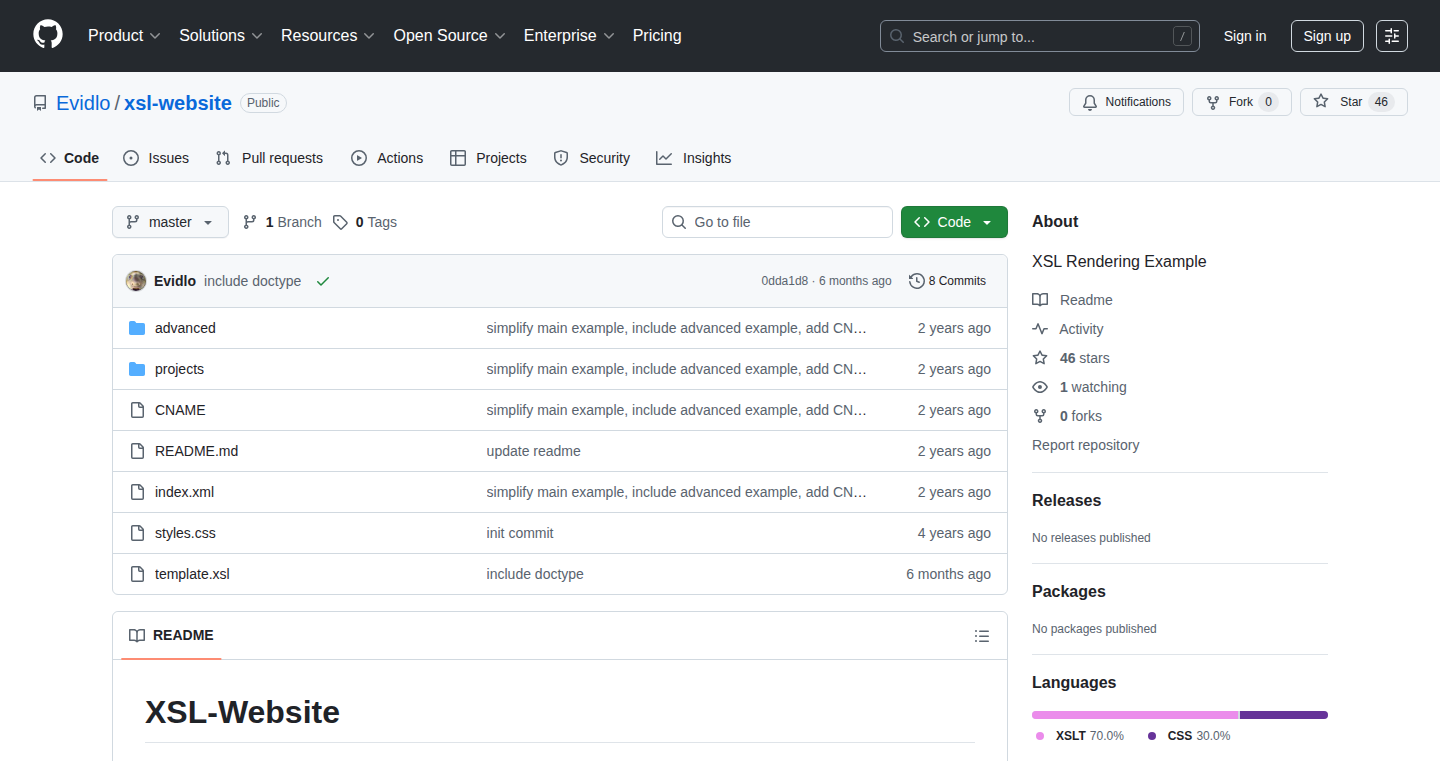
Author
Evidlo
Description
This project offers a clever way to build simple, dynamic websites without using JavaScript or complex build tools like Jekyll or Hugo. It leverages XSLT (Extensible Stylesheet Language Transformations), a technology that allows you to transform XML data into HTML. The core idea is to apply an XSLT stylesheet to your XML-based content, automatically generating the final HTML on the server-side. This eliminates the need for a build step before publishing, making website updates and deployment much simpler. So, it’s a return to basics, using an older technology to solve a modern problem: simplifying static site generation.
Popularity
Points 145
Comments 77
What is this product?
This project uses XSLT to create websites. Think of XSLT as a translator that takes your raw content (written in XML) and transforms it into a website (HTML) based on a template. It's like having a smart copy-paste, but for whole webpages. This avoids the need for JavaScript on the client-side and complex build processes. The innovation here is using a well-established technology (XSLT) in a novel way to achieve a specific goal: streamlining the creation and management of static websites. So, it offers a way to update your website's content without using complex build systems, which is particularly useful for simple websites or blogs.
How to use it?
Developers can use this by writing content in XML format and creating an XSLT stylesheet to define the website's layout and design. You'll need a web server that supports XSLT processing (most do). Upload your XML content and the XSLT stylesheet to the server. When a visitor requests a page, the server applies the XSLT stylesheet to the XML data, generating the HTML on the fly. So, if you're a developer looking for a simple way to build and update your website content without a build step, this project provides a practical approach.
Product Core Function
· Templating without Build Steps: XSLT handles the transformation, so there is no need for a build step before publishing. This simplifies the workflow and makes updates faster. This offers developers a simpler deployment process and reduces the risk of build errors.
· Server-Side Processing: The transformation happens on the server. This ensures that the final HTML is delivered to the user, avoiding the need for client-side JavaScript, resulting in faster load times. This provides a solution to enhance website performance.
· Standard URLs: The approach supports normal-looking URLs (e.g., example.com/foobar) instead of hash-based URLs (e.g., example.com/#page=foobar), improving SEO and user experience. This helps improve search engine ranking and user readability for your website.
Product Usage Case
· Simple Blogs and Portfolios: Perfect for personal websites or blogs where content updates are frequent, and a complex build process is unnecessary. So, you can quickly update your blog without the complexity of a full static site generator.
· Small Business Websites: Businesses can easily maintain their websites without requiring a dedicated developer or understanding complicated build tools. This simplifies the web content management process, allowing easier website maintenance.
· Documentation Sites: Documentation can be easily generated and updated using XML content, ensuring consistency and facilitating content reuse. So, it provides a simple, and maintainable way to create and deploy documentation.
2
Clyp: A Linux Clipboard Manager for Enhanced Productivity

Author
timeoperator
Description
Clyp is a clipboard manager specifically designed for Linux users. It addresses the common problem of losing important copied text or data by providing a history of everything you've copied. The technical innovation lies in its lightweight design, efficient storage of clipboard data, and intuitive user interface, allowing users to quickly access and reuse previous clipboard entries. This project showcases a practical solution to a frequent user need, optimized for the Linux environment.
Popularity
Points 74
Comments 45
What is this product?
Clyp is a small application that keeps track of everything you copy on your Linux computer. Instead of just having one piece of text in your clipboard at a time, Clyp stores a history of all your copied items. The core of Clyp's innovation is how it efficiently saves and retrieves this clipboard data, making it easy to revisit and reuse information you've previously copied. It's built to be light on resources, ensuring it doesn't slow down your computer.
How to use it?
To use Clyp, you install it on your Linux system, and it runs in the background. Whenever you copy something (text, images, etc.), Clyp automatically saves it. You can then access your clipboard history through a convenient interface, such as a system tray icon or a keyboard shortcut. To use a previous clipboard entry, you simply select it from the history, and it gets copied back to your active clipboard, ready to be pasted into any application. So, if you often find yourself copying and pasting the same bits of information, this saves a lot of time.
Product Core Function
· Clipboard History Storage: Clyp efficiently stores the entire clipboard history, including text and possibly other data formats, providing a reliable record of your copied information. So this is useful because you can quickly recall and reuse data you copied earlier, saving time and reducing the need to re-copy.
· User-Friendly Interface: Clyp offers a simple and intuitive interface for browsing and managing the clipboard history. So this is useful because it makes it easy to find and retrieve past clipboard entries without having to sift through cluttered data or memory.
· Quick Access: Clyp provides fast access to the clipboard history via keyboard shortcuts or a system tray icon. So this is useful because it allows users to quickly paste from the clipboard history, improving workflow efficiency.
· Resource Optimization: Clyp is designed to use minimal system resources, ensuring it doesn't impact computer performance. So this is useful because it allows it to run silently in the background without slowing down other tasks.
Product Usage Case
· Software Development: A developer needs to copy multiple pieces of code snippets, configuration settings, and error messages from various sources. Using Clyp, they can easily access and reuse these snippets without switching back and forth between different windows or documents. So, it saves time and reduces the risk of errors from manual copying.
· Writing and Research: A writer or researcher is compiling information from multiple sources. Clyp allows them to copy different quotes, references, and notes and organize them. So, it significantly simplifies the process of gathering and integrating information from multiple locations.
· Customer Support: A customer support representative needs to access a variety of canned responses, troubleshooting steps, and links. Clyp makes it easy to access these, improving efficiency. So, this enhances the speed and accuracy with which support inquiries are handled.
· General Office Work: Any user frequently copying and pasting information, such as email addresses, phone numbers, or frequently used phrases, can improve productivity by using Clyp. So this is useful because it streamlines repetitive tasks.
3
Creao: AI-Powered Vibe Coding for Founders

Author
north_creao
Description
Creao is a novel 'vibe coding' product designed to empower founders and small teams to create custom productivity tools without needing extensive coding knowledge. It leverages a fine-tuned AI model to automatically build complex data schemas and integrate with existing APIs, allowing users to swiftly develop internal tools like CRM workflows and data dashboards. The innovation lies in its focus on practical, fully functional tools, moving beyond simple prototypes. It tackles the common problem of over-reliance on expensive, inflexible SaaS subscriptions by enabling users to build tailored solutions in minutes.
Popularity
Points 23
Comments 23
What is this product?
Creao is essentially a smart AI assistant that helps you build your own custom software applications tailored to your specific needs. Instead of struggling with multiple SaaS tools that don't quite fit, Creao lets you build your own. It understands your requirements, sets up the data structures (like databases) needed, and connects your applications to other services you use (like your email or social media). The core innovation is in its ability to handle complex data structures and API integrations, which other similar tools often struggle with. Think of it as having your own mini-software development team that you can access instantly.
How to use it?
You can use Creao by describing the tool you want to build in plain English. For example, you might say: 'I want a dashboard that tracks my Twitter engagement and lets me export the data to a CSV file.' Creao then takes this description and generates the code, sets up the necessary data connections, and creates the application. You don't need to write any code yourself. This tool is particularly useful for founders and small business owners who need custom solutions for tasks like CRM, data analysis, or automation. The integration is seamless; simply describe what you need, and Creao handles the technical complexity.
Product Core Function
· Automated Complex Data Schema Building: Creao intelligently creates the data structures (databases, tables, etc.) required for your applications. This saves you the time and effort of manually designing and setting up complex data models. For example, if you want to build a customer relationship management (CRM) system, Creao would automatically create the tables for customer information, interactions, and other relevant data. So this is useful because it eliminates the need for you to understand complex database technologies.
· Automated API and MCP (Most Common Protocols) Connections: Creao can automatically connect your applications to existing services and systems (like email, social media platforms, and other APIs). This allows you to retrieve data from external sources, interact with those services, and build workflows that integrate different tools. For example, you can automatically pull your Twitter engagement data using Twitter API and display it on a dashboard. So this makes it easy to connect all the tools you need to run your business.
· State Persistence: Creao's tools can save and remember data, allowing you to build applications that track and store information over time. This means that you can create applications that have memory, and which can display historical data and use this data to do more intelligent things. For example, you could build a sales dashboard that shows your sales history and can predict future sales. So this allows you to build truly useful internal tools.
Product Usage Case
· Building a Custom CRM: Creao can be used to create a tailored CRM system. You can define the data you want to track (customer contacts, interactions, deals, etc.), and Creao will build the necessary database and user interface. This eliminates the need to subscribe to expensive CRM solutions that may not fit your specific workflow. For example, you can set up a CRM that connects to your email, calendar, and social media to track customer interactions in a single place, so you can have a much cheaper CRM that suits your business needs perfectly.
· Creating a Data Dashboard: You can use Creao to build a custom dashboard that pulls data from various sources (e.g., Google Analytics, social media, sales data). Creao automatically handles the data connections and creates the visualizations. This enables you to get a comprehensive view of your business performance without spending hours on manual data collection and analysis. For example, you can track your marketing campaign performance by pulling data from Google Analytics and social media and display everything on a single screen, so you can monitor your business in real-time.
· Automating Workflow: Creao can automate many business processes such as sending automatic follow-up emails or automatically updating a spreadsheet with new data. For example, you could set up a workflow that automatically sends a follow-up email to a new customer after they sign up for your newsletter, so you don't have to do it manually.
· Tracking Revenue: Creao can be used to build an application that tracks your revenue and expenses. The application will connect to your bank account, process payments, and generate a summary of your revenue. You can quickly see how much money you are making and spending. So this helps you make better financial decisions for your business.
4
FerrousKV: Blazing-Fast Embedded Key-Value Store in Rust
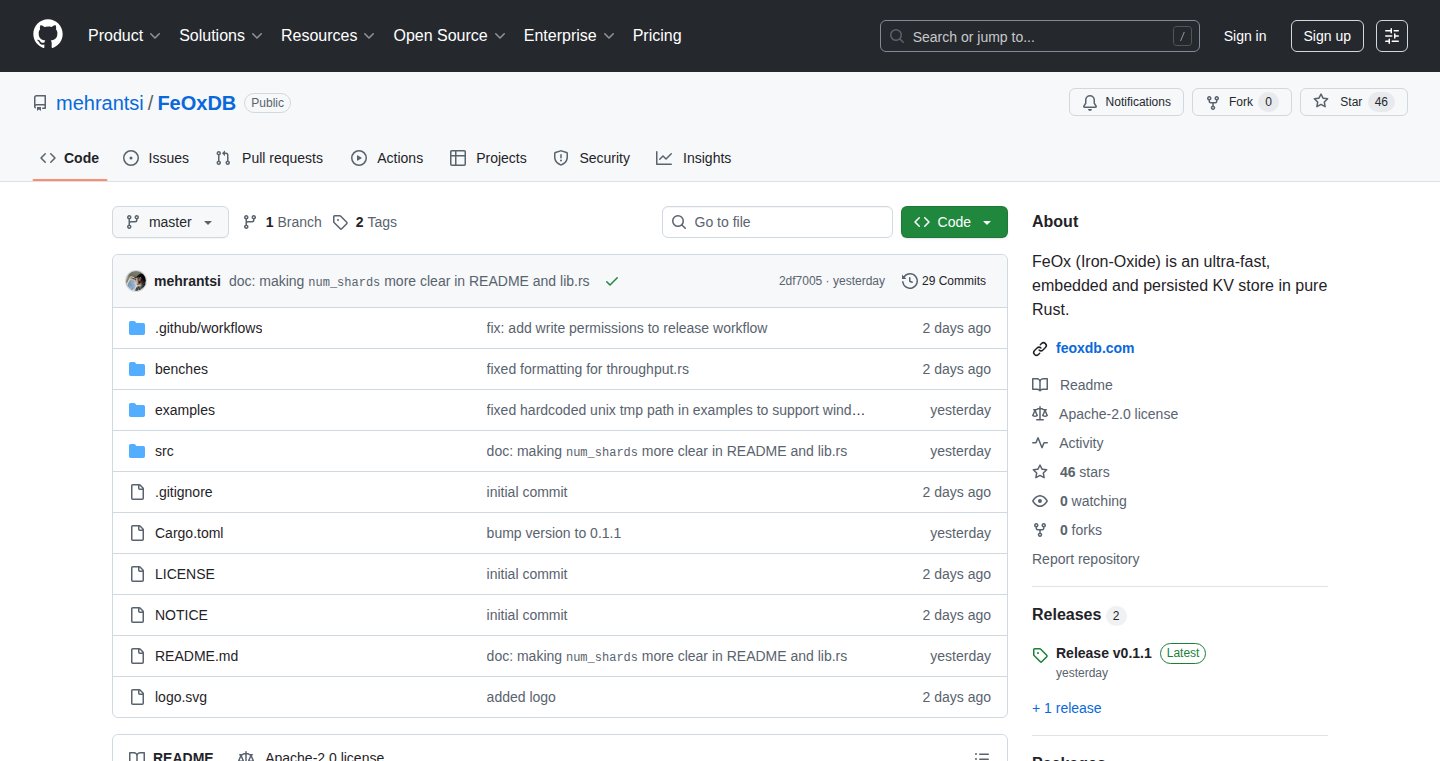
Author
mehrant
Description
FerrousKV is a lightning-fast key-value (KV) store designed to be embedded directly within applications. Built entirely in Rust, it emphasizes speed and efficiency, particularly targeting resource-constrained environments. The key innovation lies in its highly optimized storage engine, potentially using techniques like B-trees or log-structured merge trees (LSM-trees) to achieve impressive read and write performance even on embedded systems. This project addresses the need for a performant, lightweight data storage solution for applications where traditional databases are overkill or too resource-intensive.
Popularity
Points 31
Comments 7
What is this product?
FerrousKV is essentially a highly optimized dictionary that can be stored directly in your application's memory or storage. It utilizes the power of Rust, a systems programming language known for its speed and memory safety, to build a KV store that’s incredibly fast and resource-efficient. The core idea is to efficiently store and retrieve data based on keys, much like looking up a word in a dictionary. The innovative part is that this KV store is designed to work especially well in environments with limited resources, like embedded devices or edge computing applications.
How to use it?
Developers would incorporate FerrousKV directly into their Rust applications. This involves adding it as a dependency in your project. Then, you can use simple API calls to store data (key-value pairs) and retrieve it later. Imagine using it to cache frequently accessed data, manage configuration settings, or even as a lightweight database replacement for smaller projects. It could be integrated into applications running on embedded devices, such as IoT sensors, to store sensor readings or configuration data efficiently.
Product Core Function
· Fast data storage: FerrousKV provides rapid storage of key-value pairs. The use case is when you need to quickly save data, such as saving the states in a game.
· Efficient data retrieval: It enables quick retrieval of data using its associated keys. For example, it can be used to retrieve user settings quickly from the database.
· Embedded compatibility: FerrousKV is designed to work efficiently on devices with limited resources. The use case is in embedded devices like a smart thermostat to store the current temperature.
· Rust-based: Leveraging Rust for performance and memory safety. This can be used for projects where speed and safety are critical, such as financial or healthcare applications.
· Lightweight design: It is designed to have a small memory footprint, making it suitable for resource-constrained environments. This can be used to efficiently store a configuration file in your application.
Product Usage Case
· IoT Sensor Data Storage: An IoT sensor collects temperature and humidity data. FerrousKV can store this data locally on the sensor, enabling fast access to historical readings and reducing the need to constantly transmit data to the cloud. So it can store the data locally without needing a full-blown database.
· Caching System: A web server uses FerrousKV to cache frequently accessed data, such as API responses or database query results. This accelerates response times and reduces the load on the backend systems. Therefore the website will be faster because of the caching.
· Game Save Data: A game developer utilizes FerrousKV to store game save data, such as player progress, inventory, and scores. The fast read/write operations ensure a seamless and responsive gaming experience. So the game can save data faster without lagging.
5
BrowserOS: Agentic Web Browser with Local LLMs
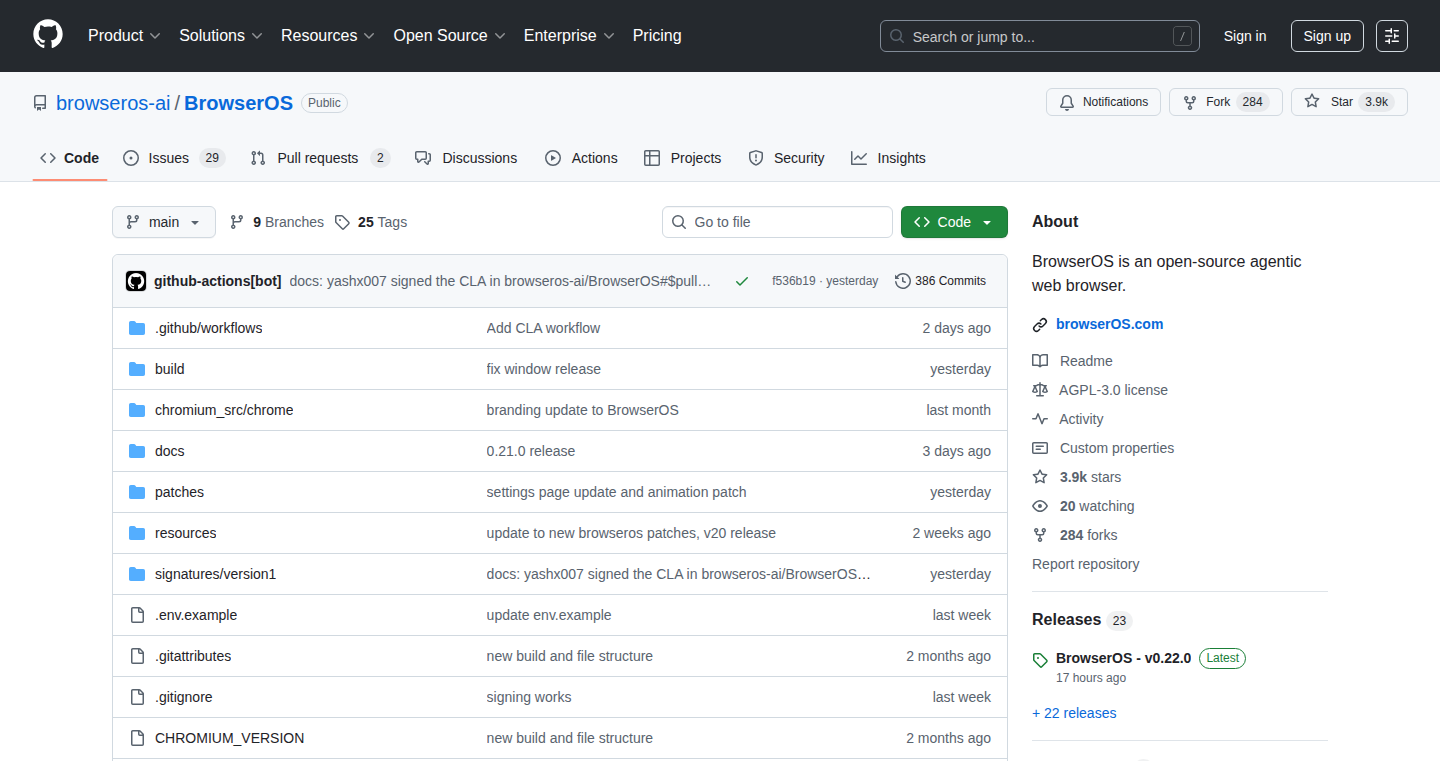
Author
felarof
Description
BrowserOS is an open-source web browser based on Chromium that allows users to create and run intelligent agents within the browser. These agents can automate tasks on the web using large language models (LLMs), like GPT-OSS, running locally. The innovation lies in a 'plan-follower' approach: users provide a high-level plan in natural language, and the LLM executes each step, enhancing reliability and usability compared to 'one-shot' agents. This enables users to automate web tasks, making them more efficient and productive, with a focus on privacy and local processing.
Popularity
Points 12
Comments 2
What is this product?
BrowserOS is a web browser that allows you to create and use 'agents' to automate tasks on the internet. These agents are powered by large language models (LLMs) that understand your instructions and can interact with websites, such as filling out forms, searching for products, and making purchases. The core innovation is the 'plan-follower' approach, where you give the agent a step-by-step plan in plain language, making it easier for the agent to complete tasks accurately using local LLMs. So, this is like having a personal assistant inside your web browser that understands your instructions and takes action for you.
How to use it?
Developers can use BrowserOS to build and test web automation agents. You can define a plan in natural language for the agent, using simple steps like 'Go to Amazon,' 'Search for toothpaste,' and 'Add to cart.' Then, the agent will follow those instructions and perform the actions. To integrate, you'd interact with the browser's agent builder interface, providing the necessary details. The browser supports local LLMs like GPT-OSS, meaning you can run the agent on your own computer without sending your data to external servers. This offers more control and privacy. So, you can build your own automated web tools without the need to understand complex programming.
Product Core Function
· Agent Builder: Allows users to create agents by defining plans in natural language. This simplifies the automation process by breaking down complex tasks into manageable steps. This is useful because it allows anyone to create automated workflows without needing to know how to code.
· Local LLM Support: Enables the use of local LLMs like GPT-OSS, ensuring user privacy and control over data. This is important for users who want to keep their browsing data secure and avoid sending sensitive information to external servers. So, you can automate web tasks without worrying about your data being shared.
· Plan-Follower Agents: Uses a step-by-step plan approach, improving the reliability of the agents by reducing the chance of errors. By giving the agent clear instructions, you are helping it perform tasks correctly. It gives more reliable results. So, you can trust the agent to do what you want it to do.
· Chromium-Based: Leveraging Chromium as a base provides a familiar and robust browsing experience, including compatibility with a vast number of websites and web standards. This is useful because it makes the browser easy to use and ensures it works with almost all websites. So, you can use it just like any other web browser.
· Open Source: The open-source nature of the project allows developers to contribute, customize, and improve the browser. This encourages community involvement and ensures continuous innovation. It creates a more open and secure platform. So, you can check the code and make sure it does what you want.
Product Usage Case
· Automated Shopping: Users can create an agent to automatically search for products on Amazon, select the desired item, and add it to the cart. This is a useful example for automating online shopping, saving time and effort. So, you can automate repetitive shopping tasks, like buying toothpaste regularly.
· Form Filling Automation: Agents can be created to automatically fill out online forms, such as registration forms or contact forms, using data provided by the user. This is beneficial for saving time and reducing manual effort. So, you don't have to manually enter the same information over and over again.
· Research Assistant: Agents can automate the process of gathering information from multiple websites, summarizing content, and organizing the results, assisting with research tasks. It helps you quickly gather information from the web and do research faster. So, you can get the information you need more efficiently.
· Task Automation in Web Applications: Agents can be used to automate repetitive tasks within web applications, such as data entry or report generation, increasing productivity. This is useful for streamlining workflows and reducing manual work. So, you can automate repetitive actions in any web app you use.
6
xv6-riscv-net: A From-Scratch TCP/IP Stack Inside xv6
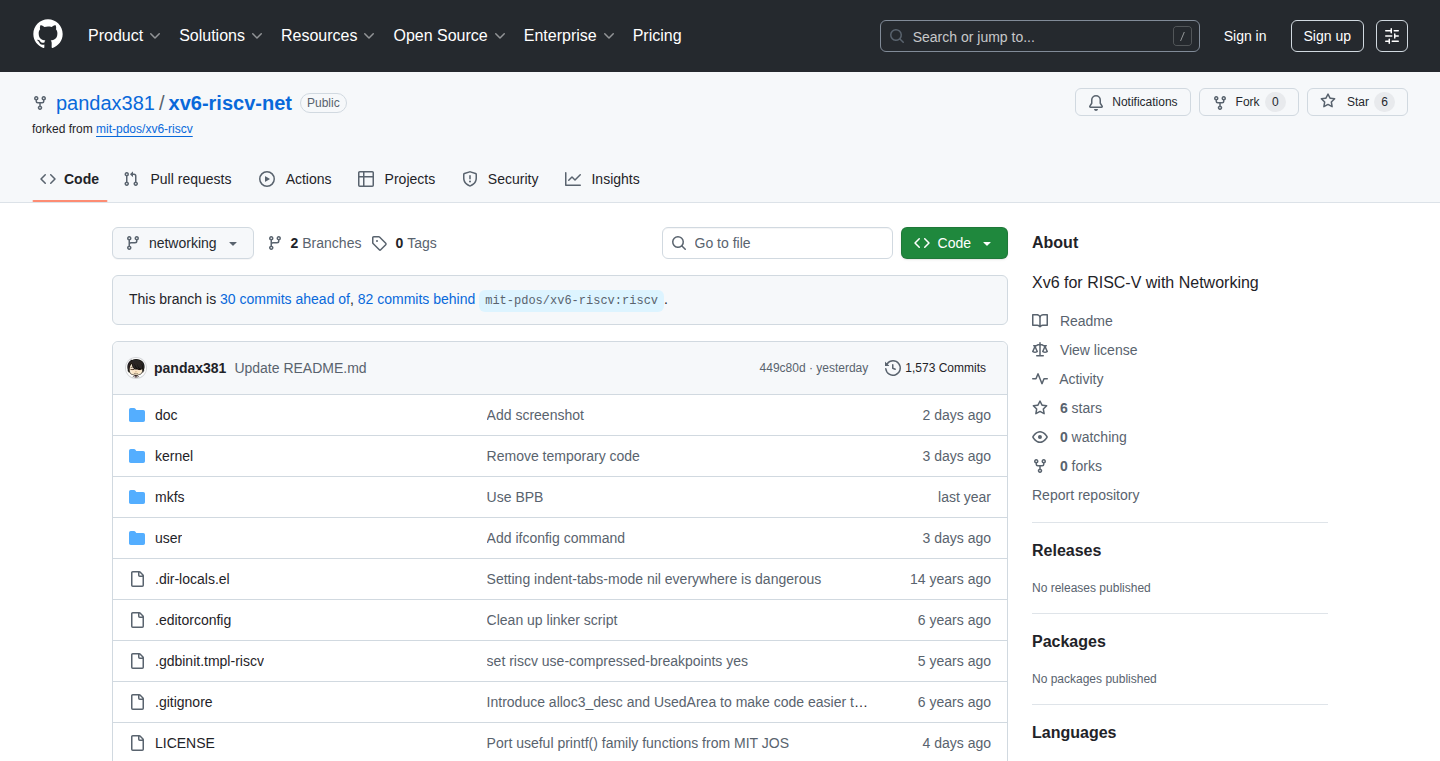
Author
pandax381
Description
This project integrates a custom-built TCP/IP networking stack directly into the xv6-riscv operating system kernel. Instead of relying on pre-built network libraries, the developer constructed the entire TCP/IP stack from scratch. This allows a deeper understanding of how operating systems and network protocols function. The stack is designed to run within the kernel, offering a direct and low-level approach to network interactions. It supports standard socket APIs, allowing developers to write network applications that run on top of this custom stack, providing a unique way to learn and experiment with network programming and OS internals. So this project helps anyone to understand the complex workings of the internet at a fundamental level, by building the essential components themselves.
Popularity
Points 9
Comments 2
What is this product?
This project is a custom TCP/IP stack implemented from scratch and integrated into the xv6-riscv operating system. It's like building your own internet connection directly inside the computer's core. The core innovation lies in creating the entire networking protocol suite (TCP/IP) without using existing libraries. The implementation uses `microps`, a TCP/IP stack initially designed for user-space, and adapts it to run inside the xv6-riscv kernel. The stack uses a virtio-net driver for seamless integration with QEMU and communication with the host machine. So, instead of just using the internet, you get to build the tools that make the internet work!
How to use it?
Developers can use this project to learn the fundamentals of networking and operating systems. You can compile and run the xv6-riscv OS with the custom network stack inside of QEMU. Then, they can develop network applications using standard socket APIs like `socket`, `bind`, and `accept`. The project also includes example utilities like `tcpecho` and `udpecho` servers to showcase network functionality. This project allows developers to modify and experiment with the networking stack directly, offering a deep understanding of network communication. So you can get hands-on experience with how the internet works, by building your own applications that communicate over a network.
Product Core Function
· From-Scratch TCP/IP Stack: The project provides a completely custom implementation of the TCP/IP stack, allowing users to understand the intricacies of network protocols. It helps understand the underlying technology by building it from the ground up. So, you can truly understand how data travels across the internet.
· Kernel Integration: The TCP/IP stack is integrated directly into the xv6-riscv kernel. This design gives developers direct control over how the OS interacts with the network. So, you can modify the behavior of the network within the OS.
· Socket API: Implements standard system calls like `socket`, `bind`, `accept`, etc. to make it easier to write network applications using the custom stack. This interface makes programming familiar and accessible. So, you can use standard networking tools with a custom-built network.
· User-Level Tools: Provides utilities like `ifconfig`, `tcpecho`, and `udpecho` to demonstrate the stack's capabilities and allows users to test and interact with the network. So, you can easily test your own network configuration and applications.
Product Usage Case
· Learning OS Internals: A student could use this to understand how the networking stack and OS interact. The student can step through the code and see exactly how packets are created, sent, and received. This is a great tool to learn the internals of how OS and network protocols work. So, you can truly understand how the internet works.
· Network Application Development: A developer could use this project as a foundation to experiment with low-level networking. They could write custom network applications, modifying the network stack to achieve specific performance goals or try custom networking features. So, you have a platform to design new kinds of network applications and explore custom features.
· Research and Experimentation: A researcher can use this project to study network behavior under unusual conditions. They can change various parameters in the stack to simulate network problems and measure results. So, you can perform in-depth analysis of network protocols.
7
AIMless: Browser-Native P2P Chat
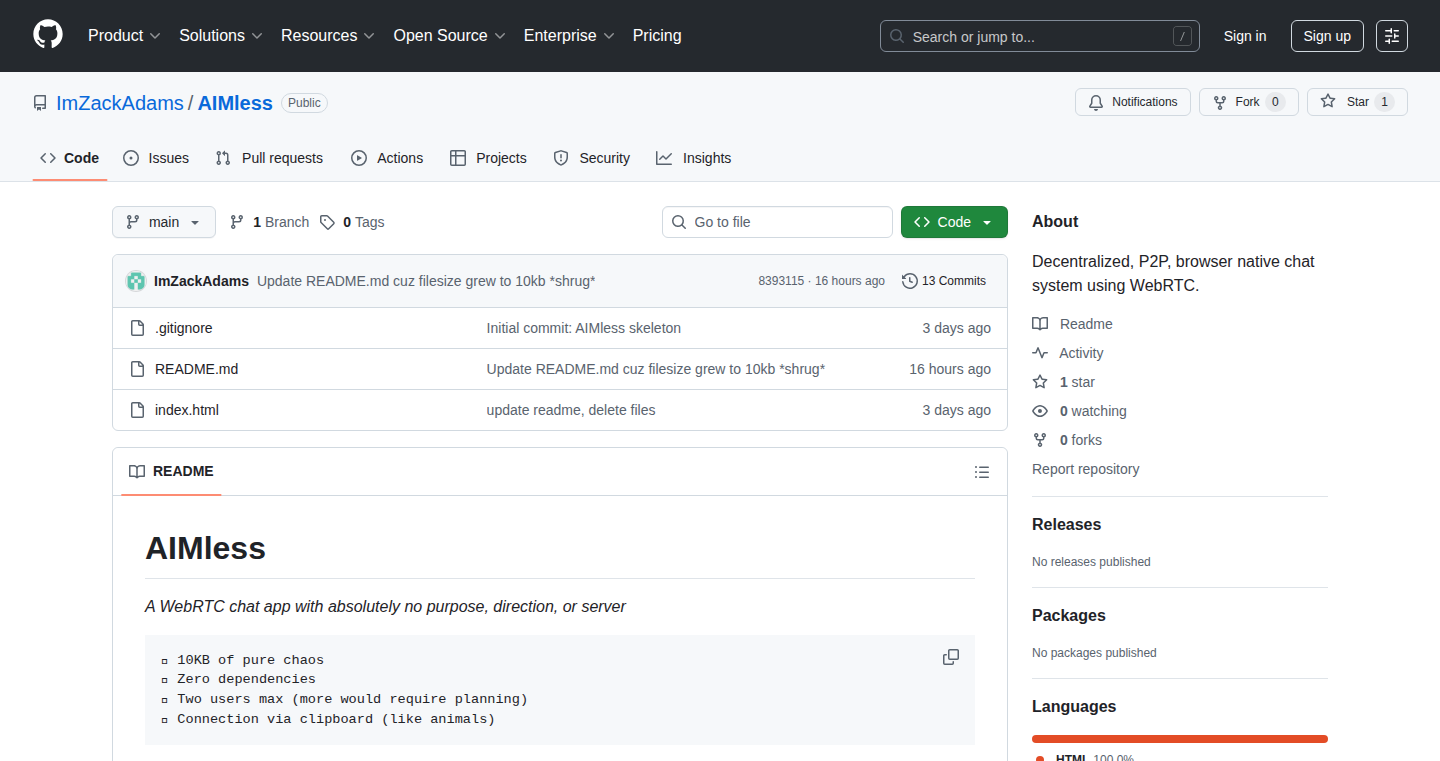
Author
NyxBNC
Description
AIMless is a super lightweight, browser-based chat application that fits into a single, tiny HTML file (only 10KB!). It's decentralized, meaning it doesn't rely on a central server, and uses a peer-to-peer (P2P) architecture, where users communicate directly with each other. The magic? No build tools, no server setup, and no external libraries or frameworks are required. It's a testament to the power of modern web technologies and a great demonstration of how much can be achieved with minimal code. So, what's the deal? It's a simple way to chat without the complexities of traditional apps – think of it like a digital campfire where you can share messages with anyone who has the file. It also shows how secure and private your data can be if you use P2P connections. So, what does this mean for you? It means you can have a private and secure chat that lives in a single file.
Popularity
Points 7
Comments 4
What is this product?
AIMless is a P2P chat app built entirely within a single HTML file. It leverages the capabilities of modern web browsers to handle peer-to-peer communication directly between users. The innovative part is its simplicity – it eliminates the need for servers, external libraries, or complex build processes. The core technology behind it utilizes WebRTC for direct communication between browsers, allowing for real-time, decentralized messaging. It also illustrates how developers can create applications that are portable, easy to deploy, and can be accessed in most web browsers. So, what does this mean for you? It provides a lightweight way to build secure chat applications or share data across several machines or colleagues.
How to use it?
To use AIMless, you simply open the single HTML file in your web browser. To start chatting, you share this HTML file with others. The application uses WebRTC to establish direct connections between users. This means messages are sent directly from your browser to others, eliminating the need for a central server and maximizing your control over your data. This is particularly useful for developers who want to create simple, secure, and serverless communication tools. So, what does this mean for you? You can share the application file with a colleague to have a secure chat session, as there is no 3rd party listening to your conversations.
Product Core Function
· Decentralized Messaging: AIMless uses WebRTC for peer-to-peer communication. This means messages are sent directly between users' browsers, bypassing a central server. This architecture enhances privacy, reduces latency, and simplifies deployment. This is useful for developers as it enables secure, serverless communication in the browser.
· Single-File Deployment: The entire application is contained within a single HTML file. This makes it incredibly easy to share and deploy – you can simply copy and paste the file. Developers can quickly prototype and share applications without complex setups, which is incredibly useful for quick prototyping and collaboration.
· Zero Dependencies: AIMless has no external dependencies (no libraries or frameworks). This reduces the attack surface, streamlines the development process, and makes it easy to understand the core functionality. Developers can concentrate on core functionality without having to manage dependencies. This also improves performance and helps keep the application lightweight and fast. This is great for those looking to build applications with minimal overhead.
Product Usage Case
· Secure Team Communication: A development team can use AIMless for quick, secure, and private chats without needing to set up a dedicated chat server or rely on a third-party service. The messages are transmitted directly between team members, ensuring confidentiality and easy sharing of files.
· Rapid Prototyping: A developer can quickly prototype a messaging application and share it with colleagues or testers. This is particularly useful for quickly testing and iterating on features or UI elements. It allows you to easily create chat apps without any complexities.
· Offline Communication: AIMless could be used to communicate offline as long as the devices are connected to the same local network. This is useful in scenarios where internet access is limited or unavailable, providing a local messaging solution.
8
Lacquer: Lightweight AI Workflow Engine

Author
hugorut
Description
Lacquer is a streamlined AI workflow engine that transforms routine engineering tasks into dependable YAML-based workflows. It's like GitHub Actions but specifically designed for AI-powered internal tools. It emphasizes local-first development, version control via plain YAML files, a familiar GitHub Actions-like syntax, and a single Go binary for easy deployment. It solves the problem of complex dependencies and container orchestration often associated with AI workflow automation, offering a practical, engineer-friendly solution. So this is useful because it makes building and deploying AI-driven tools easier and more manageable.
Popularity
Points 9
Comments 1
What is this product?
Lacquer is built on the idea of simplifying AI workflow management. It allows engineers to define and execute automated tasks using YAML files, similar to how GitHub Actions works, but optimized for AI-related operations. The project is focused on ease of use, offering a command-line interface and a single binary for quick setup. The core innovation lies in its lightweight design and focus on providing a practical, developer-friendly experience for building and deploying AI-powered tools. So this means you can easily automate repetitive tasks related to AI development without getting bogged down in complex infrastructure.
How to use it?
Developers can use Lacquer by writing YAML files to define their AI workflows. These files specify the steps involved in a task, such as data preprocessing, model training, or evaluation. Once the workflow is defined, they can run it locally using the `laq run` command or deploy it to a production environment with `laq serve`. This allows for version control of workflows using Git, enabling collaboration and reproducibility. So you can define your AI processes in code, share them with your team, and make sure everything runs the same way every time.
Product Core Function
· Local-First Development: Develop and test AI workflows directly in your terminal and code editor. This quickens the development cycle and provides immediate feedback, improving efficiency. So this lets you prototype and refine your workflows without constantly deploying to a remote server.
· Version Control: Store your AI workflows in plain YAML files, which you can commit to a version control system like Git. This enables easy sharing, collaboration, and tracking of changes across your team. So you can track changes, revert to previous versions, and collaborate with others on your AI projects.
· Familiar DSL: Use a syntax similar to GitHub Actions, which leverages knowledge engineers already have. This reduces the learning curve and makes the tool intuitive to use. So if you're familiar with other workflow tools, it's easy to pick up and start using.
· Single Binary: Lacquer is distributed as a single Go binary, eliminating the need for complex dependencies or container orchestration. This simplifies deployment and ensures consistent behavior across environments. So you can quickly deploy and run AI workflows without dealing with containerization complexities.
· Easy Deployment: Run workflows locally with `laq run` or deploy to production with `laq serve`. This provides flexibility in where and how the workflows are executed. So you can easily switch between local testing and production deployment.
Product Usage Case
· Automated Data Preprocessing: Imagine you have a daily task of cleaning and transforming data for your AI model. Lacquer lets you define a YAML workflow to automate this. You can schedule it to run every day, making the process reliable and saving you time. So this automatically prepares data for your AI models without manual intervention.
· Model Training and Evaluation: Develop a workflow that automatically trains your AI models, then assesses their performance on a test dataset. This would involve specifying steps like data loading, model training, and performance metrics reporting in a YAML file. Lacquer would run this workflow, providing you with reproducible results. So you can automate model training and testing, making the development process more efficient and reliable.
· Continuous Integration/Continuous Deployment (CI/CD) for AI: Integrate Lacquer into your CI/CD pipeline. When you push changes to your code repository, Lacquer can automatically trigger a workflow to retrain your model and deploy it to production. This provides automated model updates. So you can automate the process of building, testing, and deploying AI models, making updates fast and seamless.
9
Octos: Web-Powered Dynamic Desktop Wallpapers
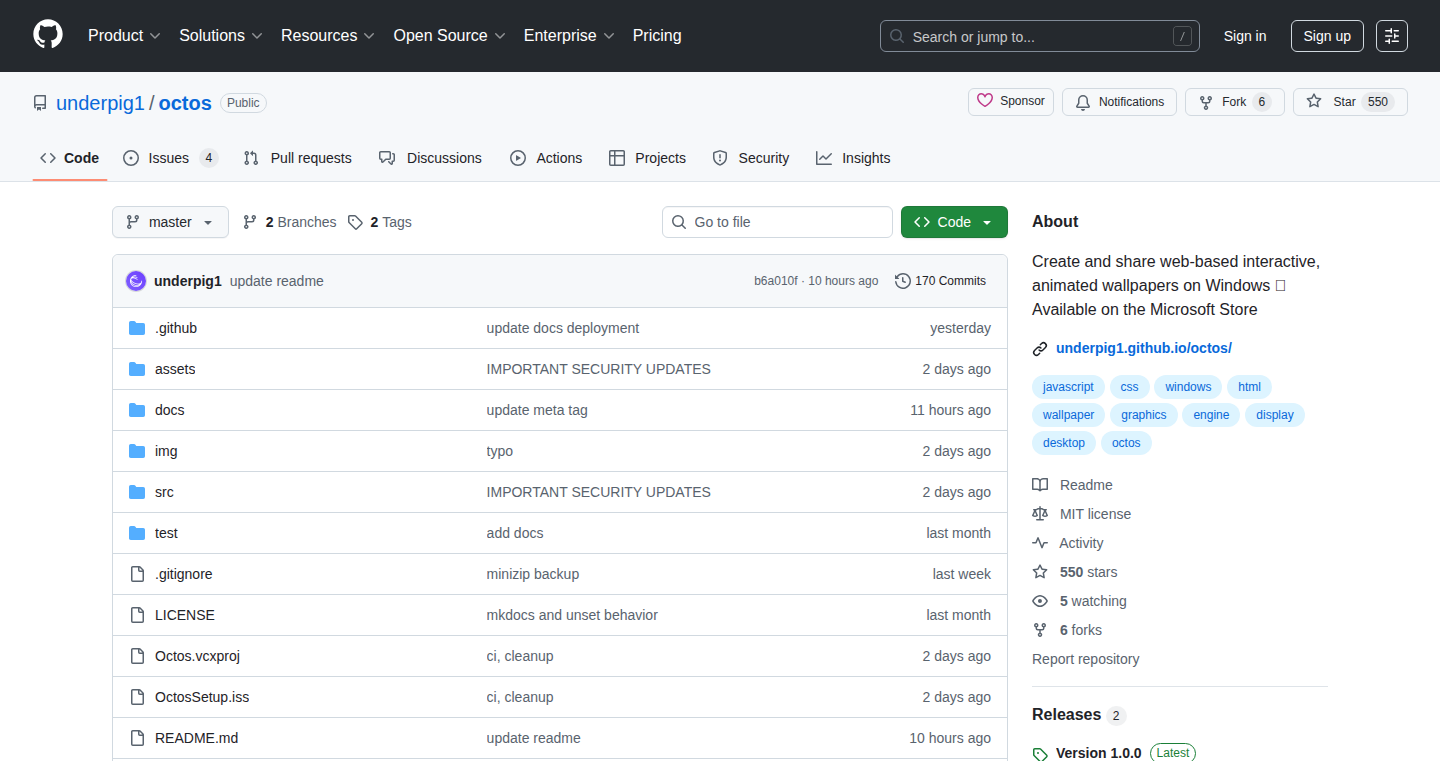
Author
diegotundra
Description
Octos is a fascinating project that lets you turn your desktop wallpaper into an interactive, animated experience using web technologies like HTML, CSS, and JavaScript. It's like having a website as your background! The core innovation lies in its ability to render web content directly onto the desktop, offering dynamic and responsive wallpapers. It solves the problem of static, boring backgrounds by providing a platform for creative expression and personalized desktop experiences.
Popularity
Points 7
Comments 2
What is this product?
Octos is a desktop application that acts as a dynamic wallpaper engine. Instead of a static image, it displays web-based content (HTML, CSS, JavaScript) as your background. It uses the system resources to render this web content. The key innovation is the use of standard web technologies to create interactive and animated wallpapers, allowing for a high degree of customization and user interaction. So, if you're tired of the same old background, this gives you a way to create your own personalized and dynamic desktop.
How to use it?
Developers can create their own dynamic wallpapers using HTML, CSS, and JavaScript. You can download Octos and then either create your own wallpapers or download community-created ones. You can embed JavaScript to add interactivity, use CSS for styling and animation, and HTML to structure the content. Think of it as building a simple webpage that lives on your desktop. You could integrate this with any API. So, if you know web development, you already have the tools to create amazing desktop experiences.
Product Core Function
· Web-based Rendering Engine: This is the heart of Octos. It renders HTML, CSS, and JavaScript directly onto the desktop background. This allows for dynamic and interactive wallpapers, far beyond the capabilities of static images. So this gives you the flexibility of web development in your background.
· Customization and Personalization: Users can either create their own wallpapers or download from the community. This allows users to personalize their desktops to suit their tastes and needs. So you can make your background unique.
· Community-Driven Content: Octos encourages community sharing. This means a growing library of wallpapers for anyone to use, creating a resource for inspiration and reducing the initial effort to get started. So, you don't need to be a web expert to enjoy dynamic backgrounds; many are available already.
· Resource Management: Octos is built with the ability to manage system resources, ensuring smooth performance even with complex animations or interactive elements. So, it helps to keep your computer running smoothly even with dynamic backgrounds running.
Product Usage Case
· Interactive Clock Wallpaper: A developer could build a dynamic clock wallpaper that displays the current time in a visually appealing and animated way. The clock's appearance could change based on the time of day, or include other interactive elements. So, your clock display is always interesting.
· System Monitoring Dashboard: Create a wallpaper that displays real-time system information, such as CPU usage, memory usage, and network activity, providing a glanceable overview of your computer's performance. So, you can see how your computer is performing at a glance.
· Weather Widget Wallpaper: Develop a wallpaper that displays current weather conditions and forecasts for your location, updating automatically and providing a visual representation of the weather. So, you can always have up-to-date weather information on your desktop.
10
Any-LLM Chat Demo: Unified LLM Access
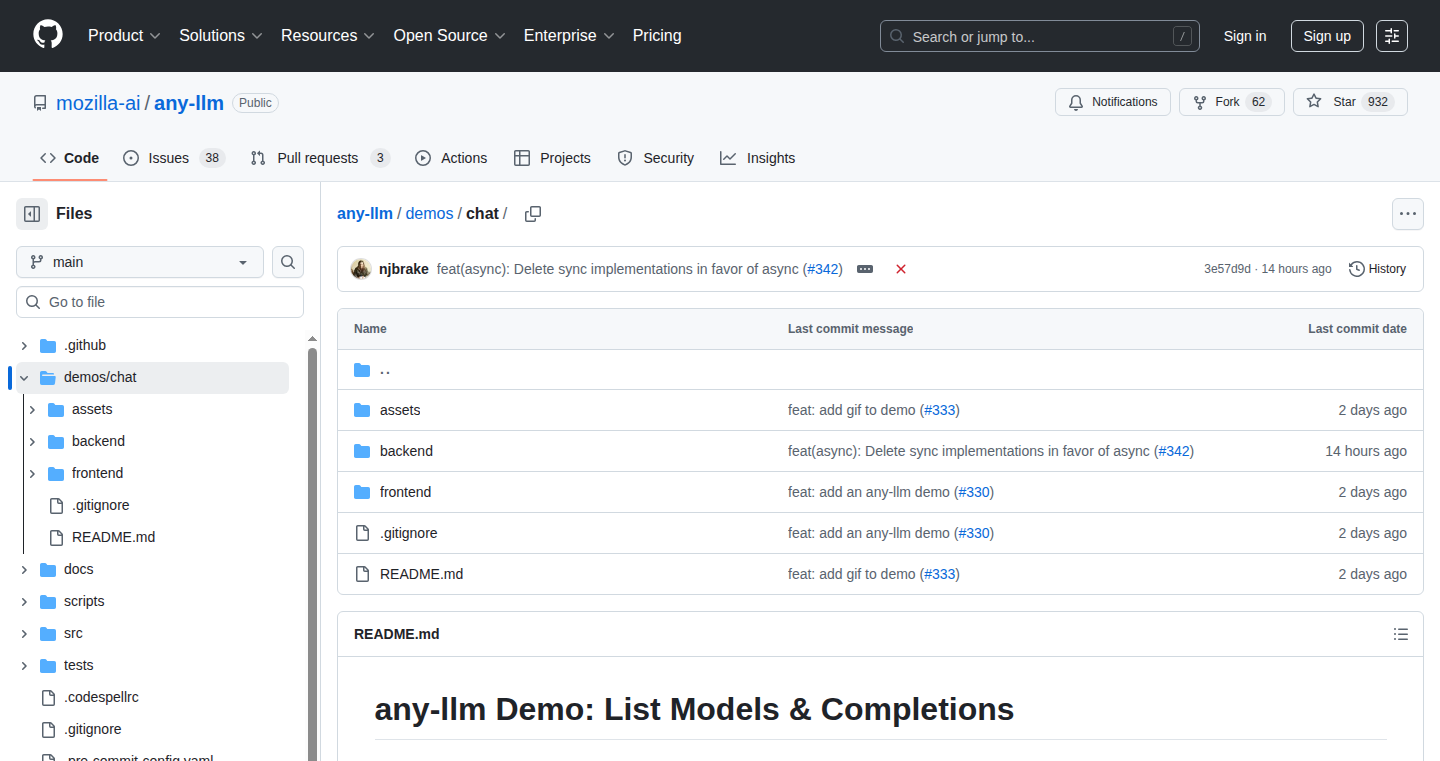
Author
AMeckes
Description
This project, Any-LLM Chat Demo, is a library and demonstration tool that simplifies the process of interacting with different Large Language Models (LLMs). The core innovation is providing a unified interface, meaning you can easily switch between LLM providers like OpenAI's ChatGPT, Anthropic's Claude, Google's Gemini, Mistral, and even locally running models like Ollama with just a simple configuration change. It allows users to compare the outputs of different LLMs side-by-side, revealing how they reason and approach the same problem. This facilitates model evaluation and helps users understand the strengths and weaknesses of each model. So this is useful to allow developers and users to easily explore different LLMs without needing to change their code significantly.
Popularity
Points 7
Comments 0
What is this product?
This project is built around the Any-LLM library, which abstracts away the complexities of interacting with various LLM APIs. Its key innovation lies in a unified access approach. Instead of writing separate code for each LLM (e.g., one set of API calls for OpenAI, another for Claude), you use a single set of functions and just specify the model provider you want to use. The demo showcases this capability by allowing users to chat with different models (ChatGPT, Claude, Ollama, Gemini) within the same interface. The project's technical depth is that it handles the differences in API calls, input formats, and output formats of each provider behind the scenes, allowing the user to focus on the core functionality: interacting with the LLM. So this gives the user the flexibility to compare and evaluate multiple LLMs.
How to use it?
Developers can use this project by integrating the Any-LLM library into their applications. This allows their applications to interact with various LLMs through a single interface. For example, if a developer is building a chatbot application, they can use Any-LLM to easily switch between OpenAI's ChatGPT and Anthropic's Claude to see which model provides the best responses for their specific use case. Integration typically involves installing the library and configuring the desired LLM provider. Developers may also extend this project by adding support for more LLMs or by customizing the interface for their specific applications. So this gives developers a straightforward solution for model comparison and integration.
Product Core Function
· Unified API Access: The core function is providing a single point of access to different LLMs, reducing the complexity of having to learn and integrate with individual APIs. This simplifies development and maintenance by making it easy to switch providers or test multiple LLMs. This feature is useful when you want to build a chatbot or other application that needs to leverage the capabilities of different LLMs.
· Model Switching: The ability to easily change between different LLMs with a configuration change is another key function. This allows users to quickly test various models and compare the results. This is especially valuable for evaluating different LLMs and deciding which performs best for a specific task. This is useful when you are trying to find the best LLM for a particular task and need to compare the performance.
· Response Comparison: The demo allows you to compare the outputs from different models side-by-side. This is a valuable function that helps you understand how different models reason and the qualities of their responses. This is useful for anyone who needs to understand the strengths and weaknesses of different LLMs to make informed decisions about which to use for a project.
· Provider Abstraction: The library abstracts away the differences in each LLM's API, allowing developers to focus on the application logic rather than the specifics of each provider. This enhances developer productivity and allows them to move more quickly. This is especially useful when developing an application that requires integrating with multiple LLMs and needs a way to simplify the coding.
Product Usage Case
· Chatbot Development: A developer could use Any-LLM to build a chatbot that leverages different LLMs to provide the most accurate and relevant responses. They can switch between different models to determine which one gives the best results. This is especially useful in scenarios where different LLMs excel in particular tasks, such as language translation or creative writing.
· Content Generation: A content creator might use Any-LLM to generate text using various models and compare the outputs. They can then select the best-suited content for their needs. This offers significant value in content creation workflows, where different LLMs can provide varying writing styles or specializations.
· Model Evaluation: Researchers and developers can use Any-LLM to evaluate and compare different LLMs to determine their strengths and weaknesses. This can help inform the selection of LLMs for specific applications or for understanding model performance. This is particularly relevant in applications such as customer support, where different models can excel in distinct domains and offer enhanced response times.
11
AICF (AI Changefeed): Web-Native Change Tracking for AI Applications
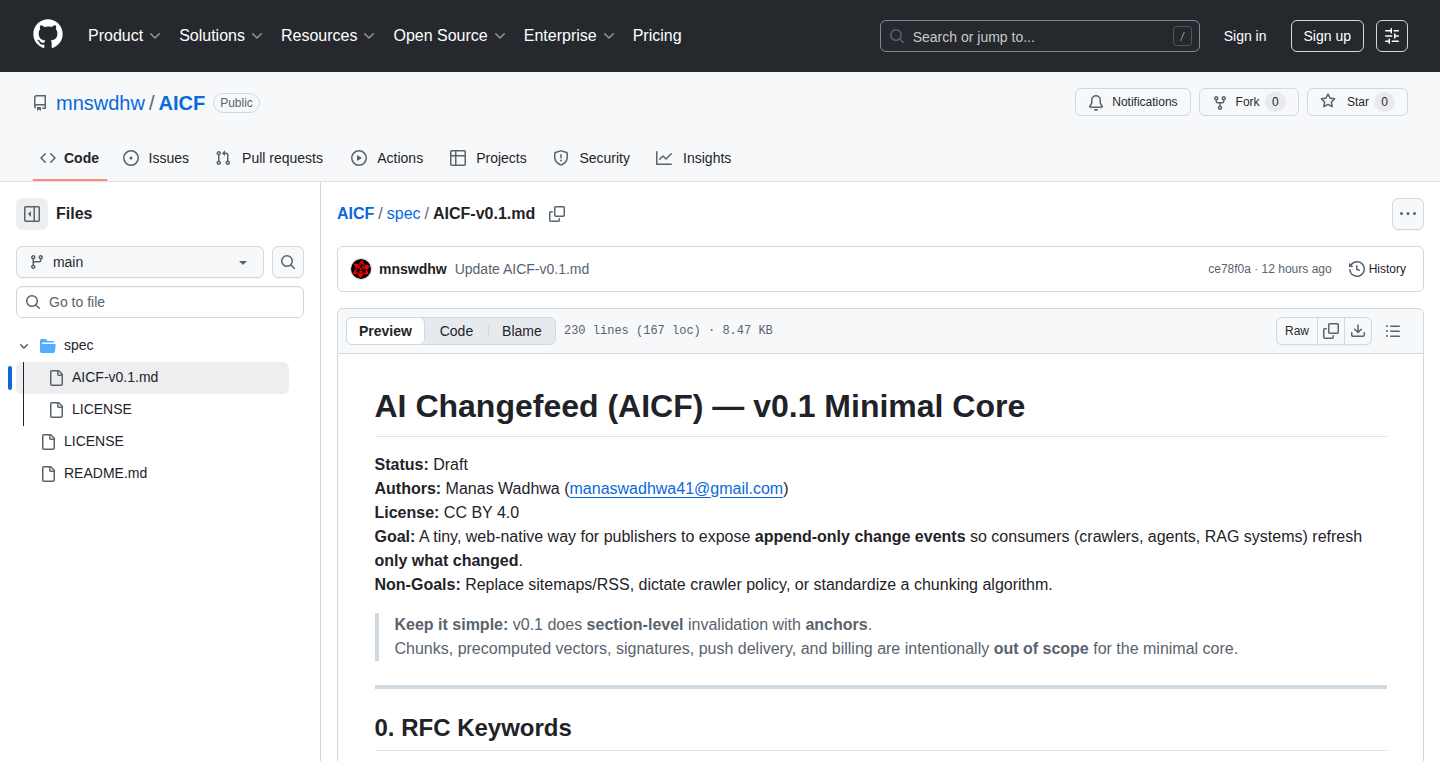
Author
mnswdhw
Description
AICF (AI Changefeed) is a simple, web-friendly method for websites to notify AI systems about content updates. Instead of AI models having to constantly re-process entire web pages, AICF provides a lightweight feed that only lists the changes. This reduces wasted processing time and keeps information fresh for AI agents and Retrieval-Augmented Generation (RAG) systems. Think of it as a 'what's new' feed specifically designed for AI. The innovation lies in its minimalist design: a simple JSON file that tells AI what content has been added, modified, or removed, making it easy for AI to stay up-to-date.
Popularity
Points 5
Comments 1
What is this product?
AICF works by creating a `.well-known/ai-changefeed.json` file on a website that points to an append-only NDJSON (Newline Delimited JSON) file. This NDJSON file contains change events, each including an ID, action (e.g., 'add', 'update', 'delete'), URL, and timestamp. This feed allows AI models to only refresh the parts of the website that have changed, saving resources and improving efficiency. It leverages the standard web mechanisms (JSON and URLs) for easy integration. So this is useful because it offers an efficient way to keep AI systems informed about the latest changes on your website, avoiding unnecessary processing and resource consumption.
How to use it?
Developers can integrate AICF into their websites by creating the required JSON files. First, they create a `.well-known/ai-changefeed.json` file, which acts as a pointer to the main feed. Then, they generate the NDJSON feed, adding a new entry to the feed whenever content changes. This feed will contain information like the URL of the changed content, the type of change (add, update, delete), and a timestamp. AI models then subscribe to this feed, using the information to selectively update their knowledge base, RAG systems, or other AI applications. So this lets you make it easier for AI to understand changes on your website and improve how it uses your content.
Product Core Function
· Change Event Tracking: The ability to track changes to content on a website, including additions, updates, and deletions. This is accomplished by the NDJSON file, which efficiently records these events.
· Feed Discovery: A standardized way for AI systems to find the change feed using a `.well-known/ai-changefeed.json` file, making integration easier.
· Append-Only Design: The change feed is designed as an append-only file, ensuring that historical change data is preserved and simplifies processing for AI systems. This is valuable because it means your AI will be better able to keep up with content.
· Minimal Data Fields: The use of only essential fields (id, action, url, time) in the feed keeps the data lightweight and efficient for AI to process. This leads to faster updates for your AI.
Product Usage Case
· Updating AI Documentation: A company updates its technical documentation website. Instead of the AI constantly re-indexing the entire documentation, AICF provides a feed that only lists the modified pages and sections. The AI can then quickly update its knowledge base with the changes. This means your AI system has the latest documentation, so it is more accurate.
· Pricing Page Updates: An e-commerce site frequently adjusts its product pricing. Using AICF, the AI agent, which provides product information to customers, can receive immediate notifications about price changes. The AI can then quickly update product prices displayed to customers without having to re-index the entire product catalog. This ensures your AI is always providing accurate prices.
· Policy Page Changes: When a website's privacy policy is updated, AICF enables the AI chatbot assisting users to instantly recognize the changed content. Without AICF, the chatbot might miss critical updates to terms of service or privacy policies, leading to incorrect information being shared with users. This makes sure your users are always getting the most accurate and up-to-date information.
12
HypeVortex: The Tokenized AI Playground
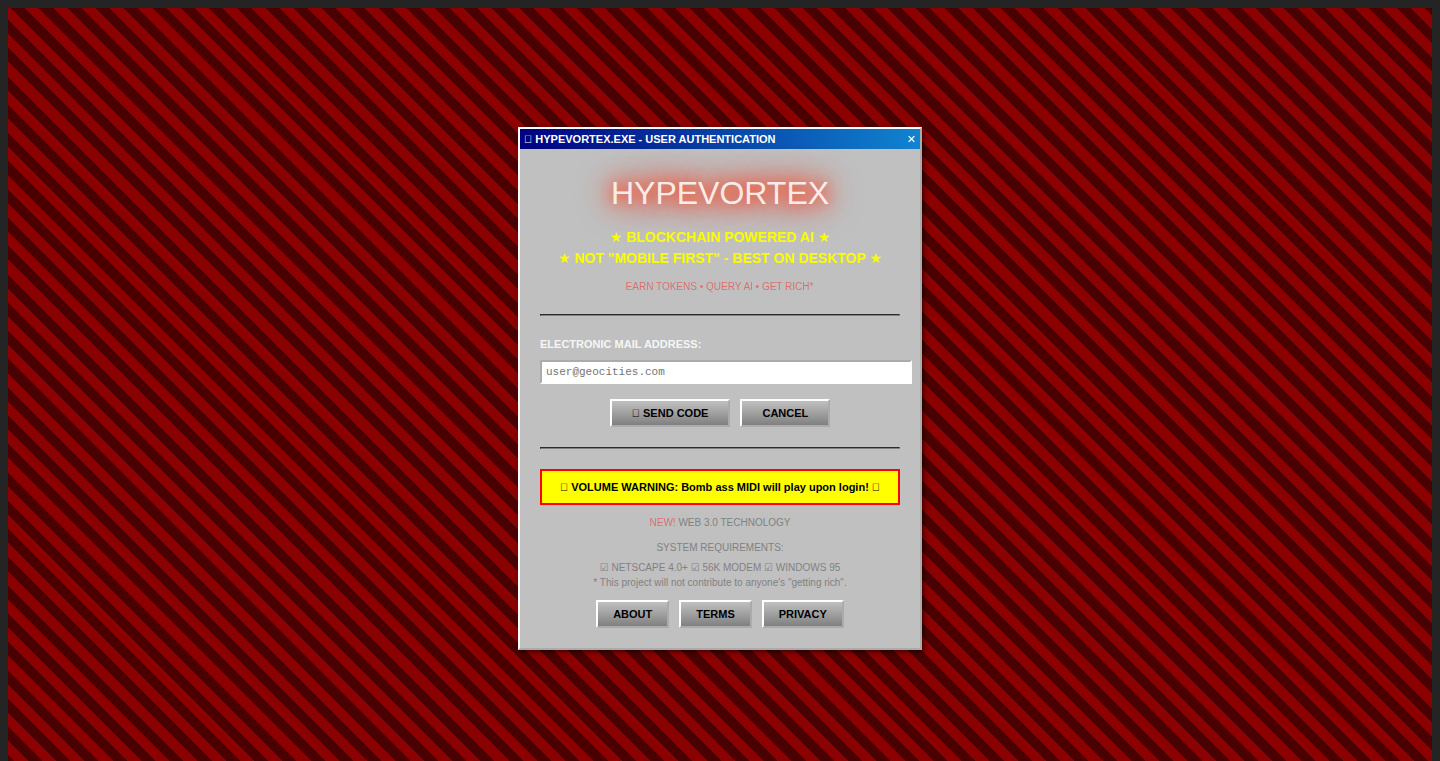
Author
seedlessmike
Description
HypeVortex is a playful project that merges the worlds of cryptocurrency and artificial intelligence, in a deliberately silly way. It issues its own worthless token on the Polygon blockchain, which users earn and then 'spend' on AI tasks. The site is designed in a retro 'geocities' style, complete with MIDI music, aiming for a nostalgic user experience. The core innovation lies in the use of a token as a virtual currency within an AI-powered application, highlighting the often-abstract concept of 'tokens' in the context of Large Language Models (LLMs) and the cost of AI interactions. It provides a lighthearted way to understand how AI services are metered and billed.
Popularity
Points 3
Comments 3
What is this product?
HypeVortex is a web application where users create an account (using email) and receive a worthless cryptocurrency token on the Polygon blockchain. This token is then used to 'pay' for various AI-related actions within the site. The technical innovation is the integration of blockchain technology and AI to simulate the cost of using AI services, similar to how LLMs are priced based on token usage. It uses email authentication and stores user emails as a hash for privacy. The project emphasizes the concept of tokens, reminding users of the 'Token Mania' of 2020-2021, and does so with a deliberately useless, yet entertaining, application. So this project is for anyone wanting to explore how AI is measured and billed, in a silly and fun way.
How to use it?
Users access HypeVortex through a web browser. They sign up with an email address and receive a verification code. Once logged in, they are given a token balance, and they can then use this token to perform AI-related tasks. The project provides a basic interface to interact with AI, allowing users to 'spend' their tokens. This allows developers to create similar applications that deal with blockchain technology and AI cost management to simulate interactions between users and AI services. So developers can use the project as a template to experiment with blockchain and AI, similar to the way AI-related tasks are priced.
Product Core Function
· Token Issuance and Distribution: The core of the project is the generation and distribution of a unique, worthless cryptocurrency token on the Polygon blockchain. This token serves as the virtual currency within the application. This teaches developers how to implement a token system within their AI projects and understand the real-world implications of costs and resource allocation. So it lets developers understand how to create and manage a token economy within an application.
· AI Interaction with Token Usage: The project simulates the 'spending' of the tokens for AI interactions, thus creating a basic cost system. This provides a practical analogy of how the use of AI services, such as LLMs, is metered and billed based on token usage. This helps developers in understanding the practicalities of using and paying for the AI services. So it lets developers better understand how to model costs related to AI services.
· Retro-Themed Interface: The site's design and user interface are styled in a retro 'geocities' style. This aesthetic choice adds a nostalgic element to the user experience. Developers can integrate retro design principles with modern web applications and learn how to incorporate nostalgia into their projects. So it lets developers to get a unique design perspective and understand how the nostalgia design can make a product more memorable.
· Email-based Authentication: The project uses email for user authentication, with the email stored as a hash for privacy. Developers can understand how to create secure authentication mechanisms. So it enables developers to build secure user authentication systems.
· Blockchain Integration: The project uses the Polygon blockchain, allowing the project to showcase how to integrate blockchain into web applications. Developers can learn how to interact with blockchain networks and use them to track and manage virtual assets. So it shows developers how to work with blockchain features within their projects.
Product Usage Case
· Educational Tool: The project can be used as an educational tool to teach others how AI is used and how it is billed. Developers can use it to explain the concepts of tokens and AI costs to non-technical audiences. So it helps build a deeper understanding of how these technologies function.
· Experimentation with Tokenomics: Developers can use the project as a starting point for their token-based experiments. By modifying the token logic or the AI interaction mechanism, they can explore different token economy models. So it provides a sandbox for experimenting with token economies.
· AI Cost Simulation: Developers can utilize the core ideas to simulate the costs associated with AI services, allowing them to build applications that are more transparent to their users. So it provides developers with more insight into AI service costs and billing.
· Retro Web Design Practice: Designers and developers can utilize the project's retro design to study design techniques. They can analyze its design decisions to understand the effect on user experience and user engagement. So it allows a better understanding of how retro design can be applied in modern applications.
· Blockchain Integration Example: Developers can use the token integration as a blueprint to study how blockchain can be integrated within their project. So it provides a good learning resource for those looking to understand blockchain integration with other technologies.
13
Kuvasz Uptime 2.5.0: Advanced HTTP Monitoring
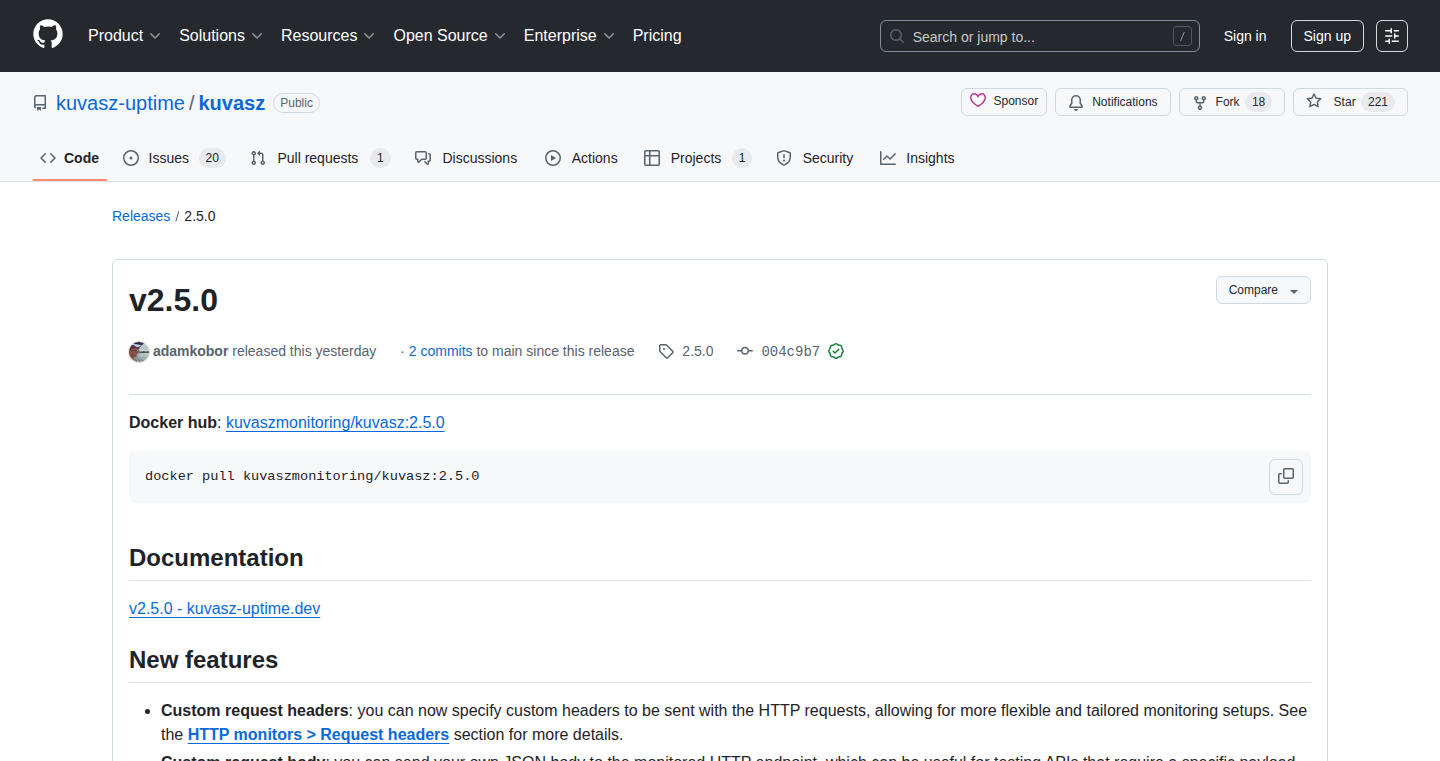
Author
akobor
Description
Kuvasz Uptime is a tool that monitors the uptime of your websites and services. This update introduces the ability to customize the HTTP requests it sends, allowing you to specify custom request headers and even send a JSON request body. Moreover, you can define expected response headers to verify your service's behavior. This is a significant step up from basic uptime checks, enabling detailed service monitoring and validation. It tackles the problem of accurately simulating and testing how services handle complex HTTP requests and responses, something traditional uptime monitors often fail to do.
Popularity
Points 5
Comments 0
What is this product?
Kuvasz Uptime 2.5.0 allows you to go beyond simple 'is the website up?' checks. You can now define exactly how the monitor interacts with your services. You can add custom headers, which are like extra instructions attached to the request (e.g., authentication tokens), and send a JSON request body, which is like sending data to your service. Furthermore, you can specify what response headers you expect to see back, like the status code, which tells you whether the request was successful. The innovation lies in providing fine-grained control over the request and response validation, allowing developers to test a wider array of scenarios and configurations. So this lets you test more complex services, which is very useful.
How to use it?
Developers can use Kuvasz Uptime by providing configuration files that define the HTTP requests. They specify the URL to monitor, the request method (GET, POST, etc.), any custom headers, and the JSON body if needed. Then, they define the expected headers in the response. Kuvasz Uptime regularly sends these requests and checks for the correct response. You could integrate it into your CI/CD pipeline to ensure your service's availability and correct functioning after every code change. For example, to make sure your API responds to the custom authentication token, you add the header to every request. This helps you find and fix issues quickly.
Product Core Function
· Custom Request Headers: This allows developers to include custom headers in their HTTP requests. This is essential for testing services that require authentication, specific content types, or other custom configurations. It ensures your monitoring accurately reflects how your service interacts with real-world requests. So you can simulate a real user’s request and check whether everything is working as expected.
· JSON Request Body: Enables sending a JSON body with the HTTP request. This is crucial for testing APIs that accept data in JSON format, which is extremely common. It allows for simulating POST, PUT, and other requests with data. So, by using this, you make sure your service is working as expected.
· Expected Response Headers: This feature validates the response headers returned by the service. It allows you to check for the status code, content type, and other important headers. This validates whether your service responded properly, providing a more accurate indication of its health. So this verifies that the server responds with the correct status.
· Uptime Monitoring: This feature checks whether your website or service is online by sending an HTTP request and verifying the response. So you can identify any downtime on your service.
Product Usage Case
· API Monitoring: A developer can use Kuvasz Uptime to monitor the availability and performance of their API endpoints. By specifying custom headers, they can ensure that requests with authentication tokens are correctly processed. By checking the response headers, they can also verify that the API is returning the correct status codes (e.g., 200 OK) and content types. So you can ensure your API is working.
· Microservices Health Checks: In a microservices architecture, developers can use Kuvasz Uptime to monitor the health of each individual service. By sending specific requests to each service and checking the responses, they can quickly identify which services are experiencing issues, improving overall system resilience. So, you can quickly identify which services are down.
· CI/CD Integration: During automated testing in CI/CD, developers can use Kuvasz Uptime to verify that changes to their services haven't broken any functionality. They can set up checks to be executed after deployments, ensuring the new version functions as expected before it goes to production. So it provides an easy way to guarantee your service is always online.
14
CopyMagic: Intelligent Offline Clipboard Manager
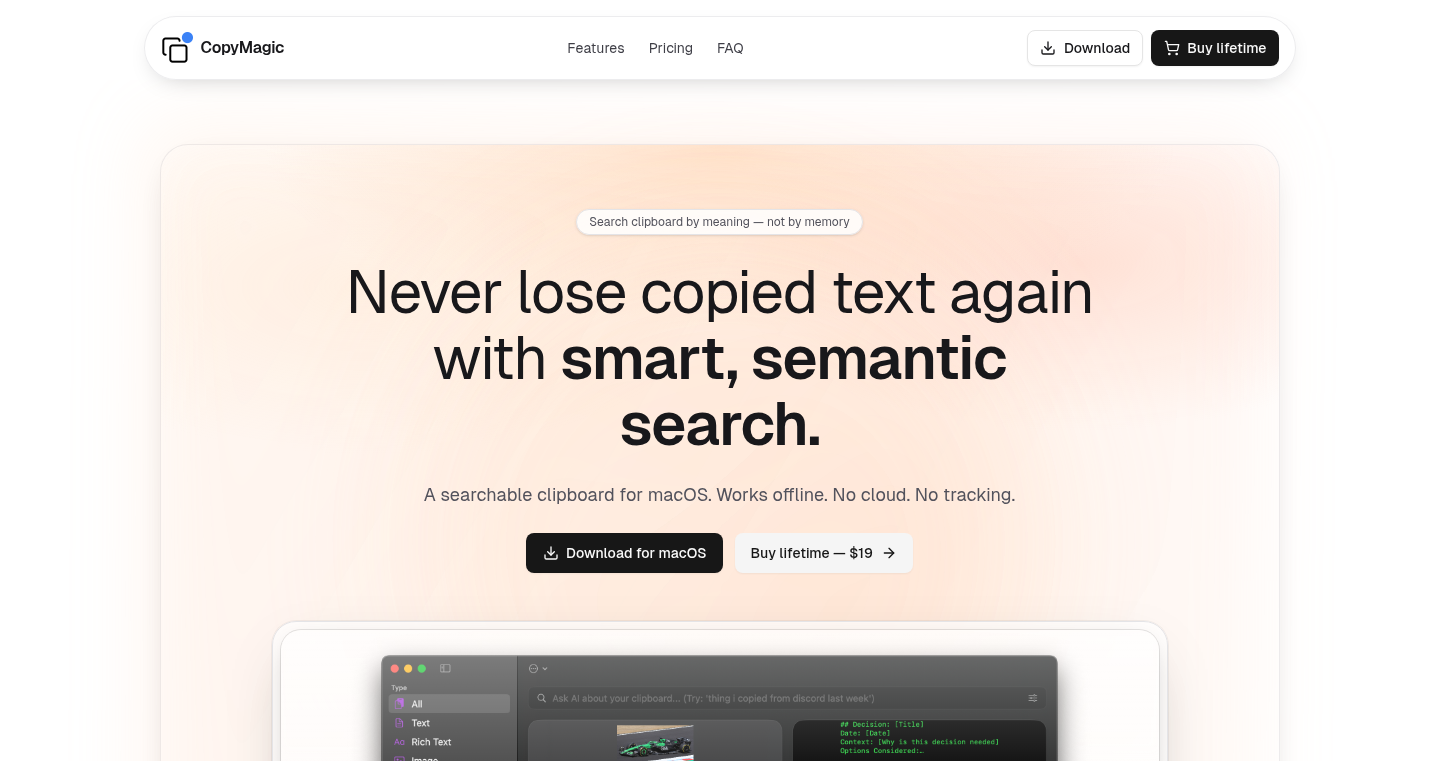
Author
rtk0
Description
CopyMagic is a smart clipboard manager for macOS that goes beyond simply storing copied items. It allows you to instantly retrieve specific information from your clipboard history using natural language queries, like asking for "URL from Slack" or "flight information." The key innovation lies in its offline operation and privacy-focused design, ensuring your data remains secure without relying on cloud services or tracking user activity. It addresses the common problem of losing important copied data in a long clipboard history by providing an intuitive and efficient search functionality. So, this provides a fast and private way to manage your clipboard.
Popularity
Points 3
Comments 2
What is this product?
CopyMagic is like a super-powered clipboard. Instead of just storing everything you copy, it understands what you're looking for. When you type a search like "email address" or "price of Bitcoin", it quickly finds the relevant item from your past copies. The technology works offline, meaning your data stays on your computer, and it does not track what you copy, so you can be assured of your privacy. This is innovative because it's more than just storing data, it makes that data easily searchable and secure.
How to use it?
Developers can use CopyMagic to quickly access code snippets, API keys, error messages, or any other information they regularly copy. They can simply type a query related to the item they are looking for, and CopyMagic will retrieve it. Integration is straightforward: install the macOS app and it works in the background, always ready. So, this saves time by providing instant access to frequently used code or information.
Product Core Function
· Intelligent Search: Users can search their clipboard history using natural language queries. This allows you to find relevant information quickly without manually browsing through numerous clipboard entries. This is useful because it reduces time spent searching for data.
· Offline Operation: The application functions entirely offline, guaranteeing user privacy and data security. This is valuable because it allows you to safeguard sensitive information.
· Privacy-First Design: CopyMagic does not track any user analytics or copy data, ensuring that all data is stored locally and users' privacy is respected. This is crucial because it keeps your sensitive information secure.
· Fast Retrieval: Results are displayed instantaneously, providing a highly efficient and fast way to access your copied data. This is beneficial as it significantly speeds up your workflow.
· Clipboard Management: It automatically saves every item copied to the clipboard for quick retrieval when needed. This is essential as it prevents losing important snippets or data.
Product Usage Case
· Code Snippet Retrieval: A developer copies a complex SQL query. Later, they need it again. Instead of retyping or searching through numerous browser tabs, they type "SQL query" into CopyMagic, and the query is immediately found. This saves time and reduces the risk of errors.
· API Key Management: A developer copies an API key. When they need to use it later, they can just search for "API key" within CopyMagic. The tool allows them to find the correct key instantly, without having to check multiple configuration files. This provides a secure and time-saving method for managing sensitive information.
· Error Message Lookup: A developer encounters a common error and copies the error message. Later, they want to review the message again. CopyMagic can quickly find that specific message, saving time compared to scrolling through logs. So, this streamlines debugging and problem-solving in coding.
· Documenting Frequently Used Data: A writer copies different pieces of information from different sources while researching an article. CopyMagic helps them retrieve specific data by searching for keywords in their clipboard history. So, this streamlines research and reduces time spent re-finding copied data.
15
MockinglyAI: On-Demand AI System Design Interviewer
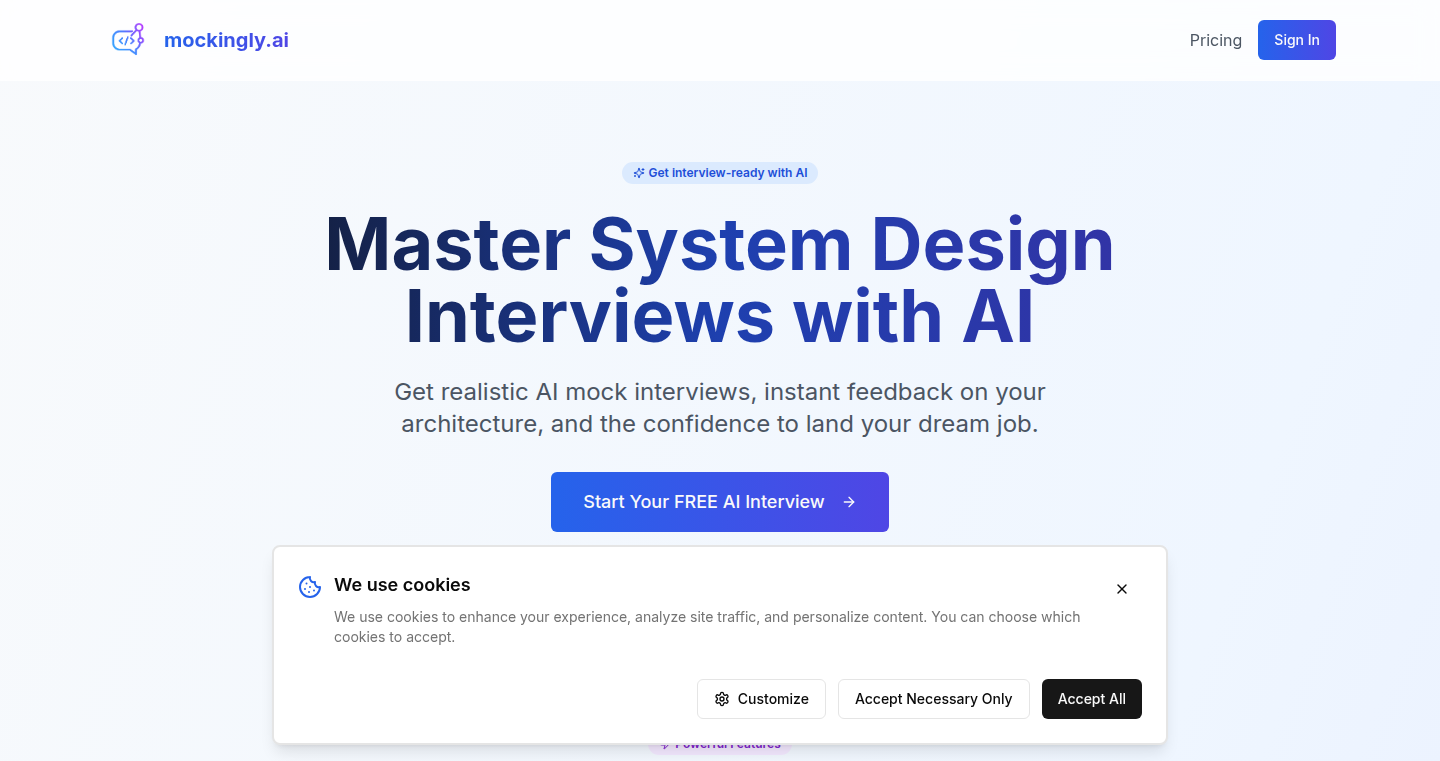
Author
ayusch_
Description
MockinglyAI is an AI-powered tool designed to simulate system design interviews for software engineers. It allows developers to practice these crucial interviews anytime, anywhere, providing on-demand feedback and guidance. The technical innovation lies in its use of AI to understand and respond to complex system design prompts, effectively mimicking the role of a human interviewer and offering realistic interview practice. It solves the problem of needing a human interviewer for preparation, making practice accessible and convenient.
Popularity
Points 3
Comments 1
What is this product?
MockinglyAI is an AI that acts as your interview buddy. It understands system design questions and responds like a real interviewer. It uses sophisticated AI models to evaluate your answers, offer suggestions, and help you improve your system design skills. The core innovation is its ability to deliver personalized and interactive interview practice on demand, leveraging AI to create a realistic and responsive interview environment. So what? You can practice anytime without needing to find a human interviewer.
How to use it?
You can access MockinglyAI through a web interface. You'll be presented with system design prompts, and you can verbally or textually respond to them. The AI will then provide feedback, ask follow-up questions, and guide you through the design process. You can use it to practice for job interviews, improve your design thinking, or simply learn about system design principles. So what? Practice makes perfect, especially for tricky interview types.
Product Core Function
· On-demand System Design Prompts: The AI provides various system design prompts covering different areas like scalability, databases, and caching. This allows you to practice a wide range of design scenarios. (So what? It's like having a practice set tailor-made for interview preparation).
· Interactive Interview Simulation: The AI simulates a real interview, asking follow-up questions, probing for details, and providing feedback on your answers. This immersive experience helps you get comfortable with the interview format. (So what? You build your confidence and reduce interview anxiety).
· Personalized Feedback: The AI analyzes your responses and provides tailored feedback, highlighting areas for improvement in your design choices, explanations, and trade-offs. (So what? It pinpoints your weaknesses and provides guidance for improvement).
· Design Evaluation: MockinglyAI evaluates your design based on factors like scalability, reliability, and efficiency, providing you with valuable insights into the strengths and weaknesses of your proposed system architecture. (So what? You learn how to make better design decisions).
Product Usage Case
· Preparing for a Job Interview: A software engineer prepares for a system design interview by using MockinglyAI to practice common interview questions. The AI provides feedback on their design choices and explanations, helping them to refine their responses and improve their overall performance. (So what? You'll be ready to ace the interview).
· Learning System Design Fundamentals: A junior developer uses MockinglyAI to learn about system design principles by practicing different design scenarios. The AI provides guidance and feedback, helping them to understand the concepts and make better design choices. (So what? You learn how systems really work!).
· Improving Design Thinking: A senior engineer uses MockinglyAI to challenge their existing design thinking by exploring different design trade-offs and evaluating different system architectures. The AI provides a platform for experimentation and learning. (So what? Become a better problem solver).
· Team Training: Engineering teams can use MockinglyAI to standardize their interview preparation. The tool can be used to consistently assess and improve candidates' design capabilities, streamlining the hiring process. (So what? Makes the hiring process fairer and helps find the right talent).
16
BirdNET-Go: AI-Powered Avian Sound Identification
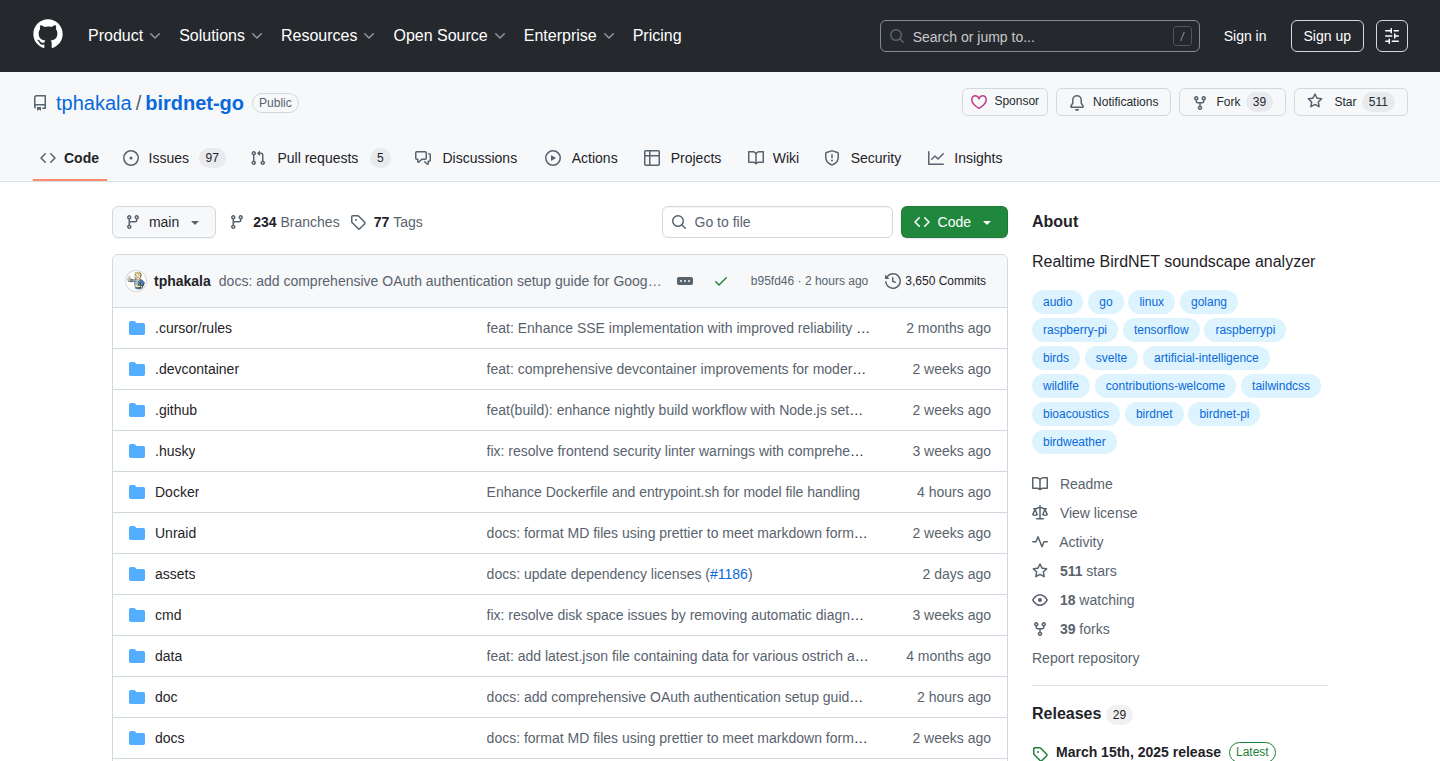
Author
zephyreon
Description
BirdNET-Go is a command-line tool that identifies bird species from audio recordings using artificial intelligence. It leverages a pre-trained neural network to analyze soundscapes and pinpoint the presence and species of birds. The project focuses on efficiency and portability, making it easy to use on various platforms, including resource-constrained devices like Raspberry Pi. It addresses the challenge of automatically analyzing large amounts of audio data for ornithological research and hobbyist birdwatching.
Popularity
Points 3
Comments 1
What is this product?
BirdNET-Go employs a deep learning model trained on vast datasets of bird vocalizations. When you feed it an audio recording, it processes the sound, extracts relevant features, and compares them against its internal database of bird song signatures. The innovation lies in its efficiency – it's designed to run quickly and consume minimal resources. This means you can identify birds in real-time on a small device in the field. It uses a pre-trained model, so you don't need to train a model yourself, simplifying the process.
How to use it?
Developers can use BirdNET-Go through the command line. You provide an audio file (e.g., a WAV or MP3 recording), and the tool analyzes it, outputting a list of identified bird species along with their confidence scores. It's easily integrated into other scripts and applications. For example, a developer could build a system that automatically identifies birdsong heard by a microphone, logs the results, and sends alerts. This is particularly useful for ecological monitoring, citizen science projects, or building interactive bird identification apps.
Product Core Function
· Real-time Bird Identification: Analyzes audio recordings in real-time to identify bird species. This allows for immediate results and is valuable for on-the-spot observation. So this is useful for instant identification of birdsong, improving the birdwatching experience.
· Offline Functionality: Works without requiring an internet connection, thanks to the pre-trained AI model. This is crucial for remote fieldwork where internet access is limited. So this is useful for any location, allowing for identification in environments without internet access.
· Cross-Platform Compatibility: Operates on various operating systems and hardware, including low-power devices like Raspberry Pi. This makes it accessible to a wider range of users and suitable for diverse deployment scenarios. So this is useful because it runs almost anywhere, offering flexibility and accessibility.
· Command-Line Interface: Provides a simple and effective command-line interface for easy integration into other programs or systems. This allows for automation and customization. So this is useful for automated bird monitoring and integration into more extensive systems.
· Species Specificity: Focuses specifically on identifying avian species, providing high accuracy for its target class. This specialization ensures accuracy and efficiency in bird identification. So this is useful for anyone concerned with understanding specific bird populations in their local areas.
Product Usage Case
· Ecological Monitoring: Researchers can deploy BirdNET-Go to monitor bird populations in specific areas. Audio recorders placed in the field can capture bird sounds, and the tool can automatically identify species and track their presence over time, providing valuable data for conservation efforts. This is useful because it allows for large-scale, automated data collection.
· Citizen Science Projects: Bird enthusiasts and citizen scientists can use BirdNET-Go to contribute to bird research. They can record bird sounds in their backyards or local parks and upload them for analysis, providing valuable data for ornithologists. So this is useful for empowering enthusiasts to actively participate in scientific studies.
· Educational Applications: Educators can incorporate BirdNET-Go into classroom activities to teach students about bird identification and ecology. Students can analyze recordings, identify species, and learn about their habitats and behaviors. So this is useful to provide hands-on learning opportunities for students.
· Birdwatching Apps: Developers can integrate BirdNET-Go into mobile apps to offer users an interactive bird identification experience. Users can record bird sounds using their phone's microphone, and the app can identify the species in real-time. So this is useful for enhancing birdwatching by providing immediate information on found species.
· Automated Bird Sound Analysis: Libraries and researchers can automate the analysis of vast audio archives. This is useful for identifying bird songs, allowing users to track activity patterns and environmental changes.
17
betterAEO: AI Answer Engine Optimization Analyzer
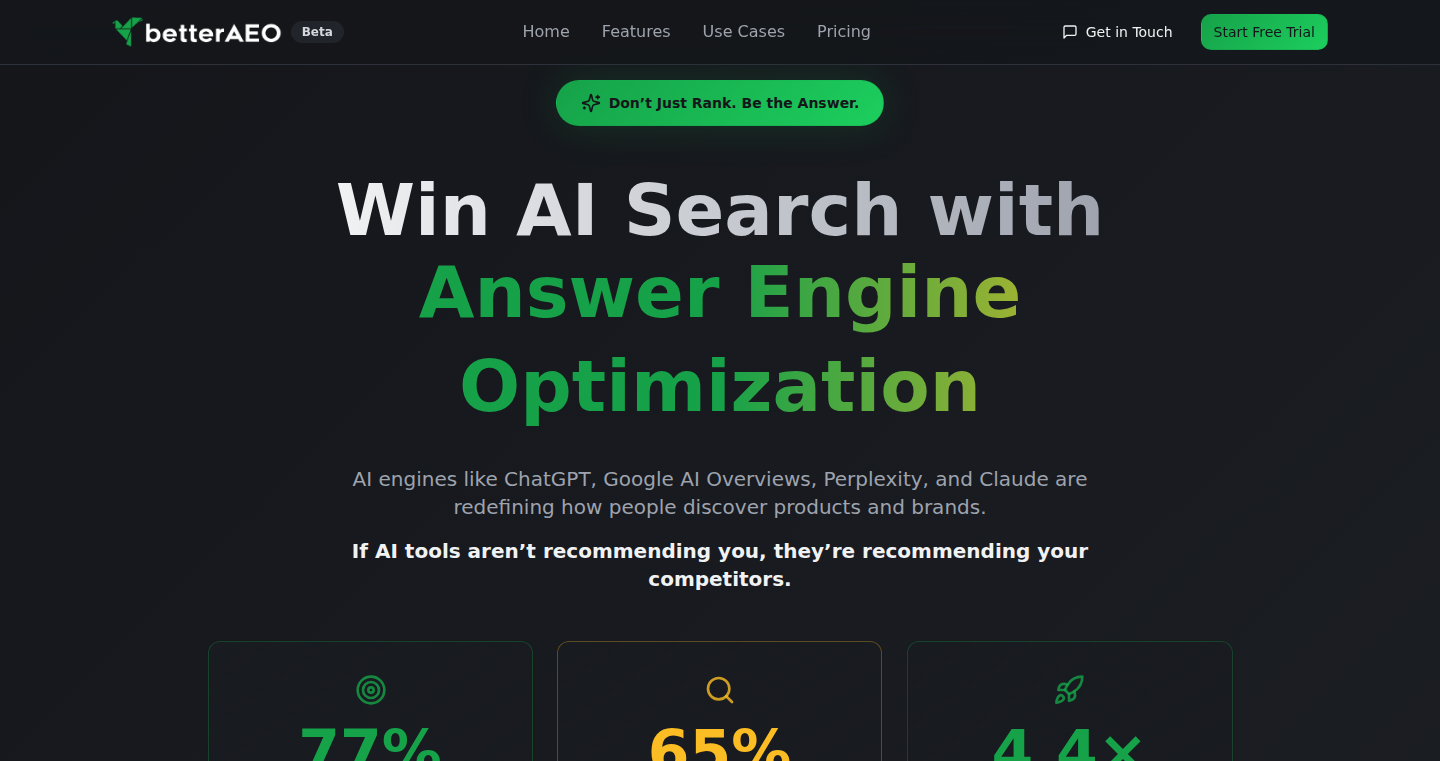
Author
mukul767
Description
betterAEO is a tool designed to help websites understand and improve how they appear in AI-generated answers from platforms like ChatGPT and Google AI Overviews. It addresses the critical issue that traditional SEO metrics are often insufficient for visibility in AI search results. The tool provides an 'AEO Score' to measure a site's AI-readiness, identifies gaps in content, and offers AI-powered recommendations to enhance visibility. This is a significant technical innovation because it moves beyond traditional search engine optimization, focusing on the emerging landscape of AI-driven search, providing a structured approach to optimizing content for AI consumption.
Popularity
Points 1
Comments 2
What is this product?
betterAEO is a web-based tool that assesses how well a website is prepared to be featured in AI-generated summaries. It works by analyzing various aspects of a webpage, such as its structure (like schema markup, which is a way to provide structured data to search engines), the relevance of its content to search queries, and how the information is presented. It then gives the website an 'AEO Score' and offers specific suggestions, powered by AI, to improve its chances of being selected and featured in AI answers. This goes beyond traditional SEO, which often focuses on things like keywords and backlinks, instead focusing on how AI systems understand and summarize information. So this is useful for content creators because it gives them a structured framework for optimizing their content for AI-driven search.
How to use it?
Developers and content creators can use betterAEO by simply entering a website URL. The tool will then scan the page or the entire site, analyzing different factors like schema markup, snippet formatting, and content relevance. After the scan, the tool provides an AEO score and detailed recommendations. These recommendations are actionable and offer practical advice on how to adjust the website's content, structure, and presentation to better align with AI search algorithms. The tool can be integrated into existing SEO workflows or used as a standalone diagnostic tool. So this is useful because it helps content creators to understand and take steps to improve the visibility of their content in AI-generated answers.
Product Core Function
· AEO Score Measurement: This is the core function that provides a single metric to assess a website's AI-readiness. The score reflects how well the website is optimized for AI-driven search. This is useful because it provides a quick and easy way for content creators to understand their website’s performance in the context of AI search.
· Gap Identification: The tool identifies specific areas where a website may be lacking in terms of AI optimization, such as missing schema markup or poorly formatted snippets. This is useful because it helps identify weaknesses in a website's content strategy that make it less likely to be featured in AI answers.
· AI-Powered Recommendations: The tool generates AI-driven suggestions to fix or improve identified issues. These recommendations are based on current best practices and are designed to boost visibility in AI-generated answers. This is useful because it provides concrete steps for content creators to improve their content to be considered in AI-driven searches.
· Historical Scoring and Reporting: The tool tracks the AEO score over time, allowing users to monitor their progress and see the impact of their optimizations. This is useful because it allows content creators to track the impact of their changes and make data-driven decisions.
· Single-Page and Full-Site Crawls: The tool offers the flexibility to scan either a single page or an entire website. This versatility allows users to assess and optimize their content at various scales. This is useful because it adapts to different content strategy needs, whether a single page needs adjustments or an entire site audit is necessary.
Product Usage Case
· Content Marketing: A content marketer notices their articles aren't showing up in AI-generated answers, even with good SEO. Using betterAEO, they identify missing schema and poor snippet formatting. Implementing the tool's recommendations, they improve their website's AI-readiness, leading to their articles being featured in AI summaries, increasing website traffic. This is useful because it helps marketers optimize content for AI-driven search.
· SEO Auditing: An SEO specialist is conducting a site audit for a client. BetterAEO is used to identify aspects of the website's content that are hindering its visibility in AI summaries. The SEO specialist provides recommendations, improving the client’s overall online presence and ranking. This is useful because it adds a new dimension to SEO, going beyond traditional search engines.
· Website Development: A web developer is building a new website. They use betterAEO during the development phase to ensure the site is optimized for AI from the start, using its recommendations to implement best practices. This is useful because it helps to build websites that are ready for the future of search, optimizing their visibility within AI-driven platforms.
18
Git Flex: Contributor Insight Tool
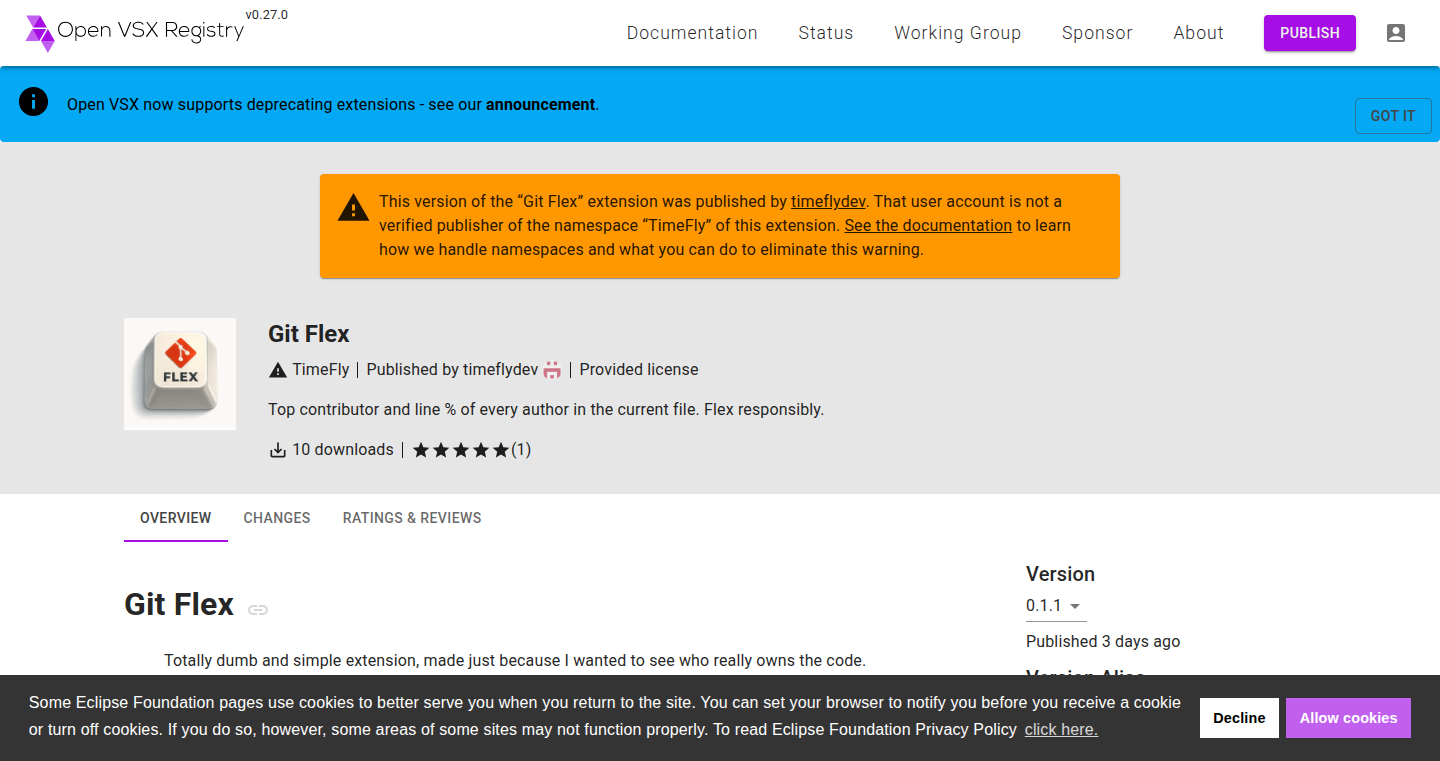
Author
cgonzar3
Description
Git Flex is a command-line tool that analyzes a Git repository to identify the top contributors and the percentage of lines of code they've written. It provides a quick and easy way to understand the contribution landscape of a project. The innovation lies in its ability to efficiently parse Git history and present the information in a clear and concise format, solving the problem of manually figuring out who contributes what in a code repository.
Popularity
Points 3
Comments 0
What is this product?
Git Flex is essentially a smart code analysis tool for your Git repositories. It dives into the history of your code and tells you who the most active contributors are and the proportion of the code each person has written. It's like having a quick dashboard of your project's development, helping you understand the team's effort distribution. It leverages the power of Git's internal data structures and parsing capabilities to give you these insights. So this is useful because it gives you a high-level view of project contribution.
How to use it?
Developers use Git Flex through their terminal (command line). You navigate to your project's Git repository and then run the Git Flex command. The tool will then process the repository's history and display a summary of contributors and their contributions. You could integrate it into your CI/CD pipeline to get contribution metrics automatically or use it during code reviews to understand who's touched the most code. So this can be very useful if you want an automated understanding of your project contributors.
Product Core Function
· Top Contributor Identification: This function analyzes the commit history to determine the developers who have made the most significant contributions, enabling project managers to quickly identify key contributors. Use case: project lead can identify who to reach out to for specific knowledge or expertise.
· Lines of Code per Author Percentage: This calculates the percentage of lines of code written by each author, giving insight into the distribution of work and the relative impact of each contributor. Use case: helps gauge the effort distribution and identifies potential bottlenecks or knowledge silos in a project.
· Efficient Git History Parsing: Git Flex utilizes efficient parsing techniques to avoid performance issues when analyzing large repositories. Use case: ensures the analysis runs quickly, even on projects with extensive codebases, providing timely insights.
Product Usage Case
· Open Source Project Analysis: A maintainer of an open-source project uses Git Flex to identify the top contributors to recognize their efforts and understand the project's development trends. This helps in community management and recognizing vital contributors, which helps in project's success.
· Code Review Context: A developer uses Git Flex to quickly see the contribution breakdown of a code base before a code review, understanding who's worked on specific areas and the context of changes. This enhances the effectiveness of code reviews by providing quick insights into authorship and code distribution.
· Team Performance Assessment: A project manager uses Git Flex to evaluate team performance by tracking the contribution of each team member over time. It assists in understanding the workload distribution and assessing individual team member impacts. This helps in monitoring project progress and provides insights into team dynamics.
19
BrowserUSBInspector: Real-time USB Device Identification
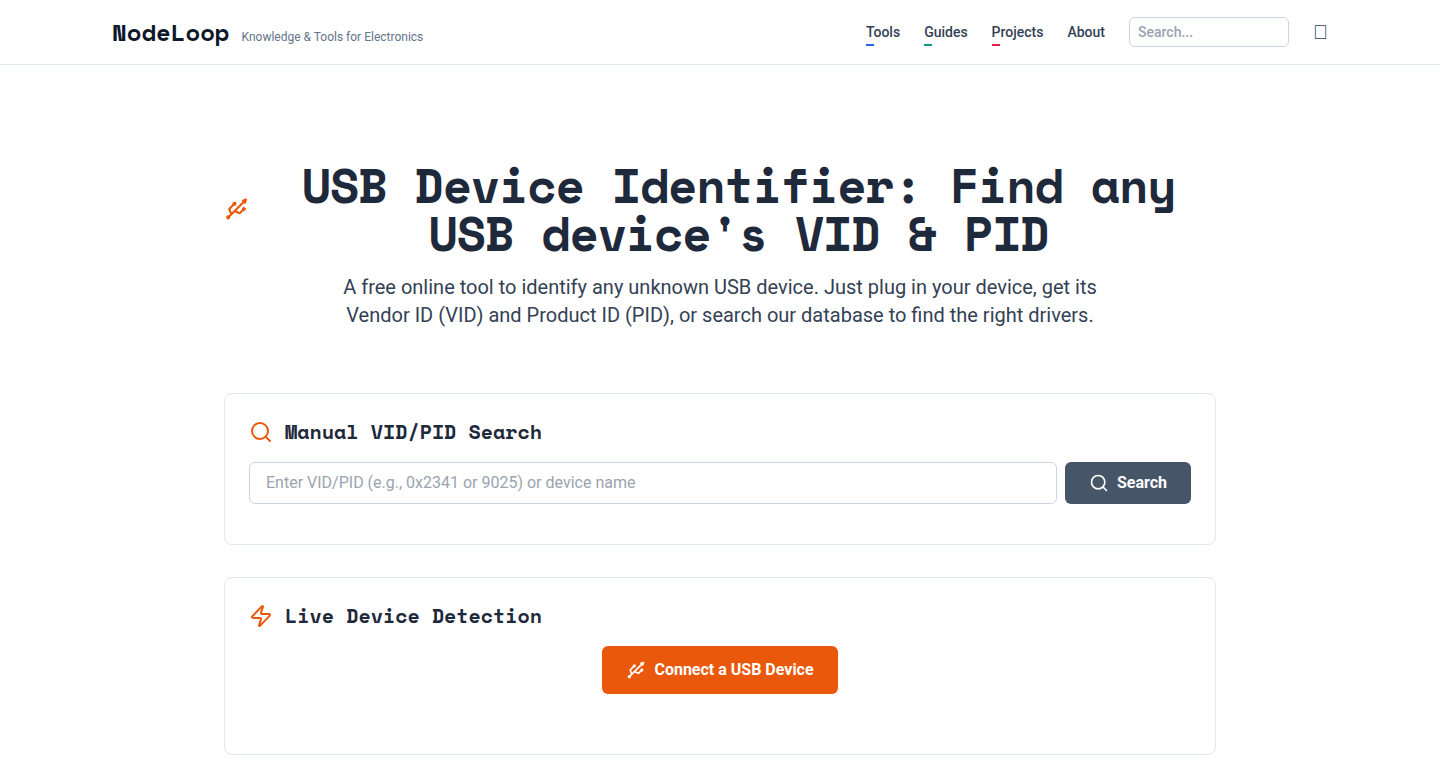
Author
eezZ
Description
This project allows you to identify connected USB devices directly within your web browser. It leverages the power of WebUSB, a web API that lets websites communicate with USB devices. The innovation lies in its ability to access and display detailed information about these devices, like vendor ID, product ID, and serial number, without needing any additional software or plugins. It solves the problem of easily identifying and managing USB devices connected to a computer, which is often a cumbersome task for developers and users alike.
Popularity
Points 2
Comments 1
What is this product?
BrowserUSBInspector is a web-based tool that uses WebUSB to read information from USB devices connected to your computer. It's like a digital detective for your USB ports! When you plug in a USB device and visit the website, the tool will show you its unique ID numbers (vendor and product), which are like digital fingerprints. It’s built using JavaScript and a modern web browser. The key innovation is using web technologies to access hardware details directly, bypassing traditional software dependencies.
How to use it?
Developers can integrate this into their own web applications to easily interact with specific USB devices. Imagine a web-based application controlling a piece of hardware, or a diagnostics tool identifying the correct device connected to a user's computer. You'd need a browser that supports WebUSB (like Chrome or Edge), connect your USB device, and then visit the webpage which contains the JavaScript code using the WebUSB API. The web application can then read the device details and interact with it accordingly.
Product Core Function
· Device Enumeration: The core feature is listing the connected USB devices in your browser. This eliminates the need to hunt through system settings or install custom drivers to see what's plugged in. So this is useful for developers who want a quick way to find a specific USB device.
· Vendor and Product ID Retrieval: It can retrieve vendor and product IDs, essential identifiers for USB devices. These IDs help uniquely identify the manufacturer and model of the device. This is useful for debugging hardware issues and developing applications specifically for certain USB devices.
· Serial Number Display: Allows users to view a device's serial number. This is often needed for identifying a specific device when multiple devices of the same type are connected. This is useful when you need to differentiate between multiple of the same type of devices.
Product Usage Case
· Hardware Debugging: A hardware engineer can use BrowserUSBInspector to quickly verify that a connected device is correctly recognized by the system and to examine device characteristics when troubleshooting hardware problems. So it’s useful for verifying the connections of a circuit board and to confirm the specific USB device model.
· Web-Based Hardware Control: Imagine a web application that controls a 3D printer or a robot arm. Using this tool, developers can identify the printer or the arm and communicate with it directly from a web browser. So it helps create an easy-to-use interface and reduces the need for complex software installations.
· Device Information Displays: The tool can be used in educational scenarios, where students can learn about USB devices and their identifiers. A website could display a user's devices with their vendor and product ID. So it's useful for educational website that requires user device information.
20
GeoHarmony: Restaurant Finder for Distributed Friend Groups

Author
mayukh180505
Description
GeoHarmony is a mobile application designed to locate restaurants that are equidistant from a group of friends, regardless of their individual locations. This project tackles the common problem of coordinating meetups across distances. The technical innovation lies in the efficient use of geographic algorithms to calculate the optimal meeting point, thereby simplifying the planning process. It solves the 'where should we eat?' dilemma with a technically sound and user-friendly approach.
Popularity
Points 1
Comments 2
What is this product?
GeoHarmony is a mobile app that takes your friends' locations and finds restaurants that are roughly the same distance from everyone. It uses clever math (specifically, geometric algorithms) to figure out the ideal meeting spot and suggests places to eat nearby. Think of it as a smart tool that simplifies group outings by automating the location-scouting process. So, it saves time and arguments when planning a meal with friends.
How to use it?
Developers would integrate GeoHarmony's core functionality into their own location-based apps or services. This could involve using the app's API (if available) to calculate meeting points, or adapting the underlying algorithms to suit different location data sources. For example, a social media platform could use GeoHarmony's technology to suggest restaurants to users based on their friends' current locations. This provides a seamless and useful feature for their users. So, developers can enrich their apps with a powerful meeting-point finder.
Product Core Function
· Equidistance Calculation: The core function involves complex calculations to find a central point that minimizes the distance from multiple user locations. This is done using algorithms that take into account geographic coordinates. This is useful for quickly finding a restaurant that is convenient for everyone. So, you can quickly find the best meeting point for your friend group.
· Restaurant Database Integration: GeoHarmony must access a restaurant database, possibly using APIs like Google Places or Yelp, to find restaurants near the calculated meeting point. This involves querying the database with geographic coordinates and filtering results based on criteria like cuisine type, rating, or price range. This is used to provide a list of restaurants. So, you don't have to search for a restaurant after a location has been determined.
· User Location Input: The app takes user location data, probably using GPS or manual input. The accuracy of the user location data affects the accuracy of the calculations. This is useful for accurate calculations of the central meeting point. So, you will always have an accurate result.
· User Interface (UI) and User Experience (UX): The design must be clean, simple, and easy to navigate. It needs to display the meeting point on a map, along with restaurant suggestions. This is used for ease of use and accessibility. So, anyone can easily use the app.
Product Usage Case
· Group Travel Planning: A travel app can integrate GeoHarmony's algorithm to suggest meeting points and nearby restaurants for a group of travelers, making the planning phase easier. This is used to optimize the travel planning. So, a group of people can plan a trip using a travel app.
· Event Planning: Event organizers can use GeoHarmony's core technology to find suitable locations for events, such as workshops or conferences, that are accessible to all attendees, particularly if the attendees are spread out geographically. This helps the organizer plan events with convenient locations. So, it is easier to plan events.
· Social Networking: A social networking app might integrate this technology to suggest meetup spots and restaurants to friends, based on their real-time or saved locations. This can be used to enhance social interactions within the platform. So, your social media platform can recommend places to go for you and your friends.
21
AwkBLAKE3: BLAKE3 Hashing in Awk
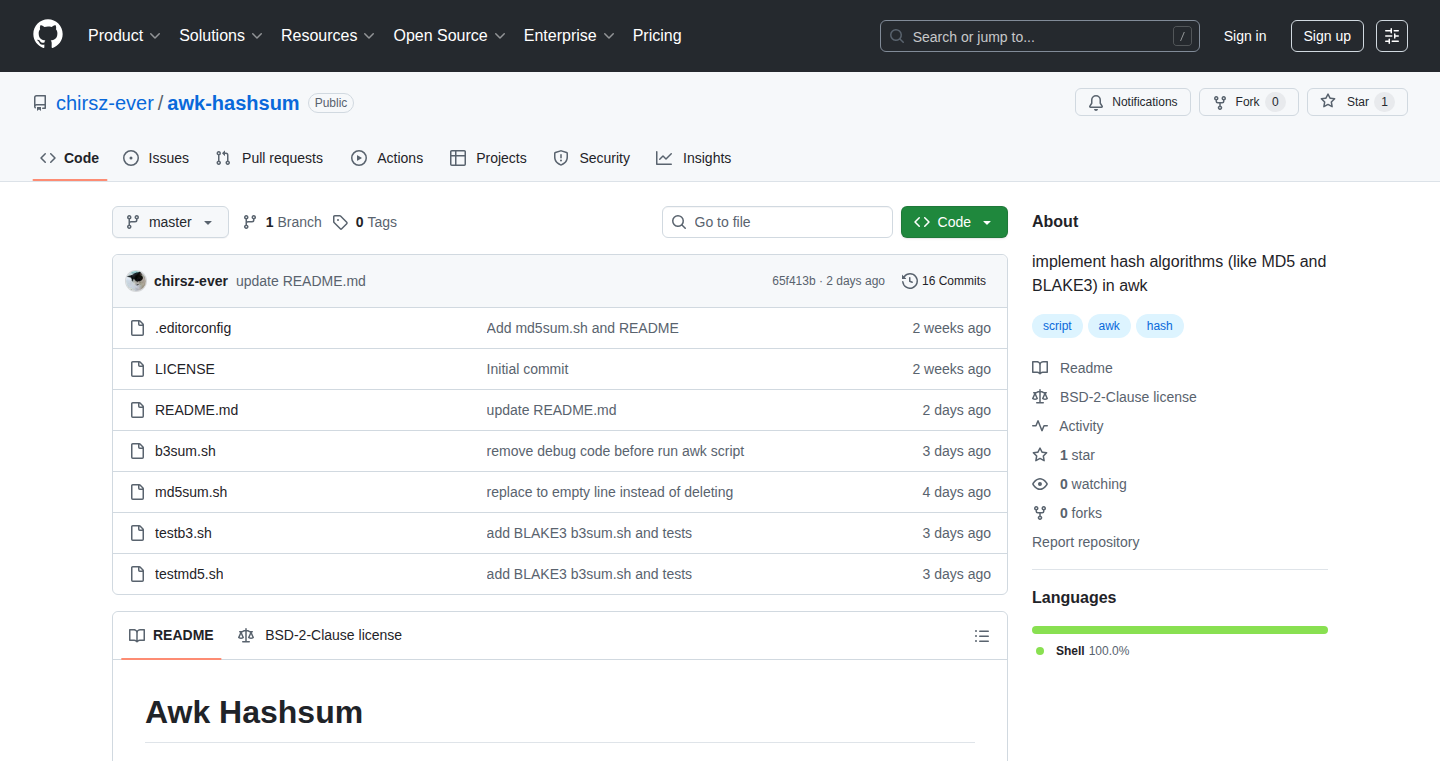
Author
chirsz
Description
This project implements the BLAKE3 cryptographic hash function entirely within the Awk programming language. It showcases the surprising power of Awk, traditionally used for text processing, by demonstrating its capability to perform complex cryptographic operations. It tackles the problem of needing a fast and secure hashing algorithm within environments where more powerful tools might be unavailable or impractical. This project reveals the potential of simple, readily available tools to address complex technical challenges.
Popularity
Points 2
Comments 1
What is this product?
This is a complete implementation of the BLAKE3 hashing algorithm written entirely in Awk. BLAKE3 is a modern and very fast way to create a unique "fingerprint" of any data. This Awk implementation allows users to generate these fingerprints directly within Awk scripts, without relying on external tools. It leverages Awk's ability to manipulate strings and perform basic arithmetic to achieve this, showcasing how far the language can stretch beyond simple text processing.
How to use it?
Developers can use this by including the Awk script (which defines the BLAKE3 hashing function) within their existing Awk scripts. They can then feed data into this function, and it will output the BLAKE3 hash. This is particularly useful in environments where Awk is readily available, such as server-side scripting, data processing pipelines, or even embedded systems where resources are limited. You'd integrate it by simply including the provided Awk functions in your script and calling them to hash the data you need to process.
Product Core Function
· BLAKE3 Hash Generation: The core function of the project. It takes any input data (text strings) and calculates the BLAKE3 hash. So what? This allows users to verify data integrity, detect file changes, or create unique identifiers for data within an Awk environment. It's like having a built-in security guard that ensures the data hasn't been tampered with, which is invaluable for data validation and security audits.
· String Manipulation within Awk: The project demonstrates the advanced usage of Awk's string manipulation capabilities. It shows how to handle binary data and perform bitwise operations within Awk's string processing environment. So what? This allows users to understand how to perform low-level data operations that are usually handled by more powerful languages. It allows for advanced data transformation within the limited scope of an Awk script, expanding the power of scripting.
Product Usage Case
· Data Integrity Checks: Use this to verify the integrity of log files processed in Awk. Before and after processing the file, you can use BLAKE3 to hash it, ensuring that the processing didn't corrupt the data. So what? Ensures that the critical logging data remains valid and unchanged.
· Simple Data Deduplication: Use BLAKE3 to create a unique identifier for each data record and easily identify duplicates. So what? Allows for a faster and more efficient identification of duplicate records without relying on heavy or complicated tools.
· Integrating with Existing Scripts: Add this to the scripts used for data analysis and reporting, thereby simplifying data verification and validation steps. So what? It can streamline and harden the data processing workflow, making it faster and more reliable.
22
Ginormous News: AI-Powered Global Radio News Briefings

Author
julianchr
Description
Ginormous News is a daily briefing service that distills key global news stories from 20 international radio stations. It leverages cutting-edge AI, including Whisper for multilingual transcription and advanced Language Learning Models (LLMs), to analyze and summarize broadcasts. The focus is on providing concise, accurate summaries, grounded in original quotes to minimize errors and keep the information relevant. This innovative approach addresses the issue of information silos, offering a broader perspective on global events.
Popularity
Points 3
Comments 0
What is this product?
Ginormous News is an automated news aggregator. It works by listening to and transcribing audio from 20 international radio stations using Whisper, a state-of-the-art speech-to-text model. Then, it uses sophisticated LLMs to analyze the transcribed text, identify the most important news stories, and generate concise summaries. The system prioritizes using original quotes from the broadcasts to enhance accuracy and reduce the risk of the AI making things up. So, you get a daily digest of global news, curated and summarized by AI, from a diverse set of sources. So, this helps me get informed about global events. I can easily catch up on important news from various countries without having to sift through multiple news websites or translate languages myself.
How to use it?
To use Ginormous News, you simply subscribe to the free daily briefing. It arrives in your inbox each morning, summarizing the most important global news stories of the day, pulled from international radio broadcasts. There is no direct interaction with the underlying tech – it's designed to be a simple, easy-to-consume service. This is a great way to quickly get up-to-date on international news without needing to search through various news sources yourself. You get a daily email with the key information. So, this makes it easier to stay informed about global events without spending a lot of time reading.
Product Core Function
· Multilingual Transcription with Whisper: This function uses the Whisper model to convert audio from various international radio stations into text. This is the foundation for all subsequent processing. The value is that it overcomes language barriers, allowing the system to understand and analyze content from a wide range of sources. This enables the service to include news from different countries and languages. So, this is useful for understanding the news from different countries.
· AI-Powered News Summarization with LLMs: Advanced Language Learning Models are used to analyze the transcribed text and identify key news stories. They summarize these stories, prioritizing concise and accurate information. The value is the ability to quickly extract the essential information from multiple sources. This saves time and provides a focused overview of global events. So, it summarizes complex news to save time.
· Source Verification and Accuracy Enhancement: The system emphasizes using direct quotes from the radio broadcasts to reduce 'hallucinations' (AI errors). This grounding in original quotes is crucial to ensure the reliability of the news summaries. The value is that it enhances the credibility and accuracy of the information provided, making the briefing more trustworthy. So, I can be confident that the information is correct.
· Automated Daily Briefing Delivery: Ginormous News automatically compiles the summaries and delivers them as a free daily email. The value is the ease of use and convenience. Users receive a curated digest of global news directly in their inbox each morning, ready to read. So, this saves time to get informed.
Product Usage Case
· Breaking Down Language Barriers: A tech journalist, who does not have a background in various languages can subscribe to the service and stay informed about international events, including news from countries with languages they do not understand. So, they will be updated with the global news.
· Time-Saving for Busy Professionals: An international business executive can quickly read the daily briefing, gaining a concise overview of global events and their potential impact on business decisions. So, he can make decisions quickly with the news digest.
· Cross-Cultural Understanding: Students of international relations can use the service to understand the perspectives of different countries and gain a broader understanding of global issues. So, it helps broaden the horizon for students.
23
Mudra: LLM Citation Analysis Tool
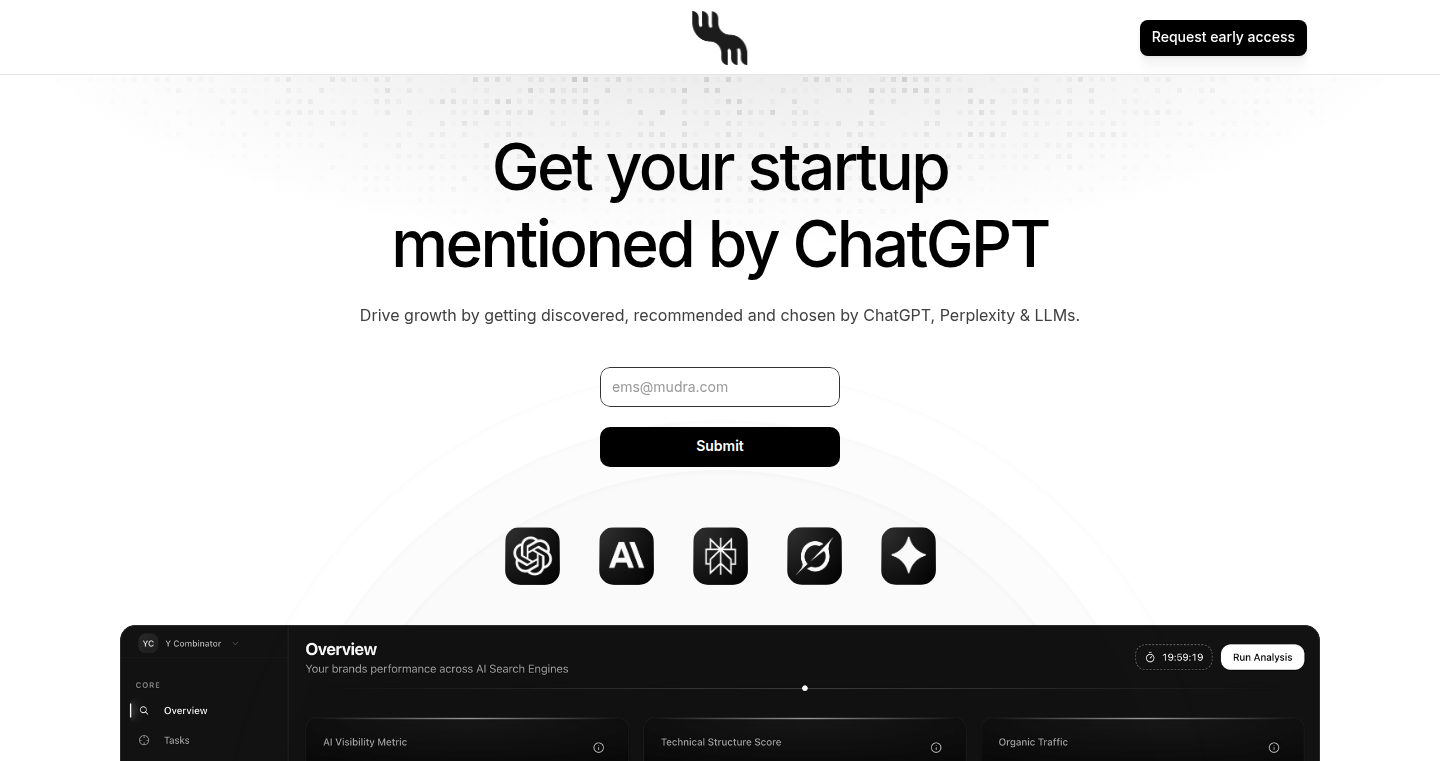
Author
NanocodesAI
Description
Mudra is a tool designed to help startups understand how Large Language Models (LLMs) like ChatGPT and Perplexity are citing their company, and identify opportunities to improve those citations. It leverages advanced natural language processing (NLP) techniques to analyze the output of LLMs and pinpoint where a company is mentioned and what context surrounds that mention. It addresses the challenge of getting your company information effectively presented and referenced within LLMs. So this helps me understand how my company is viewed by AI.
Popularity
Points 2
Comments 1
What is this product?
Mudra essentially acts as a search engine specifically for your company within the world of LLMs. It analyzes how LLMs are using and presenting information about your company. The technical innovation lies in its ability to parse and understand the complex outputs generated by LLMs. This means that instead of just finding simple mentions, it understands the context around those mentions, allowing you to determine the sentiment and accuracy of how your company is portrayed. So this helps me get a detailed picture of how my company appears in AI.
How to use it?
Developers can use Mudra by providing their company information. Mudra will then query various LLMs and analyze the responses, searching for any references to your company. The results are then presented, highlighting the context of the mentions, allowing for analysis of positive, negative, or neutral sentiment. You can integrate Mudra into your existing tools to track your brand mentions in LLMs, improving your company's visibility. So this lets me easily monitor how my company is presented by AI.
Product Core Function
· LLM Citation Tracking: This core function tracks mentions of your company across multiple LLMs, providing a comprehensive view of your brand's visibility in AI. So this helps me know where my company is being mentioned in AI.
· Contextual Analysis: Mudra analyzes the context surrounding each mention to understand the sentiment and accuracy of the information. This helps you pinpoint potential issues or areas where you can improve your company's presentation. So this helps me understand the context of the mentions.
· Actionable Insights: Mudra offers insights and recommendations on how to improve your company's chances of being cited and how to correct misinformation. So this helps me improve my company’s reputation.
· Performance Metrics: Mudra provides performance metrics around how well your company is cited by different LLMs, helping you measure improvements over time. So this helps me track improvement over time.
Product Usage Case
· Marketing Analysis: A marketing team could use Mudra to understand how their company is discussed in LLMs, identify gaps in the current information, and improve their brand messaging to ensure accuracy and visibility. So this helps me optimize my marketing efforts.
· Reputation Management: A public relations team could use Mudra to monitor mentions of their company and identify any negative or inaccurate information. They could then address and correct the information, protecting their brand's reputation. So this helps me manage my company’s reputation.
· SEO (Search Engine Optimization) for LLMs: A company specializing in SEO could utilize Mudra to improve their clients’ LLM presence. They can tailor content and improve overall information quality so LLMs will properly cite their client. So this helps me improve my company's SEO.
24
WriteVoice: Code Dictation Unleashed
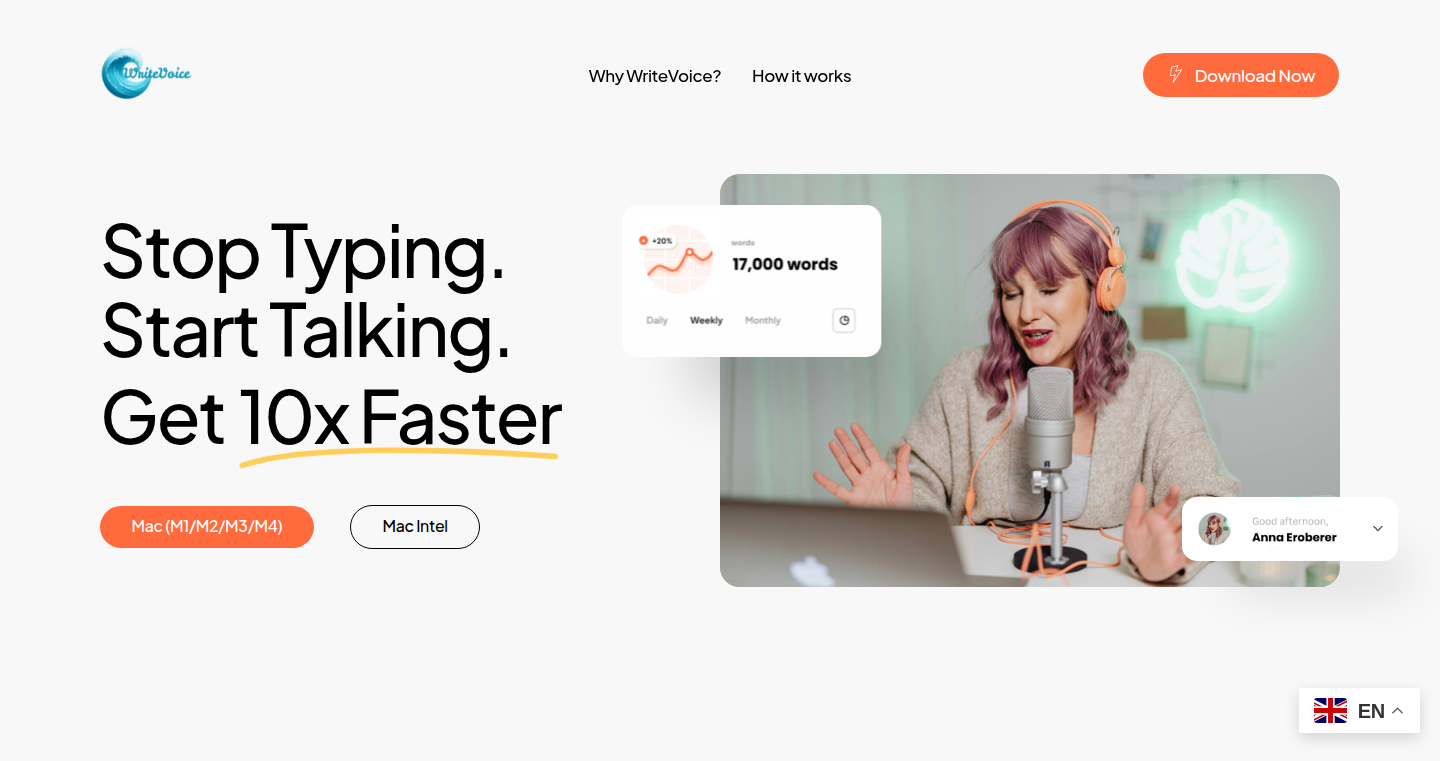
Author
yassinerajallah
Description
WriteVoice is a voice-to-code application that allows developers to write code simply by speaking. This project tackles the common issue of slow coding speeds caused by typing, especially for senior developers who handle a lot of context. WriteVoice utilizes advanced speech recognition and natural language processing to understand spoken code commands and convert them into functional code snippets, thereby increasing coding efficiency. It's an innovative solution for hands-free coding and aims to accelerate the development workflow.
Popularity
Points 2
Comments 1
What is this product?
WriteVoice is essentially a smart voice assistant for programmers. It uses cutting-edge speech recognition to understand your spoken instructions and translates them directly into code. Think of it like talking to your computer to build a program. The innovation lies in its ability to understand the specific context and nuances of programming language, making the dictation process more accurate and intuitive. So, it speeds up coding and makes it easier to work with code.
How to use it?
Developers can use WriteVoice by simply speaking code instructions into a microphone. The software then interprets these commands and writes the code automatically in your preferred programming language and IDE. It integrates with most code editors, allowing you to work seamlessly. For example, you can say something like, "Create a function called 'calculateSum' that takes two numbers." and WriteVoice will generate the function for you. This allows developers to code without touching their keyboards, allowing for increased productivity and focus. This also allows developers to focus on architectural design while the tool automates the tedious tasks.
Product Core Function
· Voice-to-Code Conversion: The core functionality is accurately translating spoken words into corresponding code. This allows developers to write code hands-free, significantly reducing typing time and improving efficiency. So this is useful because it helps you code faster, especially when handling lots of code.
· Context-Aware Code Generation: The system understands the context of the code and suggests the next appropriate code statements based on your spoken inputs. This feature helps in reducing cognitive load by providing smart code suggestions. So this is useful because it helps you to concentrate on your code structure, instead of figuring out the exact syntax.
· Integration with Popular IDEs: WriteVoice integrates with commonly used IDEs (Integrated Development Environments) such as VS Code, Sublime Text, etc. This ensures that developers can use the tool within their existing workflow with minimal disruption. So this is useful because it lets you continue working within your preferred coding environment.
· Customizable Command Sets: Allows developers to customize voice commands, tailored to their coding style and preferences. This feature makes the tool flexible and adaptive to the user's needs. So this is useful because it allows you to create your own coding language.
· Error Correction and Feedback: The application provides real-time feedback and suggestions to correct any errors in the dictation process. This prevents the development of syntactical problems and ensures that the code created is correct. So this is useful because it helps prevent errors by providing feedback.
Product Usage Case
· Rapid Prototyping: A developer uses WriteVoice to quickly write the basic structure of an application during the prototyping phase, allowing faster iterations and feedback. So this is useful because it helps you prototype your ideas more efficiently.
· Code Review and Refactoring: A senior developer can use WriteVoice to quickly make code changes or refactor existing code by voice, speeding up the code review process. So this is useful because it makes your code review more efficient.
· Pair Programming: Two developers work together, with one dictating the code while the other provides feedback and guidance, enhancing collaboration and code quality. So this is useful because it helps you to work and learn in a paired environment.
· Accessibility for Developers: Developers with physical disabilities can use WriteVoice to code hands-free, removing the physical barriers to creating software. So this is useful because it makes software development more inclusive.
· Learning and Teaching: WriteVoice can be used to demonstrate and teach coding by speaking code, allowing students to understand code logic easily. So this is useful because it can improve coding understanding in the teaching environment.
25
Delduca's Homebrew Game Engine

Author
delduca
Description
This project showcases a game engine built from scratch by a single developer. It's a testament to the power of understanding fundamental game development concepts. The innovation lies in its simplicity and the deep understanding of how games work at their core, providing a lean and customizable foundation for game creation. It tackles the problem of complex, feature-rich game engines that often have a steep learning curve, offering a more accessible entry point for aspiring game developers.
Popularity
Points 3
Comments 0
What is this product?
This is a custom-built game engine, not relying on any existing frameworks. It's like creating the engine of a car from scratch instead of buying one. The engine handles fundamental tasks like rendering graphics, managing user input (keyboard, mouse), and providing a basic game loop. The innovation comes from the developer's dedication to understand every part of the game creation process, building the engine from the ground up instead of using a pre-built one.
How to use it?
Developers can use this engine as a learning resource or a starting point for building their own games. You could adapt and extend its core functionality. It shows you how to build the underlying infrastructure of a game. So, if you're a beginner or intermediate developer wanting to understand game development better, this is a great starting point. You could also contribute back by adding your features or optimizations. It can be used as a tool to learn the ropes of game engine development, to create simplified games, or to experiment with novel techniques that a more complex engine wouldn't allow.
Product Core Function
· Rendering: This is the process of drawing images and graphics on the screen. The engine likely uses techniques like drawing triangles (basic building blocks of 3D models) and handling textures (images used to decorate these triangles). This teaches you about how the visual world of a game comes to life, and how the game renders the scene to display the current frame. So this is useful if you want to understand how the characters or the world get rendered in a game.
· Input Handling: The engine has the ability to listen to the user's input. This means the engine can detect when a key is pressed on the keyboard, or where the mouse is clicked, allowing the user to interact with the game. So this gives you the ability to interact with the game and provides a valuable insight into how games receive and process player commands.
· Game Loop: A game loop is the heart of any game. It's a continuous cycle that updates the game's state, processes input, and renders the scene, making everything move in the game. The game loop dictates the timing of every element in the game - everything that happens in a game is a product of the game loop. Understanding the game loop can help you manage how a game's logic, physics, and graphics interact to create a smooth and responsive experience. It is the foundation of the game and makes everything happen in the correct order.
· Basic Physics: The engine likely includes simplified physics for handling things like collisions and movement of objects within the game. This can be simple or complex, depending on the game the developer intends. This gives you the ability to create more realistic interactions within the game, and it helps with understanding how different game elements interact with each other. It gives the game a more polished feeling.
Product Usage Case
· Educational Tool: Use this engine as a learning resource to understand the inner workings of game development. For example, experiment with different rendering techniques to understand how they impact performance and visual quality.
· Rapid Prototyping: Quickly prototype game ideas without being bogged down by the complexities of larger engines. You can quickly implement game mechanics to evaluate ideas.
26
Framework-Agnostic Code Weaver
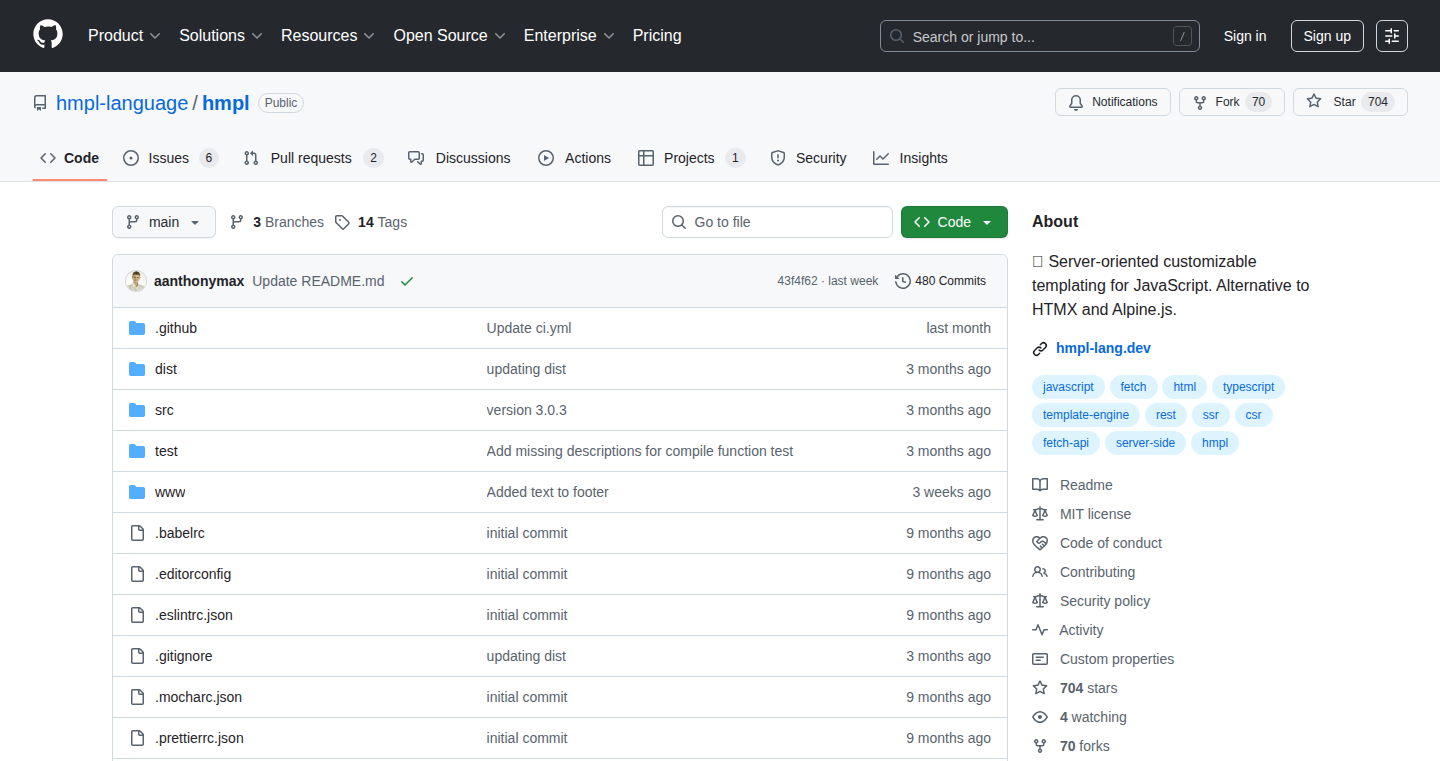
Author
aanthonymax
Description
This project is a tool designed to dynamically generate code, essentially aiming to replace the need for specific frameworks. It leverages a code generation engine to create modular and reusable components, focusing on flexible configuration and runtime behavior. The core innovation lies in its approach to decoupling logic from any particular framework, making code more portable and adaptable to various environments. This directly addresses the problem of framework lock-in and reduces the effort needed to migrate or integrate existing codebases.
Popularity
Points 3
Comments 0
What is this product?
Framework-Agnostic Code Weaver is a code generator. Instead of being locked into a specific framework (like React, Angular, or Django), you describe what you want your code to do, and this tool creates the code for you. The clever part is that this code is designed to work without being tied to any particular framework, offering a high degree of flexibility. It works by analyzing your specifications and producing modular code that's easily adaptable. This means if you decide to change frameworks later, the underlying logic is still usable.
How to use it?
Developers can use this tool by providing it with a set of instructions, essentially describing the functionality they need. These instructions could involve defining data structures, specifying business logic, or outlining the desired user interface components. The tool then processes these instructions and generates the corresponding code. The generated code can then be integrated into any project regardless of the framework used. Think of it like a highly customizable code assistant that speaks many different "programming languages" (frameworks) without being fluent in any of them. This approach reduces the complexity and time associated with manually writing and maintaining code that needs to be flexible across different environments.
Product Core Function
· Code Generation from Specifications: The core function is to automatically create code based on user-defined specifications. This is incredibly valuable because it automates the repetitive parts of software development. So this reduces manual coding time and potential errors.
· Framework Agnostic Design: This project generates code designed to be framework-independent. It’s crucial because it offers a degree of freedom. You're no longer tied to a specific technology stack, which is a game-changer for long-term project maintainability and adaptability.
· Modular Code Composition: It focuses on creating modular components. Meaning the generated code is built in a way that it's easier to reuse and combine. This reduces code duplication and fosters more maintainable codebases. So, you spend less time fixing the same bug in multiple places.
Product Usage Case
· API Gateway Generation: Imagine needing to build an API gateway that sits in front of several backend services. This tool could generate the necessary code for routing, authentication, and request transformation, all while being framework-agnostic. This would significantly speed up the development process, allowing developers to focus on business logic rather than boilerplate code. So, it lets you create API gateways faster and easier.
· Data Processing Pipelines: In scenarios involving data processing (e.g., ETL – Extract, Transform, Load), this tool could generate the code for the data pipeline. With the generated code’s modularity, it will be straightforward to swap out data sources or processing steps without rewriting the whole pipeline. This means simpler and faster data processing pipeline management.
· Cross-Platform Application Development: If you are creating an application that needs to run on multiple platforms (web, mobile, desktop), this tool could generate the core business logic once, and then adapt it for different platforms. This would reduce the need for re-implementing code for each platform, thereby reducing development time and maintenance overhead. So, this can help save time by sharing the same core logic across several platforms.
27
S3XY.community - Scenario-Based S3 Button Automation
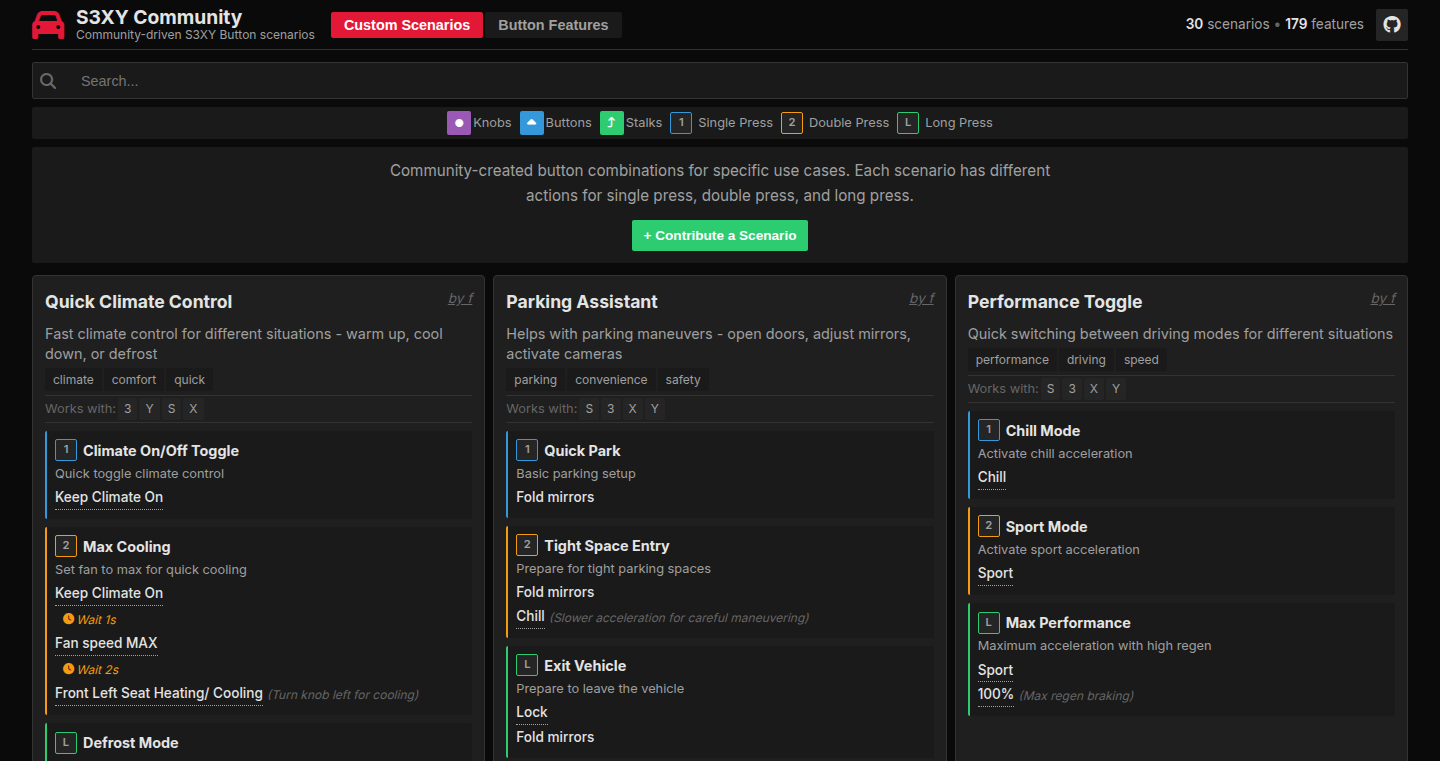
Author
fka
Description
S3XY.community is a community-driven platform for sharing and discovering automation scenarios for the Tesla S3XY button (the button on the Tesla dashboard). It addresses the problem of limited out-of-the-box functionality by allowing users to program custom actions triggered by button presses. The innovation lies in its collaborative approach, fostering a shared repository of scenarios and easy integration, making it simple for Tesla owners to extend their car's capabilities.
Popularity
Points 3
Comments 0
What is this product?
This project allows you to customize what your Tesla's S3XY button does. Instead of just using the default functions, you can download and implement pre-built scenarios, or even create your own. It's like giving your Tesla a whole new set of superpowers, all thanks to clever programming and the community's willingness to share. So it's built upon the concept of remapping button presses to perform custom actions. For example, a single button press could lock your car doors, open your garage, or even start your car's climate control system. This platform aggregates these custom action sequences to solve the limitations of the native S3XY button functionalities.
How to use it?
Developers can use the platform by either contributing existing scenarios, or by creating their own using the integrated platform tools. Then, users can integrate these scenarios by downloading and implementing them into their car's system (likely with the help of a mobile app or connected device). The platform is an open-source community that aggregates custom action sequences and exposes them to all users. This means you can instantly have access to a wide variety of customized actions. So, all you need is a Tesla, the S3XY button (or an equivalent), and access to the platform.
Product Core Function
· Scenario Sharing: The core function revolves around the community sharing pre-defined action sequences. This enhances the utility of S3XY buttons. It opens up to users a wide array of customized action sequences. You can use it to trigger all sorts of actions to perform your daily tasks. So this is a time-saver.
· Custom Scenario Creation: Developers can create their own scenarios using the integrated platform tools. This empowers users to extend their car's capabilities by programming their desired functions. So this means you are fully in control.
· Easy Integration: Provides a simple method for implementing those customized actions. This means you don't have to be a tech guru to start using it. This is a user-friendly solution.
· Community-Driven Development: The project's success hinges on collaborative effort. So this is a testament to the open-source spirit and how helpful the community can be. It shows that even with few people, it can bring incredible value.
Product Usage Case
· Home Automation Integration: Suppose you want to automate your garage door. A scenario can be created to open the garage door upon a single press of the S3XY button when arriving home, or to turn on your smart home lights. So, imagine no more fumbling with keys or remotes.
· Climate Control Pre-setting: As a developer, you can design a scenario to start the car's climate control system before you arrive at the car. So you can create scenarios to make your car perfect for you.
· Security & Safety Automation: A user can design a scenario to automatically lock the doors and activate the car's alarm when the car is parked. So it's a security enhancement.
· Task Automation: Create a sequence that will automatically play your favorite playlist and adjust the volume when you sit in your car. So it's a customization enhancement.
28
Speakeasy OpenAPI Parser: Building Blocks for Modern APIs
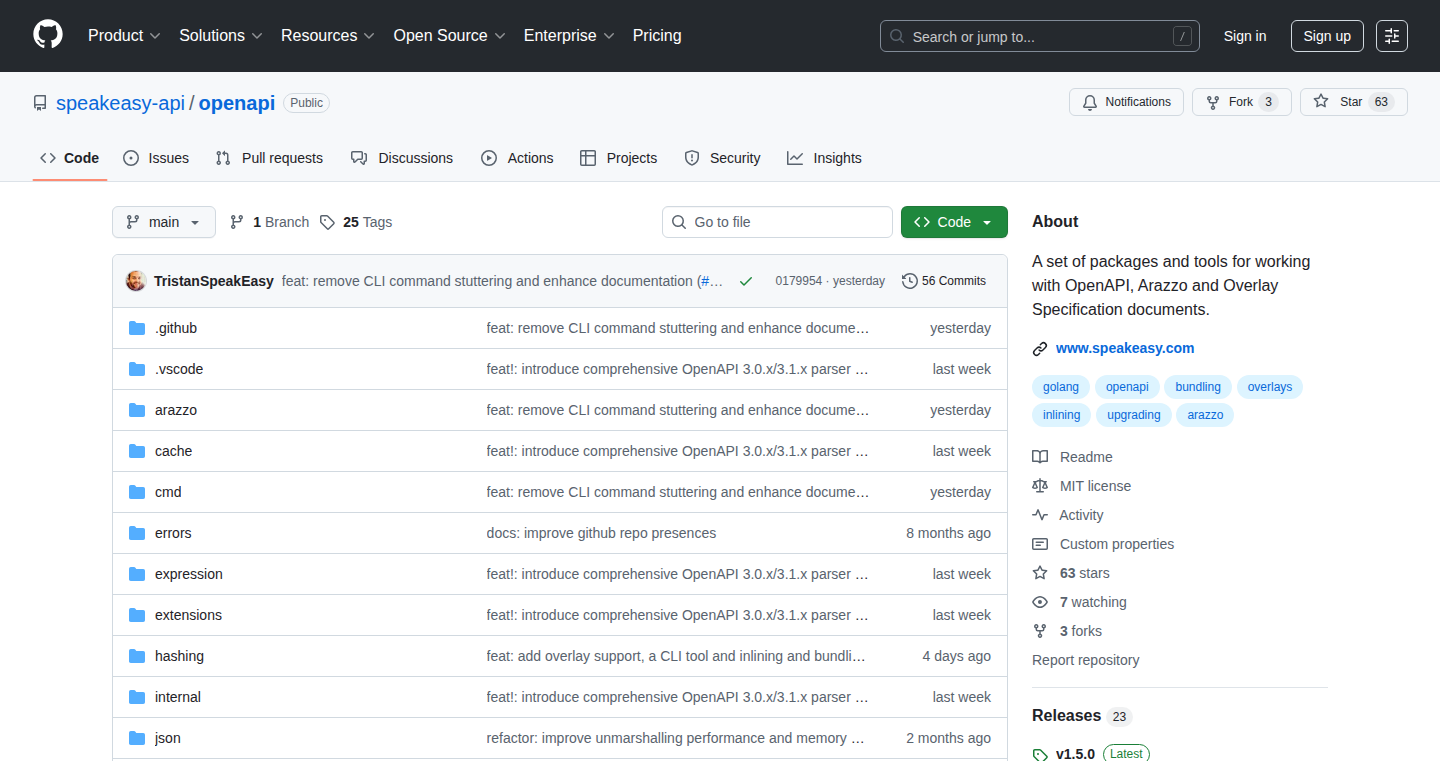
Author
indybonez
Description
Speakeasy has released an open-source library, speakeasy-api/openapi, written in Go, for parsing, validating, and working with OpenAPI specifications. This addresses the limitations of existing parsers, which are often rigid or incomplete. The library focuses on full coverage of the OpenAPI 3.1 spec, including support for Arazzo (a workflow-oriented extension) and Overlays (for spec customization), providing strict validation and a composable API. The goal is to provide a solid foundation for tools like SDK generators and API gateways, enabling developers to build better APIs.
Popularity
Points 3
Comments 0
What is this product?
This is a software library that helps developers understand and use OpenAPI specifications, which are like blueprints for APIs (Application Programming Interfaces). It's written in a programming language called Go and is designed to be fast, reliable, and flexible. Think of it as a tool that reads the API blueprint and helps other tools build, test, and manage the API. The innovation is in its comprehensive support for the newest versions of OpenAPI, including features like Arazzo and Overlays, and its focus on providing a solid foundation for other API tools. So what? This allows you to make your API blueprints more powerful and handle more complex scenarios.
How to use it?
Developers can integrate this library into their projects using the Go programming language. For example, you might use it in a script that automatically generates SDKs (Software Development Kits) for your API, making it easier for other developers to use your API in their own applications. Or you could use it in tools to automatically generate API documentation. So what? You get to create a better developer experience, save time, and avoid potential errors.
Product Core Function
· Full Coverage of OpenAPI Specifications: The library supports the complete OpenAPI 3.1 specification, including older versions like 3.0.x. This means it can understand and work with all the features defined in the API blueprint. So what? You can be sure your API tools will support the latest standards and avoid compatibility issues.
· Arazzo Support: It natively parses Arazzo, a new extension to OpenAPI for defining API workflows. This lets you build more powerful APIs that can handle complex business processes. So what? You can describe and manage more complex API interactions.
· Overlays Support: First-class support for Overlays allows developers to customize and combine API specifications easily. This is useful for creating different versions or variations of an API. So what? This simplifies API management and customization.
· Strict Validation: The library validates API specifications to ensure they are correct, which prevents downstream tools from breaking due to errors in the API blueprint. So what? This increases reliability and avoids errors in your API tools.
· Composable API: It exposes a clean and flexible API, making it easy for developers to build their own higher-level tools on top of it. So what? You get more control and flexibility when building your own API tools.
· Performance Optimization: The library is optimized for speed and scale. So what? It can handle large and complex API specifications quickly, so you won't have performance bottlenecks.
Product Usage Case
· SDK Generation: A development team wants to create SDKs for their API in multiple programming languages (e.g., Python, Java, JavaScript). They can use the Speakeasy library to parse their OpenAPI specification and generate the SDKs automatically. So what? Saves the development team time and ensures the SDKs are consistent with the API.
· API Documentation Generation: A team needs to generate detailed API documentation automatically. They can use the library to parse the OpenAPI specification and create up-to-date documentation. So what? The documentation is always current, eliminating the need for manual updates and reduces errors.
· API Gateway Configuration: A company is using an API gateway to manage their API traffic. They can use the library to validate and configure the gateway based on their OpenAPI specifications. So what? The configuration is reliable and based on a single source of truth (the OpenAPI specification), increasing stability.
· API Testing: Developers can use the library to automatically create test cases based on the API specification, ensuring API compliance. So what? Reduced manual testing effort and better API quality.
29
Weam: Open-Source AI Collaboration Platform
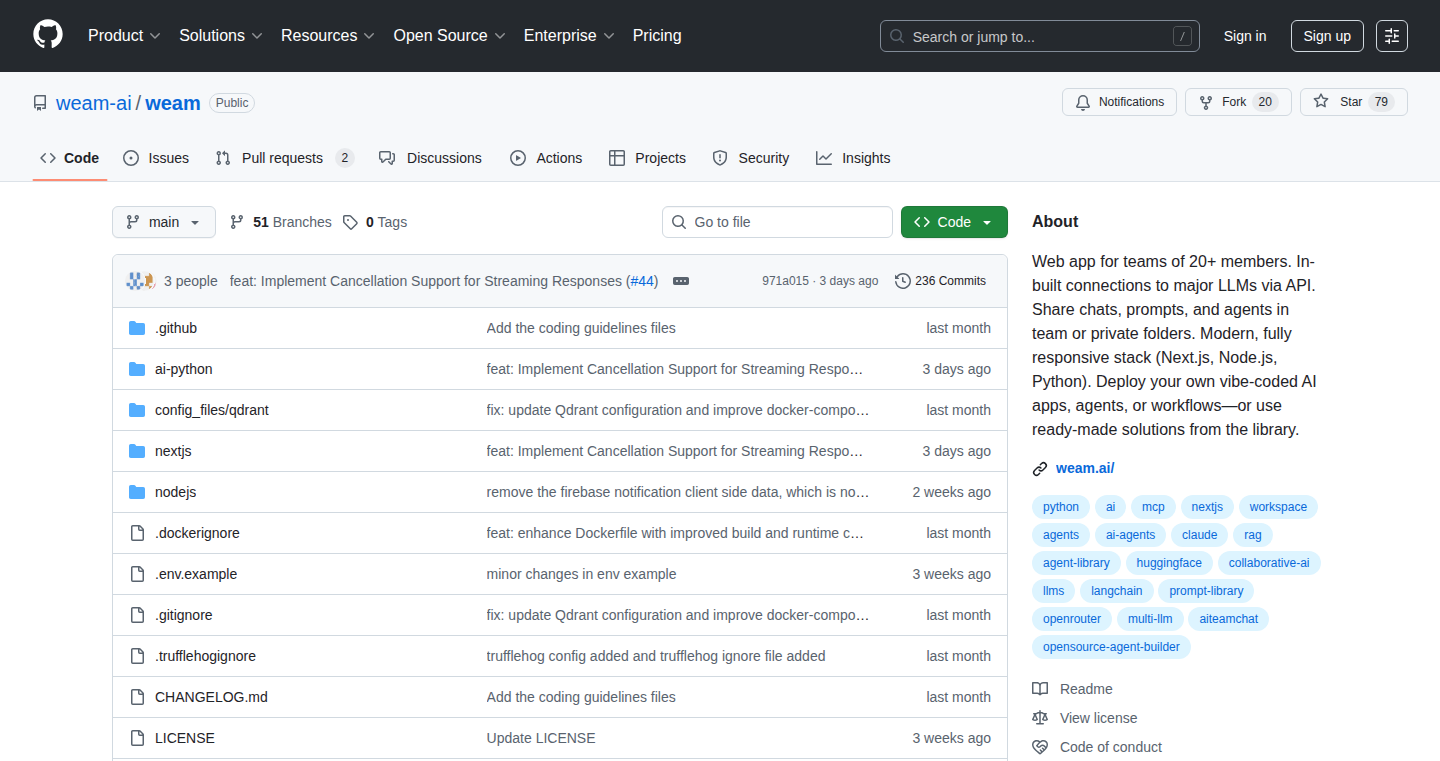
Author
sky98
Description
Weam is an open-source platform designed to make using AI tools easier and more collaborative for teams. It tackles the common problem of AI tools being fragmented and difficult to manage within a team setting. It consolidates prompts, chats, and AI agents into organized 'Brains' (think team folders), allowing teams to share, organize, and manage their AI workflows more effectively. It supports running various types of AI agents, integrates with multiple LLMs (like OpenAI, Anthropic, etc.), allows users to set up RAG pipelines using their own documents, and offers self-hosting for data control. So this helps teams work together with AI and keep their data private.
Popularity
Points 2
Comments 0
What is this product?
Weam is a platform that centralizes and organizes AI tools for team use. It's built on a 'Brains' model, creating team-specific spaces to manage prompts, chats, and AI agents. It allows teams to use various LLMs through a single interface and enables the creation of RAG (Retrieval-Augmented Generation) pipelines using the team's own documents. The innovative part is the focus on team collaboration and data privacy with self-hosting. So this helps you move beyond using AI on your own and allows your team to benefit from these tools.
How to use it?
Developers can use Weam by self-hosting the open-source platform or utilizing the hosted version if available. They can create 'Brains' to organize projects, integrate their API keys for various LLMs, configure AI agents, and set up RAG pipelines for document retrieval. They can invite team members to collaborate on AI projects, sharing prompts, agents, and data within their designated Brains. So you and your team can collaboratively use the tools and data in your projects.
Product Core Function
· Organize prompts, chats, and agents into Brains (team folders): This feature centralizes all AI-related resources, making it easier for teams to find, share, and manage them. So this helps your team stay organized when working together on AI.
· Run both lightweight agents and more complex Pro Agents: The platform supports various types of AI agents, offering flexibility in terms of complexity and capabilities. So this allows you to work with simpler or more complex AI tasks according to your needs.
· Plug in your own LLM keys (OpenAI, Anthropic, Gemini, Llama, etc.): This allows users to use their preferred AI models. So this makes your team able to use whatever AI models work best for your project.
· Set up RAG pipelines to use your own documents: This feature enables teams to utilize their own data for AI tasks. So this allows you to create AI applications that specifically use the data your team has.
· Self-host, so teams keep control of their data: The self-hosting option ensures data privacy and control for teams. So this ensures that your team can decide where your data is stored.
Product Usage Case
· A marketing team can use Weam to create a 'Brain' for content generation, where they can store prompts for blog posts, manage different AI agents to generate content variations, and integrate their internal documents for context, resulting in cohesive and relevant content. So this helps your marketing team create consistent and relevant content.
· A research team can leverage Weam to organize their experiments, store prompts for data analysis, manage AI agents for report generation, and connect to their research papers, ensuring that all team members have access to shared insights. So this helps your research team share knowledge and data.
· A software development team can use Weam to create a 'Brain' for code generation and debugging. They can store prompts for different coding tasks, manage AI agents that generate code snippets, and connect to their codebase documentation for more accurate results. So this helps your developers get code finished and debugged faster.
· A legal team can use Weam to set up a ‘Brain’ that manages legal documents, and analyze them using specific prompts. So this makes your legal research team become efficient.
30
Ooxy: The Universal Protocol Translator
Author
Rits1272
Description
Ooxy is a versatile, open-source tool designed to translate communication protocols, acting like a universal translator for the internet. It bridges the gap between different networking layers (like Layer 3 and Layer 7), allowing devices and applications that don't normally work together to communicate seamlessly. Inspired by Cloudflare's Oxy proxy framework, Ooxy aims to connect incompatible protocols, opening up new possibilities for how we use the internet. It is designed to work as a Layer 3 to Layer 7 bridge, enabling proxy-unaware devices to communicate through HTTP/S proxies. This project tackles the problem of protocol incompatibility, which is a common issue in modern networking and offers a flexible and reusable approach to solve it.
Popularity
Points 2
Comments 0
What is this product?
Ooxy is a software bridge. Imagine it as a translator who takes communication from one language (protocol) and translates it into another, so different devices or applications can understand each other. Its core innovation lies in its ability to bridge across different layers of network communication, making it more adaptable than tools limited to a single layer. Think of it like a universal adapter for the internet: it takes any type of data and transforms it to fit in another network.
How to use it?
Developers can use Ooxy to connect systems or devices that wouldn't normally be able to communicate. For example, you could use Ooxy to allow an older device that only understands a specific protocol to communicate through a modern HTTP/S proxy, or integrate legacy systems with modern applications. It can be integrated into your projects as a reusable component to handle the often complex task of protocol translation. Developers can download Ooxy, configure it with the relevant protocols and settings, and then route traffic through it. It's especially useful when you need to connect devices that are 'proxy-unaware,' meaning they don't have the built-in ability to use a proxy server.
Product Core Function
· Protocol Translation: Ooxy converts data from one protocol to another (like HTTP to a custom protocol). This is valuable for connecting legacy systems or devices that use older communication methods. This is useful for any system needing to integrate or communicate with another that it couldn't before.
· Layer Bridging: It bridges communication across different network layers, allowing devices with different communication models to interact. This is useful for establishing communication between devices on different networks.
· Proxy Support: Ooxy enables devices to use HTTP/S proxies, even if they weren't designed to. This helps users bypass network restrictions, maintain privacy, and enhance security. This is great for getting around firewalls and accessing the internet more safely.
· Open-Source and Reusable: Because it's open-source, developers can customize Ooxy to fit their specific needs and integrate it into various projects. This is advantageous for developers who want to tailor the communication to particular requirements.
Product Usage Case
· Connecting legacy industrial equipment: Imagine old factory machines that use outdated communication methods. Ooxy can translate their signals to a modern protocol, allowing them to integrate with the factory's modern management system. This helps in modernizing factory operations without replacing all the existing equipment.
· Enabling secure communication for IoT devices: Many IoT devices use custom protocols. Ooxy can be used to translate these protocols to HTTP/S, enabling them to securely communicate through proxies, and offering greater network security.
· Integrating proxy-unaware devices with proxy servers: Some devices or applications don't natively support the use of a proxy server. Ooxy can be used to bridge the communication, letting these devices connect through the proxy. This is useful when a user wants to bypass geographic restrictions or increase anonymity. For example, connecting an old game console to a proxy server.
31
Happiness Mantra: A Cognitive Reframe Engine

Author
Sakou
Description
Happiness Mantra is a simple ebook designed to help people break free from negative thought patterns and cultivate joy. It's essentially a self-help guide, but the underlying 'engine' is about reframing how we think. The core innovation lies in its focus on providing actionable steps and mindset shifts to build resilience and promote positive habits. It addresses the common technical problem of 'mental inertia' – the tendency to get stuck in negative thinking loops. This project provides a practical approach to addressing this issue.
Popularity
Points 1
Comments 1
What is this product?
Happiness Mantra is a concise guide that acts like a 'mental reset button'. It uses the principle of cognitive reframing, a technique to change how we perceive situations. Instead of complex therapy, it provides simple habits and mindset adjustments. The innovation lies in its accessible format and focus on practical, daily activities that promote positivity and emotional well-being. So, this helps you change how you think and feel.
How to use it?
As a reader, you read the 33 page guide, focusing on its actionable steps and daily routines. This guide is for anyone looking to improve their emotional state. It's like a self-help playbook. For instance, if you're feeling anxious, the guide might suggest a specific breathing exercise or a shift in how you perceive a stressful event. You integrate these practices into your daily life. So, if you're struggling with negative thoughts, this is a direct solution.
Product Core Function
· Breaking Free from Negative Thought Patterns: This core function helps identify and disrupt negative thought cycles. The value lies in providing techniques, like questioning negative assumptions, which act as mental code debugging to prevent further negativity. So, you will learn to recognize and stop negative thoughts more quickly.
· Building Emotional Strength and Self-Trust: This function focuses on developing resilience and confidence. The technology is the actionable steps, like daily affirmation routines, which create mental robustness. This results in creating a stronger emotional foundation. So, you will learn to handle stress and believe in yourself.
· Embracing Daily Routines for Clarity, Confidence, and Calm: This function provides a structure of beneficial habits, like mindfulness exercises and gratitude practices. The technical innovation is in the design of these actions. These routines are designed to optimize mental clarity and promote a state of calmness. So, you will get a better sense of peace and purpose every day.
Product Usage Case
· Dealing with Workplace Stress: Imagine you're facing a tight deadline at work. Instead of succumbing to panic, you apply a technique outlined in the Happiness Mantra. This might involve reframing the deadline as a manageable challenge, or practicing a breathing exercise. This reduces stress and improves your ability to focus. This is useful to help manage work pressure.
· Overcoming Social Anxiety: Someone who feels anxious in social situations might use the guide to build self-trust and confidence. The advice provided could include positive self-talk or pre-event visualization, which reduces anxiety and helps develop social comfort. This helps you become more social and improve your social connections.
· Coping with Relationship Issues: When facing conflict in relationships, the guide provides methods to reframe issues and improve communication. Techniques such as empathetic listening or reframing a partner's behavior in a positive light help minimize conflicts. This helps improve your relationship with others.
32
Arrow-Duh Game: An Interactive Image Recognition Challenge

Author
chistev
Description
This project is a fun, engaging guessing game built with React.js. It challenges players to identify objects within images across multiple game modes, including timed, classic, multiple-choice, and survival. The core innovation lies in its use of React.js for a responsive and interactive front-end, allowing for a smooth user experience and the implementation of diverse game mechanics. It elegantly solves the challenge of creating an interactive game within a web browser by leveraging the power of JavaScript and a modern front-end framework. The project is a testament to using web technologies to create enjoyable and accessible experiences.
Popularity
Points 2
Comments 0
What is this product?
Arrow-Duh Game is a web-based image recognition game. It leverages the React.js framework for creating a dynamic user interface. Players are presented with images and must identify the objects within them, competing across different game modes like timed challenges and survival mode. The innovative aspect lies in its integration of game logic and interactive elements within a web application, providing an accessible and engaging experience. So what's the innovation? It's turning a simple idea (guessing objects) into a fun, interactive web game.
How to use it?
As a developer, you can explore the project's source code on GitHub. You can learn how to use React.js to build interactive web applications, manage game states, and implement different game modes. It provides a practical example of how to use React.js for front-end development and creating interactive experiences. You can integrate the game's logic or design elements into your own projects to create similar interactive experiences or learn how to handle user interaction and game states within a web environment. So, developers can learn how to build responsive web games with React, by checking the source code. You can also apply to other projects such as quiz or learning apps.
Product Core Function
· Multiple Game Modes: The game provides various modes, including timed, classic, multiple choice, and survival modes. The value lies in offering diverse challenges and replayability, increasing user engagement. The application scenario includes providing different levels of difficulty or adapting gameplay based on player preference.
· Image Recognition Logic: The game's core function revolves around image recognition; players are challenged to correctly identify the object in the image. The technical value is demonstrating how to integrate and present image-based content within a web application. The application scenario includes building educational tools or interactive quizzes focusing on image identification.
· React.js Implementation: Built with React.js, the project showcases how to build a responsive and interactive front-end. This includes managing user interactions, updating the display based on game progress, and creating a smooth user experience. The value is showcasing the usage of React.js in building dynamic web applications. Application scenario: Building interactive user interfaces for web applications or mobile apps.
· Achievement System: The game likely includes a system to track player progress and unlock achievements. The value is showcasing how to implement user metrics and gamification within an application. Application scenario: Building applications that motivate users and allow them to measure progress and gain rewards.
· Progress Tracking: The project tracks players' progress across different game modes. The value lies in providing users with a sense of accomplishment and motivation. Application scenario: Building educational or training apps where progress tracking is key.
Product Usage Case
· Creating an educational game: The game mechanics can be adapted for educational purposes. For instance, you could modify the game to teach children about different animals or objects, with the React.js framework managing the display of the image and feedback. So, you can build fun educational games.
· Building interactive quizzes: The core functionality of identifying objects can be adapted to build quizzes. This can be used in various web applications, like online learning platforms. So, you can create your own quiz platform.
· Developing gamified training modules: Developers can learn from how the game manages game states, progress tracking, and rewards, and incorporate similar elements into the training module. This enhances engagement and makes training fun. So, you can develop gamified online training courses.
· Interactive UI Design in React.js: This game provides a practical example of how to use React.js to build user interfaces, handle user interactions and create interactive elements that can be applied to various web-based applications. So, learn about the React.js development.
33
Auditory Weaver: Sound Generation for Silent AI Clips
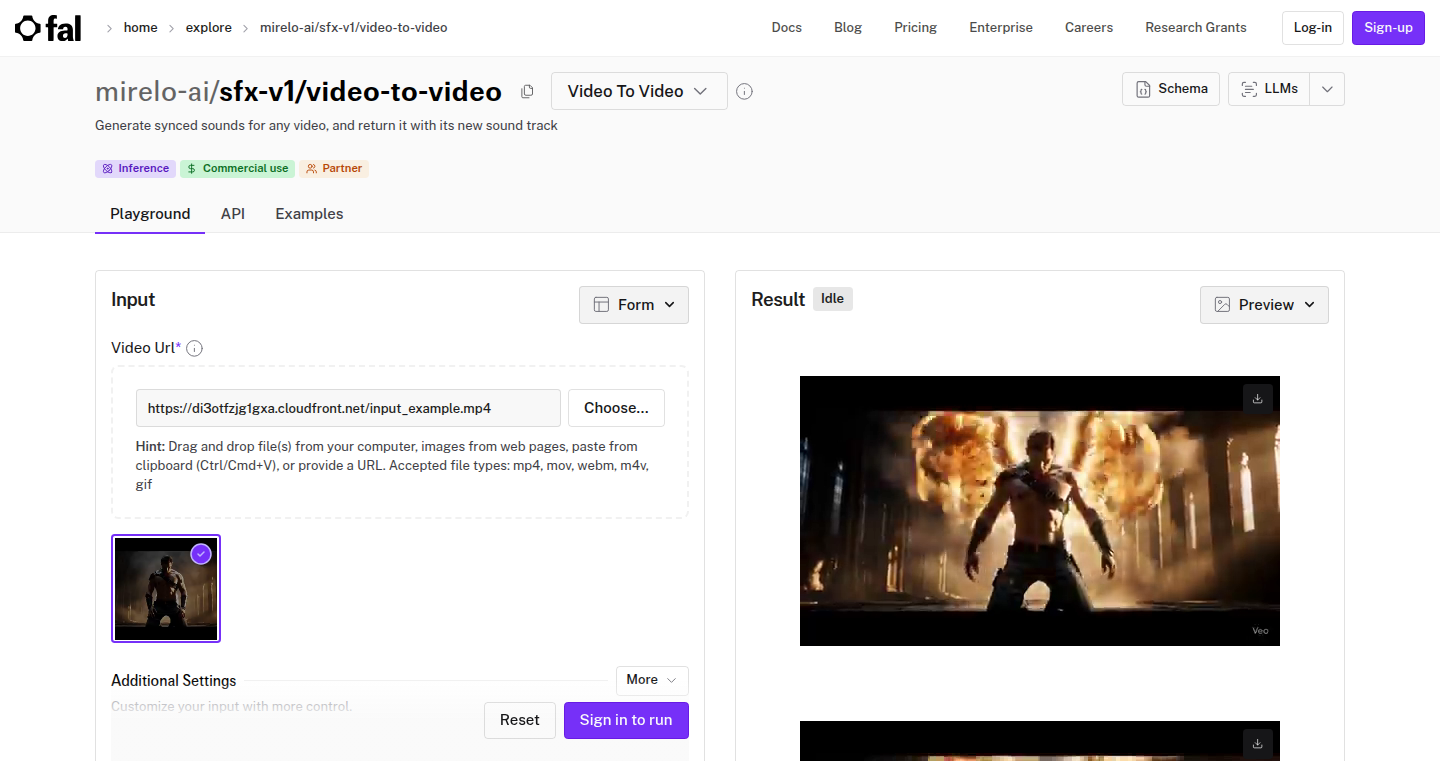
Author
pitapoison
Description
Auditory Weaver is a fascinating project that addresses the problem of silent AI-generated video clips. It uses AI to analyze the visual content of these clips and then automatically generates corresponding sound, effectively 'audio-izing' them. This is a significant innovation because it automates a process that's typically done manually, saving time and potentially improving the overall user experience by making the visuals more engaging and complete. The core technology revolves around AI-powered visual understanding, coupled with sound generation algorithms. So this creates sound for videos, automatically!
Popularity
Points 1
Comments 1
What is this product?
Auditory Weaver is a system that generates sound for video clips, especially those created by AI, which often lack audio. It works by first analyzing the visual content of the video (e.g., objects, actions, and scene) using AI. Then, it uses AI to create appropriate sounds, like music or sound effects that match the visuals. It's innovative because it completely automates the sound design process. So this is like giving silent movies a voice!
How to use it?
Developers can integrate Auditory Weaver into their existing video processing pipelines. They would feed a silent video clip into the system, and it would output a version of the video with generated sound. The integration could be as simple as using an API call within their video editing software or as part of their AI-powered content creation workflow. So you can use it to add sound to your AI videos.
Product Core Function
· Visual Content Analysis: This is the core of the system. It uses AI to understand what's happening in the video clip, identifying objects, actions, and the overall scene. This is valuable because it allows the sound generation to be context-aware and relevant. For example, if the AI sees a car, it will generate car sounds. So this function understands the video.
· Sound Generation: After understanding the visual content, the system uses AI to generate suitable audio. This could include realistic sound effects, background music, or even speech if applicable. This is useful because it gives life to otherwise silent videos and makes them more engaging. So this turns what the AI sees into sounds.
· API Integration: Auditory Weaver provides a way for developers to easily integrate the sound generation functionality into their own applications or workflows through an API. This makes it easy to automate the process within larger video creation or editing platforms. So this lets developers automatically add sound to AI videos.
· Customization & Control: The system may offer options to control or customize the generated audio, allowing for user adjustments to volume, sound type, or music style. This is essential for developers who need to fine-tune the output to match specific creative requirements or branding. So this lets the user control the sound.
Product Usage Case
· AI-Generated Content Enhancement: Developers creating AI-generated videos for marketing, social media, or educational purposes can use Auditory Weaver to instantly add sound, making the content more engaging. For example, a developer could build a tool that takes in an AI generated animation, runs it through Auditory Weaver, and then automatically posts it to TikTok. So this helps to add sound to AI generated content.
· Automated Video Editing: Video editors can integrate this tool to automate the process of adding sound effects or background music to silent video clips, saving time and effort. For instance, a video editor could upload a series of drone shots and use Auditory Weaver to automatically add matching ambient sound effects. So this saves time for video editors.
· Accessibility: The system can be used to generate audio descriptions for visually impaired users, making video content more accessible. For example, a developer can use Auditory Weaver to automatically describe visual content in the videos to create videos that are useful for everyone. So this helps visually impaired users.
34
Bundesliga Predictor: Explainable AI for Match Outcome Prediction
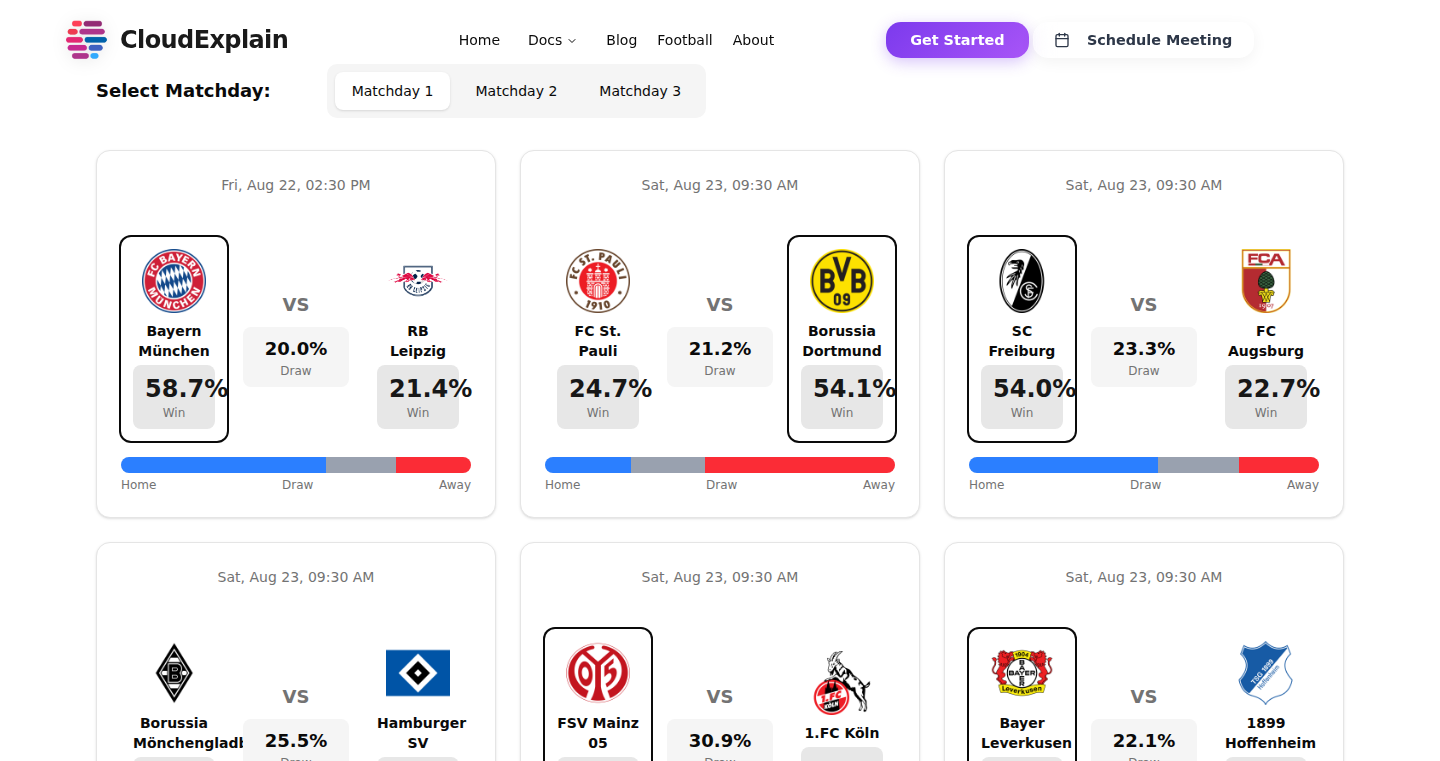
Author
CloseChoice
Description
This project uses machine learning to predict the results of Bundesliga matches. The cool part? It doesn't just make predictions; it also explains why it made them. It analyzes 15 years of historical data and uses 'explainable AI' to show which factors are most important for its predictions. This helps to understand the decision-making process of the AI, a critical area in machine learning. So this is not just about predicting scores, it's about understanding *how* the predictions are made, making it more transparent and trustworthy. So, what is the practical value here? This could improve your understanding about the factors affecting the outcome of a match, making you a more informed fan.
Popularity
Points 1
Comments 1
What is this product?
This project uses a machine learning model to predict the results of Bundesliga matches. The innovation lies in its use of 'explainable AI'. This allows users to see *why* the model makes specific predictions. The model is trained on 15 years of historical match data. The explainability aspect offers insights into the factors influencing the predictions – such as team form, player statistics, or head-to-head records. So this is more than just guessing the winner; it’s about understanding the 'reasoning' behind the guess. This is achieved through techniques that provide insights into the inner workings of the machine learning model. This project uses data from the past 15 years which is a huge data resource.
How to use it?
While this isn't a tool for betting, it's great for anyone interested in data analysis, machine learning, or simply understanding football. The developers likely built a web interface where users can input match details or see predicted outcomes with the accompanying explanations. Think of it as a window into the AI's thought process. Developers can potentially access the model's logic, which could be used for building similar predictive systems, or visualizing data. So, if you're a data scientist, sports analyst, or a data enthusiast, you might consider it as inspiration to create your own models or visualization.
Product Core Function
· Match Outcome Prediction: The core function is predicting the results of Bundesliga matches. This showcases the application of machine learning for predictive analytics in a sports context. This prediction is the base of this product.
· Explainable AI (XAI): It's ability to explain how predictions are made is the most important function of this project. XAI provides the reasoning behind the model's predictions, increasing trust and understanding. It's useful for visualizing the factors affecting the outcome of a match, making you a more informed fan.
· Historical Data Analysis: The project utilizes 15 years of historical Bundesliga data. It demonstrates how to collect, process, and utilize large datasets for training machine learning models and revealing patterns. If you are building a similar model for any project, this would be a great example.
· Visualization of Predictions: This likely includes visualizations explaining the factors influencing the predictions. This is important for making the predictions easily understandable for non-technical users. It is also important for displaying the relationship between those factors, the team’s condition, and the final results of the match.
Product Usage Case
· Sports Analytics: A sports analyst could use the underlying model and the visualization techniques to understand what specific team characteristics are most important for a match outcome and how to improve their team performance, leading to better analysis and insights. It shows how to predict the match outcome and to know the most important factors in a football match.
· Educational Tool: The project could be used as an educational example for students learning machine learning. It is a great example of a project that integrates data science and explainable AI, enhancing the learning experience. It offers a practical illustration of machine learning in action, showing how models are built and how they can be used to predict outcomes and analyze patterns.
· Research Application: Researchers can use the project's techniques as a base for their own experiments on prediction models. They can focus on the model's architecture and XAI aspects to understand the influence of specific features and their impact on the final result. This can be used for exploring explainable AI in sports analytics, building similar systems for different sports, or comparing prediction methods.
35
SFOR: Streamable Flat Object Representation
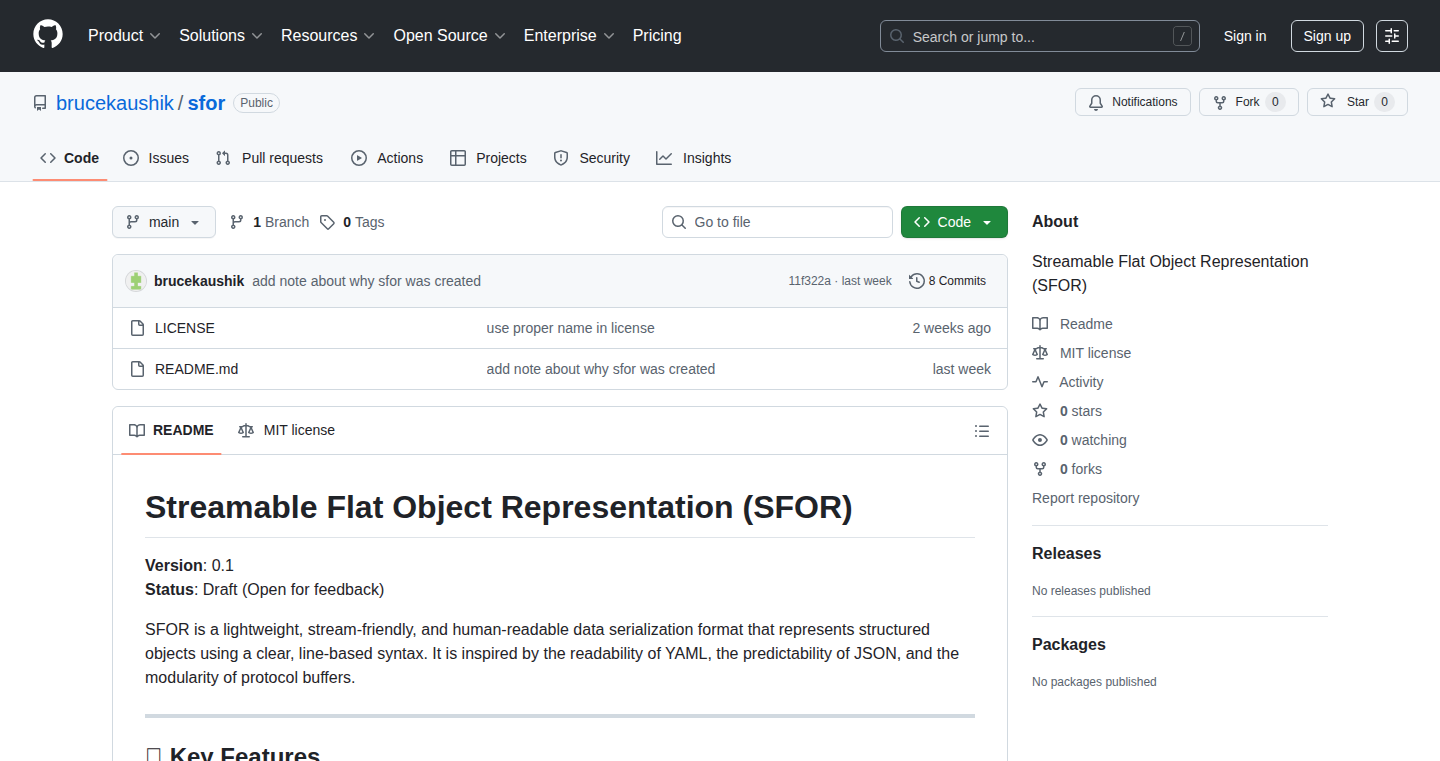
Author
brucekaushik
Description
SFOR is a new data format designed for efficiently handling data streams. Unlike formats like JSON or YAML, SFOR is built to be parsed as the data arrives, without needing to load the entire dataset into memory. It avoids backtracking, meaning the parser doesn't need to go back and re-interpret earlier data, and it's type-explicit, clearly defining the data types to avoid ambiguity. The format prioritizes minimal overhead and is designed for situations where a streamable, predictable, and low-memory alternative is beneficial, particularly for devices with limited resources, large datasets, or real-time processing. This project showcases a creative approach to data serialization, emphasizing efficiency and streamlined processing.
Popularity
Points 2
Comments 0
What is this product?
SFOR is a data format, like JSON or XML, but it's optimized for situations where you receive data in a continuous stream. Think of it as a way to read a very long book without having to hold the entire book in your hands at once. It achieves this by being 'streamable' (can be parsed as it arrives), 'no-backtracking' (doesn't need to go back and reread parts), and 'type-explicit' (knows the type of each piece of data). This design allows for efficient handling of large datasets or real-time data processing, especially on devices with limited memory or processing power. So this project tackles the problem of efficiently handling streaming data, providing a more lightweight and predictable alternative to existing formats.
How to use it?
Developers can use SFOR as a data format for transmitting and storing data, particularly in scenarios involving streaming data. For example, it could be used in IoT applications to efficiently transmit sensor readings from a device, in real-time data analytics to process incoming data, or in constrained environments where memory is limited. Integrating SFOR involves using a parser library (provided by the project) to read the SFOR data format. Developers can then access the data in a structured way without having to load the entire data set into memory. So you can use it to build applications that efficiently process data streams, improve performance and reduce memory consumption.
Product Core Function
· Streamable Parsing: SFOR allows parsing data as it arrives, without needing to wait for the complete data set. This is achieved through a parser that reads the data sequentially, enabling efficient processing of large datasets. So this is useful for handling data that comes in a continuous flow, such as sensor readings or financial market data.
· No-Backtracking Parsing: The SFOR parser is designed to never go back and re-interpret earlier parts of the data. This simplifies the parsing process and reduces the need for complex logic, improving efficiency and performance. So this means it's faster and more reliable for processing data.
· Type-Explicit Data Representation: SFOR explicitly defines the data types within the stream. This eliminates ambiguity and makes it easier to understand and process the data, providing more predictable behavior. So this helps make the data easier to work with and less prone to errors.
· Minimal Overhead: SFOR prioritizes a compact representation without sacrificing readability. This means it is designed to be efficient in terms of data size, which can be particularly important in resource-constrained environments. So this is good for reducing storage space and bandwidth usage.
Product Usage Case
· IoT Sensor Data Processing: Imagine a network of sensors collecting data. SFOR can be used to transmit the sensor data in real-time, where the streamable and low-memory nature is ideal for the devices and the data stream is efficiently processed. So this can help you to build more efficient IoT applications that handle sensor data.
· Real-time Data Analytics: In a financial application, you can use SFOR to receive and process stock market data in real-time. The no-backtracking and type-explicit features ensure that the data is parsed quickly and reliably, allowing for faster and more accurate analysis. So this lets you build faster and more reliable real-time data processing applications.
· Constrained Device Communication: Use SFOR on embedded systems or devices with limited memory and processing power. This format's minimal overhead makes it suitable for transmitting data in environments with tight resource constraints. So this can allow you to build data-intensive applications for devices with limited resources.
36
Goo: Enhanced Go Development Environment
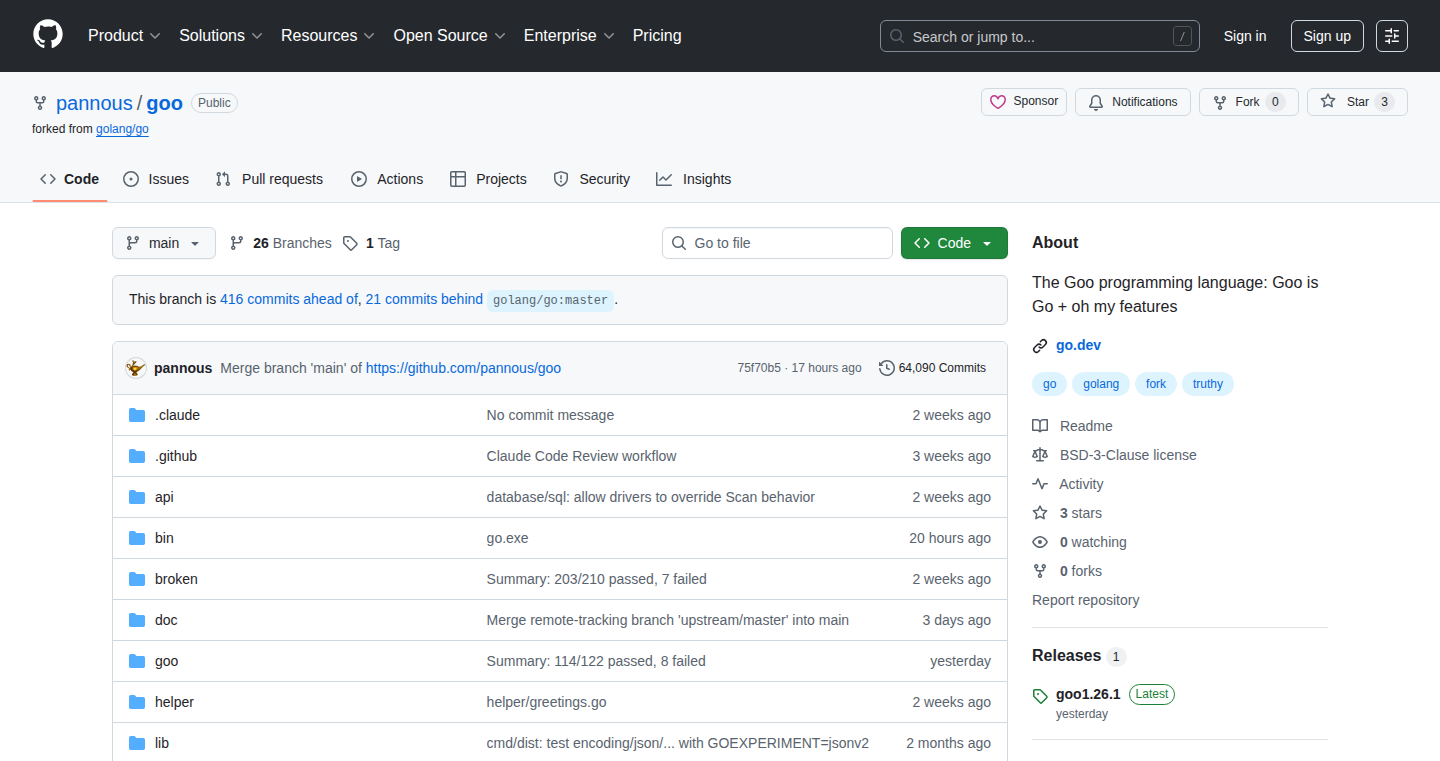
Author
singularity2001
Description
Goo is a project designed to enhance the Go programming experience by adding various features on top of the standard Go toolchain. It aims to simplify common development tasks, provide better debugging capabilities, and offer a more streamlined workflow. The core innovation lies in its modular approach, allowing developers to pick and choose which enhancements to enable, and its tight integration with existing Go tools. This addresses the problem of Go's sometimes verbose syntax and the lack of certain developer-friendly features, making development faster and more enjoyable.
Popularity
Points 2
Comments 0
What is this product?
Goo acts like a supercharged version of the standard Go tools. Think of it as Go, but with extra features. It's built by adding modular improvements, like smarter code completion, easier debugging, and some helpful tools to make writing Go code more straightforward. The innovative part is its ability to slot in enhancements as needed, without changing the core Go language itself. This helps with common Go issues like verbose code, offering developers an easier and more efficient way to build software.
How to use it?
Developers integrate Goo into their workflow by using it as a replacement for existing Go tools. For instance, instead of running `go build`, they might use `goo build`. The enhancements are designed to work seamlessly with popular IDEs and code editors. This makes it easy to integrate Goo without changing existing setups. Developers can choose the features that best fit their projects – maybe more advanced code suggestions or a simplified way to trace errors – and then use them inside their daily work. So, if you use Go, Goo is designed to fit right into your process to boost speed and clarity.
Product Core Function
· Enhanced Code Completion: This provides smarter suggestions as you type, going beyond the standard Go completion. This can save a lot of time and reduce errors by suggesting correct functions and methods. So this is useful for writing code faster and reducing mistakes.
· Simplified Debugging: Goo could offer improved debugging tools, making it easier to find and fix errors in Go code. This might involve better error messages or integrated debugging tools. This is useful for reducing the time it takes to find and fix code issues.
· Code Generation Utilities: Goo could contain tools to automatically generate Go code, based on predefined templates or data structures. This reduces the need for repetitive coding. So this is useful for automating repetitive tasks.
· Build Process Improvements: Goo might include features to speed up the Go build process or improve dependency management. This will reduce build times. So this is useful for faster build cycles.
Product Usage Case
· Web Application Development: Developers building web applications in Go can use Goo's enhanced code completion to speed up coding. Goo's code suggestions save time in implementing API endpoints and backend logic. So this helps in completing development projects quickly.
· Microservices Architecture: In projects using microservices, where code debugging is important, the enhanced debugging tools of Goo could be utilized to quickly identify and fix errors in individual services. This leads to more efficient troubleshooting. So this helps in developing projects which involve managing a large number of dependencies and troubleshooting them.
· Command-line Tools Development: Developers building command-line tools can utilize Goo to automate parts of the development workflow, such as generating command-line argument parsing. Goo increases development efficiency. So this helps in reducing repetitive tasks and building things faster.
37
Prisma-Prefixed-IDs: Human-Friendly IDs for Your Database
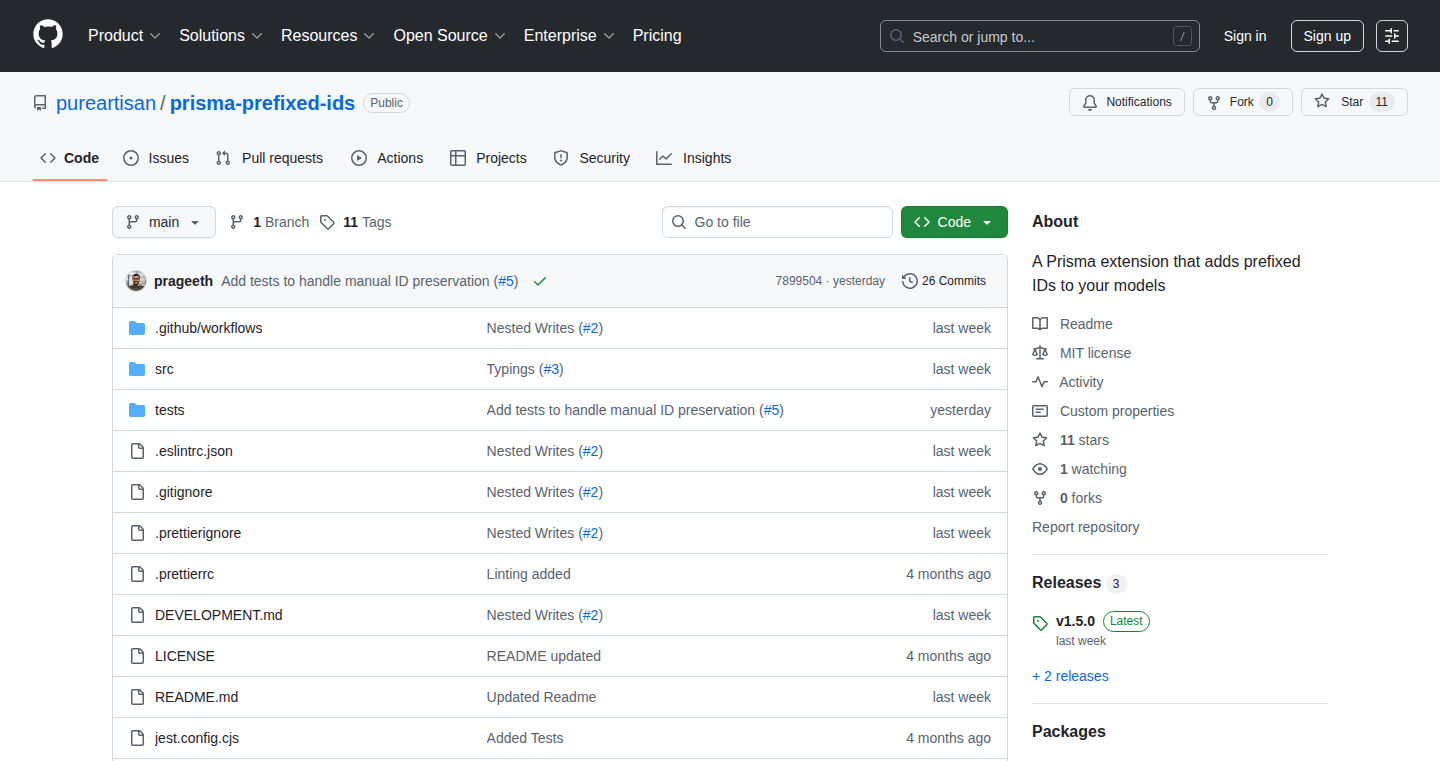
Author
prageeths
Description
This project is a small, open-source extension for Prisma, a popular database toolkit for JavaScript and TypeScript. It enhances Prisma by adding Stripe-style prefixed IDs (like `usr_abc123` or `ord_def456`) to your data. This means instead of seeing a long, random string of characters (a UUID) for your user ID or order ID, you get a short, readable ID with a prefix. The core innovation is in simplifying how we identify and manage data within applications, especially when dealing with APIs, logging, or sharing data externally. This is valuable because it makes debugging, tracking, and integrating with other systems much easier.
Popularity
Points 2
Comments 0
What is this product?
Prisma-Prefixed-IDs is a clever add-on for Prisma. It works by automatically generating and assigning unique IDs to your data entries, but instead of using the typical random, hard-to-read UUIDs, it creates IDs with a prefix that tells you what type of data it is (like 'usr' for user). Under the hood, it leverages Prisma's extension capabilities to intercept data creation and modification operations, allowing it to seamlessly inject these prefixed IDs. This is innovative because it solves the problem of having to manually create and manage these IDs, and it provides a clean, standardized way to identify data within your application and across different systems.
How to use it?
Developers can easily integrate this extension into their Prisma setup. It's designed to be a 'drop-in' solution, meaning it can be added without major code changes. After installing the package, you configure which database models (like 'User' or 'Order') should have prefixed IDs. Then, every time you create a new entry in those models, Prisma-Prefixed-IDs automatically generates a prefixed ID and assigns it. You can use these prefixed IDs just like any other ID in your application, such as when building APIs or looking up data in your database.
Product Core Function
· Automatic Prefixed ID Generation: It automatically generates IDs with prefixes, such as `usr_` for users or `ord_` for orders. So what? This simplifies identification and tracking of data entries. It’s easier to look at `usr_abc123` and immediately know it's a user ID, compared to a random UUID. It is very helpful for debugging and logging purposes.
· Model-Specific Configuration: You can configure which models in your database will use prefixed IDs. So what? This allows you to choose where to use the feature. You might only need it for specific data types, like users or orders. It gives you flexibility and control over your data model.
· Drop-in Extension: It is designed to be a 'drop-in' extension, meaning it can be added with minimal changes to your existing code. So what? This saves time and effort during implementation and reduces the risk of introducing bugs. It allows you to quickly adopt this feature.
· Support for Nested Writes: It supports nested writes, meaning it correctly handles creating or connecting data entries within related models. So what? This feature ensures consistency and data integrity when dealing with relationships between different data types. This is crucial when you're building complex features.
Product Usage Case
· API Development: When building APIs, the prefixed IDs can be returned in API responses. So what? The clients can easily understand the data being returned and can use these IDs in their requests, because they are human-readable and less error-prone. It improves developer experience and reduces the chance of mistakes.
· Logging and Debugging: When logging events or debugging your application, prefixed IDs make it much easier to identify specific data entries. So what? Imagine you're troubleshooting an issue with a specific order, and you can quickly identify the order by its prefixed ID like `ord_def456`. This saves valuable time and effort during the debugging process.
· Integrating with Third-Party Services: When integrating with external services, such as payment gateways or analytics platforms, prefixed IDs can be used as identifiers. So what? It makes it easier to map your internal data to external systems and simplifies the integration process. It makes your systems more interoperable.
38
Twins of Caduceus - Twin-Stick Snake Game

Author
vunderba
Description
This project is a highly challenging and unique take on the classic Snake game, called 'Twins of Caduceus'. It features a two-snake control scheme, requiring players to simultaneously manage two snakes using two joysticks or two sets of keys (WASD and arrow keys). The core innovation lies in its demanding control mechanism, testing players' dexterity and coordination. It's an attempt to elevate a simple game concept into a test of skill. So this allows for innovative control schemes. For example, one could create new control schemes that control multiple objects simultaneously.
Popularity
Points 2
Comments 0
What is this product?
This is a Snake game, but instead of controlling one snake, you control two simultaneously, each with its own joystick or key set. The game tests your ability to manage both snakes, avoid obstacles, and eat food to grow. The innovation is the twin-stick (or dual-input) control scheme, which drastically increases the game's difficulty and adds a layer of complexity not usually found in Snake games. This demands higher cognitive load and more fine-tuned motor skills compared to the original version. So this offers a new level of challenge and engagement.
How to use it?
Players can use the game with two joysticks (the preferred method for an arcade-like experience) or with two sets of keys: WASD for one snake and arrow keys for the other. The game's core mechanics, like movement, eating, and game over conditions, follow the traditional Snake game. To play, you simply control both snakes simultaneously, navigating them through a field while avoiding collisions with the walls or your own bodies. So this provides a fun and immediately accessible gaming experience.
Product Core Function
· Dual-Snake Control: The core functionality is controlling two snakes simultaneously, requiring players to constantly switch between their movements. The value lies in the unique challenge it presents, offering a new dimension to the classic game.
· Obstacle Avoidance: Players must navigate both snakes around walls and their own bodies. The value is its challenging nature and the need for constant awareness and quick reflexes.
· Food Consumption: The snakes eat food to grow longer, which in turn increases the challenge. The value is the core feedback loop that drives the gameplay and rewards skillful control.
· Scoring and Level Progression: The game likely incorporates a scoring system and level progression to increase the challenge over time. The value is the sense of accomplishment that keeps the player engaged and coming back for more.
Product Usage Case
· Arcade Setup: The game is ideally suited for an arcade setup, using two joysticks for intuitive control. This showcases the game's potential as a fun, competitive experience at events or in a game room. This leverages the nostalgic appeal of arcade games and adds a modern twist.
· Accessibility Testing: While initially challenging, the game could be adapted and modified for accessibility testing, experimenting with various input devices. This could identify optimal control schemes for users with different physical abilities.
· Educational Tool: It could be used as an educational tool to explore how cognitive load and motor control impact performance in a simple but engaging way. This opens up avenues for research into human-computer interaction and skill development.
· Game Development Learning: The project serves as a great learning resource for game developers, demonstrating how to approach unique game mechanics and input methods. This allows developers to experiment with different concepts of control and create new game experiences.
39
MobileFluidSim: A Browser-Based Fluid Simulation Controlled by Device Tilt

Author
sh4jid
Description
This project brings the mesmerizing experience of fluid simulation, similar to those seen on business cards, directly to your mobile browser. It utilizes the DeviceOrientation API, which detects how your phone is tilted, to interact with the fluid dynamics. The project demonstrates an innovative way to make mobile devices more engaging and interactive by leveraging built-in sensors, offering a fun and accessible experience for users. It addresses the gap in browser-based mobile fluid simulations.
Popularity
Points 2
Comments 0
What is this product?
MobileFluidSim is a web-based fluid simulation that responds to your phone's tilt, allowing you to interact with the fluid in real-time. It works by using the DeviceOrientation API to capture data from your phone's sensors, processing that data to simulate the movement of fluid, and then displaying the results in your browser. The innovation lies in bringing a complex visual effect, typically seen in dedicated apps or high-end projects, to the web using readily available browser APIs. So what's the deal? This project lets you turn your phone into a virtual fidget toy or a cool, interactive visual experience, all within your web browser.
How to use it?
Developers can use MobileFluidSim by incorporating the code into their own web projects. You can embed it directly in a webpage or use it as a component in a larger application. By modifying the code, developers can customize the fluid's appearance, behavior, and responsiveness to device tilt, thus integrating it into mobile games, educational tools, or creative applications. This project encourages developers to explore the DeviceOrientation API for developing more interactive and intuitive mobile web applications. So how to use this? Simply include the code snippet or access the project on a webpage; then just tilt your phone, and enjoy the flowing fluids.
Product Core Function
· Real-time Fluid Simulation: The core function is the dynamic simulation of fluid behavior, responding to the phone's orientation. This uses complex algorithms to create the illusion of moving fluids. So what's the value? It provides a visually engaging and interactive experience. This can be used for entertaining apps or creating visual effects for games and presentations.
· Device Orientation API Integration: This functionality uses the DeviceOrientation API to read the device's tilt angle and use that data for driving the fluid’s movement. The value is in utilizing the phone's built-in sensors for user interaction, making web applications more responsive to users’ physical movements. It has practical applications for mobile games, interactive art installations, or even immersive educational tools.
· Browser-Based Implementation: The entire project is built to run in a web browser, making it accessible on any device with a web browser and sensor support. This reduces the need for native app development. The value? It enhances accessibility, and eliminates the requirement for platform-specific deployments and offers a broad user base.
· Customization Options: The code can be altered to modify fluid characteristics like viscosity, color, and the responsiveness of the fluid to tilt. The value is allowing developers to adjust the simulation to fit their specific project needs. This is very helpful in developing personalized interactive experiences or specific visual aesthetics.
Product Usage Case
· Mobile Games: Integrate the fluid simulation to make games more dynamic and responsive to player actions. Example: A racing game where tilting the phone influences the water flow around a boat or car. So what? It adds a unique element to the game, enhancing immersion and engagement.
· Interactive Art: Use the fluid simulation as a canvas for creative expression. Imagine an app where users can ‘paint’ with fluid, creating different patterns by tilting their phones. So what? It enables new artistic possibilities on mobile devices.
· Educational Tools: Build an app to explain fluid dynamics principles in a visual and interactive way, where students can tilt the phone to manipulate the fluid, exploring its behavior. So what? This will make learning more engaging and intuitive.
40
Tabwise: AI-Powered Data Analyst
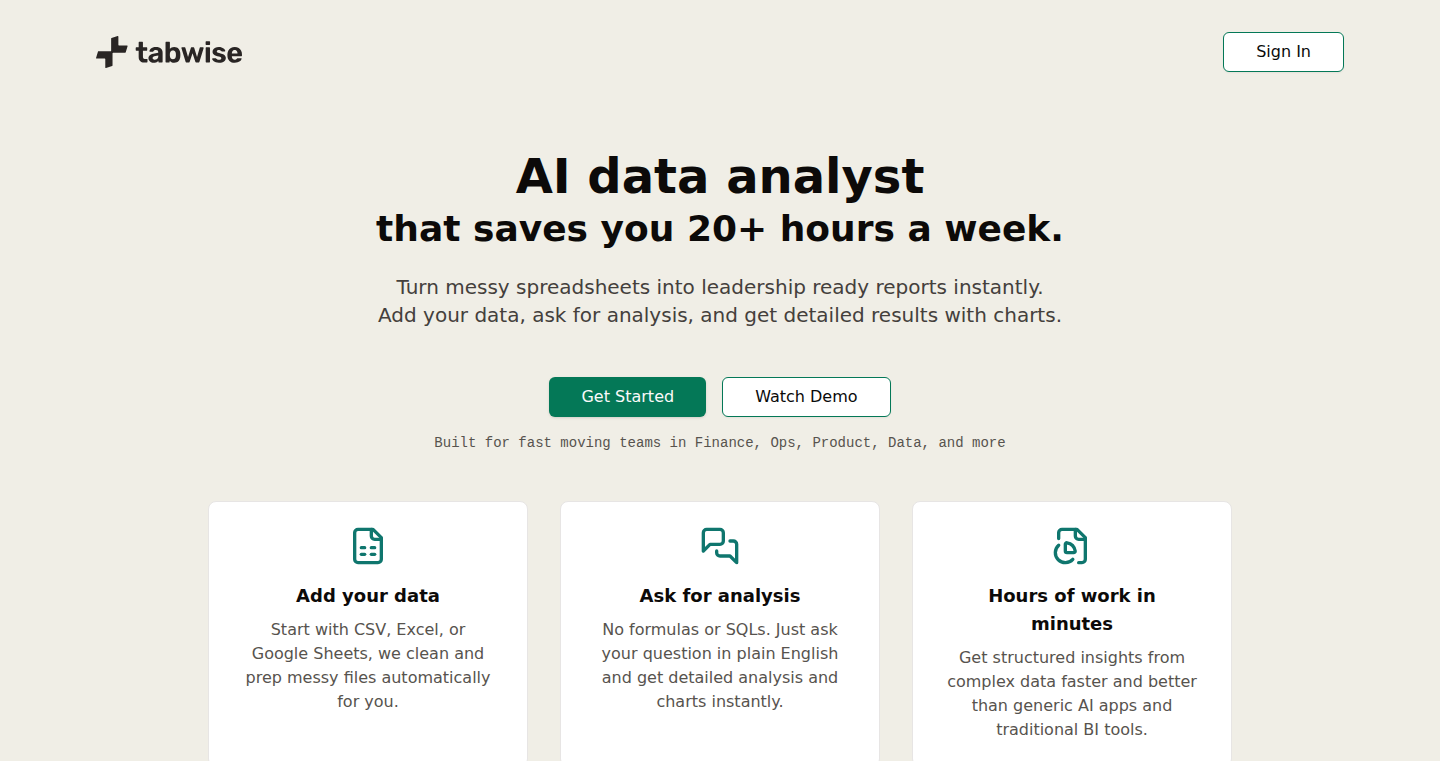
Author
abhegd
Description
Tabwise is an AI tool designed to analyze data and generate insights, outperforming existing AI models like ChatGPT and Claude in data analysis tasks. It addresses the limitations of general AI tools by incorporating three critical steps: data preprocessing, context engineering, and post-processing. This allows Tabwise to consistently deliver accurate and actionable results from data, such as spreadsheets.
Popularity
Points 2
Comments 0
What is this product?
Tabwise leverages the power of Large Language Models (LLMs) for data analysis but goes beyond simply asking questions. It first cleans and prepares the data (preprocessing), then understands the data's context and relationships (context engineering), and finally translates the AI's answers into easy-to-understand charts and summaries (post-processing). This multi-step approach ensures that Tabwise can handle complex data analysis tasks more effectively than models like ChatGPT or Claude. So this allows users to get more accurate and useful insights from their data.
How to use it?
Developers can use Tabwise by uploading data in common formats like .xlsx or .csv files. The platform then automatically analyzes the data and provides insights. Developers can integrate Tabwise into their own applications or use it as a standalone tool for tasks such as analyzing sales data, understanding ad performance, or generating business reports. This helps developers to easily analyze data without extensive coding or data science knowledge.
Product Core Function
· Data Preprocessing: Cleans, structures, and prepares the data for analysis. This includes tasks like cleaning the data, inferring the data schema, and organizing the context specifically for analytical queries. This is useful for ensuring that the data is in the best possible format to be analyzed, which improves the accuracy of the results.
· Context Engineering: Crafts prompts that understand data relationships, business context, and the expected output formats. This allows the AI to generate more relevant and useful responses. This is helpful for tailoring the analysis to specific business needs and getting insights that are immediately applicable.
· Post-processing: Converts the raw outputs from LLMs into formatted charts, summaries, and actionable insights. This makes the results easier to understand and act upon. This helps users get actionable insights that are easily understood and used to make informed decisions.
· Automated Model Routing: Automatically selects the best AI model (like Claude Sonnet-4 or open-source models via Fireworks AI) based on the complexity of the task. This improves performance and efficiency. This ensures that users are always getting the best possible analysis, regardless of the complexity of their data or task.
· Spreadsheet Analysis (.xlsx, .csv): Focuses on analyzing data from spreadsheets, a common data format used in many businesses. This provides an immediate and practical tool for data analysis. This is especially useful for quickly analyzing sales figures, marketing campaign results, or financial data, allowing quick insights.
Product Usage Case
· Sales Data Analysis: A sales team can upload their sales data to Tabwise and receive insights on top-performing products, sales trends, and customer behavior. This enables the sales team to make data-driven decisions about sales strategies and product offerings. For the sales team, this means more sales and a better understanding of their customers.
· Marketing Campaign Performance: A marketing team can analyze their ad performance data (e.g., from CSV files) to identify the most effective marketing channels, ad creatives, and target audiences. This allows them to optimize their campaigns and maximize their return on investment (ROI). For marketing teams, this means better ROI and more effective marketing strategies.
· Financial Report Generation: A business analyst can use Tabwise to analyze financial data from spreadsheets and generate summaries and charts that highlight key financial metrics, such as revenue, expenses, and profitability. This streamlines the process of creating financial reports and helps stakeholders quickly understand the company's financial performance. For analysts and stakeholders, this makes financial data understandable and usable, saving time and ensuring informed financial decisions.
· Product Development: Analyzing user feedback data (from CSV or spreadsheet files) to identify key features, customer complaints, and other important factors. This helps product teams make data-driven decisions about product improvements and future development priorities. For product developers, this means understanding the user needs, improving products, and saving development time.
41
TsKit: A TypeScript CLI Toolkit for Command-Line Power
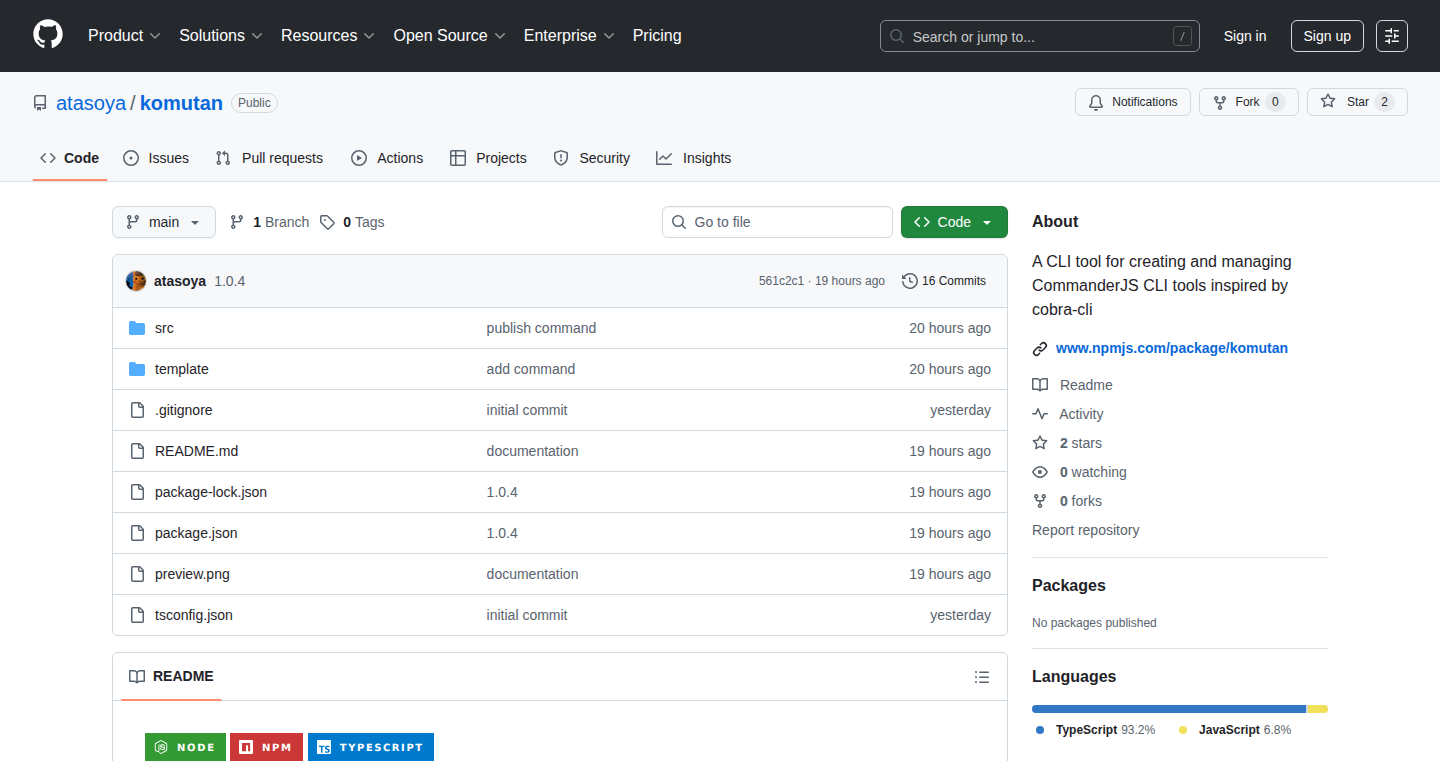
Author
ata11ata
Description
TsKit is a CLI application toolkit built specifically for TypeScript developers, leveraging the power of Commander.js. It simplifies the creation and management of command-line interfaces (CLIs) by providing a streamlined development experience, focusing on type safety and ease of use. It solves the common problem of complex CLI development by offering pre-built structures and utilities that reduce boilerplate code and enhance developer productivity.
Popularity
Points 2
Comments 0
What is this product?
TsKit is like a set of tools designed to help TypeScript developers build powerful command-line applications. Imagine building a program you run from your terminal, like `git` or `npm`. TsKit provides pre-made components and structures that make this process much easier, saving you time and reducing the amount of code you have to write from scratch. It uses TypeScript to ensure your code is well-organized and helps you catch errors early. So, it's all about making CLI app development faster, more reliable, and less of a headache. So this can significantly accelerate CLI development time, allowing you to focus on core functionality.
How to use it?
Developers can use TsKit by installing it in their TypeScript project. Then, they define commands and options using TypeScript, which provides type checking and autocompletion. TsKit then generates the CLI, complete with help menus and argument parsing. Think of it like using a framework. You set up the framework based on your needs, and then you start adding the parts of your program. Integration is straightforward: you import TsKit components into your TypeScript files and use them to build your CLI. So, it reduces development time and potential errors when building CLIs. This improves code quality and saves debugging time.
Product Core Function
· Command Definition: TsKit allows you to define commands and subcommands with clear structures using TypeScript types. This enables type-safe options, arguments, and help messages. So this enables you to create organized and well-documented CLI applications, which reduces errors and enhances maintainability.
· Argument Parsing: TsKit provides efficient argument parsing based on Commander.js. It handles various argument types and automatically generates usage information. So this ensures that your CLI application can correctly interpret user inputs and respond accordingly, improving user experience.
· Automatic Help Generation: TsKit can automatically generate help menus based on the defined commands and options, which simplifies documentation and user guidance. So this reduces the need for manual documentation creation and keeps it up-to-date as the CLI evolves.
· Error Handling: Built-in error handling mechanisms provide robust ways to manage errors and present informative messages to the user. So this improves the user experience by providing useful feedback when an error occurs.
· Configuration Management: TsKit can integrate configuration management to handle settings for your CLI app. So this can save your application configurations and settings, and helps your application run smoothly and predictably.
Product Usage Case
· Automation Scripts: A developer needs to automate repetitive tasks. TsKit can be used to build a CLI to execute these tasks, passing configuration through command-line arguments and options. So, it allows you to automate tasks, saving you a great deal of time and effort.
· Build Tools: Development teams can use TsKit to create custom build tools that handle tasks such as code compilation, testing, and deployment. So this allows you to build specific tools to suit your needs, streamlining the building and releasing processes.
· System Administration: System administrators can build CLIs to manage server configurations, monitor system health, or automate routine maintenance operations. So this provides an efficient way to automate server management tasks, saving time and ensuring consistency.
· Developer Utilities: Developers can rapidly prototype and deploy utility CLIs for debugging, generating code templates, or interacting with APIs. So this gives developers tools to work more efficiently and address unique challenges by simplifying and automating workflows.
42
Railway MCP: One-Shot Fullstack Deployment Engine
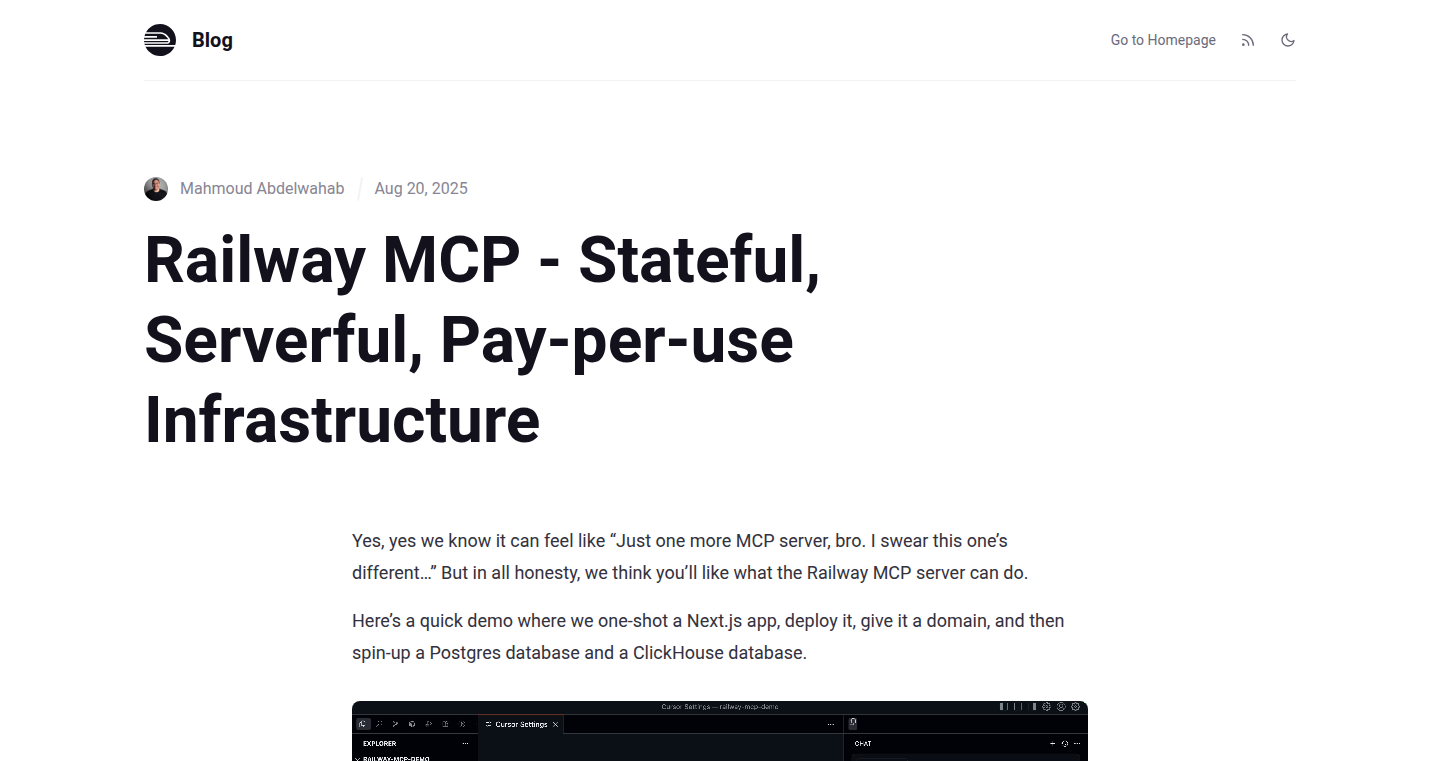
Author
thisismahmoud_
Description
Railway MCP simplifies the deployment of full-stack applications and databases by offering a one-command solution. It automates the complex process of setting up infrastructure, configuring servers, and deploying code. The key innovation is its ability to provision all necessary resources (like databases and backend services) and connect them seamlessly, allowing developers to focus on writing code rather than managing infrastructure. It tackles the common pain points of lengthy deployment processes and complex configuration.
Popularity
Points 1
Comments 1
What is this product?
This project is a deployment automation tool. Think of it as a super-powered button that takes your application and its required parts (like databases, server code, etc.) and automatically puts them online for the world to see. The magic lies in its ability to handle all the tricky bits: setting up servers, connecting the different parts of your application, and making sure everything works together. So this allows you to deploy your app with a single command and save you a lot of time and headaches.
How to use it?
Developers use Railway MCP by pointing it at their application code. It then analyzes the code to figure out what it needs (e.g., a database, a web server, etc.) and provisions all the necessary resources. Developers then simply run a single command. Railway MCP handles all the behind-the-scenes setup, configuration, and deployment. So you can use it to deploy web applications, APIs, or any other full-stack project. It integrates well with different development workflows.
Product Core Function
· Automated Infrastructure Provisioning: This feature automatically sets up the servers, databases, and other resources your application needs. So, you don't have to manually configure anything; the tool takes care of it.
· Dependency Management: Railway MCP can identify and manage the dependencies of your application, ensuring everything is in place before deployment. Therefore, your app will work immediately after deployment without any manual adjustments.
· One-Command Deployment: Deploying your application becomes as simple as typing a single command. As a result, you save time and reduce the chance of errors.
· Seamless Integration: Railway MCP integrates your application with other services, like databases and backend APIs. Thus, everything works together flawlessly.
Product Usage Case
· Deploying a Web Application with a Database: A developer wants to quickly deploy a full-stack web application. They provide their code, and Railway MCP automatically sets up the necessary database, connects it to the web application, and deploys the application to a live server. So, the developer can focus on coding the application's features without needing to worry about the underlying infrastructure.
· Deploying a Microservices Architecture: A team builds a microservices architecture where each service depends on others. The Railway MCP automates the deployment process, setting up individual services and connecting them together, allowing the team to deploy and update their services efficiently. Therefore, you can easily update your application without causing service downtime.
· Quick Prototyping for Startups: A startup wants to rapidly test their application idea. Railway MCP enables them to deploy a functional prototype quickly, allowing them to gather feedback and iterate without dealing with complex deployment steps. Hence, you can validate your ideas faster and iterate quickly.
43
Focalist - A Web-Based Task Manager for Focus
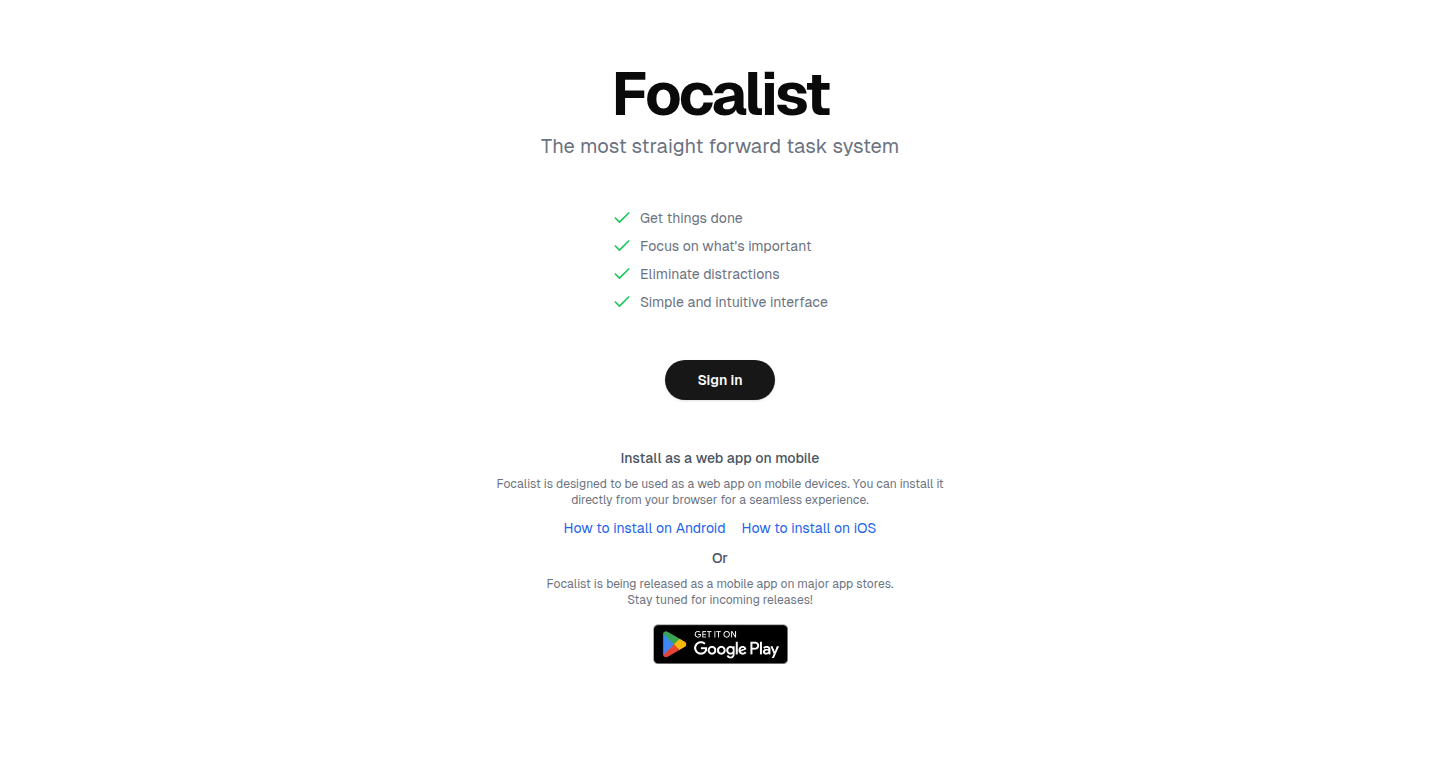
Author
martin_hell
Description
Focalist is a simple web-based task manager designed to help users maintain daily focus. It addresses the problem of task overload and distraction by providing a clean and intuitive interface for managing and prioritizing tasks. The innovative aspect lies in its minimalistic design, eliminating unnecessary features to encourage users to concentrate on their core tasks. It leverages basic web technologies like HTML, CSS, and JavaScript, offering a straightforward solution without complex dependencies.
Popularity
Points 1
Comments 1
What is this product?
Focalist is a web application that allows you to create, organize, and prioritize your daily tasks. Think of it as a digital to-do list, but with a focus on simplicity and ease of use. The innovation comes from its minimalist approach, meaning it gets rid of all the fancy features that might distract you, and instead focuses on what you need to get things done. It's built using common web technologies, which means it runs in any web browser and doesn't require you to install any special software. So what's the point? It keeps things simple so you can stay focused on your work.
How to use it?
Developers can use Focalist to manage their own projects, track progress, and prioritize coding tasks. You can access it via any web browser. You simply add tasks, set their priorities, and mark them as complete. Developers could integrate it into their development workflow by using it to break down large projects into smaller, manageable steps, thereby avoiding being overwhelmed. The simplicity allows for easy integration with existing tools. Think of it as a lightweight, personal project management tool that lives in your browser.
Product Core Function
· Task Creation: Allows users to add new tasks with a simple interface. This is valuable because it provides the fundamental building block for managing your to-do list. It's the starting point for everything.
· Task Prioritization: Enables users to set priorities for each task (e.g., high, medium, low). This is crucial for focusing on the most important tasks first, thus boosting productivity and efficiency. So, this means you always work on the right things.
· Task Completion Marking: Provides a way to mark tasks as completed. This helps track progress and provides a sense of accomplishment. It offers a clear way to measure what you've achieved, making the process more rewarding.
· Web-Based Access: Accessible through any web browser, enabling access from any device (computer, tablet, etc.). This is beneficial for developers who work across multiple devices or need to access their tasks on the go. It makes your to-do list available everywhere.
Product Usage Case
· Project Management for Developers: A developer can use Focalist to break down a large coding project into smaller, manageable tasks. They can then prioritize these tasks and track their progress, ensuring they stay on schedule. For example, if you're building a new website, you can create separate tasks for designing the UI, coding the back-end, and testing. So you stay organized.
· Daily Task Organization: A developer can use Focalist to manage their daily coding tasks, like fixing bugs, writing documentation, and reviewing code. This ensures developers focus on the most crucial tasks. This helps to avoid task overload, helping developers tackle one task at a time.
· Team Collaboration (Simple): While not a collaborative tool, individual developers can use Focalist to break down their work and assign tasks to each other through direct communication. Each developer maintains their own task list, but the prioritization system helps the team be efficient.
· Personal Productivity: A developer can use Focalist to manage their personal tasks and habits alongside their work. This helps to stay on track across different aspects of life and improve their overall productivity. So you can keep track of both your work and personal life.
44
AI Football Stats Prophet

Author
mceoin
Description
This project uses Artificial Intelligence to analyze fantasy football data, providing insights and predictions for players. The key technical innovation lies in its ability to process and interpret large datasets of player statistics, game outcomes, and external factors to forecast future performance. It tackles the challenge of predicting outcomes in a complex, dynamic environment by employing machine learning models.
Popularity
Points 1
Comments 1
What is this product?
It's an AI-powered tool that analyzes football player data to predict how well they will perform in fantasy football leagues. It uses machine learning to sift through mountains of statistics, like past performance, player matchups, and weather conditions, to give you the most probable outcome. The innovative part is its ability to learn and adapt to new information, offering more accurate predictions over time.
How to use it?
Developers can use the project by accessing the AI model's prediction API. You can integrate it into your own fantasy football applications, websites, or analysis tools. You'd feed the API player data, game details, and other relevant information, and it returns predicted performance metrics. This allows you to build more data-driven features and enhance user experience.
Product Core Function
· Player Performance Prediction: The core function is predicting individual player performance in fantasy football. This means the system estimates how many points a player will score in a given game. This is valuable because it helps users make informed decisions when setting their fantasy lineups. So this can help you win your league.
· Data Aggregation and Processing: The project gathers and processes massive amounts of football data from various sources. It's like having a powerful data cleaning and organizing tool, helping users get past the raw data and get right to the actionable insights. This simplifies the analyst's workflow and gets the user closer to the prediction
· Model Training and Evaluation: The AI model is trained using historical data and continuously refined through new data. This ensures the model gets better at predicting as more data is available. So this means the system is constantly learning and improving the predictions.
· Feature Engineering: The project includes feature engineering, which involves creating new variables from existing data that are useful for the model. This helps the system better understand the relationships between different factors and player performance. So it allows for more accurate predictions by identifying important patterns.
· API Integration: It provides an API to access the prediction model. Developers can integrate the tool into their own fantasy football applications, enhancing their capabilities with AI-driven insights. So developers can use the predictions to create more valuable features for their users.
Product Usage Case
· Fantasy League Lineup Optimization: Use the AI predictions to build the best possible lineup for your fantasy football team each week. By selecting players predicted to score the most points, you increase your chances of winning. It helps users to automatically optimize their team, saving them time and increasing the chances of victory.
· Player Value Analysis: Determine which players are undervalued or overvalued in your league. The model can identify players whose predicted performance is significantly different from their current draft position. Helping managers make the right trades, pick the best players to pick up in free agency.
· Automated Fantasy Football Reporting: Create automated reports on player performance, key matchups, and potential breakout players. The API provides the data needed to create detailed analyses for your fantasy football audience. This can create better content for your website or blog.
45
Thirty: The AI Calendar
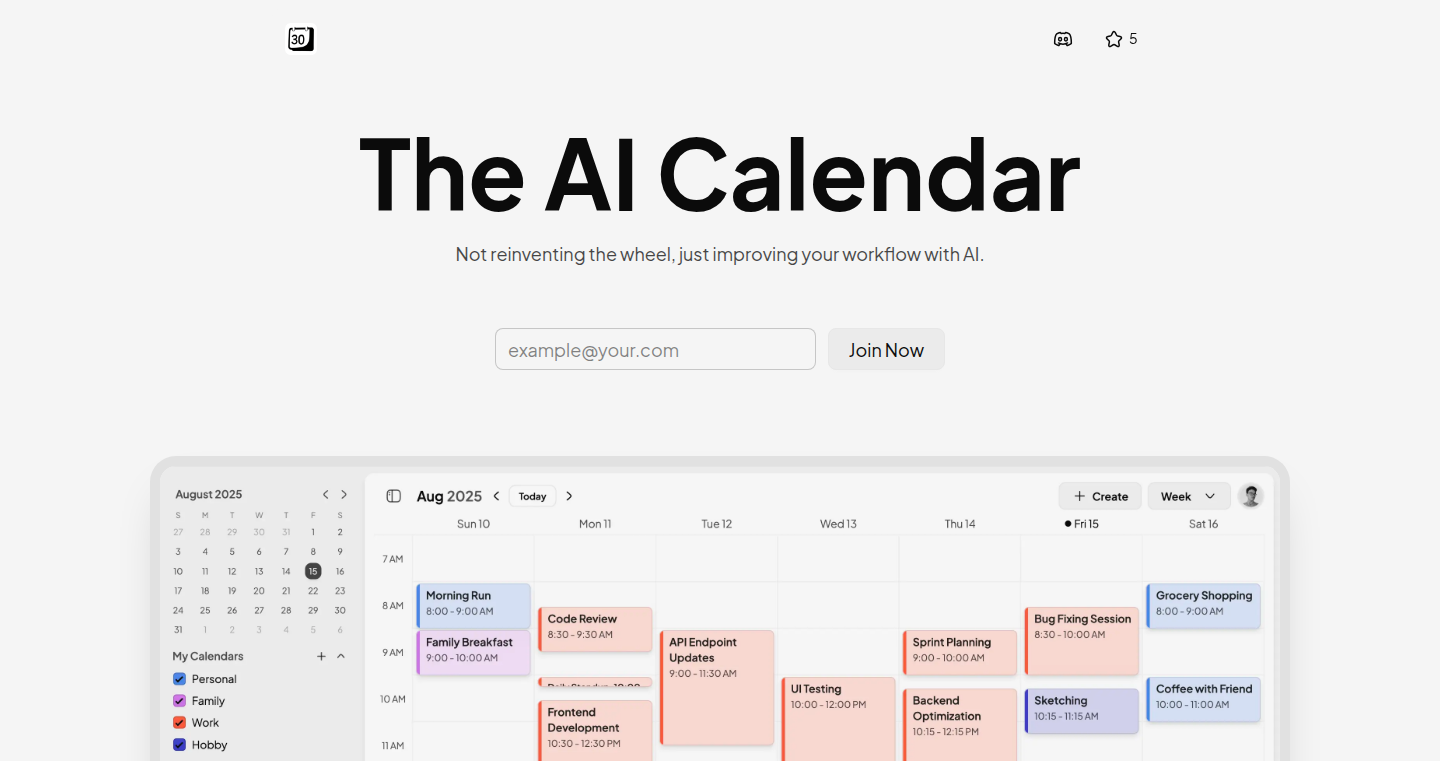
Author
sithu_khant
Description
Thirty is an AI-powered calendar that aims to simplify scheduling. It leverages natural language processing (NLP) and machine learning (ML) to understand meeting requests and automatically manage your schedule, suggesting optimal meeting times and handling conflicts. It represents an innovative approach to calendar management, moving beyond basic scheduling to intelligent automation.
Popularity
Points 1
Comments 1
What is this product?
Thirty is an AI calendar. Instead of manually inputting meeting details, you can simply describe your meeting needs in plain English. The system then uses AI to understand the request, find available times in your schedule and the schedules of others (if they've shared access), and propose the best meeting slot. It is a smart scheduler that reduces the time and effort spent on coordinating appointments.
How to use it?
Developers can use Thirty by integrating its APIs or by using the web interface. You might integrate it into your project management tools, communication platforms, or other applications that require scheduling capabilities. This allows for automated appointment setting, reducing manual effort for users. So you can use Thirty to automate scheduling for your project. You can also use it to automate your own schedule.
Product Core Function
· Natural Language Processing (NLP) for Understanding Requests: Thirty uses NLP to interpret meeting requests written in natural language. This means it can understand phrases like 'meet with John to discuss the project next week'. This saves you time and effort as you don't need to precisely specify date, time, and participants.
· Intelligent Time Suggestion: The AI engine analyzes the schedules of all participants to suggest the best meeting times, considering availability and time zone differences. This helps you find the most convenient time for everyone involved.
· Automated Conflict Resolution: When there are conflicts in your schedule, the AI helps to automatically suggest alternative times or resolve the conflicts based on your preferences. You can avoid scheduling conflicts, saving you the headache of manual adjustments.
· Meeting Coordination Automation: It automatically handles all the steps involved in scheduling meetings - from understanding the initial request, to proposing a time, and eventually setting up the event in your calendar. This reduces the need to manually check calendars and send emails back and forth.
Product Usage Case
· Project Management Tool Integration: Integrate Thirty with a project management platform to automatically schedule meetings for project updates or task discussions. Developers could use Thirty to automate meetings and speed up collaboration. So, use Thirty to quickly schedule project discussions.
· Customer Service Scheduling: In a customer support system, use Thirty to allow customers to schedule appointments with support agents by simply typing their request in a chat. This saves the customer time and makes the support experience more convenient. So, you can schedule meetings with ease by using Thirty.
· Personal Calendar Management: Use Thirty to automate scheduling for personal appointments, such as doctor's visits or social gatherings. So, You can automate your meetings without much effort.
· Team Collaboration: A development team can use Thirty to streamline meeting scheduling, for example, when planning sprints or conducting code reviews. So you can use it to reduce manual effort by automating the meeting process.
46
Fantasy Football Neuron: AI-Powered Lineup Debate Platform
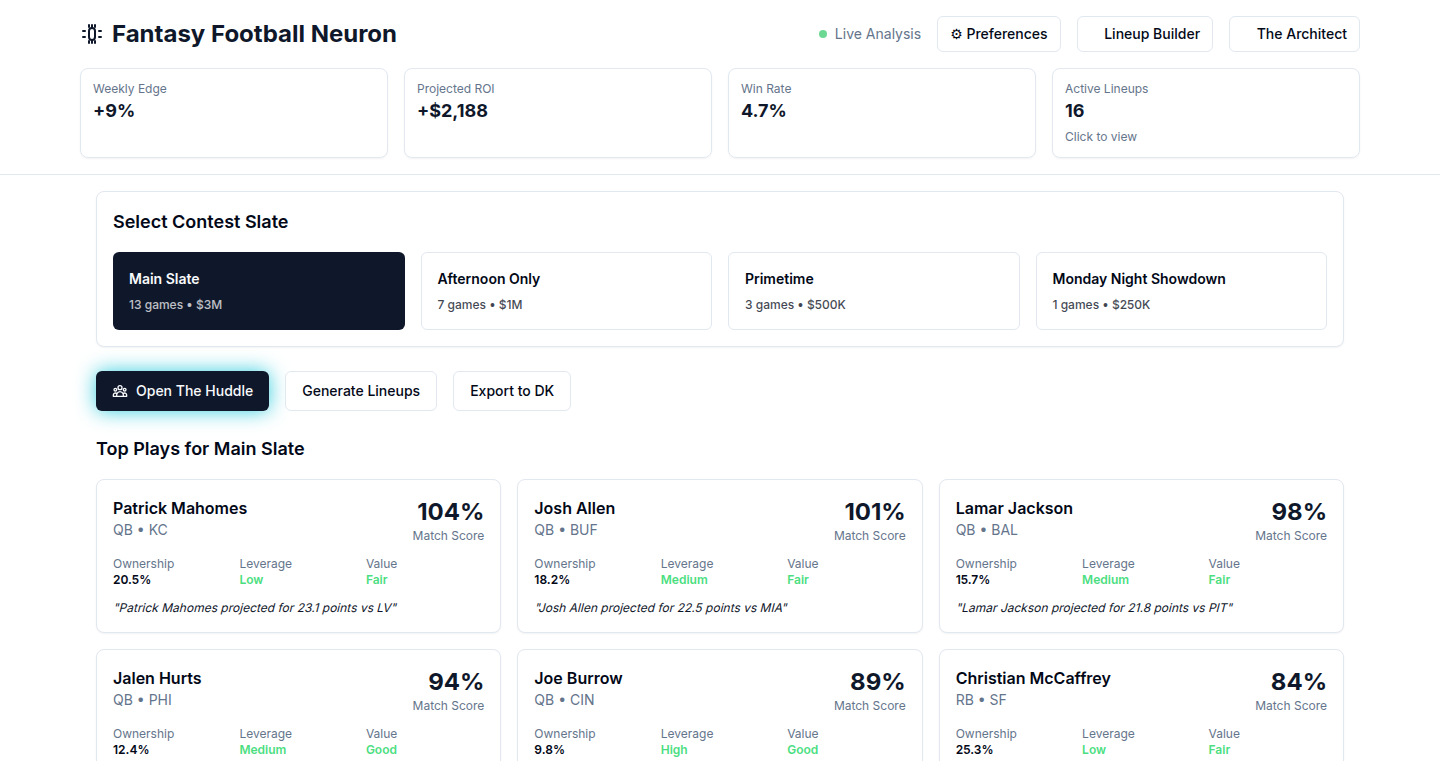
Author
machinemusic
Description
Fantasy Football Neuron is a fascinating tool that leverages artificial intelligence to revolutionize fantasy football lineup research. Instead of passively reading articles or relying on opaque optimization tools, this application allows users to engage in real-time debates with multiple AI analysts. Each analyst is trained on a different fantasy football strategy, providing diverse perspectives on player selection. The platform uses cutting-edge technologies, including serverless architecture, real-time databases, and advanced caching techniques, to deliver a responsive and insightful experience. The core innovation lies in transforming the research process from static data consumption to dynamic, interactive debate, which enhances understanding and decision-making.
Popularity
Points 1
Comments 1
What is this product?
This project creates a platform where you can ask AI analysts about your fantasy football lineup. It's like having a team of experts arguing in real-time about the best players to choose. The system uses multiple AI models, each with its own unique strategy (like focusing on data, taking contrarian views, or aiming for grand prize tournaments). It uses voice technology (ElevenLabs) to simulate a discussion among these AI analysts. The platform leverages serverless functions, a real-time database, and caching technologies to make it fast and affordable. So, you get expert opinions and can export your final lineup directly to popular fantasy platforms. This transforms the way you research and make lineup choices.
How to use it?
Users can access Fantasy Football Neuron through a web application. You start by posing a question like “Who should I start: Tua or Allen?” The system then activates up to six AI analysts, each with a different strategy, to debate the issue using ElevenLabs voices. The platform provides a real-time transcript of the arguments, highlighting the reasoning behind each player selection. Users can review the debate, understand the different perspectives, and then choose the optimal lineup. You can then export the final lineup directly to DraftKings or FanDuel. This is a great tool for players seeking to improve their research process and gain deeper insights into player selections. So, you can use it to get better at fantasy football by having smart AI analysts debate with you.
Product Core Function
· Multi-Agent AI Debates: This feature allows users to engage in real-time debates with multiple AI analysts, each tuned to a specific fantasy football strategy. This approach offers diverse perspectives and enhances the user's understanding of the pros and cons of each player selection. This is valuable because it provides a more comprehensive understanding of player evaluations, leading to better lineup choices.
· Real-time Transcript with Reasoning: The platform generates a live transcript of the AI debates, detailing the reasoning behind each analyst’s recommendations. This provides clear insights into why each player is favored, which helps users to make informed decisions based on well-supported arguments. This is valuable because it allows users to understand the rationale behind the recommendations, leading to better decisions and a deeper understanding of fantasy football strategy.
· Direct Lineup Export: After the debate and lineup selection, users can directly export their chosen lineup to DraftKings or FanDuel. This streamlines the process of building and submitting lineups, saving time and effort. This is valuable because it simplifies the user experience by eliminating the need for manual lineup entry.
· Diverse AI Analyst Strategies: The system employs AI analysts with various strategies (GPP, data-heavy, contrarian, etc.). This allows users to benefit from a range of viewpoints and tailor their decisions to their preferred playing style. This is valuable because it caters to different user preferences, ensuring the tool remains adaptable to a variety of approaches.
Product Usage Case
· Player Comparison: Users can compare two players (e.g., Tua vs. Allen) by asking the AI analysts for their opinions. The system provides real-time debates with explanations. This is valuable because it helps users quickly analyze player comparisons, which is a core aspect of lineup building.
· Lineup Optimization: Users can input their current lineup and ask the AI to analyze potential improvements based on different strategies. The AI analysts debate potential changes and explain their reasoning. This is valuable because it allows users to refine their lineups, increasing their chances of success.
· Strategy Exploration: Users can explore various fantasy football strategies through the AI analysts' debates. For example, users can examine whether a high-risk, high-reward (GPP) strategy is more advantageous for a particular week. This is valuable because it helps users better understand different strategies and tailor their approach.
· Real-time Decision Support: During the lineup building phase, users can use the platform for real-time decision support, enabling them to make well-informed and data-driven choices based on AI-powered analysis and insights. This is valuable because it provides an advantage in high-stakes contests.
47
WorldModel Weaver: A Zero-Budget Long-Context Narrative Engine
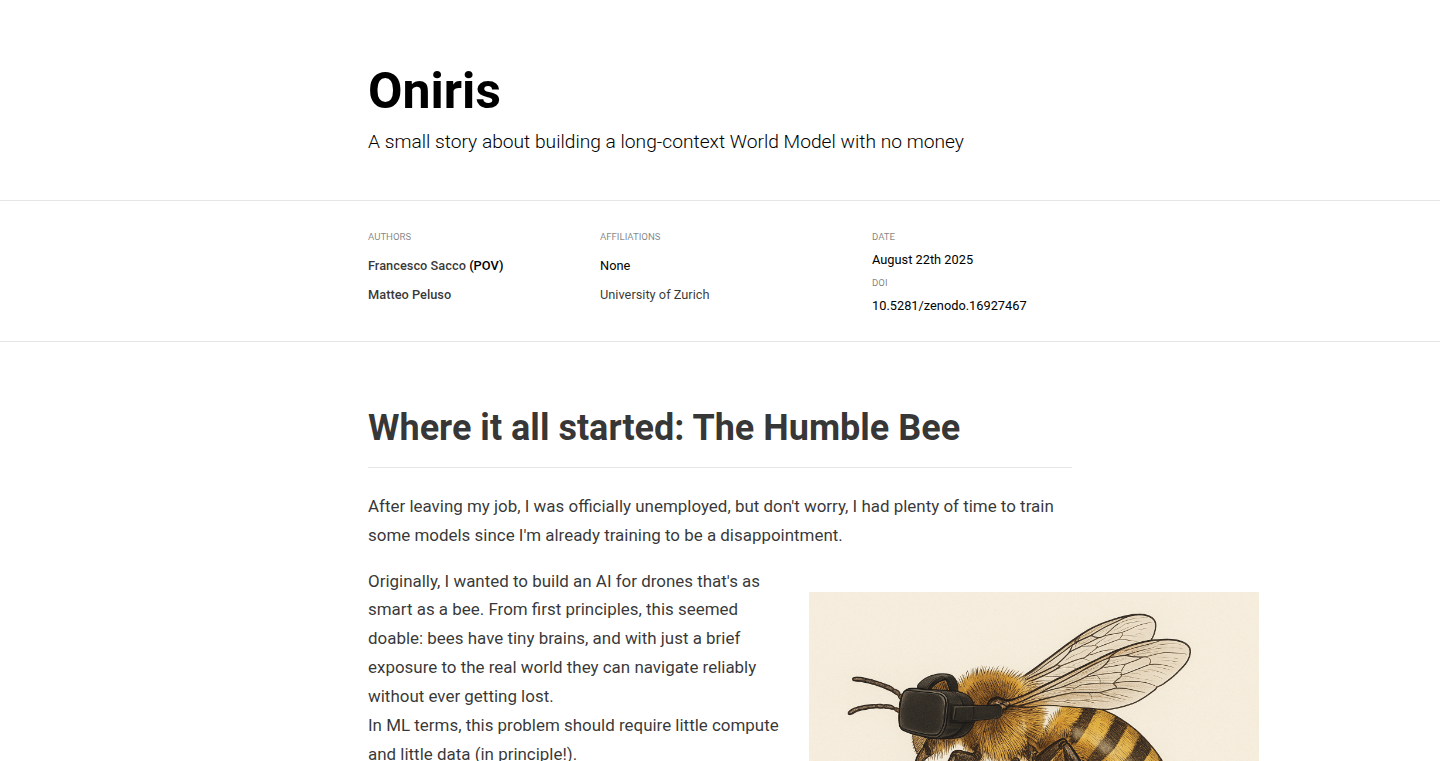
Author
Sacco215
Description
This project showcases a method for building a 'world model' - a system that can understand and generate long-form narratives, even with limited resources. It cleverly utilizes existing language models and innovative prompt engineering to create a story-telling engine capable of maintaining a coherent 'world' across extensive text inputs. This approach demonstrates how to overcome the constraints of cost and computational power in complex AI tasks. So this gives the ability to develop large-scale context understanding applications without massive investments.
Popularity
Points 2
Comments 0
What is this product?
This project is about creating a 'world model' for generating long stories. It does this by taking advantage of existing language models. The main innovation lies in smart 'prompt engineering' - carefully crafting the initial instructions and queries fed to the language model to enable it to retain context over a very long sequence of text. Think of it as teaching a language model to remember a long story and then continue telling it. So this allows developers to build sophisticated storytelling applications or systems that can understand and interact with a vast amount of information, like a full book.
How to use it?
Developers can integrate this approach by experimenting with different prompt structures and fine-tuning the language model's parameters. The core idea involves constructing a 'world' by feeding information and then generating narrative outputs. This can be done by writing scripts to automate the process, feeding the system with data, and then parsing the story outputs. So if you're working on projects involving long-form content generation, such as creating interactive stories or virtual assistants with robust memory, this project provides a template.
Product Core Function
· Long-Context Narrative Generation: The system can generate stories across a significantly larger context window compared to standard language models, enabling it to maintain coherence and generate complex plots. This is valuable for building applications like automated storytellers, game designers, or content creators needing to produce lengthy content.
· World Model Creation: It allows the creation of a virtual 'world' by feeding initial data and rules to the system, which then maintains and evolves this world as it generates text. This enables the creation of virtual worlds and virtual characters to improve the context generation
· Zero-Budget Experimentation: The project demonstrates how to use existing models without requiring substantial investment in custom training, enabling the use of existing, free models.
· Prompt Engineering Techniques: It provides practical examples of how to engineer prompts to extend the effective context window of language models, allowing for exploration of different narrative styles.
· Iterative Storytelling: The engine can build a story iteratively, by taking previous output as input in an iterative manner, building up a complex narrative over several cycles of generation.
Product Usage Case
· Interactive Fiction: Imagine creating an interactive story game where the player's choices lead to a long and evolving narrative, which is handled in an iterative fashion; the game engine can remember and respond to player choices in detail over the long haul.
· Automated Content Generation: It could be used to automate the writing of long-form articles, blog posts, or even novels, reducing the time and effort required for content creation.
· Virtual Assistants with Long-Term Memory: Develop a virtual assistant that can remember conversations and maintain a detailed understanding of a user's preferences and past interactions, creating a much more personalized and coherent user experience.
· Role-Playing Games: The system can be used to generate a story line for players, keeping context with the players' interaction over time.
48
MinuteTick: The Time-Tracking & Productivity Companion for macOS
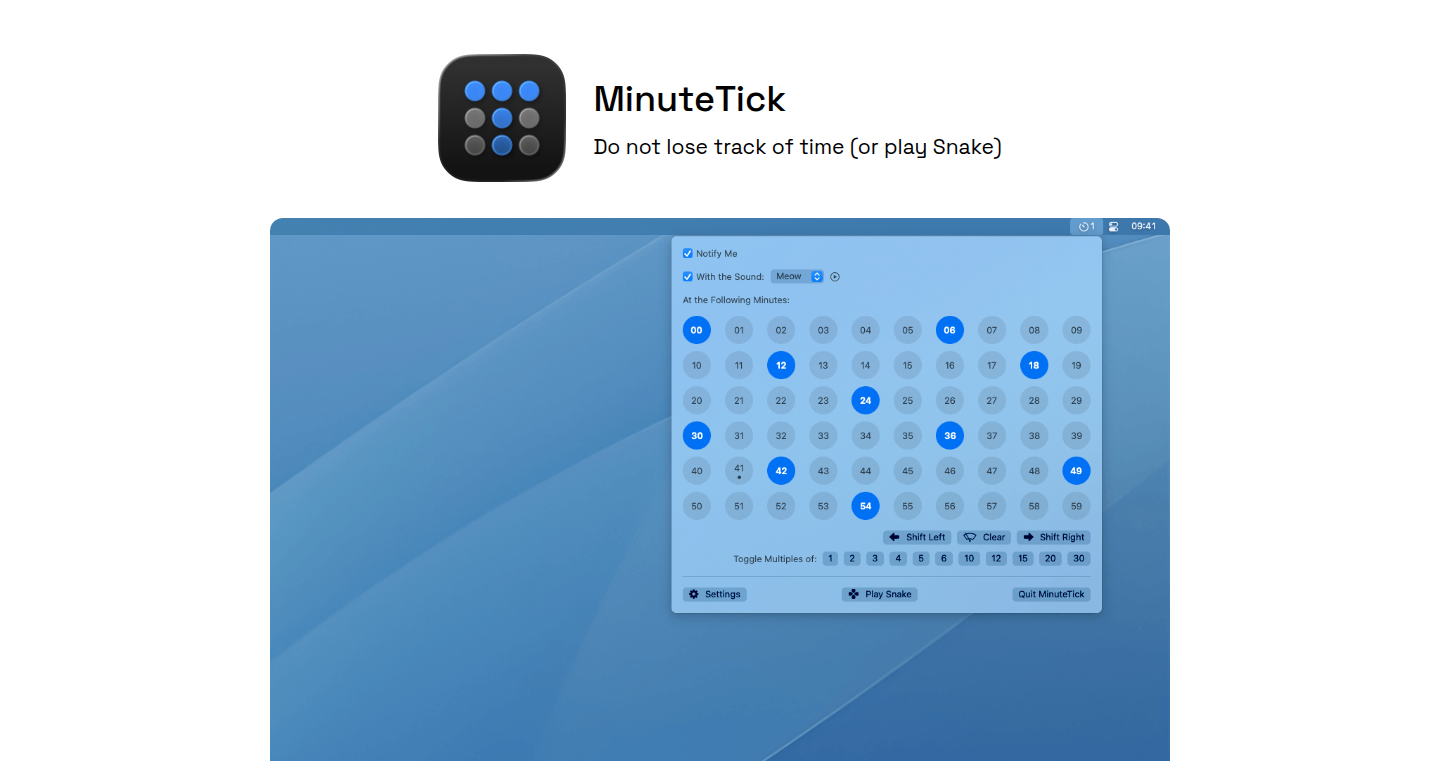
Author
imaginaryapps
Description
MinuteTick is a macOS application designed to help users stay aware of time passing, preventing them from getting lost in work and potentially boosting productivity. It offers a subtle visual and auditory cue every minute, reminding users of the ongoing time. The core technical innovation lies in its minimalist design and efficient implementation, minimizing resource usage while offering a constant, non-intrusive time awareness feature. This solves the common problem of 'time blindness' experienced by many while working on computers.
Popularity
Points 1
Comments 1
What is this product?
MinuteTick is a simple macOS app. It works by providing a small, usually invisible, visual or auditory signal every minute. The core idea is to nudge you, reminding you of the passing time. It’s built to be lightweight, using minimal computer resources. The innovative aspect is its focus on unobtrusiveness: it doesn't disrupt your workflow but subtly keeps you connected with time, helping you manage it better.
How to use it?
Developers can use MinuteTick as a tool to practice focused work sessions, like the Pomodoro Technique, where you work in intervals. You just install it, and it runs quietly in the background. Developers can adjust the cues (visual or sound) to their preference. This makes it easy to integrate into any workflow where time management is crucial, such as coding, debugging, or any task requiring concentration.
Product Core Function
· Minute-by-Minute Reminders: This is the heart of MinuteTick. It reminds you of the passing time with a customizable signal. So what? It helps you break down long tasks into manageable intervals and stay focused.
· Customizable Cues: The app allows you to tailor the visual and auditory signals. So what? It allows you to personalize the experience, making it less distracting and more helpful for you.
· Minimal Resource Usage: MinuteTick is designed to be lightweight and use minimal CPU or memory. So what? It won't slow down your computer or interrupt your workflow while it runs.
· Optional Snake Game: Includes a simple Snake game you can play when you need a quick break. So what? This gives users a simple way to unwind and take short breaks without switching to another app.
Product Usage Case
· Focused Coding Sessions: A developer can use MinuteTick to work in 25-minute sprints, taking short breaks after each session. This can significantly improve focus and reduce burnout. So what? You get more done with less mental fatigue.
· Meeting Time Awareness: Developers often participate in long meetings. MinuteTick helps them keep track of time, ensuring meetings stay on schedule. So what? It helps you manage your time efficiently, preventing meetings from running over.
· Pomodoro Technique Implementation: MinuteTick can be used as a dedicated tool for the Pomodoro Technique, improving productivity. So what? It provides a simple way to implement a proven productivity method.
· Debugging and Development Sprints: While debugging complex code, MinuteTick can help you stay focused on the task. So what? Allows you to break down long debugging sessions into more manageable timeframes.
49
ArduinoTrafficLight-TableDriven

Author
chclau
Description
This project reimplements a simple traffic light system using an Arduino board. The innovation lies in its 'table-driven design'. Instead of writing complex, hard-to-understand code for each traffic light state, the project uses data structures (like arrays) to define the behavior. This makes the code cleaner, easier to modify, and allows for more complex traffic patterns to be easily implemented. It addresses the common problem of spaghetti code often found in Arduino projects by promoting modularity and readability.
Popularity
Points 1
Comments 1
What is this product?
This is a traffic light control system built on an Arduino. The clever part is how it's designed. Instead of writing a lot of complicated instructions, the system uses tables (like a spreadsheet) to describe the traffic light's behavior. This means you can easily change how the lights work just by modifying the table, making the code easier to understand and update. So it uses a table to define the sequence and duration of each traffic light state.
How to use it?
Developers can use this project as a starting point for their own Arduino projects involving control systems. The table-driven approach is especially useful for scenarios with complex logic or sequences. You can download the code, modify the tables to customize the traffic patterns, and upload it to your Arduino. So it could be easily adapted for controlling other things that require a sequence of actions, such as a robot's movements or a manufacturing process.
Product Core Function
· Modular Code Structure: The code is broken down into smaller, reusable functions. This means you can easily swap out parts of the code without breaking the whole system. This increases maintainability and makes debugging easier. So this lets you reuse code blocks in other projects.
· Table-Driven Configuration: The behavior of the traffic lights is defined in data structures (tables). By simply changing the data in these tables, you can modify the traffic light sequence without touching the core code. This is highly flexible and adaptable for changing traffic flow requirements. So this allows you to quickly adjust the timing and sequence of lights.
· Array-Based State Management: The project uses arrays to store data related to traffic light states. This efficiently organizes the data and simplifies the code, making it more readable. So this allows for concise representation of the traffic light states, simplifying code.
· Time Control using `delay()` function: The project uses Arduino's `delay()` function to control the timing of each traffic light phase. This is a simple way to control the duration of each state, making the code easier to understand. So this is helpful for learning and understanding basic timing operations with Arduino.
Product Usage Case
· Educational Projects: The project provides a clear example of how to structure Arduino code for beginners. Students can study the table-driven design to grasp coding best practices in electronics projects. So this helps beginners learn coding by example.
· Customized Traffic Control: You can modify the table data to create unique traffic patterns for special situations. So this enables creation of different timing behaviors and adapts to new requirements without rewriting the core logic.
· Robotics and Automation: The concept can be extended to control the sequences in robotics. This includes movements, actions, and any state transitions. So this offers a flexible, table-driven way to handle robotic motions and complex actions.
· Prototyping of Industrial Control Systems: The table-driven design is very useful for quickly experimenting with sequences in industrial environments. So this allows quick exploration of different behaviors during development.
50
Unbreakable: Contextual Focus Assistant
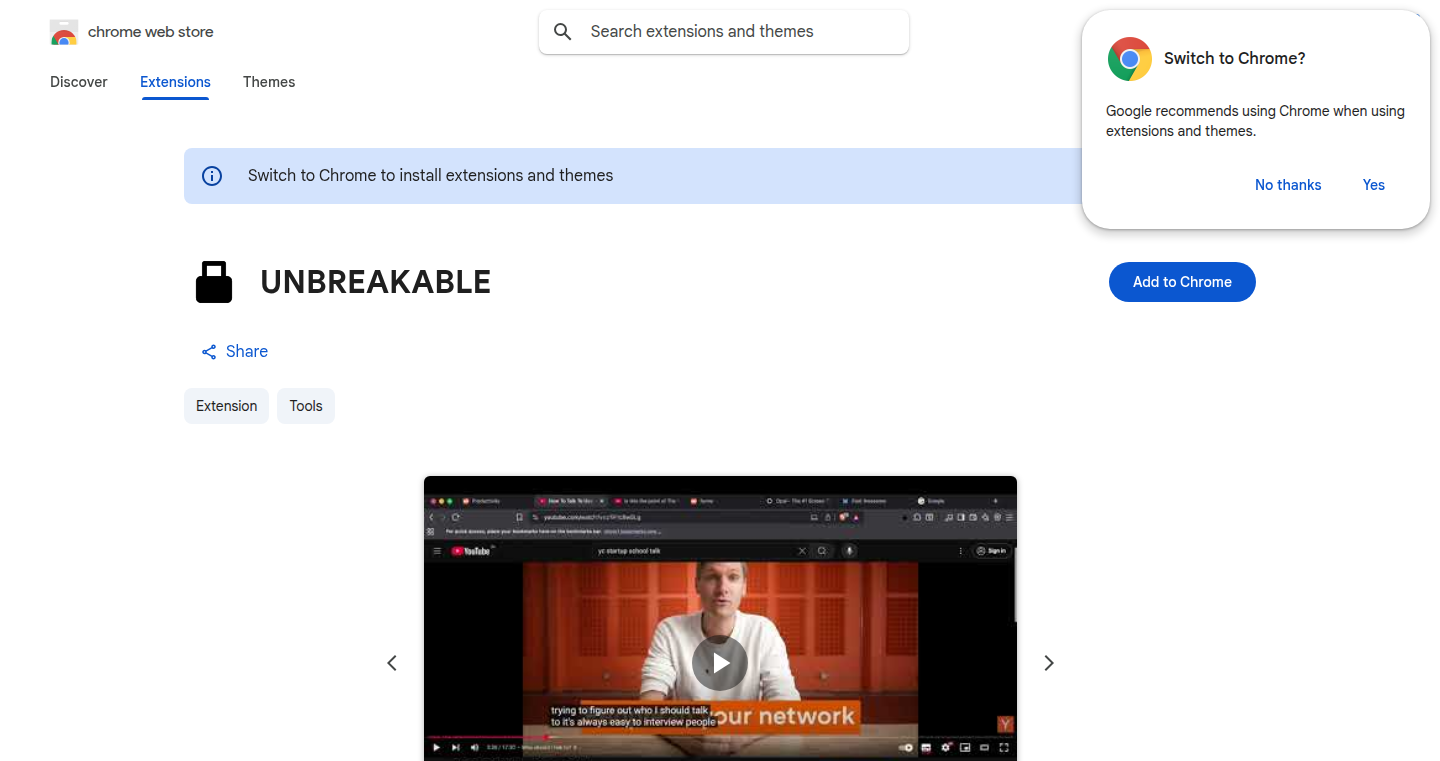
Author
FezzikTheGiant
Description
Unbreakable is a browser extension that uses AI to help you stay focused by understanding what you're *actually* doing on your computer, not just what websites you're visiting. Unlike basic website blockers, it analyzes the context of your browsing activity, allowing access to useful sites while preventing distractions. It features a dynamic blocking mechanism and a way to override blocks with explanations, promoting a more flexible and effective approach to productivity. The core innovation lies in its contextual analysis of website content and user intent, rather than simple URL blocking.
Popularity
Points 2
Comments 0
What is this product?
This is a browser extension that uses artificial intelligence (AI) to understand if you're staying on task. Instead of just blocking a list of websites, it looks at what you're *doing* on a website. For example, if you're studying physics, it might let you watch a lecture on YouTube, but block other distracting content. The AI analyzes the context of what you're viewing and compares it to your defined focus task. So, if it detects you're getting sidetracked, it can block the offending site, even if it's normally allowed. This allows for more nuanced control over your browsing experience, letting you balance focused work with access to helpful resources. So this is useful because it adapts to your needs and is less restrictive, allowing for more flexibility and real-world usage scenarios.
How to use it?
Install the Chrome extension and define your focus tasks (e.g., "Writing a report - research + writing"). Then, tell the extension how long you want to focus. As you browse, the extension analyzes the content on your screen. If it thinks you're off-task, it blocks the website. Even after blocking, you can tell the extension why you need the site – if the AI thinks your reason is valid, it lets you access the site. For example, if you're writing a report about a specific topic, and you navigate to a relevant Wikipedia page, the extension might allow it. But, if it detects you're visiting a social media site, it may block access, based on its analysis of your current focus task. This is great for anyone who wants to enhance their productivity while maintaining access to helpful resources – without the frustration of being blocked from legitimate sites.
Product Core Function
· Contextual Website Blocking: The core of the extension. It monitors your browsing activity and blocks websites based on the content you are viewing and your predefined focus task, not just the URL.
· AI-Powered Analysis: The extension utilizes AI to understand the context of your browsing. It compares the content of the websites you visit to your focus task. This means it can differentiate between necessary and distracting websites.
· Dynamic Blocking and Unblocking: The extension dynamically blocks and unblocks websites in real-time, based on the AI's analysis. If you are off-task, the website is blocked; if you can provide a valid explanation of why you need the site, access is granted.
· Customizable Focus Tasks: Users can define their focus tasks, such as "studying physics" or "writing a report." This helps the AI tailor its analysis and adapt to the user's specific needs.
Product Usage Case
· Studying: When studying for an exam, the extension might allow you to access physics lectures on YouTube or research papers on a particular subject while blocking social media or gaming sites. This helps students stay focused on their studies. So this helps me because it filters the distractions when I'm learning.
· Research: If you are researching a topic, the extension might allow you to access relevant websites, but block unrelated sites. For example, if you're writing a report, it can provide access to Wikipedia pages or credible news articles related to your subject.
· Flexible Focus Sessions: You are writing a long document and need information from a specific website. The extension recognizes the validity of your context and permits access, thereby making focused work seamless while allowing access to required sites.
· Writing: If you are trying to write a blog post and need to verify information on a website, the extension may allow you to access the site, while blocking social media sites and other possible distractions. So I can write while focusing, maintaining access to critical information.
51
CodeSight: A Line-of-Code Analyzer
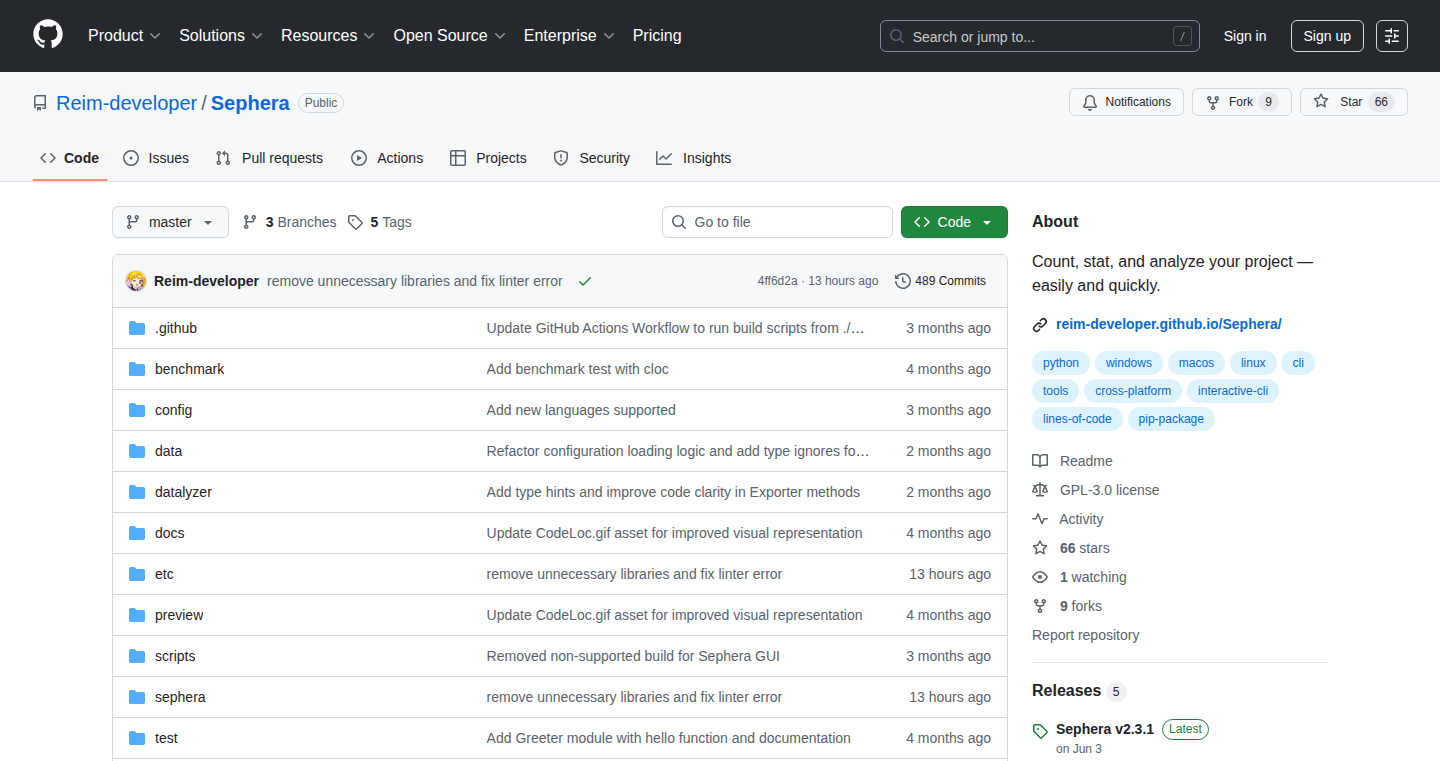
Author
reimisdev
Description
CodeSight is a command-line tool that analyzes your codebase to provide insights into lines of code (LOC) distribution, identifying areas of potential complexity and helping developers understand the size and structure of their projects. The project focuses on offering a simple, fast, and easily integrable solution for quick code analysis, moving away from cumbersome, full-featured code analysis tools.
Popularity
Points 2
Comments 0
What is this product?
CodeSight is essentially a digital 'yardstick' for your code. It examines your project and tells you how many lines of code are in each file and folder. The innovation lies in its simplicity and speed. Unlike heavyweight tools that perform extensive analysis, CodeSight quickly gives you a high-level overview, helping you spot areas where your code might be getting too large or complex. The core of this tool involves parsing the file system structure, reading code files, and using simple counting algorithms to calculate the total number of lines. So this allows for quick insights and fast integration.
How to use it?
Developers can integrate CodeSight into their existing build pipelines or use it locally to analyze their projects. You would typically run it in your project's root directory, and it generates a report showing the LOC distribution. For example, you can add it as a pre-commit hook to track changes in code size or use it as part of your CI/CD pipeline to monitor project growth over time. So, this makes it very easy to keep track of the codebase.
Product Core Function
· LOC Counting: This function counts the number of lines of code in each file and directory. This allows developers to quickly identify large files or complex modules, which can be indicators of potential issues or areas needing refactoring. So, this helps in identifying the most code-heavy areas.
· Report Generation: CodeSight generates a simple report summarizing the LOC distribution. This allows developers to easily visualize the structure of the project and identify trends in code growth. So, the generation of the report helps quickly get an overview.
· Command-Line Interface: It offers a command-line interface for easy integration into existing workflows and build systems. This allows for seamless integration into build processes, CI/CD pipelines, and other automated tasks. So, this increases its flexibility and versatility.
· Fast Analysis: It is designed for speed, processing large codebases quickly. This allows for rapid feedback during development, reducing the time spent waiting for analysis results. So, this speeds up your workflow.
Product Usage Case
· Identifying Code Bloat: A developer working on a large project uses CodeSight to discover a single file that contains a disproportionate number of lines of code. Upon investigation, they find that the file is a complex, hard-to-maintain module. They then refactor the code, breaking it down into smaller, more manageable components. So, this allows the developer to keep a clean codebase.
· Tracking Project Growth: A team integrates CodeSight into their continuous integration (CI) pipeline. Every time a code change is committed, CodeSight runs and reports the LOC changes. The team uses this information to monitor project growth over time and to identify when the codebase is becoming unwieldy. So, this helps the team keep track of its code size.
· Refactoring Decisions: A developer uses CodeSight to analyze a project before a refactoring task. The tool reveals a few large, complex files. The developer can then focus their refactoring efforts on these files, prioritizing improvements where they will have the greatest impact. So, this helps to optimize the refactoring work.
52
FractalGen: Browser-Based Fractal Generator

Author
keithlfrost
Description
FractalGen is a JavaScript-based tool that generates colorful fractals directly in your web browser. The core innovation lies in its ability to quickly render complex mathematical patterns, like fractals, without needing heavy-duty software or external processing. This project tackles the challenge of bringing computationally intensive graphics to the web in a user-friendly and accessible way.
Popularity
Points 2
Comments 0
What is this product?
FractalGen is a JavaScript library. It takes the complex math behind fractals and translates it into visual patterns that your browser can draw. Instead of using a powerful computer program, it runs the calculations within your web browser. So what? This means anyone with a modern web browser can explore these beautiful, intricate geometric shapes. This is a great example of 'doing more with less' by leveraging the power of modern web technologies.
How to use it?
You, as a developer, can integrate FractalGen into your web projects to add dynamic visual elements. You can use it to create interactive backgrounds, generate unique art pieces, or even explore mathematical concepts visually. To use it, you would likely include the JavaScript code in your HTML file and then use the library's functions to specify parameters for fractal generation, such as color schemes and the complexity of the fractal. For example, if you want to dynamically generate a background image based on user input.
Product Core Function
· Fractal Rendering: The primary function is to take mathematical formulas that define fractals and turn them into visual images. It does this by calculating the color values for each pixel, based on the formula, and then drawing the pixel on the screen. So what? This allows developers to easily create visually striking and computationally complex images directly on a webpage, making it ideal for website backgrounds, interactive art, or educational demonstrations.
· Parameter Customization: The generator allows for the adjustment of parameters like color palettes, fractal type (e.g., Mandelbrot set, Julia set), and the number of iterations to refine detail. So what? This flexibility lets developers and users explore a wide range of fractal patterns, allowing for personalized art creation, and enabling deep exploration of the underlying mathematical concepts.
Product Usage Case
· Website Backgrounds: Integrate fractal generation into a website's background, creating an visually engaging and dynamic user experience. The fractals can change over time or in response to user actions. So what? This will enhance the aesthetics of a website, setting it apart and attracting the user's attention.
· Interactive Art: Develop a web application where users can manipulate the fractal parameters in real time, changing colors, complexity, and other properties. So what? This would provide an interactive and creative experience for users, allowing them to explore the beauty of fractals and learn more about their mathematical foundations.
· Educational Tool: Create a web-based tool for teaching math concepts, particularly those related to complex numbers and iterative processes. The visual representation of fractals can make these abstract ideas more accessible. So what? This will make complex topics easier to understand by allowing the users to see the fractal generation process step-by-step and interactively.
53
Assignix: AI-Powered Workforce Optimization
Author
AriyanHacker
Description
Assignix is a B2B SaaS platform designed to improve workforce efficiency and reduce employee burnout by intelligently matching employees to tasks using artificial intelligence. It analyzes employee resumes, extracts relevant information to build profiles, and leverages OpenAI's GPT-5 to recommend the best-suited individuals for specific assignments. This approach aims to solve the problem of time-consuming manual task assignment and optimize resource allocation, leading to better project outcomes and improved employee satisfaction.
Popularity
Points 1
Comments 1
What is this product?
Assignix works by first analyzing employee resumes to create detailed profiles. It extracts key skills, experience, and other relevant information. When a task needs to be assigned, users can specify the requirements and availability of employees. The platform then uses OpenAI's GPT-5, a powerful AI model, to analyze the task requirements and employee profiles, recommending the best candidates. It also includes a Kanban board for visualizing workflow and progress, and integrates additional company-specific information for more tailored assignments. This innovation lies in automating the skill-matching process, using AI to go beyond simple keyword matching and provide nuanced recommendations. So, what's in it for you? It saves time and reduces the guesswork involved in assigning tasks, which can improve productivity and reduce burnout.
How to use it?
Developers can integrate Assignix into their existing workflows by using its API (though not explicitly mentioned in the text). The system can be used in project management, HR, and team collaboration tools. You can feed in your employee data, define task requirements, and then use the Assignix API to get recommendations. This helps automate task assignments and ensures the right people are working on the right projects. Specifically, you would feed the system employee resumes or profiles, and task requirements. The Assignix platform then returns suggested employees. For example, imagine using it as a plugin for your project management software; when you create a task, the plugin automatically suggests the best employees for that task.
Product Core Function
· Resume Analysis and Profile Creation: The system parses employee resumes, extracting skills and experiences to build detailed profiles. This is done to structure and organize data for matching and recommendation. This allows Assignix to build a database of employee capabilities for effective task assignment. So, what's in it for you? It eliminates the need for manually reviewing resumes and keeps employee skills information up-to-date.
· AI-Powered Task Assignment: Leveraging OpenAI's GPT-5, the platform intelligently matches employees to tasks based on their skills and experience. This AI-driven matching provides more accurate and efficient recommendations compared to traditional manual methods or keyword-based searches. So, what's in it for you? It ensures the right people are assigned to the right tasks, improving project success rates and employee satisfaction.
· Kanban Board for Visualization: A Kanban board provides a visual representation of the current workload and progress. This tool improves team transparency, workflow management and allows to get a quick view of task status and progress. So, what's in it for you? It enhances team collaboration and makes it easier to track and manage projects.
· Company-Specific Information Integration: The tool uses additional information about the company to give a more tailored task assignment, suggesting the best team members to a specific project. This allows Assignix to refine its recommendations by considering factors specific to a company's needs and priorities. So, what's in it for you? It increases the relevance and effectiveness of task assignments.
Product Usage Case
· Project Management: A project manager can use Assignix to automatically assign tasks to team members based on their skills and availability. By specifying project requirements, Assignix can suggest the best candidates, saving the project manager time and improving project efficiency. This would address the common problem of skill matching. So, what's in it for you? Reduced project delays, better use of team resources, and improved project outcomes.
· HR and Talent Management: HR departments can use Assignix to identify employees with specific skills for new projects or training opportunities. The platform can provide valuable insights into the skillsets within the organization, helping with talent development and resource allocation. So, what's in it for you? Better resource utilization, streamlined hiring processes, and improved employee development.
· Team Collaboration: In a fast-paced startup environment, teams can leverage Assignix to quickly assign tasks to available team members. Assignix's recommendations can help to prevent the overload of team members while accelerating project completion. So, what's in it for you? Improved project turn-around, reduced employee burnout, and increased overall productivity.
54
ValueGrowAGarden - Real-time Trade Value Tracker for Roblox "Grow a Garden"
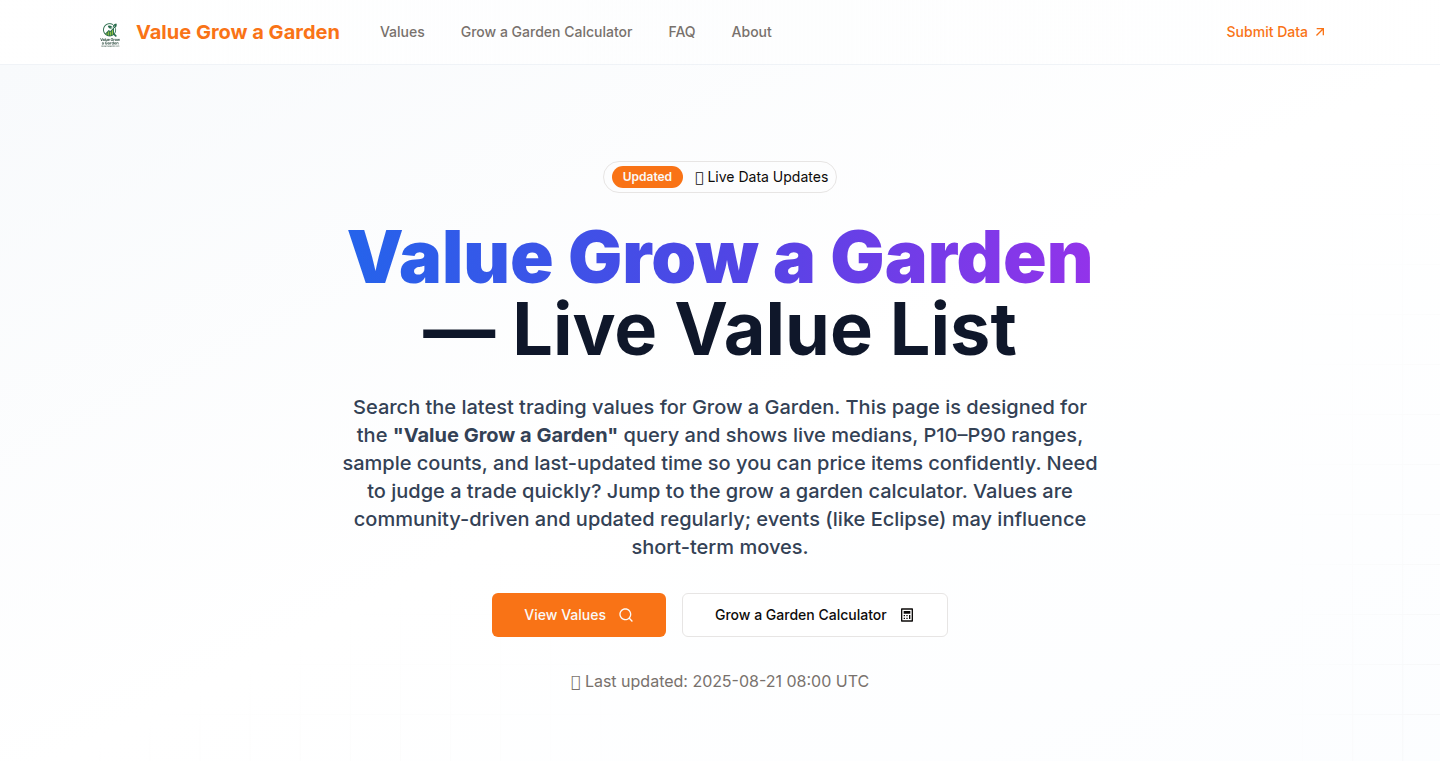
Author
virusyu
Description
ValueGrowAGarden is a real-time value tracking tool for items traded within the Roblox game "Grow a Garden." It addresses the problem of quickly changing item values during events and updates by providing live price lists, trade verification, and transparent data sources. The innovation lies in its ability to collect community-submitted data, filter out anomalies, and calculate robust statistics like median values and confidence ranges (P10-P90), offering players a data-driven approach to trading. So this gives players an edge in the trading game, preventing them from getting ripped off.
Popularity
Points 1
Comments 0
What is this product?
ValueGrowAGarden is a website that helps players in the Roblox game "Grow a Garden" understand the real-time value of items they trade. It does this by gathering data from trades reported by the community and public sources. It cleans the data to remove bad information, and then calculates a median value (the middle price) and a range (P10-P90) to show how reliable the value is. This helps players make informed decisions about their trades. So this provides players with reliable, up-to-date market information for their in-game trades.
How to use it?
Players can access ValueGrowAGarden through their web browser. They can look up the value of items to see the current prices and the range of acceptable values. They can also use the "Win/Fair/Lose" checker to quickly evaluate trade offers. Players can also submit their trade data to help improve the accuracy of the values. So this is a website anyone can use to make better trades in the game.
Product Core Function
· Live Value Lists: Provides real-time values for pets and crops, showing the median value and a confidence range (P10-P90). This allows players to see the current market price of an item. So this is useful for quickly determining an item's worth, even when the market is changing.
· Trade Checker: Offers a "Win/Fair/Lose" checker that allows players to quickly evaluate the fairness of a trade in seconds. This helps to prevent players from making bad deals. So this is useful for quickly checking a trade to ensure a fair outcome.
· Data Transparency: Has a transparent methodology page which explains how the values are calculated and a form for users to submit recent trades. This increases user trust. So this is useful for verifying that the information provided is trustworthy.
· Data Cleaning: Filters out outliers and potential manipulation from the trade data submitted. This means the results are more accurate and less likely to be influenced by bad actors. So this is useful because you can rely on more accurate price data.
Product Usage Case
· During a game event: A player wants to trade a rare pet, but prices are volatile. They check ValueGrowAGarden to get the current median value and range. This helps the player to avoid overpaying or underpricing the pet. So this allows players to capitalize on market volatility.
· Evaluating a trade offer: A player receives a trade offer for an item. Using ValueGrowAGarden's trade checker, the player can quickly determine if the trade is a fair exchange. So this helps a player avoid scams.
· Community Feedback: Players can submit their recent trade data through the form. This data helps refine the pricing, and ensures that the values are as current as possible. So this is useful as it builds trust and helps improve accuracy by letting users contribute.
55
ShiftPlus: macOS Workflow Orchestrator
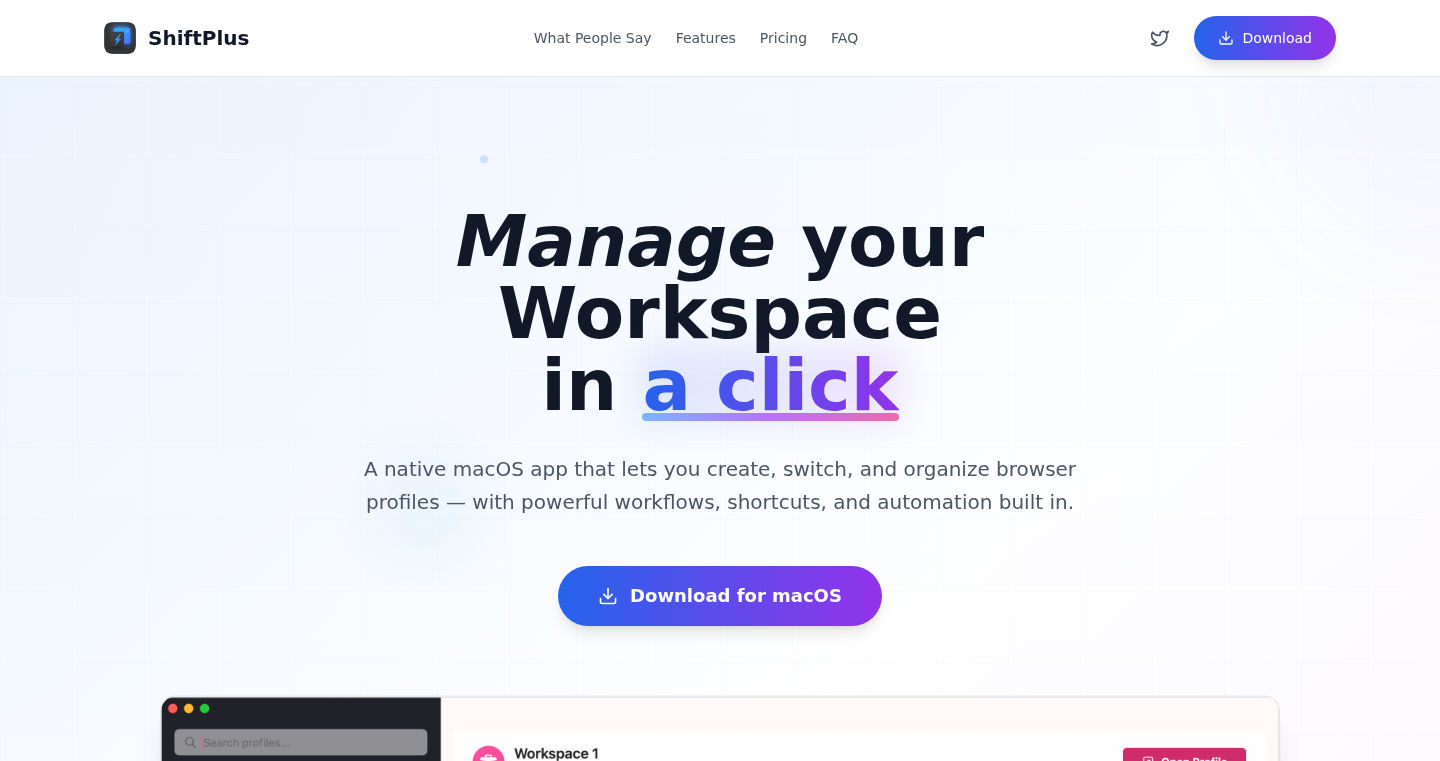
Author
nghialuong
Description
ShiftPlus is a macOS application designed to streamline workflows by managing multiple browser profiles and window layouts. It tackles the common problem of context switching between different projects (work, personal, side projects) by providing a fast and intuitive way to switch between various browser profiles (Chrome, Safari, Arc, Brave, Edge, Opera, Vivaldi) and instantly arrange windows as needed. The key innovation lies in its ability to associate specific window layouts with different profiles, significantly improving productivity and reducing time spent on manual setup. So, it helps you focus on the actual work instead of fiddling with your digital workspace.
Popularity
Points 1
Comments 0
What is this product?
ShiftPlus is like a digital Swiss Army knife for managing your digital workspace on macOS. It allows users to create and switch between different browser profiles effortlessly, each with its own specific settings and browsing history. Beyond that, it offers window arrangement presets, letting you define exactly where your apps open and how they're organized. This is built upon the core idea of associating specific application configurations (browser profiles, window positions) with easily accessible 'workspaces', managed by customizable hotkeys and a clean UI. So, it allows you to quickly jump between tasks without losing your focus.
How to use it?
Developers and power users can use ShiftPlus to create different profiles for various projects or tasks. For example, a developer can have one profile for work (with all the necessary development tools and browser extensions) and another for personal use. The application also allows the user to define window layouts (like where the code editor, browser, and terminal are located), and automatically load these layouts when switching to a profile. Integrating ShiftPlus is easy; simply download the application, configure your browser profiles and window layouts, and then use the global hotkeys to switch between them seamlessly. So, you can quickly set up your ideal workspace for any task.
Product Core Function
· Multiple Browser Profile Management: Allows users to manage separate browser profiles for different projects (work, personal, etc.). This is crucial for maintaining privacy, security, and organization. So, you can keep your work and personal browsing separate, preventing distractions and improving focus.
· Customizable Icons, Colors, and Labels: Provides the ability to personalize profiles with custom icons, colors, and labels for quick identification. This improves visual cues and reduces the time needed to locate the desired profile. So, you can visually distinguish between your different work contexts quickly.
· Global Hotkeys and Quick Switching: Enables users to switch between profiles and window arrangements using global hotkeys, enhancing the speed and efficiency of workflow transitions. This dramatically reduces context-switching overhead. So, you can switch between tasks with a single key press, saving you valuable time.
· Window Arrangement Presets: Offers the ability to save and load window arrangements, ensuring applications open in the exact position and size the user prefers. This eliminates the need for manual window adjustments, thereby saving time. So, it ensures your apps are always where you want them, every time you switch.
· Import/Export Profiles: Provides functionality to import and export profiles, making it easy to replicate setups across multiple machines or share configurations with colleagues. This improves collaborative workflows and team productivity. So, it allows you to easily back up and share your workflow setup.
Product Usage Case
· Web Developers: A web developer can have one profile for coding with the necessary dev tools, and another for testing websites with a different set of extensions. ShiftPlus helps them quickly switch between these contexts without having to manually open and arrange windows every time. So, you can jump between coding and testing environments effortlessly.
· Freelancers Managing Multiple Clients: Freelancers juggling multiple clients can create separate profiles for each client, keeping their projects isolated and organized. Window arrangement presets can also ensure that the necessary applications and documents are opened and arranged appropriately for each client’s work. So, you can stay organized when working on multiple projects simultaneously.
· Researchers and Academics: Researchers can use ShiftPlus to manage different research projects, each with dedicated browser profiles and window layouts for accessing research materials, notes, and relevant applications. So, you can organize your research resources more efficiently.
· Productivity Enthusiasts: Individuals who use a variety of apps and tools for different tasks can utilize ShiftPlus to design specific workspace layouts and rapidly switch between them, optimizing their daily workflow and productivity. So, it helps you create a distraction-free workspace customized to your needs.
56
Zen Lake: High-Precision π Computation on Standard Hardware
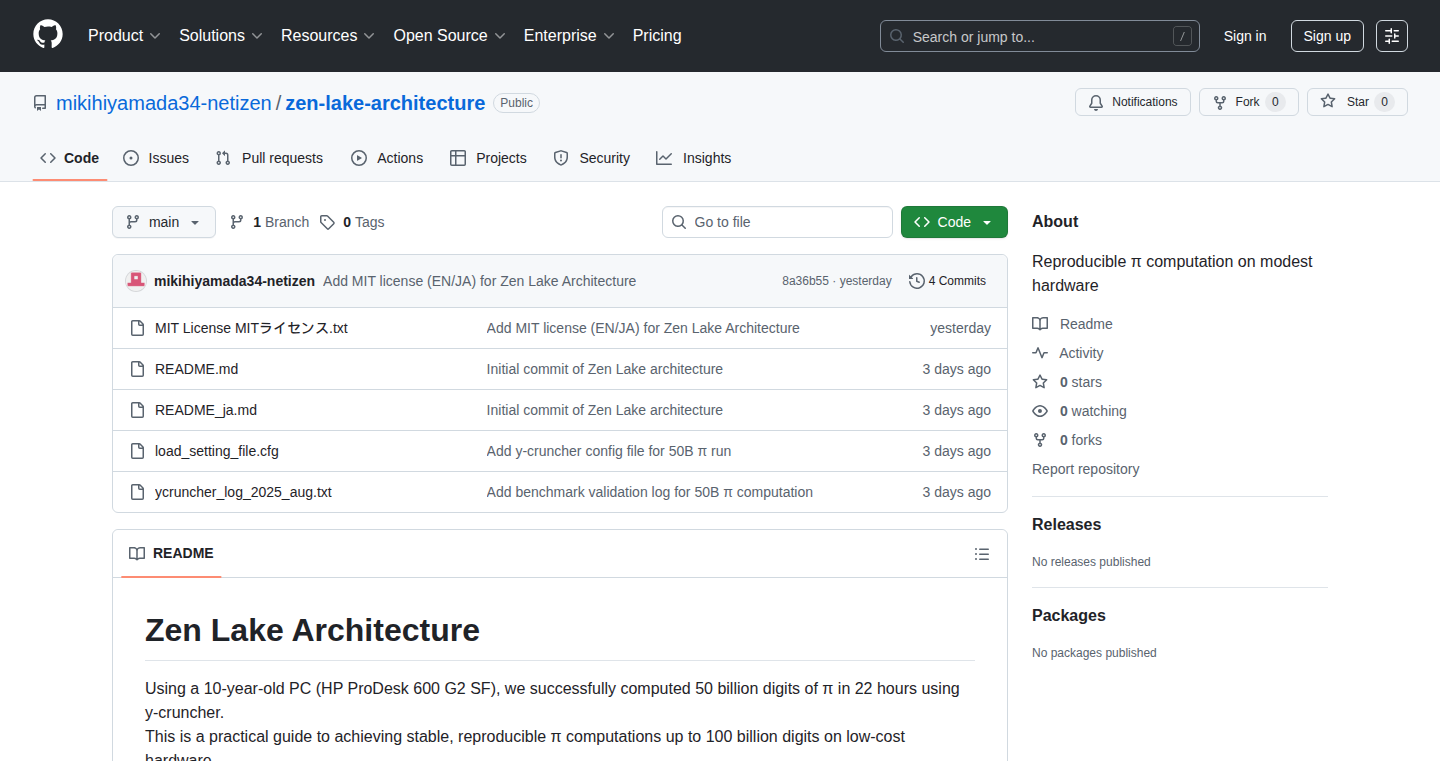
Author
mikihiyamada34
Description
Zen Lake is a project that calculated 50 billion digits of π (pi) using a regular 10-year-old personal computer. The innovation lies in its 'Zen Lake Architecture,' a carefully designed setup that ensures stability and reproducibility during massive computations. It isolates the swap space (temporary storage), program files, and output, preventing common errors that can occur during long calculations. This allows researchers and students to perform extremely precise calculations without needing expensive, specialized equipment. So, this makes it possible to do incredibly complex mathematical calculations on ordinary computers.
Popularity
Points 1
Comments 0
What is this product?
Zen Lake is a system designed to compute a massive number of digits of π. The key innovation is the Zen Lake Architecture which creates a stable environment for these long computations by carefully managing computer resources like memory and storage. This setup is reproducible, meaning others can replicate the results and verify the calculations. So, this lets anyone explore incredibly large calculations that were previously only possible with supercomputers.
How to use it?
Developers don't directly 'use' Zen Lake as a software library. Instead, the project provides a recipe for setting up a computational environment. The developer provides the architecture and the method. You can follow the instructions in the repository to replicate the computations on your own hardware, allowing you to run similar complex calculations. This can be useful for research, education, or simply exploring computational limits. So, this helps developers understand how to build reliable, reproducible systems for demanding computational tasks.
Product Core Function
· High-Precision π Calculation: The core function is calculating a vast number of digits of π. The technical implementation uses specialized algorithms. This is valuable for mathematical research, verifying computational models, and demonstrating the limits of hardware. So, this provides a practical demonstration of advanced calculation techniques.
· Reproducible Environment: The project's emphasis on reproducibility ensures that the calculations can be verified by others. The Zen Lake Architecture setup makes the computation consistent. This is important for ensuring the accuracy of results and building trust in the findings. So, this helps to validate and verify complex computational results.
· Resource Management (Swap, Binaries, Output Isolation): Zen Lake's careful management of swap space, program files, and output prevents common errors. It guarantees the stability during long computational runs. So, this provides a practical example of how to build reliable systems for computationally intensive tasks.
Product Usage Case
· Mathematical Research: Researchers can use the project's methodology to verify existing π calculations or explore other constants to an unprecedented degree of precision. It helps to test mathematical theories and computational algorithms. So, this enables more precise scientific research.
· Educational Purposes: Students and educators can use the project as a learning resource to understand high-precision computations, system architecture, and resource management techniques. It can be a valuable tool for teaching computer science concepts. So, this provides a hands-on learning experience in advanced topics.
· Benchmarking and Performance Evaluation: The project provides benchmarks of computation speed and resource usage on different hardware configurations. This can be used to evaluate hardware performance and optimize computational processes. So, this helps to analyze and improve the performance of computer systems.
57
CompCalc: Startup Compensation Optimizer
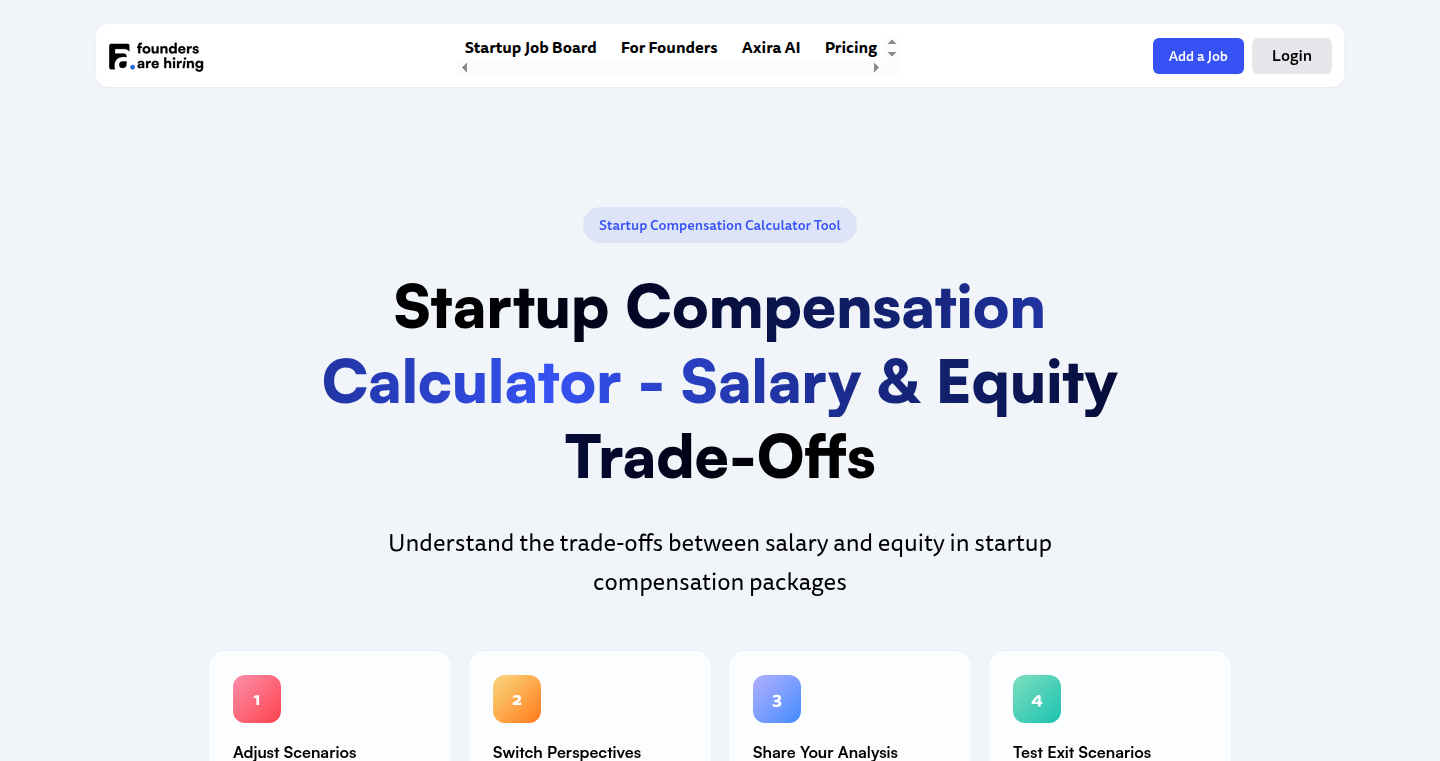
Author
niksmac
Description
CompCalc is a web-based tool designed to help startups and their employees negotiate and understand compensation packages. It focuses on breaking down complex equity and salary models to provide clear, comparable financial data. The innovative aspect lies in its user-friendly interface that translates complicated financial jargon into actionable insights, helping both founders and employees make informed decisions regarding their financial future within the company. It tackles the problem of opaque compensation structures common in early-stage startups.
Popularity
Points 1
Comments 0
What is this product?
CompCalc helps users understand the value of their compensation, especially in startups where equity plays a significant role. It simplifies the complex formulas used to calculate the worth of stock options and other equity-based incentives, providing a clear picture of potential future value. The core innovation is its accessible interface, offering a streamlined way to input data and receive easy-to-understand projections, making complex financial models transparent. So this helps me understand my startup's compensation better.
How to use it?
Users can input details such as salary, stock options, vesting schedules, and valuation data. The tool then calculates and displays various scenarios, including potential returns based on different growth rates and exit strategies. Developers can integrate CompCalc into their HR systems or use it as a standalone tool for compensation planning. This can also be used as a reference point when negotiating compensation. So I can use this to quickly calculate my startup's compensation package.
Product Core Function
· Equity Valuation Calculation: This function takes inputs like the number of stock options, strike price, and company valuation, and then calculates the potential value of the equity based on different exit scenarios. It uses complex financial models to estimate the worth of stock options, providing users with a concrete financial figure. So I can figure out the actual value of my equity.
· Salary Comparison: CompCalc helps users compare salaries, factoring in benefits, cost of living, and other compensation components. It provides a standardized view to assess the true worth of each offer. So I can use this to compare different job offers.
· Vesting Schedule Analysis: The tool visualizes vesting schedules (the time frame in which employees earn their stock options) to illustrate when employees become fully vested and what the value of their equity will be at different points. This helps users understand the long-term financial incentives. So I can understand my stock options' vesting schedule and its impact.
· Scenario Planning: Users can create different growth scenarios and estimate their financial outcomes based on various potential company valuations and exit strategies. So I can predict future compensation based on different scenarios.
Product Usage Case
· Startup Negotiation: Founders use CompCalc to create transparent compensation packages for prospective employees, making it easier to attract talent. For example, a founder can use the tool to demonstrate how the value of stock options could change over time. So I can be more effective in negotiating with potential employees.
· Employee Planning: Employees use the tool to analyze their compensation packages, understand the value of their equity, and make informed decisions about their employment. For example, a software engineer can use the tool to evaluate different job offers and compare them based on overall compensation. So I can make better career decisions.
· HR Management: HR teams use CompCalc to build consistent and fair compensation models across the company, promoting internal equity and minimizing potential conflicts. For example, a HR team can use the tool to create a standardized compensation structure based on role and experience. So HR teams can save time and manage compensation better.
58
Offline Photo Curator: LLM-Powered Desktop Photo Organizer
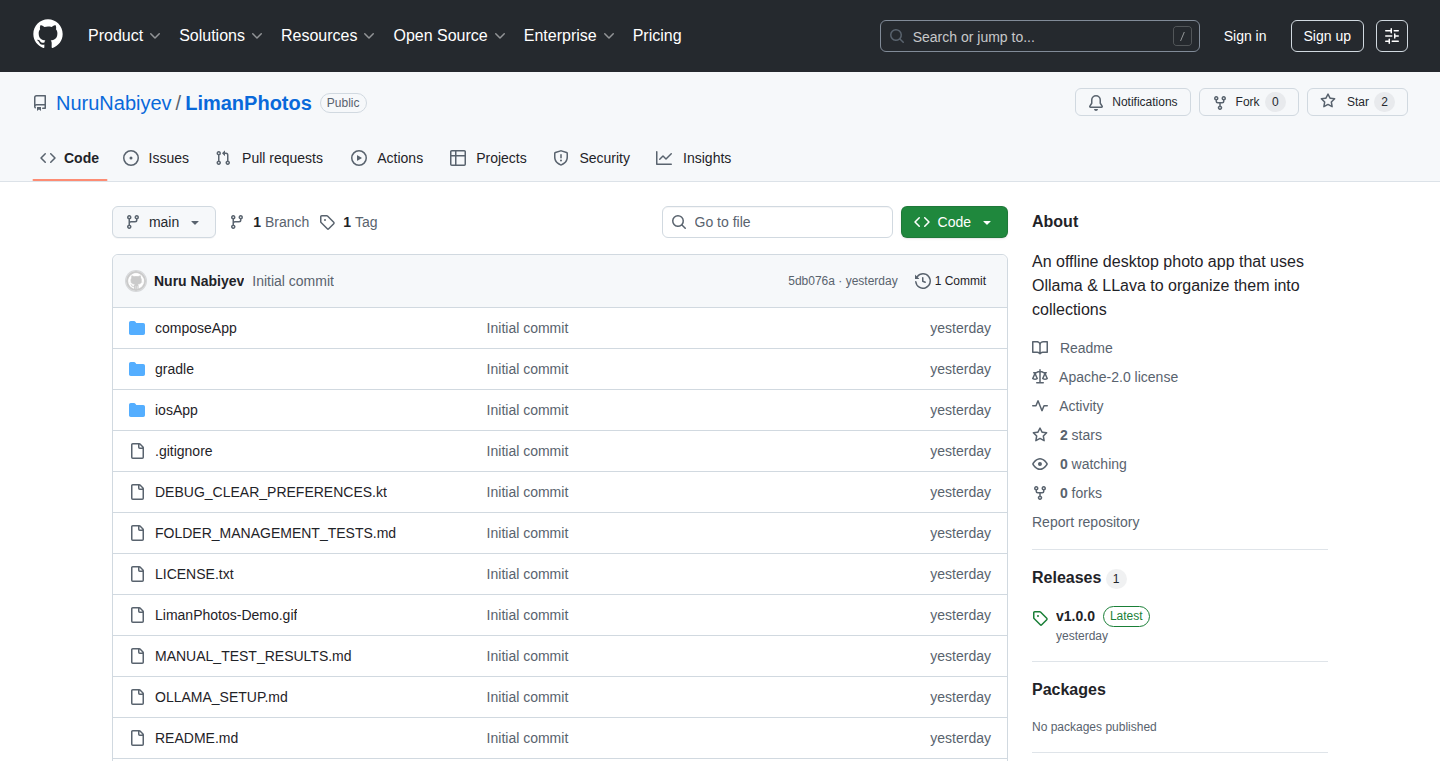
Author
limandoc
Description
This project is a desktop application that helps you organize your photos using the power of a large language model (LLM) running locally on your computer. It's like having a smart librarian for your photos, automatically tagging them based on their content. The core innovation lies in using an LLM offline, meaning it doesn't rely on an internet connection, which protects your privacy and gives you control over your data.
Popularity
Points 1
Comments 0
What is this product?
This is a desktop application built with Kotlin Multiplatform that uses an offline LLM (like Ollama/Llava) to analyze your photos and automatically tag them with relevant keywords. Instead of manually tagging thousands of photos, this application intelligently identifies the content within each image and creates searchable collections. The key innovation is the use of a local LLM, providing offline functionality and protecting your privacy.
How to use it?
Developers can use this app by downloading the source code from GitHub, opening it in IntelliJ IDEA, and running it. The app then analyzes your photo library and generates tags based on the image content. This can be integrated into other projects to automate photo organization, improve search capabilities in photo management systems, and build customized photo analysis tools. So, you can quickly find the pictures you need without spending hours manually tagging them.
Product Core Function
· Offline Photo Tagging: The app uses a local LLM to analyze photos and generate descriptive tags. This allows users to search and categorize photos based on their content without needing an internet connection. This means your photos are analyzed privately on your own machine, safeguarding your personal data. It solves the problem of manually organizing a large photo library.
· Cross-Platform Compatibility: Built with Kotlin Multiplatform, the application works on Windows, macOS, and Linux. This ensures accessibility for a broad range of users and eliminates platform-specific dependencies. So, you can use the application regardless of the operating system your computer uses.
· Automated Collection Creation: Based on the tags generated, the app automatically groups photos into relevant collections. This streamlined organization simplifies browsing and finding specific photos. This enables effortless browsing through thousands of images.
· Potential for Face Recognition: The developer plans to add face recognition in future versions. This feature would allow the app to identify and tag photos based on the people in them, making it even easier to find specific people in your photos. Therefore, the application gets more useful as it evolves, adding increasingly intelligent image recognition.
Product Usage Case
· Personal Photo Archive Management: A user with a large photo collection can use the application to automatically tag and organize their photos, making it easy to search for specific events or people. So, it saves time and effort compared to manual tagging.
· Local Photo Search Enhancement: Integrating the photo tagging functionality into a local photo management system can significantly improve search accuracy. You can quickly find photos based on keywords generated by the LLM. It is useful for anyone who wants to efficiently search their local photo libraries.
· Building a Privacy-Focused Photo Management System: Developers could use the project's foundation to build a completely offline and privacy-focused photo management tool, giving users full control over their photo data. It is a good option for users who value data privacy and security.
· Offline Content Analysis: Researchers can adapt the application to analyze images for various research purposes, where data privacy and offline processing are critical. It gives researchers the ability to analyze data without sending it to the cloud, which guarantees data integrity.
59
AgentActions: AI-Powered Website Command Center
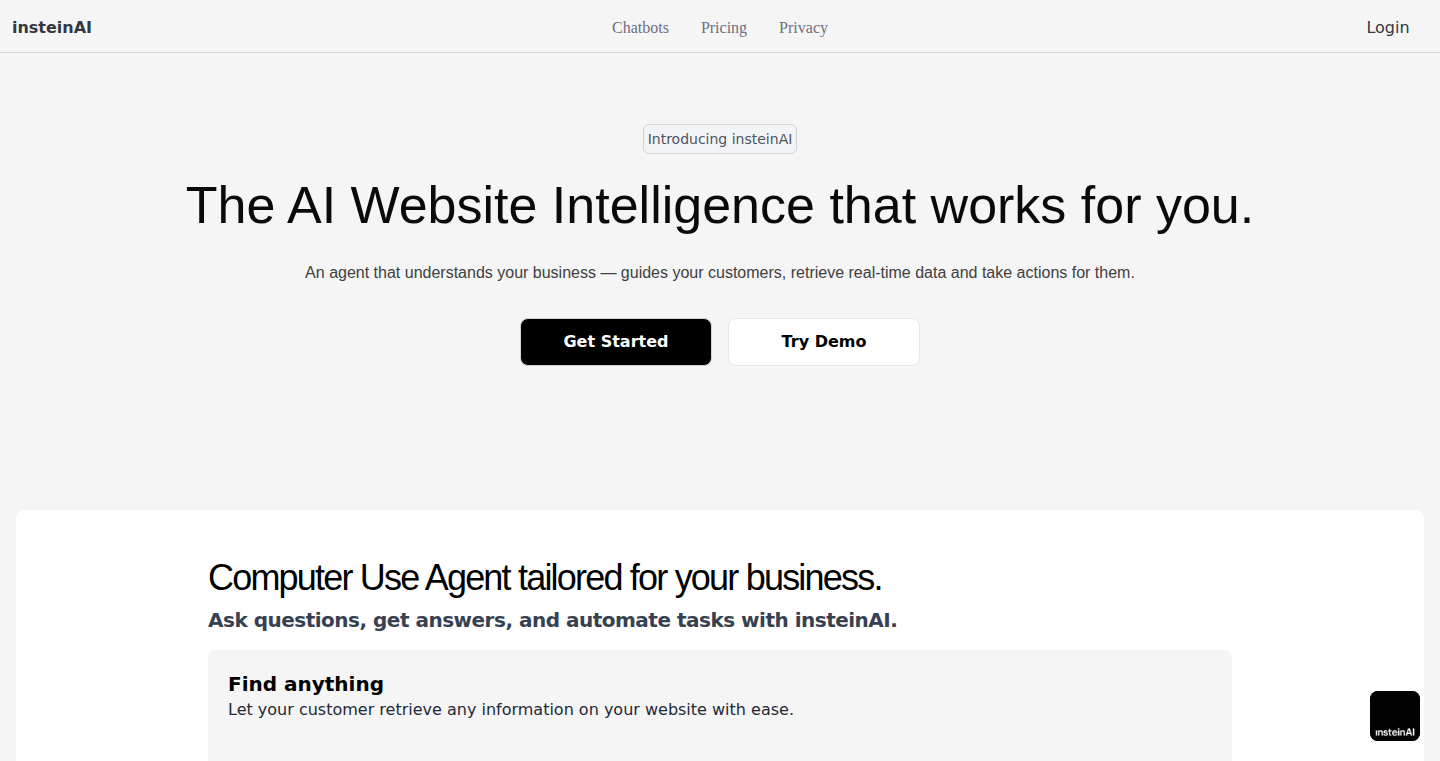
Author
Dhavidh
Description
AgentActions is a tool that lets you add AI-powered actions directly to your website, using a smart AI agent (powered by ChatGPT and Anthropic) to understand your requests and perform tasks in real-time. This is like having a virtual assistant that can not only answer questions but also take actions on your website, like updating content or triggering features, all based on natural language commands. It solves the problem of needing to manually interact with a website for data retrieval and task execution.
Popularity
Points 1
Comments 0
What is this product?
AgentActions uses a combination of powerful AI models (like ChatGPT and Anthropic's models) and a special ‘agent operator’ to understand what you want to do on your website. You type a command in plain English, and the agent figures out how to execute it. It can fetch data, update your site, or start certain functions. The innovation is in creating an intelligent interface that allows users to directly interact with and control website functionalities without needing to code or navigate complex interfaces. So what's the point? It's all about making your website dynamic and user-friendly - now users can easily act on your site, instead of just passively viewing it.
How to use it?
Developers can integrate AgentActions into their websites to enable advanced AI functionalities. You'll need to add the necessary code (likely an API or SDK) to your site. Then, you can define the actions the AI agent can perform. Users interact with the AI agent through natural language input, asking for data or requesting actions. You can create custom commands, connect it to your site's database or backend, and make your site smarter and more responsive. For example, let's say you're a data provider, your users can ask 'Get me the latest sales numbers for Q1' and the AI agent would query your database and show the results on their browser. So, it streamlines user experience with natural language interaction.
Product Core Function
· Real-time data retrieval: The core function lets you retrieve data from the website by asking the agent natural language questions. The agent understands your queries and fetches the required data. This enhances user engagement and provides up-to-date information in an easy to understand format. So, it helps your users get the information they want quickly.
· Direct action execution: The agent can execute direct actions on the website such as updating content, triggering various features. For instance, a user can ask it to change a specific product's price. This transforms a website into a dynamic environment. So, it allows users to perform operations directly on the site, enhancing interactivity.
· Natural language processing (NLP): The system employs advanced NLP techniques to interpret human language commands accurately. This means users can interact with the website naturally. So, you don't need to learn special commands or complicated interfaces, just chat with the system.
Product Usage Case
· E-commerce: A user asks 'Update the price of product X to $Y'. The AI agent updates the product's price in the database in real-time. So, business owners save time and improve efficiency in managing inventory and pricing changes.
· Customer support: A user types 'Find my order number ABC123'. The AI agent interacts with the website's backend to retrieve order details. So, it offers instant customer support, reducing the workload on support staff and improving customer satisfaction.
· Content Management: A user asks 'Change the headline of the article on page X'. The AI agent updates the content on the website immediately. So, website administrators can update content very efficiently.
60
PDJsonEditor: Interactive JSON Editor with Code-Graph Sync and API Integration
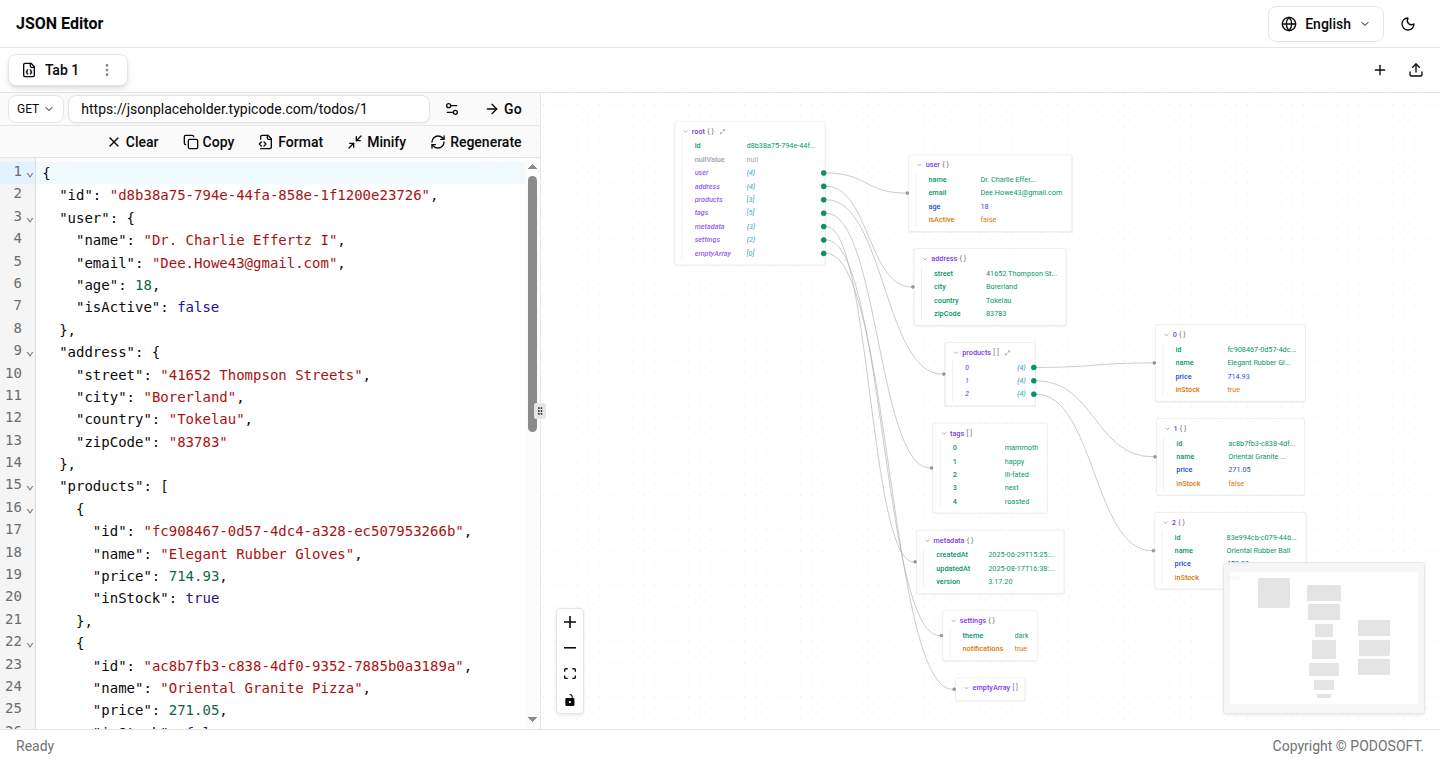
Author
korone
Description
PDJsonEditor is an open-source JSON editor designed to streamline the process of working with JSON data. It features a unique code-graph synchronization, allowing users to visualize JSON structures interactively, with changes in the code immediately reflected in the graph view and vice versa. This eliminates the need for constant context-switching between editors and viewers. It also incorporates API integration, allowing users to fetch, edit, and manipulate JSON data directly from APIs. This is a huge time saver for developers, particularly when debugging complex JSON structures or working with API responses. So this helps you visually understand and interact with complex JSON data more efficiently.
Popularity
Points 1
Comments 0
What is this product?
PDJsonEditor is a web-based tool that offers a dual view of JSON data: a code editor and an interactive graph representation. When you click a node in the graph, the code editor jumps to the corresponding section. The editor supports multi-tab editing with autosave, import/export of JSON files. It also includes API client capabilities, allowing you to fetch JSON from APIs directly using GET, POST, PUT, PATCH, and DELETE methods, with support for headers and body customization. Internally, the project leverages Svelte and SvelteKit for the frontend, `@xyflow/svelte` for the interactive graph, Dagre for layout and TypeScript. This means it’s a modern web application, well-suited to handle the complexities of JSON manipulation. So, this means it gives you a visual way to understand your JSON and integrates well with APIs.
How to use it?
You can use PDJsonEditor by simply accessing it through a web browser as it runs entirely in your browser. You can copy and paste JSON data into the editor or load it from files. You can also connect it to APIs by providing the API endpoint and any necessary parameters. For example, a developer could input an API endpoint, add headers, and send a GET request. The response JSON would be fetched and displayed in the editor, with both the code and the graph views. Any changes you make in the code editor are immediately reflected in the graph and vice-versa. So this means you can visualize your JSON data and easily connect it with APIs.
Product Core Function
· Code-Graph Synchronization: The core feature is the simultaneous display of JSON data in both code and a visual graph. When you select a portion of code, the corresponding element highlights in the graph, and vice versa. This simplifies navigation in complex JSON structures and enhances understanding. So this helps you easily navigate and understand large JSON data.
· Multi-Tab Editing and Autosave: It features a tabbed interface for multiple JSON files with automatic saving of changes. This streamlines workflows by eliminating the need to manually save data frequently and allows editing of several JSON files simultaneously. So this makes it easy to manage and edit multiple JSON files.
· JSON Import/Export: Allows users to easily import JSON data from files or export the edited data into files. This facilitates the handling and sharing of JSON data across various systems. So this helps easily transfer JSON data.
· API Integration (Fetch Functionality): Enables users to fetch JSON data directly from APIs using common HTTP methods (GET, POST, PUT, PATCH, DELETE) with customizable headers and body. This is invaluable for debugging API responses or working with live data. So this helps test APIs and visualize their responses quickly.
· Collapsible Arrays and Quick Navigation: Allows users to collapse large arrays (“show more”) and quickly navigate deep structures, simplifying the process of locating specific elements within extensive JSON datasets. So this makes it easier to work with large JSON.
Product Usage Case
· API Debugging: A developer working on a web application can use PDJsonEditor to test and debug API responses. They can send requests to an API endpoint, view the response in both code and graph formats, and easily identify any issues or errors in the JSON data. So this helps you visually troubleshoot APIs.
· Configuration Management: Imagine a developer configuring a complex application using a JSON-based configuration file. PDJsonEditor lets them visualize the config, instantly see the impact of each change, and debug problems quickly. So this makes complex configurations easy to manage.
· Data Inspection: When receiving a complex JSON payload from a third-party API, a developer can use PDJsonEditor to visually inspect the structure of the JSON data, making it easier to understand and work with the data. So this is helpful for inspecting data.
· Frontend Development: A frontend developer can use PDJsonEditor to simulate API responses when developing a user interface. This allows them to test the UI with different JSON data structures and validate the component behavior. So this is great for frontend development.
61
XferLang: Human-Readable Data Transfer & Configuration Language
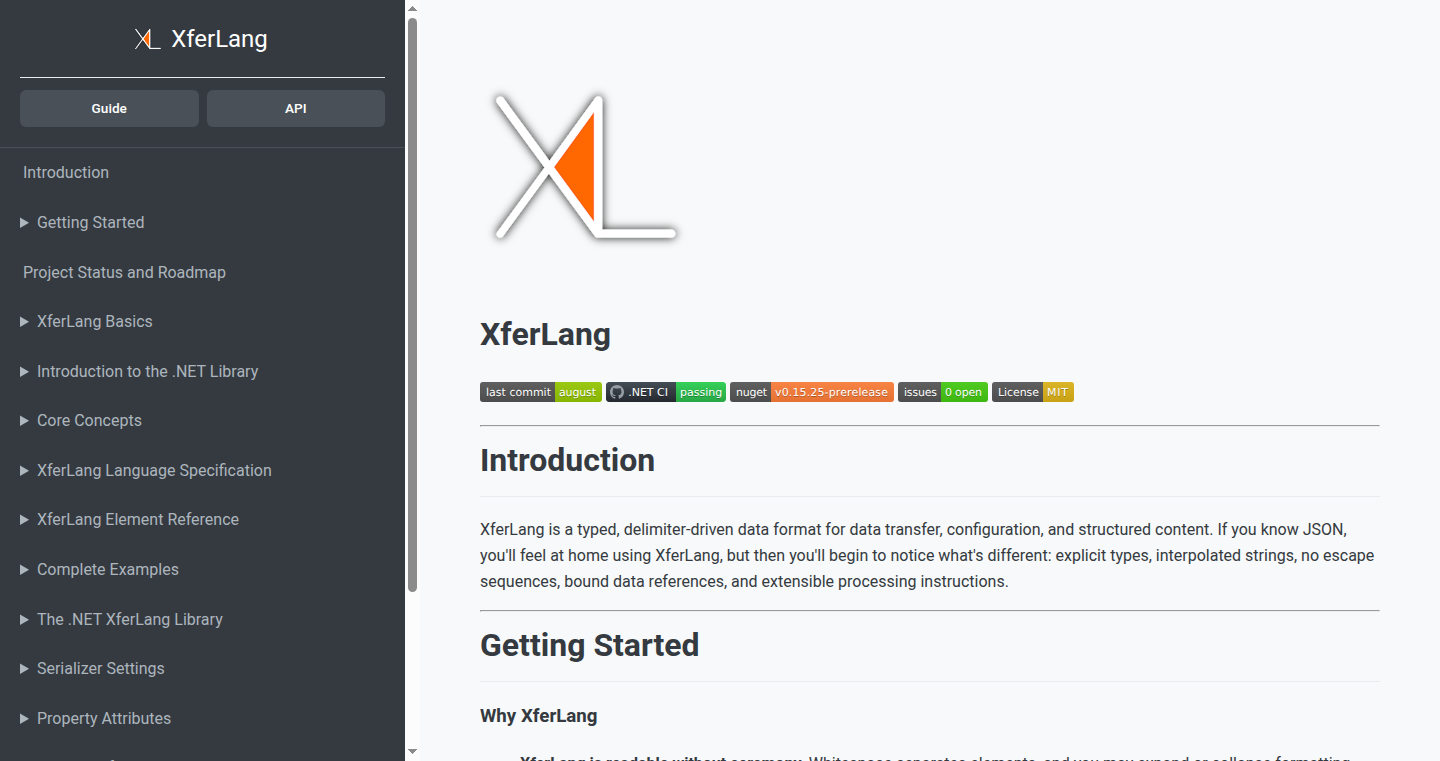
Author
paulmooreparks
Description
XferLang is a new language designed as an alternative to JSON and YAML for data transfer and configuration. It aims to be more human-readable and writable with features like strong typing, comments, processing instructions, and simplified text embedding. This addresses the common pain points of JSON/YAML: lack of comments, potential for data type errors, and the need for escaping characters. So this allows you to read and write data structures more easily.
Popularity
Points 1
Comments 0
What is this product?
XferLang is a structured text language. Think of it as a more user-friendly way to represent data compared to JSON or YAML. It supports comments (you can add notes), strict data types (like numbers and strings), processing instructions (allowing for future extensions), and easier text embedding (no need for backslashes for special characters). The core idea is to make data representation both machine-readable and human-understandable. So this is beneficial for anyone who works with configuration files or data serialization and wants a clearer, less error-prone way to do it.
How to use it?
Developers can use XferLang to replace JSON or YAML in their applications. It can be used for configuration files, data exchange between different systems, and even scripting. The language is currently implemented as a .NET 8.0 library. To use it, you would integrate the library into your project and then use XferLang syntax to define and parse your data. So you can use it anywhere you need to define structured data.
Product Core Function
· Strong Typing: XferLang enforces data types (like integer, string, boolean) which prevents unexpected errors when processing data. This reduces the risk of bugs by ensuring data integrity.
· Comments: Allows you to add explanatory notes directly within your data files, improving readability and maintainability. This is useful for documenting configurations and explaining data structures.
· Processing Instructions: Supports custom instructions to extend the language’s functionality. This allows for future features and customization.
· Simplified Text Embedding: Provides a cleaner way to embed text without needing special escape characters. This makes it easier to represent text data.
· Human-Readable Syntax: Designed to be easier to read and write than JSON or YAML, making it quicker to understand the data structures. This enhances developer productivity and code maintainability.
Product Usage Case
· Configuration Files: Use XferLang instead of JSON or YAML for application configuration files. The added comments and clear syntax make it easier to understand and modify these files. This simplifies system administration and reduces configuration errors.
· Data Exchange: Implement XferLang for data exchange between different parts of a system or between different applications. Strong typing ensures data consistency, and comments help in understanding the data format. This leads to reliable data transfer and integration.
· API Development: Use XferLang as the data format for an API, providing a more readable and maintainable alternative to JSON. The ease of understanding simplifies debugging and improves developer experience.
62
Bookxy - Smart Reading Habit Tracker
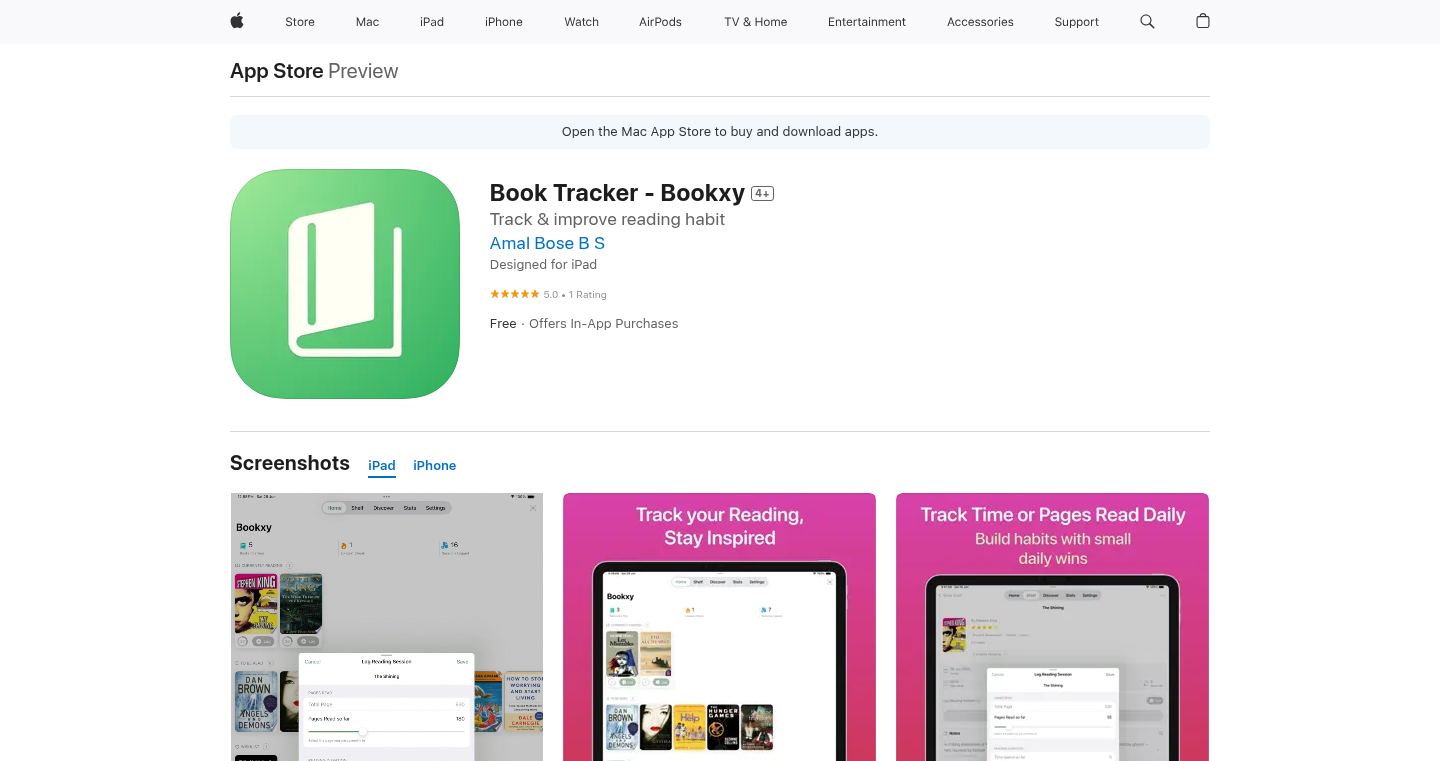
Author
axatrikx
Description
Bookxy is an iOS application designed to help users build and maintain consistent reading habits. It allows users to add books through various methods, organize them into shelves, track reading time and pages, set goals, and gain insights into their reading habits. The innovative aspects lie in its user-friendly approach to tracking reading progress, providing customizable goals, and offering personalized insights, making it easier for readers to stay motivated and engaged.
Popularity
Points 1
Comments 0
What is this product?
Bookxy is a mobile application built for iOS, designed to help users track their reading progress. It simplifies the process of logging books, reading time, and page numbers. The core technology revolves around efficient data storage and organization, offering features like ISBN scanning, shelving, and goal setting. It goes beyond basic tracking by providing analytics on reading habits, letting users see patterns and adjust their behavior accordingly. So, it's a simple yet powerful tool for anyone who wants to read more and understand their reading behavior.
How to use it?
Developers can't directly use the app as a component in their projects, but they can learn from the design and implementation of the app. Bookxy's approach to user data management, goal setting, and habit tracking offers a valuable blueprint for developing similar apps or integrating these features into existing applications. For instance, a developer building an educational app could use Bookxy's structure as inspiration for tracking student reading or study habits. You can integrate similar features into a note-taking app to better track your progress.
Product Core Function
· Book Addition Methods: Bookxy offers multiple ways to add books – search, ISBN scan, or manual entry. The value here is in convenience and accessibility. Users can quickly add books regardless of the method that suits them best, eliminating friction. For example, so you can quickly add new books to your reading list instead of tediously typing in book details.
· Shelf Organization: Books can be organized into shelves (To Be Read, Reading, Completed, DNF). This feature allows for better organization and categorization of books, improving readability. This feature is valuable because it enables users to easily categorize their books, improving readability and navigation within their reading list.
· Reading Time and Page Tracking: The app allows tracking of reading time and pages with a detailed log. The value is in helping users monitor their progress and stay motivated by seeing their efforts quantified. You'll be able to see how much time you are spending on reading, helping you improve your reading habits.
· Goal Setting: Users can set yearly or custom reading goals. The value of this feature is the ability to build habits and promote consistency. You can set custom reading goals to keep yourself on track to finish all the books you want to read in a year.
· Stats & Insights: The app provides insights on reading habits. This feature's value is in providing users with a deeper understanding of their reading patterns. You can identify trends and improve reading habits.
Product Usage Case
· Personal Reading Habit Improvement: A user struggling to read consistently can use Bookxy to set goals, track progress, and identify when they read most efficiently. So, this is useful for anyone who wants to read more, and see how much they have read.
· Educational Application Integration Inspiration: A developer creating an educational app could draw inspiration from Bookxy to implement similar tracking features for students’ reading activities. For instance, students can monitor their reading habits.
· Goodreads Alternative Implementation: A developer looking to build a better reading tracking app can learn from Bookxy’s features like book search, ISBN scanning, shelving, and analytics. So, this is great for those who want to learn how to build the next generation of reading applications.
63
LoongCollector: The Supercharged Data Sniffer for Your Systems
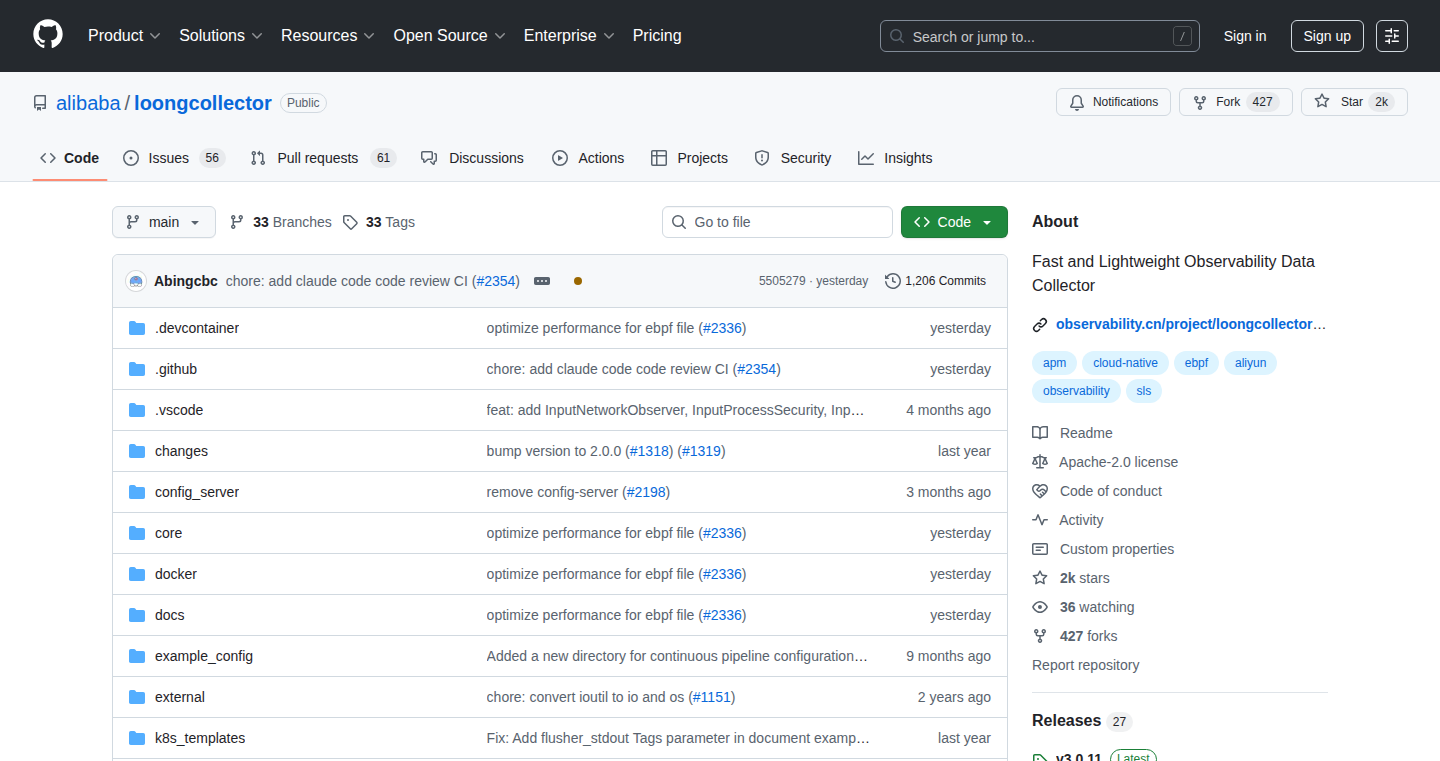
Author
yyuuttaaoo
Description
LoongCollector is a high-performance data collector designed to grab observability data from your systems, like logs, metrics, and traces, and get them ready for analysis. The cool thing? It's built to handle crazy amounts of data without slowing down your applications. Think of it as a super-efficient data pipeline that can keep up with the demands of modern, fast-paced systems. It tackles the problem of data overload, making sure you can still understand what's going on in your applications, even when they're spitting out tons of information.
Popularity
Points 1
Comments 0
What is this product?
LoongCollector works by collecting data in a highly optimized way, which means it can process a lot more data than traditional methods. The core innovation lies in its design to minimize the impact on your application's performance while collecting data. It does this by using efficient data structures and streamlined processing pipelines. This allows you to gain insights into your systems without adding extra lag or causing bottlenecks. It focuses on high throughput and low latency, meaning it grabs and processes data really, really fast. This is especially helpful for dealing with the flood of data that comes from modern, complex applications. The goal is to let developers keep a close eye on things without paying a big performance price.
How to use it?
Developers can use LoongCollector as a central point for collecting and forwarding all types of observability data. You'd typically integrate it into your application's logging and monitoring systems, pointing the data streams towards LoongCollector. It then takes care of the heavy lifting - processing, filtering, and forwarding that data to your preferred analysis tools, like dashboards or alerting systems. You might set up a configuration to specify what data to collect and how to handle it, such as filtering out irrelevant information or transforming the data format. Think of it as a powerful filter and distributor for your application's data, making it easier to spot problems and understand what your application is doing. The integration process is straightforward, typically involving changes to your application's configuration files or adding a small library to your code. So, you're essentially setting up a 'data tap' that funnels information to where it can be used effectively.
Product Core Function
· High-Throughput Data Collection: The core function is its ability to gather a massive amount of data with minimal overhead. This is crucial because it ensures that the application doesn’t slow down as it collects information. This means that you can monitor your systems without causing them to lag.
· Efficient Data Processing: It processes data in a way that minimizes impact on system performance. This often involves techniques like data compression and smart filtering to reduce the amount of data that needs to be stored and analyzed. This helps in quick and efficient data processing.
· Flexible Data Routing: The collector should be able to direct the data to different destinations, like a monitoring tool, a log analysis system, or a storage database, based on the data type or importance. This helps in efficiently analyzing data in the required tools.
· Scalable Architecture: The design needs to support increasing data volumes as applications and systems grow. This typically involves the ability to distribute the data collection and processing across multiple servers or nodes. This is useful in handling the growth of large applications or services.
Product Usage Case
· Observability of Microservices: In a microservices architecture, where many small services are working together, LoongCollector can gather logs and metrics from all the services. By consolidating this data, you can quickly understand how different parts of the system interact and spot issues, such as a slowdown in one service causing problems for others. So, this allows you to understand and monitor all these different services and troubleshoot them.
· Performance Monitoring in E-commerce: An e-commerce website uses LoongCollector to monitor the performance of its backend services. When the site experiences a sudden increase in traffic during a sale, LoongCollector identifies that database queries are taking longer than usual. This insight allows the operations team to quickly scale up the database resources, thus ensuring a smooth shopping experience. It’s really helpful in handling sudden traffic.
· Real-time Fraud Detection: A financial institution uses LoongCollector to analyze transaction data in real-time. When it detects unusual transaction patterns, like many small transactions in quick succession from a new location, the system flags it as potentially fraudulent. This allows the institution to quickly block the suspicious transactions, protecting customers. Thus, it is a way to prevent fraud efficiently and effectively.
64
Wplacepixel.run: Client-Side Pixel Art Generator

Author
TheraDeng
Description
Wplacepixel.run is a web application that transforms images into pixel art, specifically tailored for the Wplace online community. The innovative aspect lies in its completely client-side processing, meaning all the image-to-pixel art conversion happens directly in your web browser without sending any data to a server. This approach leverages the user's own device for computation, avoiding upload requirements and potential privacy concerns. The application utilizes the official Wplace 63-color palette and provides real-time statistics on pixel count and color usage. This project tackles the challenge of efficiently converting images into pixel art while maintaining user privacy and offering real-time feedback, demonstrating the feasibility of complex image manipulation within the browser environment.
Popularity
Points 1
Comments 0
What is this product?
This project is a pixel art generator that operates entirely within your web browser. It takes an image and converts it into pixel art using the 63-color palette used by Wplace. The magic is that all the image processing happens in your web browser itself, meaning you don't need to upload your images to any server. It also provides cool features, like showing how many pixels and which colors are used. The core innovation is the ability to do all this processing locally, making it faster and more private. So what's the big deal? It's about making image manipulation easier, faster, and more secure, all while providing a fun way to create art for the Wplace community.
How to use it?
Developers can use this project as a starting point for building similar image processing tools. They can examine the code to understand how client-side image manipulation and color quantization (reducing the number of colors) are implemented. It can be a great resource for anyone building web applications that need to handle image processing tasks within the browser, such as image compression, watermarking, or creating custom image effects. For example, you could integrate the pixel art generation logic into a web-based image editor or a social media platform that supports pixel art avatars.
Product Core Function
· Client-side image processing: This is the heart of the project. It means the image is processed directly in your browser. So what's the use? It enhances user privacy by avoiding uploads to a server, and potentially improving processing speed depending on your device, since you're using your own computer's resources. This approach is valuable for creating fast, responsive web applications that handle images.
· Color quantization using the Wplace palette: The system reduces the original image colors to the 63-color palette specific to Wplace. What does this do? It turns a complex image into pixel art by limiting the colors to those used in Wplace. This functionality can be extended to support other color palettes or to create pixel art with different visual styles.
· Real-time statistics: The application shows you how many pixels and how many of each color are used in the pixel art as it's generated. Why is this useful? It provides instant feedback about the pixel art, and lets you see which colors are most dominant, which can be useful for art creation and analysis. This is achieved without having to upload the image.
Product Usage Case
· Building a web-based image editor: A developer could adapt the pixel art generation to include it in an image editor that works directly in the browser, enabling users to convert their photos to pixel art without uploading any files. This increases user privacy and provides a richer experience.
· Creating a social media profile picture tool: A social media platform could integrate the pixel art generation as a feature, allowing users to transform their profile pictures into pixel art, adding a unique and customized visual style. This provides users with an easy and fun way to modify their profile pictures.
· Educational project for understanding image processing: Students or developers can analyze the code of this project as a practical example of how to implement color quantization and client-side image processing. This offers a learning resource to understand the technical principles of image manipulation.
· Generating art for games: Game developers can use the code or the underlying techniques to quickly generate pixel art assets for their games directly from existing images. This is very useful for quick prototyping and reducing the design workload.
65
Hooks_MCP: Project-Specific AI Agent Interface
Author
scosman
Description
This project uses the MCP (Machine Code Protocol) to create a unified interface for AI agents to access project-specific instructions and tools. It aims to solve the problem of scattered and inconsistent documentation and tool integrations within a software repository. By defining everything in a single YAML file, it allows AI agents to understand the project's guidelines and execute commands like testing, linting, and formatting, all within a secure and efficient environment. So this helps teams ensure consistency and streamline developer workflows.
Popularity
Points 1
Comments 0
What is this product?
Hooks_MCP acts as a bridge between your project and AI agents. It uses the MCP standard to expose project-specific prompts (like design guidelines) and development tools (like formatters and linters) to these agents. The core innovation lies in using a single YAML file to define all of this. This file tells the AI agent what tools are available, how to use them, and where to find important information. This simplifies the process of integrating AI agents with your project, making them more effective and easier to use. It avoids the confusion of multiple standards by utilizing a standardized protocol (MCP). So it makes integrating and using AI tools in your project straightforward.
How to use it?
Developers use Hooks_MCP by creating a YAML file that describes their project's tools and prompts. For example, you would define a command to run a test suite or link to a design guide file. This YAML file is then used to run an MCP server. When an AI agent interacts with the project, it queries the MCP server to discover the available tools and prompts. The agent can then use these resources to help with coding, debugging, and other development tasks. To start, you would integrate it into your existing repository. So, it lets developers easily teach their AI agents about their project and integrate them into their workflow.
Product Core Function
· MCP Server Creation: The core function is setting up an MCP server based on your project's specific needs. This server acts as the central point of contact for AI agents, providing them with information about available tools and prompts. This is essential to provide a unified interface between your code base and agents.
· Tool Integration: Allows the definition of project-specific tools, such as linters, formatters, and build processes, accessible to the AI agent. This enables the agent to automatically run these tools and provides guidance. It makes these agents more useful within the development process.
· Prompt Exposure: Exposes project-specific prompts (like design guides or style guides) to the AI agent. These prompts provide essential context for tasks like code reviews or design suggestions. So your AI agents will be fully aware of your project specific information.
· YAML Configuration: A single YAML file defines all the tools and prompts. This simplicity makes it easy to set up and maintain the integration between the project and the agents. This reduces configuration complexity and is easy to understand.
· Security and Speed: Provides a way to allow AI agents to run certain commands without granting full access, enhancing security and efficiency. Using MCP to enable tools like format and lint can speed up the development process, without the risk of open access.
Product Usage Case
· Code Formatting: Imagine you want your AI agent to automatically format code. You define a 'format' tool in the YAML file, pointing to your formatter (like `prettier`). The agent can then automatically format the code using this tool. So this simplifies the code formatting process.
· Code Review: You want an AI agent to perform a code review and adhere to your front-end design guidelines. You create a prompt that points to your `front-end-design-guide.md`. The AI agent can then use that prompt when reviewing code changes. So it is useful to streamline code review.
· Automated Testing: You can set up an AI agent to automatically run your project's tests. By defining a 'test' tool, the agent can trigger the test suite, receive results, and flag any issues. So, it automates your testing procedures.
· Documentation Generation: Create a prompt to use existing documentation and generate new documentation based on code changes. This improves consistency and eliminates the manual effort of documenting your code. So, it helps developers keep documentation up-to-date with minimal effort.
66
Gen Commit: AI-Powered Git Commit Message Generator
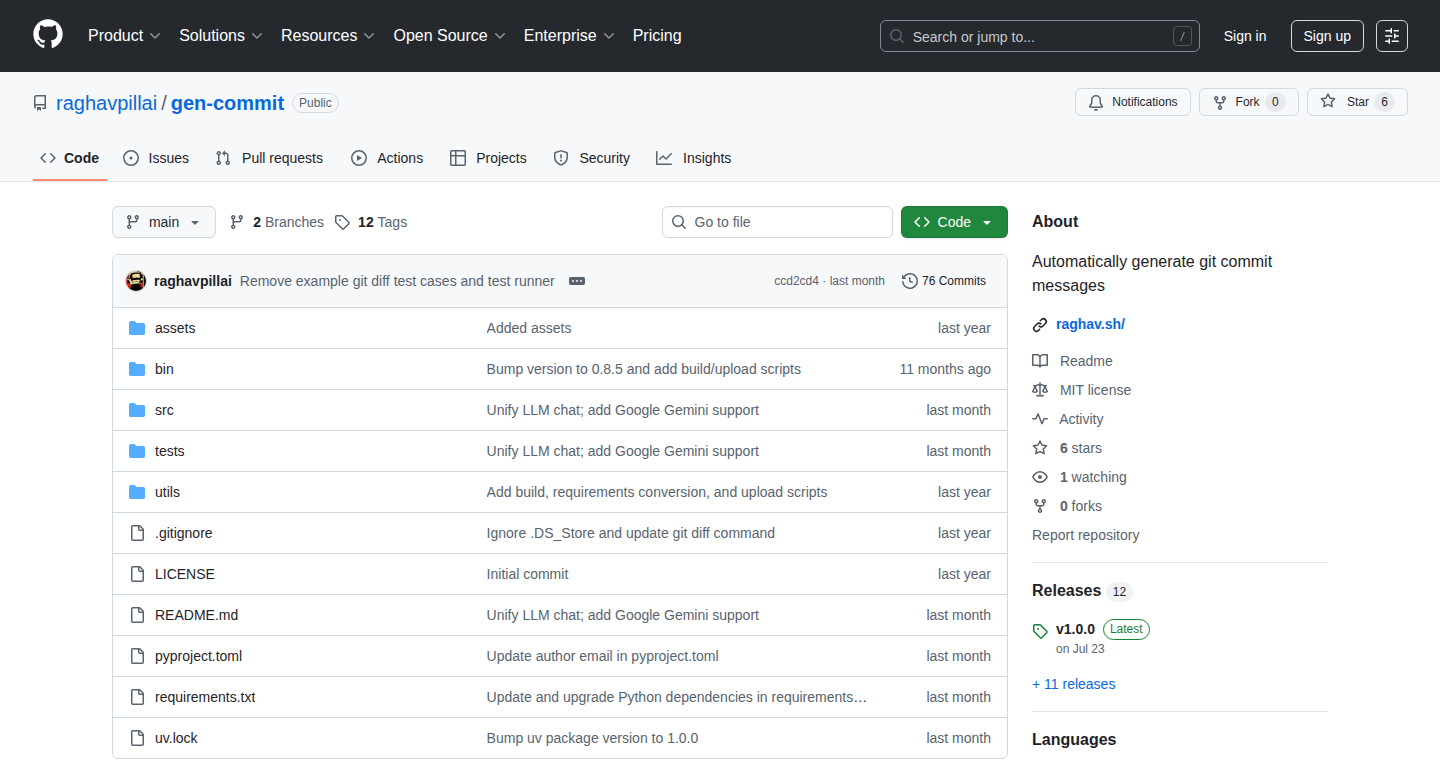
Author
ragp
Description
Gen Commit is a command-line tool that uses Artificial Intelligence to automatically generate Git commit messages. It analyzes your staged changes and crafts descriptive commit messages and descriptions. This saves developers time and effort by automating the writing of clear and informative commit messages. It solves the common problem of writing verbose commit messages, providing a more detailed explanation of code changes. You can also configure the tool to use different AI providers and models to customize the commit message generation.
Popularity
Points 1
Comments 0
What is this product?
Gen Commit is a command-line tool that leverages AI to automatically generate git commit messages. It works by analyzing the changes you've staged in your code repository. It then uses AI models to understand these changes and create a commit message that clearly and concisely describes what you did. The tool offers detailed descriptions, helpful for understanding the 'why' behind your changes. Think of it as an AI assistant that writes commit messages for you. So this is useful because it saves time and encourages clear communication in your projects, making it easier for others (and your future self) to understand the changes you made.
How to use it?
Developers use Gen Commit by running the `gencommit` command instead of the standard `git commit`. The tool integrates seamlessly with your existing Git workflow. You stage your changes using `git add`, then instead of typing out your commit message with `git commit -m "your message"`, you use `gencommit`. The tool will analyze the staged changes and generate the commit message for you, which you can then review and finalize. So this means you don’t have to learn a new system; it slots right into how you’re already working.
Product Core Function
· Automatic Commit Message Generation: The core function is automatically generating Git commit messages based on staged changes. This saves developers time and reduces the mental load of writing messages. This is valuable because it ensures consistent and informative commit messages, essential for project maintenance and collaboration.
· Detailed Description Generation: The tool generates a verbose description alongside the commit message, providing a comprehensive explanation of code changes. This improves code maintainability and understanding, especially for complex changes. This is useful because it allows for easier debugging and better understanding of the code's evolution.
· AI Provider and Model Configuration: Users can configure the tool to use different AI providers and models to tailor the commit message generation process to their needs. This allows for flexibility and customization based on individual preferences or project requirements. This is beneficial because it allows developers to optimize the commit message generation based on specific AI models, which can result in better and more relevant messages.
· Command-Line Interface (CLI): The tool is accessible through a command-line interface, making it easy to integrate into existing development workflows. This design offers a simple and straightforward way to generate commit messages without switching tools. It provides greater efficiency and minimizes disruption to developer workflows.
Product Usage Case
· Code Review: In a collaborative project, a developer makes several changes and stages them. Using Gen Commit, the developer gets a clear, detailed commit message that is easy for reviewers to understand. This helps speed up the code review process and reduces the chances of misunderstandings. This is useful because reviewers can quickly grasp the context and purpose of the code changes.
· Large Projects: In large, complex software projects, developers often make multiple changes at once. Gen Commit can summarize these changes, creating coherent commit messages that are easier to track than multiple individual messages. It is valuable because it helps improve code readability and navigation within extensive codebases.
· Debugging and Troubleshooting: When looking back at a project's history to find the cause of a bug, the detailed commit messages generated by Gen Commit helps developers to pinpoint the relevant changes that introduced the issue. This is especially useful when trying to understand 'why' a change was made in the first place and how it impacts the broader codebase. This is beneficial because it reduces time spent on understanding changes and simplifies debugging.
67
Chess.ts: A TypeScript Chess Engine & UI
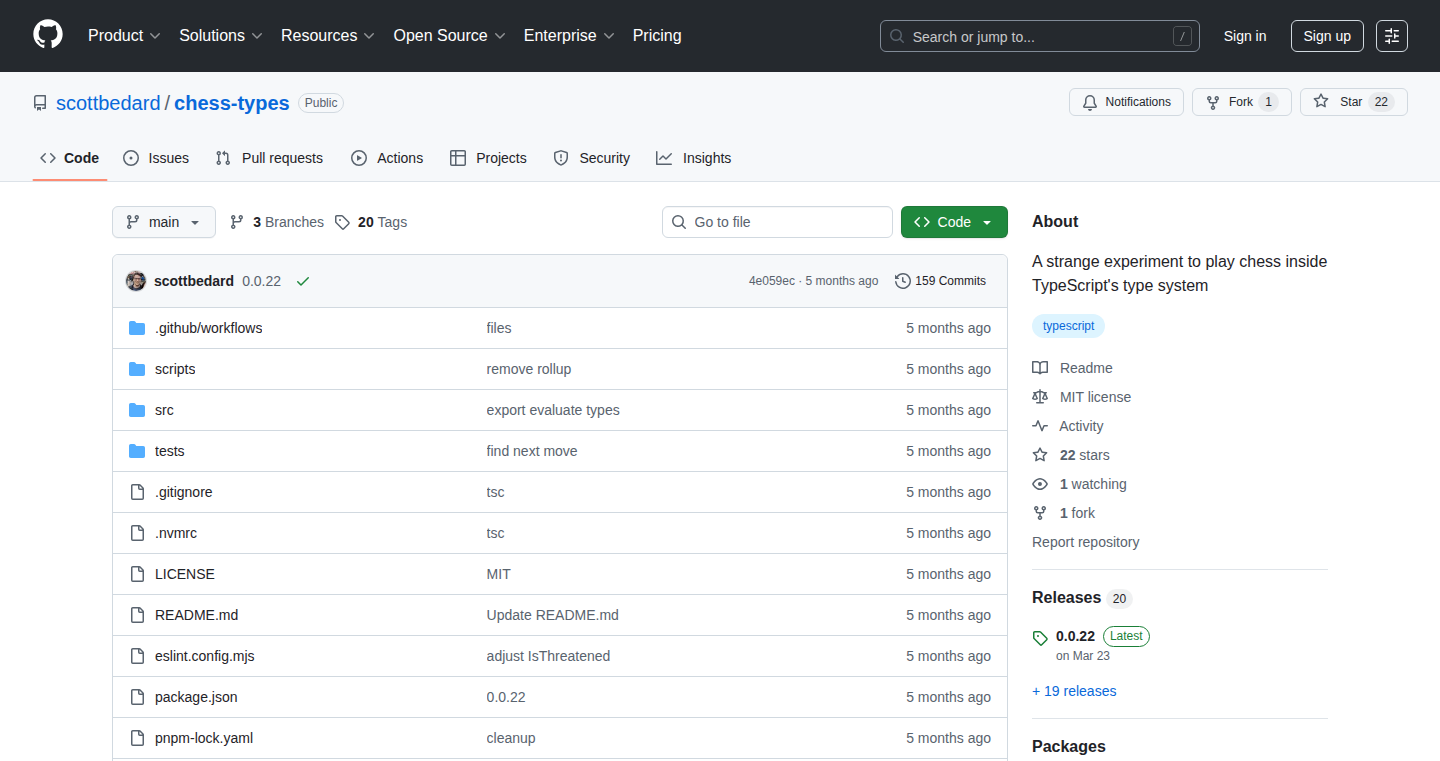
Author
arm32
Description
This project is a chess game implemented entirely in TypeScript, including a full-fledged chess engine capable of analyzing moves and playing against a user. The core innovation lies in its use of TypeScript for both the game logic and the user interface, showcasing a modern approach to game development within a type-safe and web-friendly environment. It solves the problem of creating a complex interactive application with maintainability and scalability, all while leveraging the strengths of TypeScript.
Popularity
Points 1
Comments 0
What is this product?
Chess.ts is a chess game built using TypeScript. It includes a chess engine that can think like a chess player to analyze moves and a user interface allowing players to interact with the game. The key innovation here is the use of TypeScript, which helps manage the complexity of the game, making it easier to understand, change, and extend. It translates complex chess rules into code, improving its accuracy and making it easier to add new features like better AI or new game modes.
How to use it?
Developers can use Chess.ts as a learning resource to understand how to build complex applications in TypeScript. They can also integrate it as a component within their own projects. For example, a developer building a platform for online learning can use this to create an interactive chess tutorial, or someone building a game-focused website can use Chess.ts for its chess game integration.
Product Core Function
· Chess Engine: The engine analyzes the chess board, determines legal moves, and evaluates the best possible next step. This component uses algorithms to simulate the way chess players think. So what does this mean for you? It shows how to implement complex game logic within a programming framework and allows developers to create more sophisticated AI in their own applications.
· Game Logic: This manages the game rules – how the pieces move, when the game is won or lost, and how to handle special moves like castling. It is the brain of the game. So what does this mean for you? Developers can learn how to create and manage complex rule sets with TypeScript, which can be applied to all sorts of game development.
· User Interface (UI): The UI shows the chessboard, the chess pieces, and allows players to drag and drop pieces to make moves. It makes it easy for the player to see and interact with the game. So what does this mean for you? It is a great example for building interactive applications, providing developers with a guide to design a user friendly game, and demonstrating how to use TypeScript to build interactive elements on a web page.
· Type-Safety: TypeScript is used all throughout the project, providing type checking and reducing the chances of errors. This makes the game easier to understand and change. So what does this mean for you? Developers can see a practical example of how to use type safety to create clean, well-organized code, making projects easier to maintain and less prone to errors.
Product Usage Case
· Interactive Chess Tutorials: Use the engine to create a chess tutorial that guides new players, highlighting legal moves and offering explanations for different chess strategies. It is a practical example of how to build complex learning software.
· Web-Based Chess Platform: Integrate Chess.ts into a website to create a web-based chess game that people can play from anywhere. This shows developers a complete and interactive web application.
· AI Experimentation: Study or modify the chess engine to experiment with different AI algorithms and how they affect gameplay. This allows developers to learn more about AI and apply this learning to other projects.
· Game Development Learning: Use the project as a reference for understanding the architecture of games, how to handle user input, and how to use TypeScript's features effectively. It demonstrates a great starting point for web and game development.
· Embeddable Chess Components: Integrate the UI part of the game into other existing projects and let users play a chess game in your own application. This gives you the potential for adding new and interactive features in your existing product. For example, a platform to host chess-based tournaments can use the engine for determining scores.
68
RustTailwindMerge: Blazing-Fast TailwindCSS Class Merging Utility
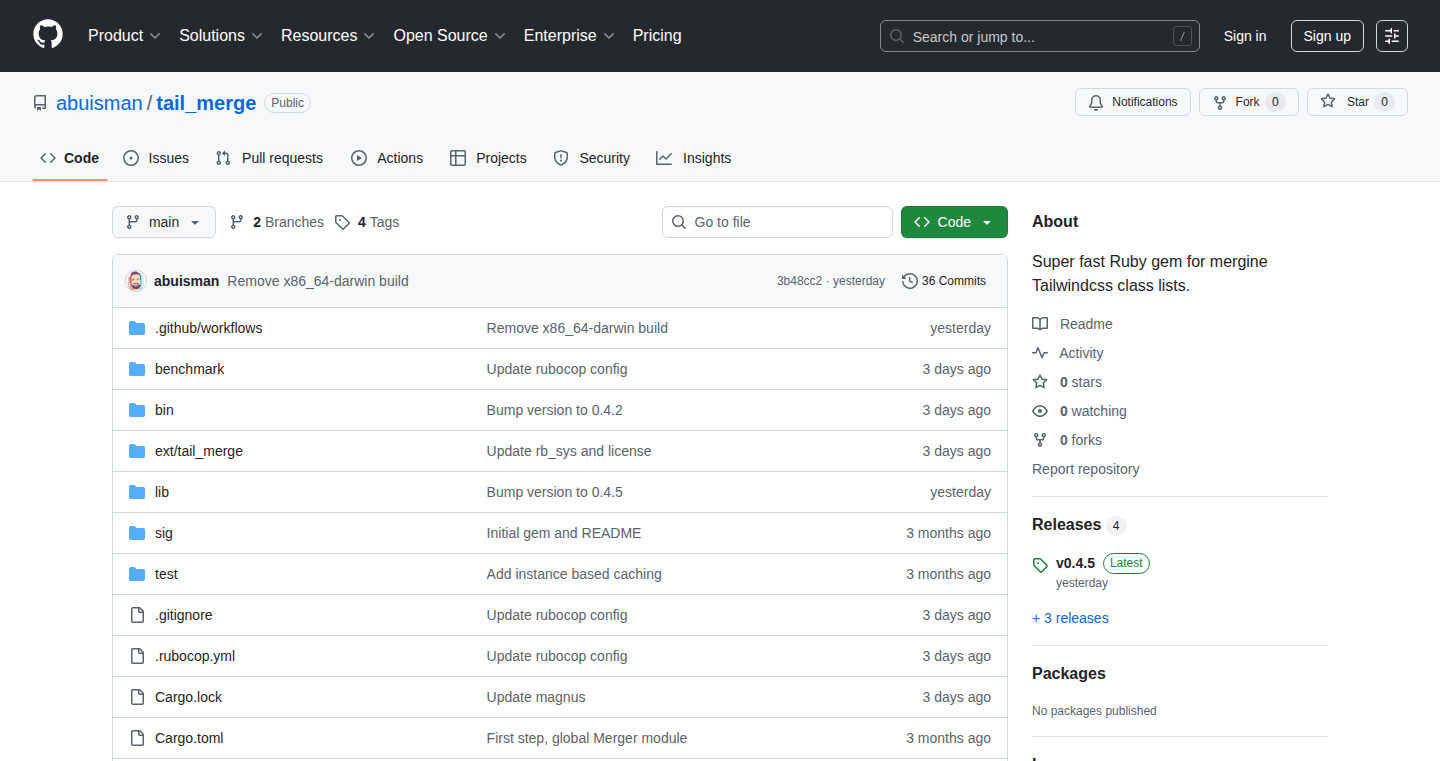
Author
mosselman
Description
This project is a gem (like a library) written in Rust that optimizes the way TailwindCSS classes are combined. TailwindCSS helps developers build websites quickly by providing pre-defined CSS classes, but combining many classes can sometimes lead to performance issues. RustTailwindMerge solves this by efficiently merging these classes, resulting in faster rendering and a smoother user experience. It leverages the speed of the Rust programming language to achieve significant performance gains over traditional methods.
Popularity
Points 1
Comments 0
What is this product?
RustTailwindMerge is a tool that intelligently combines TailwindCSS classes. When you write HTML with many Tailwind classes, the browser has to process them. This tool quickly and efficiently merges those classes into a minimal set, optimizing the CSS for the website. The project uses Rust, a programming language known for its speed and performance, making the merging process significantly faster than using other methods. The innovation lies in its optimized algorithm for merging Tailwind classes and its use of Rust for performance.
How to use it?
Developers can integrate this gem into their Ruby on Rails projects (since it's a 'gem'). After installation, they can use a single function to merge Tailwind classes. This allows them to efficiently manage and optimize the CSS classes used in their application's templates. You might use it in a Rails view helper or a component to generate class strings dynamically.
Product Core Function
· Efficient Class Merging: The core function takes a string of TailwindCSS classes as input and returns a minimized string. This reduces the number of classes the browser needs to process, leading to improved rendering speed. So this is useful because it helps your website load and respond faster.
· Performance Optimization: Written in Rust, this tool is designed for speed. It offers performance advantages compared to similar tools written in other languages, especially when dealing with a large number of classes. So this is useful because it speeds up the overall website performance and makes development more efficient.
· Seamless Integration: The gem integrates into Ruby on Rails projects, allowing developers to incorporate its functionality without significantly changing their workflow. So this is useful because it's easy to use and makes it simpler to manage CSS classes.
· Elimination of Conflicts: The merging process intelligently handles class conflicts (e.g., different classes setting the same property) by resolving them based on TailwindCSS's specificity rules. So this is useful because it prevents unexpected styling issues.
Product Usage Case
· Dynamic Component Styling in Rails: Imagine a Rails application where UI components need to be styled with various Tailwind classes based on user interaction or data. By using RustTailwindMerge, the developer can dynamically generate class strings and ensure that the resulting CSS is optimized for performance. For example, changing button colors or layout based on user input. So this is useful because it leads to quicker and better-looking components.
· Large-Scale Web Applications: For websites with many pages and components relying heavily on TailwindCSS, RustTailwindMerge provides a significant performance boost. Each individual optimization may seem small, but combined, they lead to a faster user experience. For example, an e-commerce site with many product listings. So this is useful because it improves the overall website performance.
· Improving Build Times: Because the gem is fast at merging classes, this can reduce build times, especially for larger projects. This is important for CI/CD pipelines and speeding up developer workflows. So this is useful because it helps save you time and effort.
69
SteamBookmarks: In-Game Web Navigation Enhancer
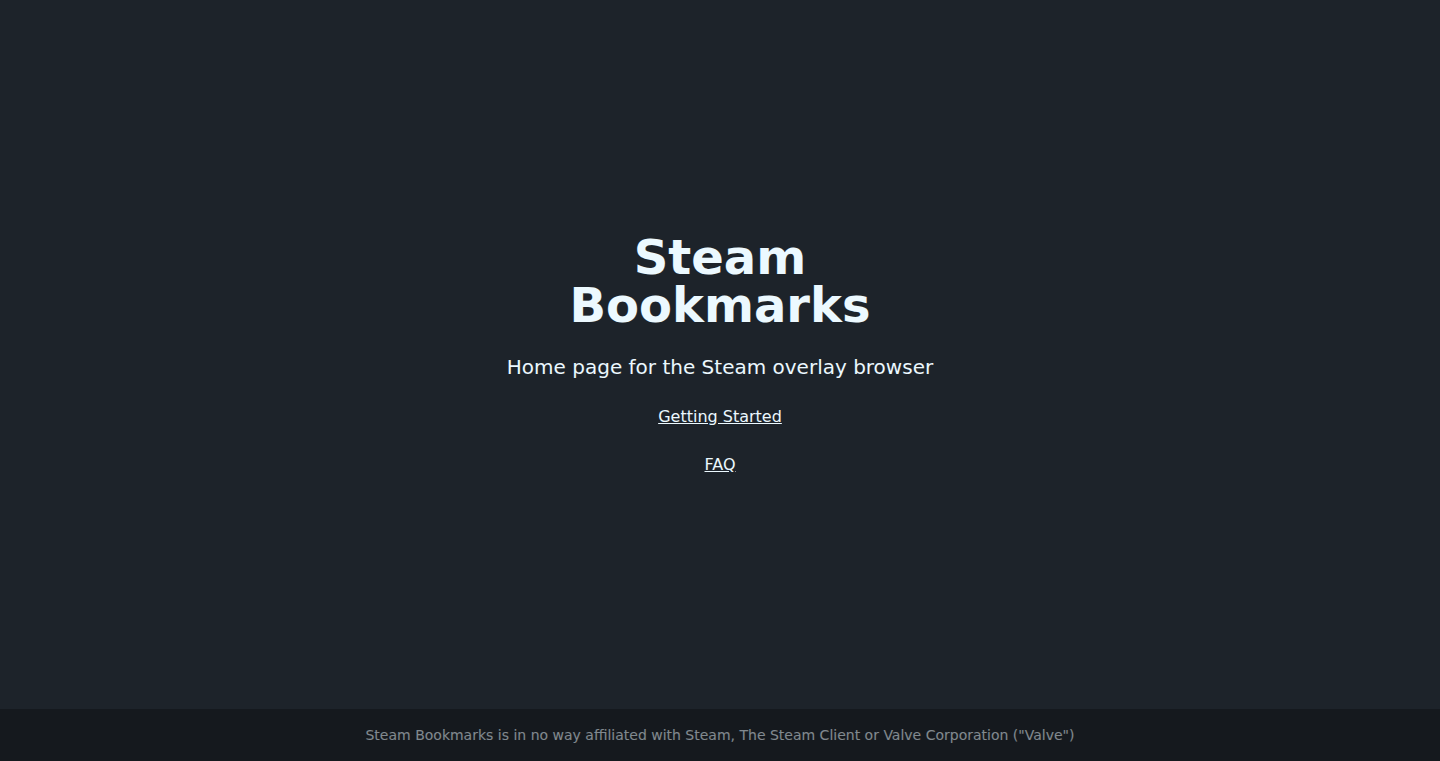
Author
Pifpafpouf
Description
SteamBookmarks is a web-based home page designed specifically for Steam's in-game browser. It allows players to save and organize web bookmarks tailored for each game, along with a custom search engine. The innovative aspect lies in its use of local storage within the browser to store all user data, ensuring privacy and accessibility. Furthermore, it incorporates a non-trivial caching mechanism using Redis to handle rate limits of the Steam Web API, leading to more efficient and smoother web browsing experience. So this provides a personalized and optimized web experience inside Steam.
Popularity
Points 1
Comments 0
What is this product?
SteamBookmarks is essentially a personalized homepage for the Steam overlay browser. It works by letting you add your own bookmarks, customized for each game. When you're playing a game, you can quickly access relevant websites or guides without having to navigate the standard web browser. The core innovation is the way it stores your data – it's all kept locally in your browser using 'localStorage', so your info is private. The project also tackles API limitations by using Redis caching to improve performance and avoid getting blocked. So this provides a convenient way to manage and access game-related information.
How to use it?
You set SteamBookmarks as the homepage in your Steam overlay browser settings. Then, while playing a game, you can hit the Steam overlay key, access the browser, and see your personalized homepage. From there, you can click your game-specific bookmarks or use the search engine. Developers can contribute to the open-source project on GitHub, extending its features or improving its design. So this allows seamless access to helpful websites while you play.
Product Core Function
· Per-Game Bookmarks: Lets you save bookmarks that are specific to each game you play. This is super helpful for guides, walkthroughs, or anything relevant to the game you're currently playing. So this gives you instant access to game-specific resources.
· Custom Search Engine: Provides a customizable search engine that you can use directly from within the Steam overlay browser. This means you can search the web without switching between applications. So this allows faster access to information while gaming.
· Local Storage for Data: All your bookmark data and settings are stored in your browser's local storage. This ensures your data stays private, and it also means you don’t need an account or any external dependencies. So this keeps your bookmarks safe and easy to access.
· Redis Caching for Steam Web API: Uses Redis, a fast data storage system, to cache data from the Steam Web API, which is used to fetch game information. This prevents rate limits and ensures the homepage loads quickly. So this makes the browsing experience inside the Steam overlay faster and more reliable.
Product Usage Case
· Game Guides: Imagine you're struggling with a boss in a game. With SteamBookmarks, you can quickly open your in-game browser, select the bookmark for that game, and instantly access a helpful guide from sites like GameFAQs or YouTube. So this makes finding game guides effortless.
· Community Forums: You are playing a multiplayer game and want to connect with other players. You can create bookmarks for the game's official forums or community websites. The next time you play, you can jump right to those communities with one click. So this facilitates community engagement seamlessly.
· Tutorial Videos: You're new to a game and need some video tutorials. You could create a bookmark for the game's YouTube tutorials and access them through the Steam overlay browser when needed. So this makes it easy to consume tutorial videos while playing.
· FAQ and Troubleshooting: If you encounter technical issues in a game, you can have bookmarks to the game’s troubleshooting pages or FAQ. This allows for immediate access to solutions without leaving the game. So this simplifies in-game troubleshooting and quick access to FAQs.
70
AgentState: Firebase for AI Agents
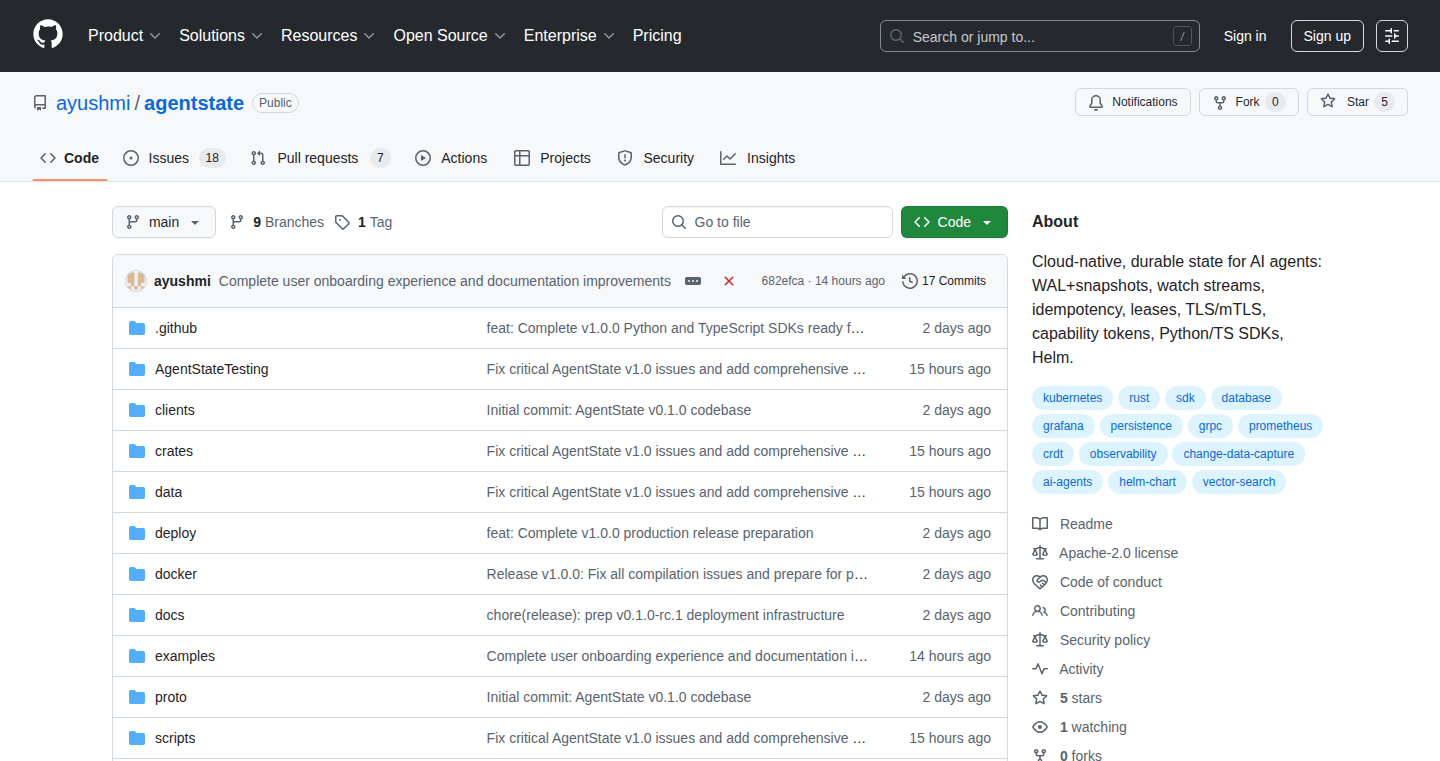
Author
boulevard
Description
AgentState is a system designed to simplify the management of state for multi-agent AI systems. It addresses the common problem of complex setups involving Redis, Postgres, custom queuing, and synchronization code when coordinating and persisting state for multiple AI agents. Built in Rust for performance and safety, the whole thing is about 3MB and runs in Docker, handling over 1000 operations per second. It aims to provide a streamlined solution, similar to Firebase, but specifically tailored for AI agent workflows. So this simplifies how you manage the data and interactions between AI agents, making your AI systems more efficient and easier to maintain.
Popularity
Points 1
Comments 0
What is this product?
AgentState acts as a central hub for AI agents to store, share, and access information about their current state. It uses Rust for speed and reliability, packaged within a Docker container for easy deployment. This allows AI agents to communicate and coordinate without the usual complexities of custom database configurations and message queues. The innovation lies in providing a ready-to-use, high-performance state management system tailored for the unique demands of AI agent interactions. So, it provides a single source of truth for your AI agents, making them more organized.
How to use it?
Developers can integrate AgentState into their AI agent workflows by deploying it as a Docker container and utilizing its API to store and retrieve agent states. It provides APIs for storing agent data (like what they're doing, their goals, etc.) and querying the states of other agents. This approach replaces the need for complex setups, allowing developers to focus on building AI agent logic rather than managing infrastructure. So, you can get your agents talking to each other easily.
Product Core Function
· State Persistence: AgentState allows agents to save their current state, like their tasks, knowledge, and internal variables. The value is that AI agents can remember what they've done and what they know, crucial for long-running tasks and complex decision-making. So, your agents don't have to start from scratch every time.
· Inter-Agent Communication: Agents can query the states of other agents to share information and coordinate actions. The value is that this supports collaboration and teamwork between AI agents, enabling complex multi-agent systems. So, your agents can work together.
· High Performance: The system handles over 1000 operations per second. The value is that this ensures smooth and responsive operation, even with many agents interacting simultaneously. So, this means your AI systems can handle lots of agents with no slowdown.
· Docker-Based Deployment: AgentState is packaged in a Docker container. The value is that this simplifies deployment and makes it easy to run in various environments. So, getting AgentState running on your server is super easy.
· Written in Rust: The core of AgentState is written in Rust. The value is that Rust provides performance and safety, leading to a fast and reliable system. So, your AI system will be fast and safe.
Product Usage Case
· Multi-Agent Planning: Imagine a scenario where several AI agents are planning a complex task, like managing a supply chain. Agents can use AgentState to share information about inventory levels, delivery schedules, and potential disruptions. This allows them to collaborate and make informed decisions. So, you get a smarter supply chain managed by AI.
· Cooperative Game AI: In a video game, AI agents (like characters) could use AgentState to keep track of their positions, health, and strategies. They can then share this information with each other to coordinate attacks or defend against enemies. So, your game characters can team up and fight better.
· Automated Customer Service: Multiple AI agents can handle different parts of customer service inquiries (e.g., billing, technical support). They can use AgentState to share the history of interactions with a customer and their specific issues, making each interaction more efficient. So, your customers get faster help from your AI agents.
71
Rethink: A Declarative Software Construction Kit

Author
goloroden
Description
This project, Rethink, proposes a new way to build software by focusing on *declarative programming*. Instead of telling the computer *how* to do things step-by-step (imperative programming), you describe *what* you want the software to achieve. Rethink uses this approach to simplify software development by letting developers define the desired state of their applications, and then it automatically handles the underlying complexity of implementation. This introduces a novel approach to managing software complexity, potentially leading to faster development cycles and more maintainable code.
Popularity
Points 1
Comments 0
What is this product?
Rethink is a system built around the idea of declarative programming. Think of it as a blueprint for your software. Instead of writing out every single instruction, you describe what you want your software to do, and Rethink figures out how to make it happen. The innovation lies in its ability to handle the intricacies of building and maintaining the software based on this declarative definition. This reduces the need for manual coding of low-level details, making development more efficient.
How to use it?
Developers would use Rethink by defining the desired state of their software components, perhaps using a specialized configuration language or even a visual interface. They would describe what data needs to be present, what actions need to occur, and how different parts of the application relate to each other. Rethink would then take this description and generate the necessary code or orchestrate the execution of the application. This could be used for everything from building web applications to managing complex infrastructure. To integrate, you would define your application's state using Rethink's format, and then use Rethink's tools to build or manage your deployed code.
Product Core Function
· Declarative State Definition: Allows developers to specify the *desired* state of their application, which significantly reduces the amount of code needed to be written manually. So what? This is a huge time saver and reduces the chance of errors because it abstracts away the implementation details and makes it easier to reason about the system.
· Automatic Code Generation/Orchestration: Based on the declarative definition, Rethink would automatically generate code or orchestrate the execution of various components. So what? It automates tedious and error-prone tasks, allowing developers to focus on the core logic of the application.
· Dependency Management: Rethink could handle dependencies between different parts of the software automatically. So what? This avoids the 'dependency hell' of manually managing software components and simplifies updates and maintenance.
· Version Control and Rollbacks: The declarative approach allows easy versioning and rollbacks of the whole system. So what? Provides reliability, making it simple to return to earlier working states or experiment with different configurations without the risk of breaking things.
Product Usage Case
· Web Application Development: Developers can describe the structure and functionality of a web application. Rethink would then automatically generate the necessary code for the front-end (user interface) and back-end (server logic) components. So what? Speed up development and reduce errors in web app creation.
· Infrastructure as Code: Define your cloud infrastructure (servers, databases, networks) declaratively. Rethink would then deploy and manage the infrastructure based on the description. So what? Simplifies infrastructure management, making it easier to deploy, scale, and update applications in the cloud. Reduces manual configuration errors.
· Data Pipelines: Describe how data should flow from one system to another, including transformations and storage. Rethink would then build and manage the data pipelines. So what? Simplifies data engineering tasks, making it easier to build and maintain data-driven applications.
72
Trickle-Powered Browser Game: Rapid Prototyping with AI

Author
GraceRaoooo
Description
This project showcases a simple browser game built using Trickle, an AI-powered no-code builder. The core innovation lies in its ability to rapidly prototype interactive projects like games without needing to write any code. This allows developers to quickly test ideas and iterate on gameplay, design, and usability, solving the traditional problem of lengthy development cycles for even small projects. It's a testament to how AI can democratize game development and make it accessible to a wider audience.
Popularity
Points 1
Comments 0
What is this product?
This is a simple browser game created using Trickle, a no-code AI tool. Instead of writing lines of code, the developer used the AI's capabilities to build the game. The innovation lies in using AI to significantly speed up the development process, enabling rapid prototyping and experimentation in game design. So, it's a new way to build things, fast.
How to use it?
Developers can use Trickle to quickly build prototypes of their games. They can define game mechanics, design the interface, and experiment with gameplay flow, all without coding. This means they can test ideas faster, get feedback earlier, and iterate quickly, leading to more polished and engaging games. You can try it out by accessing the game's URL and exploring the mechanics and user interface.
Product Core Function
· Rapid Prototyping: The core functionality is the ability to build a functional game prototype in a short amount of time using AI, removing the need to code from scratch. This allows developers to quickly visualize their ideas and test them in a real-world environment. So, it can save time.
· No-Code Development: Trickle enables building interactive projects without writing any code. This lowers the barrier to entry for game development, making it accessible to people with limited or no coding experience. So, anyone can try.
· Iterative Design: The project facilitates rapid iteration on game design, gameplay mechanics, and user interface. Developers can quickly make changes and see the results, enabling a more agile and user-centered design process. So, it can create a better game experience.
· AI-Assisted Development: Utilizing AI for building the game showcases the potential of AI in assisting with the game development process, offering an innovative way to make the process faster and easier.
Product Usage Case
· Game Jam Projects: Developers can use Trickle to rapidly create game prototypes for game jams, allowing them to focus on the core gameplay and design without getting bogged down in code. So, it helps to complete a project quickly.
· Educational Purposes: Educators can use Trickle to teach game design concepts to students without requiring coding knowledge. Students can focus on the creative aspects of game design and experimentation. So, it can foster creative thinking.
· Indie Game Development: Indie developers can use Trickle to quickly test different game mechanics and design concepts before committing to a full development cycle, reducing the risk of wasted time and resources. So, it helps save money.
· Prototyping for Larger Games: This tool is useful for quickly creating prototypes of game concepts before committing to a larger project.
73
Recursepaper: Demystifying Research Papers with Recursive Entity Extraction
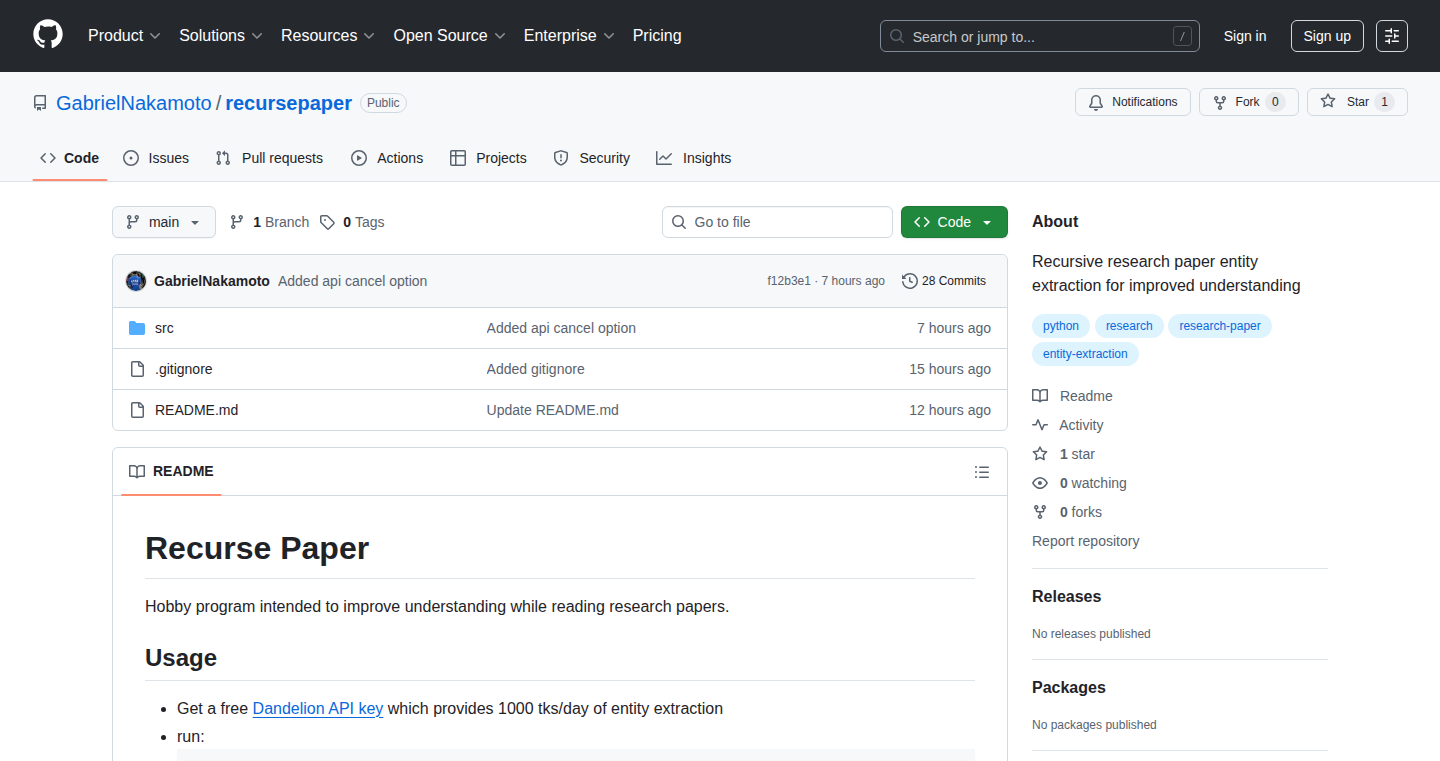
Author
graine
Description
Recursepaper is a tool designed to help you understand complex research papers. It uses a technique called 'recursive entity extraction' to identify key terms, concepts, and jargon within the text. Think of it as a smart highlighter that automatically finds and explains the most important parts of a research paper, making it easier to grasp complex ideas. It utilizes the Dandelion API for entity extraction, offering a free tier for usage.
Popularity
Points 1
Comments 0
What is this product?
This project uses 'entity extraction' - a process of automatically identifying and categorizing important words or phrases (entities) in a text. Recursepaper goes a step further by recursively extracting these entities. This means it not only finds key terms but also analyzes the context around those terms, providing deeper insights. The Dandelion API provides the underlying technology to identify these entities. This allows users to break down complicated text into manageable chunks and quickly grasp core concepts. So what does this mean for you? You can understand research papers more efficiently, saving you time and frustration.
How to use it?
You can use Recursepaper by inputting the text of a research paper. The tool will then highlight and explain the key terms and concepts. You might paste the paper text directly into the tool, or integrate it into a research workflow. Think of it as a smart reader for scientific papers. This can be integrated into your reading process easily. So how do you integrate it? Simple, input the text!
Product Core Function
· Entity Extraction: The core function is identifying and categorizing key terms within a research paper. This is done using an API to automatically pinpoint the most important concepts, which provides a foundation for the rest of the tool's functionality. So this means it helps you quickly find important parts of the text.
· Recursive Analysis: Beyond simple term identification, the tool delves into the context surrounding those terms, providing a deeper understanding of their relationships and meanings. This allows for a more nuanced understanding of the paper's content. So this means it helps you understand what the important parts are about.
· Jargon Detection: The tool is designed to help you with academic and technical jargon. This reduces the cognitive load when reading a complex research paper. So this means it avoids jargon and helps you read the paper easier.
Product Usage Case
· A scientist is reading a paper and is struggling to understand a specific term. They use Recursepaper to highlight and explain the term and its context within the research. This enables them to quickly grasp the concept and continue reading. This is useful in reading papers, so it helps you understand key concepts.
· A student is writing a literature review and needs to understand multiple research papers quickly. They use Recursepaper to extract the key information from each paper, saving them time and helping them compare and contrast different studies. So this means you can easily compare and contrast studies.
· A software developer is reading a technical document about a new library. They use Recursepaper to identify and understand the key concepts and jargon, enabling them to quickly grasp how to use the library. This speeds up the learning process. So this means it helps you learn quickly.
74
CastClip: Automated Podcast Clipping with AI
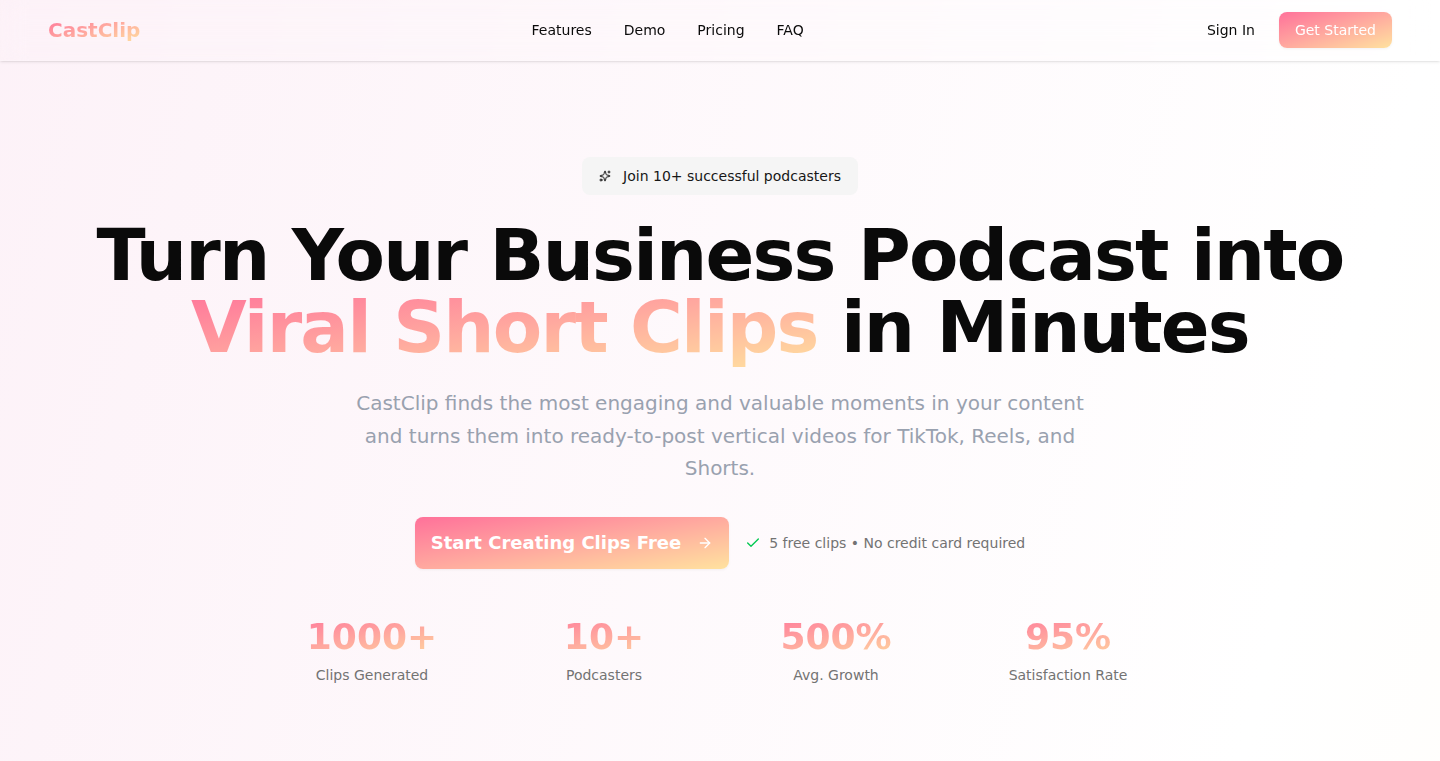
Author
revoltai
Description
CastClip is a tool that uses artificial intelligence to automatically generate short clips from your podcasts. It tackles the problem of manually creating podcast clips, which is a time-consuming and tedious process. The core innovation lies in its ability to analyze audio, identify interesting segments, and generate ready-to-share clips, saving podcasters a significant amount of time and effort.
Popularity
Points 1
Comments 0
What is this product?
CastClip leverages AI, specifically speech recognition and natural language processing (NLP), to analyze podcast audio. It identifies key phrases, topics, and potentially engaging segments within the podcast. The tool then automatically creates shorter audio clips, ready for sharing on social media or other platforms. The innovation is the automation and intelligent analysis, which replaces the need for manual listening and clipping.
How to use it?
Developers can use CastClip by simply providing the audio file of their podcast. The tool will then process the audio, identify clip-worthy segments, and generate the clips. Integration can be achieved by uploading the generated clips to platforms like YouTube, Instagram, TikTok and others. The service probably has an API (not specified in the prompt) that developers can use to integrate it into their existing podcast workflows or building a custom podcast distribution service. So you can automate clip generation as part of your podcast creation pipeline.
Product Core Function
· Automated Clip Generation: CastClip analyzes the podcast audio and automatically creates clips. This saves significant time compared to manually editing and creating clips.
· AI-Powered Analysis: Uses speech recognition and NLP to identify interesting segments. This allows the tool to intelligently identify valuable clips.
· Time-Saving Workflow: Converts a time-consuming task (manual clipping) into a quick, automated process. This allows podcasters to focus on content creation instead of editing.
· Multiple Clip Generation: Allows creation of multiple clips in a short time (e.g., 10 clips in 15 minutes). This provides increased content output for social media marketing.
Product Usage Case
· Podcast Marketing: Quickly generate clips for promoting podcast episodes on platforms like Twitter, Facebook, and Instagram. This increases visibility and drives listeners.
· Content Repurposing: Reuse podcast content for other formats, like short video teasers on TikTok or YouTube Shorts, expanding the reach of the podcast content.
· Social Media Promotion: Create engaging content for social media, driving increased user engagement and attracting new listeners.
· Rapid Prototyping: Speed up the process of creating samples for potential sponsors, who can see potential clip highlights, increasing the chances of securing sponsorships.
75
GmailDotGenerator: Mastering Gmail's Dot Trickery
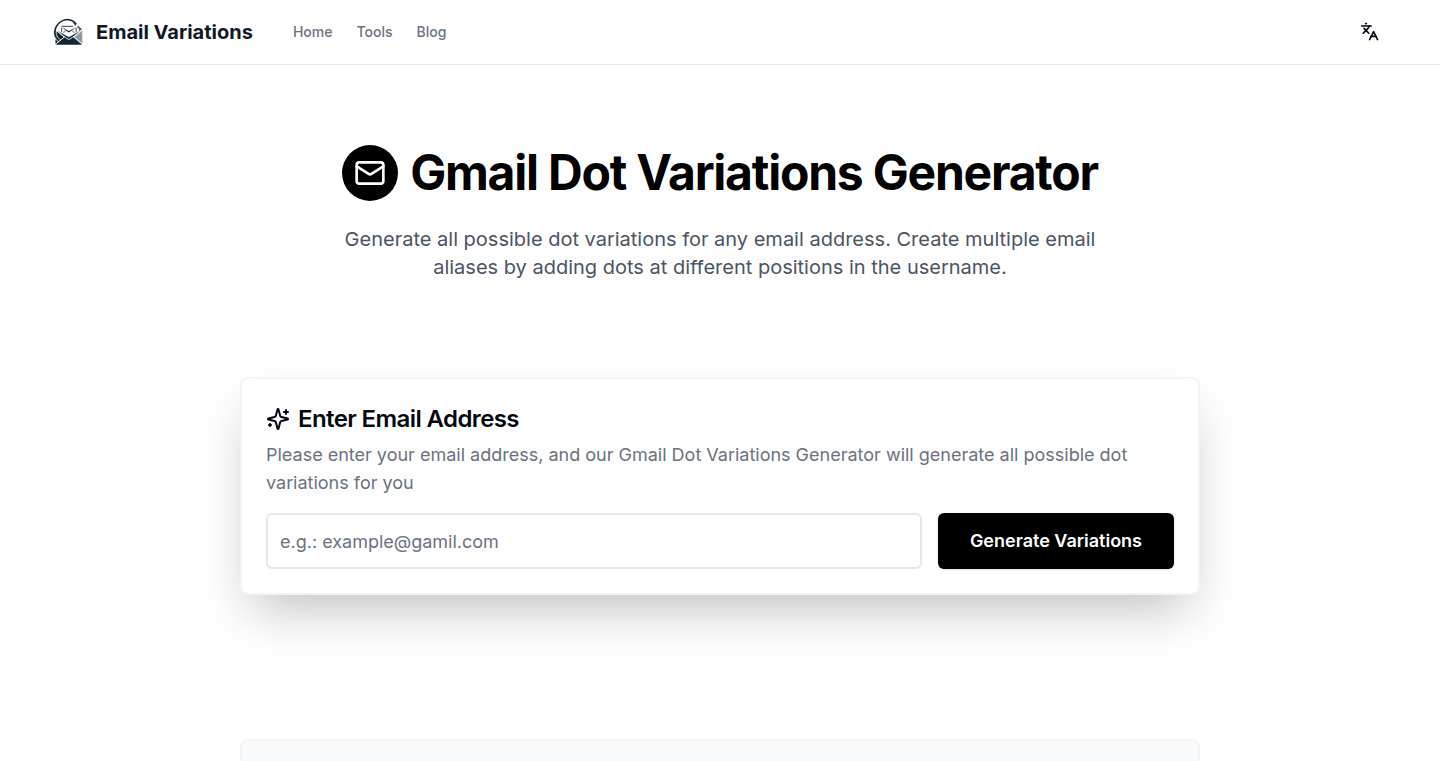
Author
light001
Description
This project addresses a clever Gmail quirk: Gmail ignores dots in email addresses. It generates all possible email address variations for a given Gmail address. It's a simple tool, but showcases how a small understanding of a platform's internal workings can lead to a useful utility. It's designed to help users explore how their email might be used, or misused, online. It's a playground for understanding how a seemingly simple function (dot handling) can have implications in information security and account management.
Popularity
Points 1
Comments 0
What is this product?
This project is a tool that generates all possible variations of a Gmail address by strategically placing dots within the username portion. Gmail treats these variations as the same address. The innovation lies in leveraging this knowledge programmatically. The project essentially creates a combinatorial engine that explores all possible dot arrangements in the username, allowing users to see the full spectrum of potential addresses associated with their core email. This illustrates a basic understanding of regular expressions and string manipulation. It's all about using existing platform features in a smart, slightly unconventional way.
How to use it?
Developers could use this tool to test their own applications that utilize Gmail as a login method or for email validation. Specifically, they can see all possible email addresses linked to a single user. They can also apply this knowledge to improve email address verification processes in their own projects to avoid possible account hijacking. To use it, a user simply inputs their Gmail username and the tool outputs a list of all possible dot variations. It can be integrated into a web application to enhance security checks or used as a standalone script to understand and manage email variations.
Product Core Function
· Gmail Address Variation Generation: The core function is the creation of a comprehensive list of email variations based on the input Gmail address. This function explores the platform's dot-ignoring feature, creating all possible combinations of dot placements in the username. This is useful because it reveals the full extent of addresses that can reach a specific Gmail inbox. So this is useful to me because I can see how my email might be used across the internet and discover potential misuses.
· String Manipulation and Algorithm Design: Behind the scenes, the project likely uses string manipulation techniques and algorithms to efficiently generate and format these variations. This involves inserting dots at different positions in the username and generating unique combinations. This showcases a fundamental understanding of programming logic and string processing. So this is useful to me because it shows efficient ways to process and manipulate text data.
· Security and Privacy Awareness: While simple, the project raises awareness about how email addresses are handled and how they can be utilized. This is especially useful for security-conscious developers who want to improve email verification or prevent unwanted sign-ups. So this is useful to me because it teaches me to be smart about privacy.
· Cross-Validation and Testing: Developers could utilize this tool to perform thorough testing in authentication and security. Using the generator, they could simulate various email inputs for system validation. So this is useful to me because it would allow me to debug my security-related applications.
Product Usage Case
· Security Auditing: A security engineer could use this tool to identify potential vulnerabilities in password reset mechanisms. By generating all variations of a user's email, they could check if the system is properly validating the user's identity before granting access. So this is useful to me because it would enable me to identify gaps in my application's security.
· Email Verification Improvement: Developers could integrate the dot variation generation logic into their email validation processes. This can increase the accuracy of email verification, making sure that only valid emails are utilized, reducing spam signups. So this is useful to me because it reduces fake account creation on my website.
· Account Management & Recovery: Users can generate variations of their own email address to check if they’ve used any unintended dot variations when signing up for services, helping them consolidate accounts and track their online presence. So this is useful to me because it helps me track and understand my accounts on different platforms.
76
Datetime Utilities: A Browser-Based Time Maestro
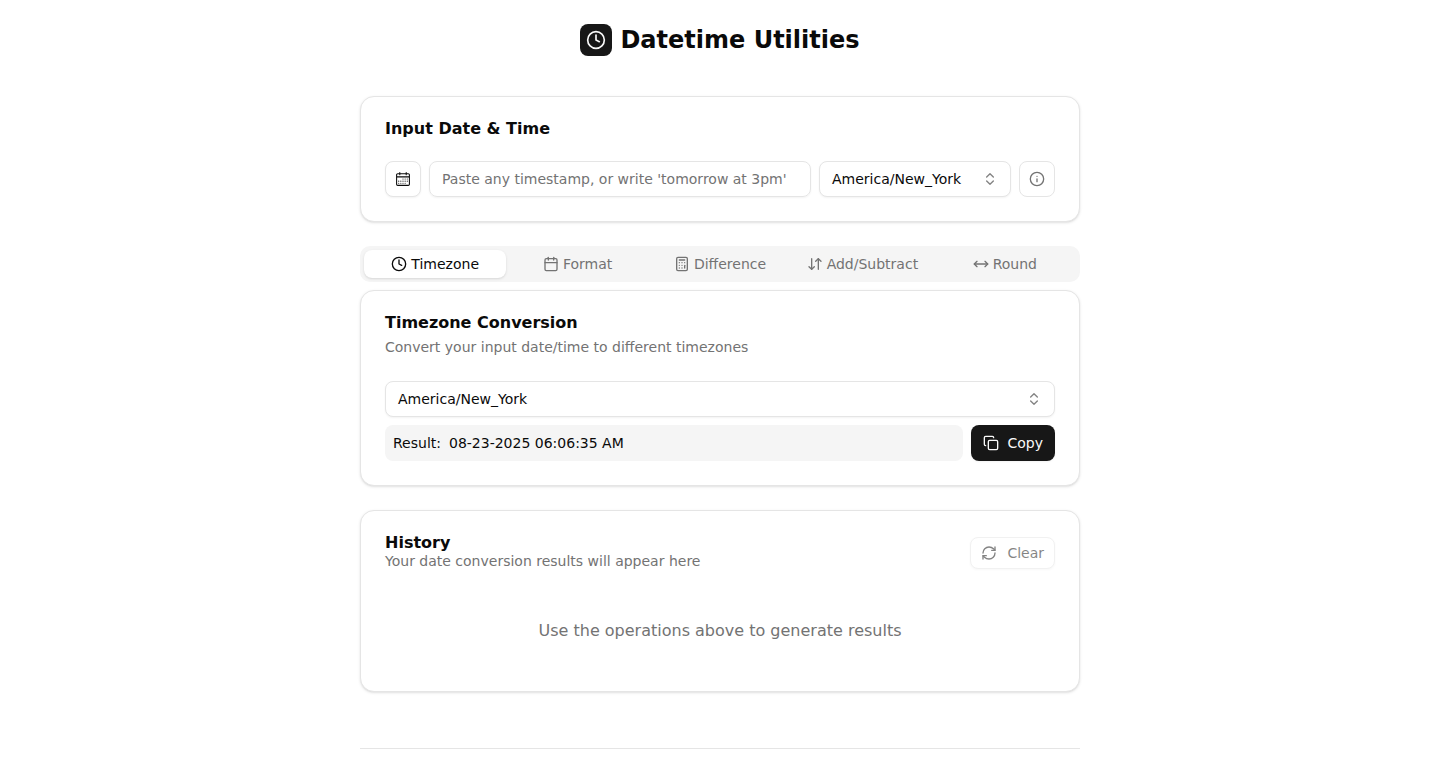
Author
aster0id
Description
This project is a web-based tool designed to simplify the often-frustrating task of working with timestamps. It tackles the common challenges of dealing with different timezones, formats, and calculations, all within your web browser. The innovative aspect lies in its ease of use and accessibility, providing a central hub for all your time-related needs, from simple conversions to complex time difference calculations. Moreover, it cleverly uses AI for specific functionalities like format inference (guessing the format of a timestamp you give it), showcasing a practical application of AI in developer tools. This project is built entirely on free tier infrastructure, demonstrating an efficient and cost-effective approach to web application development.
Popularity
Points 1
Comments 0
What is this product?
This is a web application that acts as a centralized tool for all things time. It allows you to convert between different timezones, change timestamp formats, calculate time differences, and perform other related operations. The main technology behind it is a frontend application (likely built with HTML, CSS, and JavaScript) that runs entirely in your web browser, eliminating the need for server-side processing for most operations. The inclusion of AI, specifically Gemini-flash-lite, for inferring timestamp formats is a clever and practical touch. So, this tool helps you quickly and easily handle time-related tasks, saving you time and mental effort.
How to use it?
You can access the tool through your web browser by visiting its URL. The user interface likely consists of input fields for entering timestamps, selecting timezones, and choosing desired output formats. You simply input your timestamp, configure the desired operations (like timezone conversion or time difference calculation), and the tool will provide the results. The tool uses AI to understand the format of the timestamp, so you don't need to manually specify the format. This makes it simple to use for anyone working with time data. So, you can use it any time you need to manipulate timestamps, debug backend systems, or analyze time-series data.
Product Core Function
· Timezone Conversion: This allows you to easily convert a timestamp from one timezone to another. Value: Saves time and reduces errors when working with data from different geographical locations. Application: Useful for developers working on international applications or analyzing data from various regions.
· Timestamp Format Conversion: This feature enables you to change the format of a timestamp (e.g., from a human-readable format to a Unix timestamp). Value: Ensures compatibility between different systems and simplifies data processing. Application: Crucial for debugging applications and integrating with systems that use specific timestamp formats.
· Time Difference Calculation: This functionality computes the difference between two timestamps. Value: Provides quick insights into the duration between events. Application: Useful for performance analysis, tracking task durations, and understanding the timing of events.
· AI-Powered Timestamp Format Inference: The tool can automatically detect the format of a timestamp. Value: Simplifies the input process and reduces the need for manual format specification. Application: Reduces the cognitive load on users and provides a more user-friendly experience.
· Browser-Based Operation: All operations happen within your browser, minimizing the need for external server resources. Value: Provides a fast and responsive user experience. Application: Ideal for quick time conversions, debugging, and working on applications with data that's not safe to share with a third party.
Product Usage Case
· Debugging Backend Systems: A backend developer is debugging an application and needs to understand the time difference between two events logged in different timezones. Using this tool, they can easily convert the timestamps to a common timezone and calculate the difference, quickly pinpointing the issue.
· Analyzing International Data: A data analyst is working with data from various countries, where the data is recorded in different timezones. They can use the tool to convert all timestamps to a single timezone, facilitating data analysis and comparison.
· Building Time-Based Applications: A frontend developer is building a web application that needs to display the current time in different locations. They can use the tool to easily format the time, get the offset, and manage the display in a consistent and user-friendly manner.
· Working with APIs: When working with APIs, you often get timestamps in specific formats. The tool can help quickly convert these timestamp formats into the desired formats and perform calculations, simplifying the integration process and improving productivity.